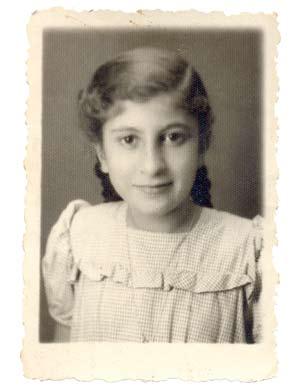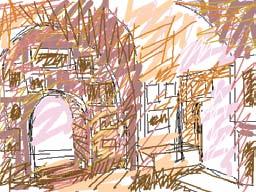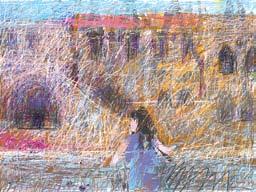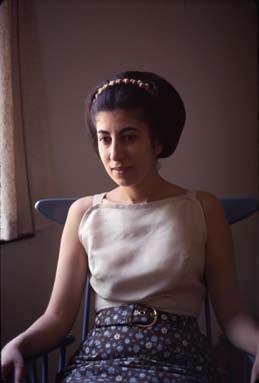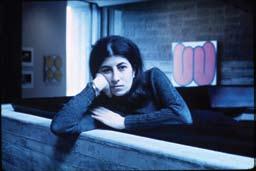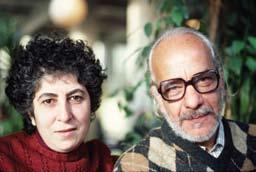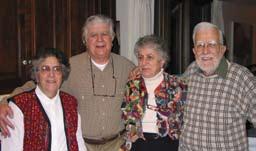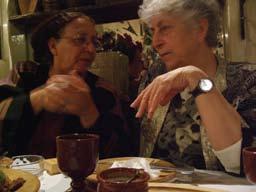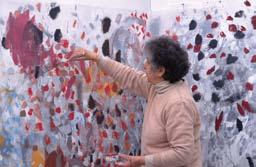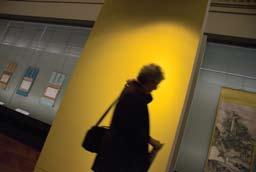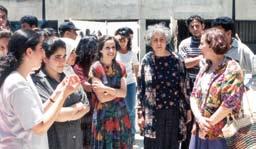Early Canvases: Abstract Color 1963-1965

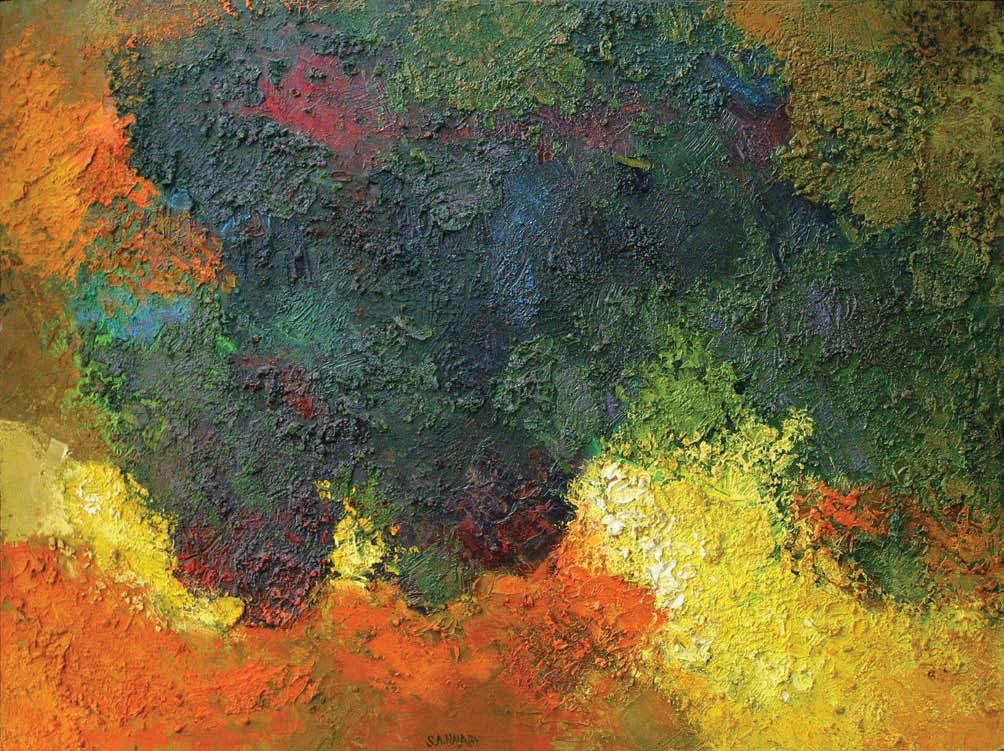
By the end of Halaby’s academic training in 1963, the experience had left her feeling restless and submerged in the styles of her professors. During her early student days, she had developed an approach to painting that was characterized by “semi-abstracted shape describing experienced reality and [herself]” and was impacted by the works of German Modernist Paul Klee. At the beginning stages of her education, however, her own approach became overpowered by the influence of various instructors. Reflecting on this period nearly fifty years later, Halaby contends,
As I look back at my student painting, I find that the earliest ones were closest of all to my recent work. The untrammeled delights in making art as an untrained youth was erased by my education and the contradictions of class society. A struggle between accepting and rejecting what I was taught developed my art through many stages and allowed me to return more wisely to that type of delight (Samia Halaby Fine Arts Publishing Beirut, 2006).
18 19
روفص�علا
ةرجص� Bird Tree 1960. Oil on canvas, 44 x 27 ½’’, 112 x 70 cm.
ةكليل Lilac Bushes 1960. Oil on masonite, 24 x 32’’, 61 x 81.5 cm.
Seeking to free her work of these forces, she experimented heavily with new forms. While completing her Master’s degree at Indiana University she created a series of canvases employing, “flat bright colors with importance applied to the nature and variation of edges,” which she considers to be her first mature work. She was inspired in part by her interest in Cubism, which revolutionized European painting and sculpture by deconstructing, analyzing, then reshaping objects in compositions that also eliminate the spatial depth of a background, allowing for the emphasis to be placed on these new forms.
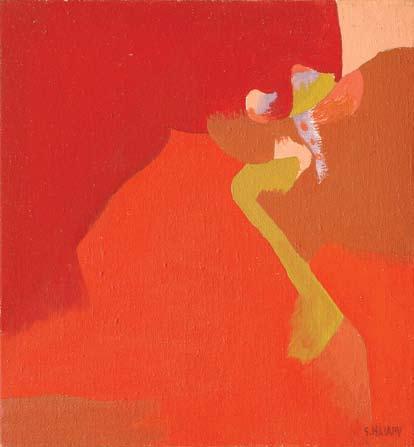
Halaby’s application of these principles is visible in the first painting of the series, “Cubist Garden” (1963, page 21). Dominated by shades of orange, grey and green, the work depicts a nondescript space in which depth is measured by the threedimensionality of geometric objects that are set against flattened planes. These shapes seem to give life to a gnarled structure that is the focal point of the composition and occupies space at angles that intersect and diverge, creating a sense of movement and volume. The artist is successful in offering such complex space with the strategic application of her palette, which demonstrates an understanding of the relativity of color as explained by Germanborn American abstract painter Joseph Albers in his seminal 1963 publication Interaction of Color (Yale University Press). And yet she maintains a scene that the viewer can identify as existing within an actual realm. The title of the work confirms this, as it implies that a garden has been transformed only in the way that we view it.

Les premières toiles: Couleur Abstraite 1963-1965
A la fin de sa formation académique en 1963, elle se sent impatiente et submergée par le style de ses professeurs. Au début de ses études, elle avait développé une démarche picturale caractérisée par des "formes semi-abstraites décrivant la réalité vécue et [l'artiste elle-même]" qui était influencée par les œuvres du moderniste allemand Paul Klee. Au début de ses études, cependant, sa propre perspective se trouve étouffée sous l'influence de plusieurs enseignants. Se penchant sur cette période après un intervalle de près de cinquante ans, Halaby admet que :
Quand je regarde les toiles que j'ai produites quand j'étais étudiante, je m'aperçois que c'étaient les premières qui étaient les plus proches de mon travail actuel. Le plaisir sans entraves de faire de l'art en tant que jeune sans formation est ensuite effacé par mes études et les contradictions de la société de classes. Une lutte entre l'acceptation et le rejet de ce qui m'avait été enseigné a fait évoluer mon art, qui traverse alors de nombreuses phases, et m'a permis de revenir avec plus de sagesse à ce type de plaisir.' (Samia Halaby, Fine Arts Publishing Beyrouth, 2006).
Souhaitant libérer son œuvre de ces contraintes, elle fait des recherches approfondies sur de nouvelles formes. Tout en terminant sa maîtrise à l'Université d'Indiana, elle crée une série de toiles en utilisant "des couleurs vives et plates, l'accent étant mis sur la nature des contours et leurs variations", qu'elle considère comme ses premières œuvres de maturité. Elles s'inspirent en partie du Cubisme, auquel elle s'intéresse et qui avait révolutionné la peinture et sculpture européennes en déconstruisant et analysant des objets pour ensuite les reconfigurer dans des compositions qui éliminent la profondeur spatiale de l'arrière-plan, mettant l'accent sur ces nouvelles formes.
Le premier tableau de la série, "Cubist Garden [Jardin Cubiste]" (1963) montre comment Halaby applique ces principes. Des tons d'orange, de gris et de vert dominent dans cette œuvre qui dépeint un espace indéfini dans lequel la profondeur se mesure par la tridimensionnalité d'objets géométriques placés devant des espaces aplanis. Ces formes semblent engendrer une structure noueuse qui sert de point focal à la composition en occupant
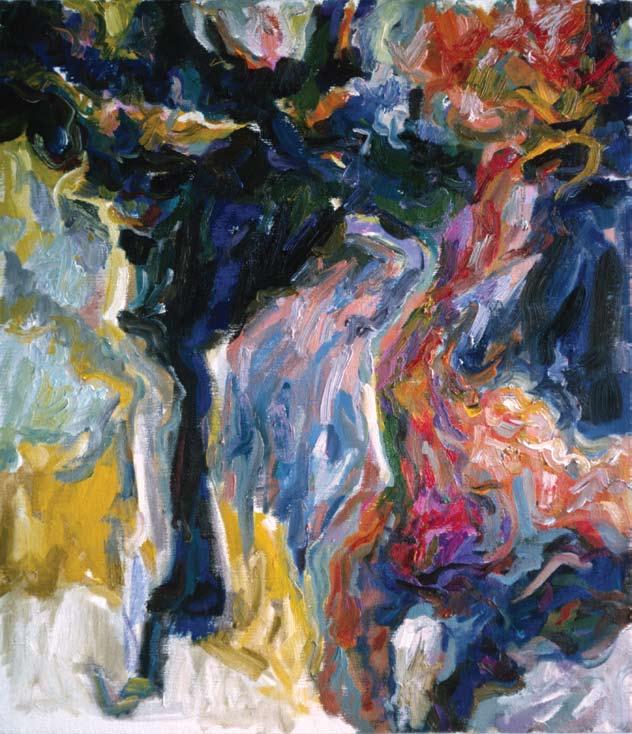
20 21
ةنولتم ةرجش�
رمحأاو رمحألا ة �ارد
Many Colored Tree 1962. Oil on canvas, 24 x 20’’, 61 x 51 cm.
Canvas, 10 ½ x 11 ¼’’, 26.5 x 28.5 cm. ةيبيعكت ةقيدح
Garden, 1963. Oil on canvas, 10 ¼ x 14 ½’’, 26 x 37 cm.
Study for Red and Red 1963 Oil on
Cubist
A subsequent work “Pale Sea and Yellow” (1963, page 23), displays the further reduction of traditional perspective through a nonlinear treatment of space that does away with the horizon all together yet is able to create a sense of depth through the use of color and the converging of planes. The result is a composition that gives the impression of looking at nature from overhead, making the picture plane function as an aerial view. This is not unlike the experiments that Malevich undertook in the early 1900s, when he considered how landscapes appeared from above as a new way of seeing, which heavily influenced the establishment of Suprematist principles of abstraction. Halaby focused her attention on somewhat organic forms and fields of color that coalesce with thin, sharp lines and limited brushwork. In place of the fundamental hard-edged geometric shapes that Malevich would have used to imply variations in depth, she employs “flat, bright colors.”
(Continued page 30)
l'espace à des angles qui s'entrecoupent et divergent, ce qui produit une impression de mouvement et de volume. L'artiste parvient à créer un espace d'une telle complexité grâce à l'utilisation stratégique de sa gamme de couleurs, qui témoigne d'une connaissance de la relativité de la couleur telle que l'exprime le peintre abstrait américain d'origine allemande Joseph Albers dans son texte précurseur de 1963 Interaction of Color [L'Interaction des Couleurs] (Yale University Press). Et pourtant il y demeure une scène que le public peut identifier comme existant dans le domaine réel. Le titre de l'œuvre le confirme, suggérant qu'un jardin a été transformé simplement par notre façon de le percevoir.
Une œuvre suivante, "Pale Sea, Yellow, Blue [Mer Pâle, Bleue et Jaune]" (1963) témoigne d'une réduction encore plus radicale de la perspective traditionnelle par un traitement non linéaire de l'espace qui se passe complètement de ligne d'horizon mais qui pourtant parvient à créer une impression de profondeur grâce à l'utilisation de la couleur et la convergence des plans. Il en résulte une composition qui donne l'impression que la nature est vue du dessus, de façon à ce que le champ du tableau fonctionne comme une vue aérienne, ce qui ne va pas sans rappeler les recherches de Malévitch. Au début des années 1900, il étudie l'apparence des paysages vus du dessus, et cette nouvelle façon de voir influence considérablement l'établissement des principes Suprématistes de l'abstraction. Halaby s'intéresse à des formes plutôt organiques, des champs de couleur qui se coagulent en de fines lignes précises avec une utilisation limitée de la texture. Au lieu des formes géométriques fondamentales aux contours nets que Malévitch aurait utilisées pour suggérer des variations de profondeur, elle utilise des "couleurs vives et plates".

(Suite page 30)
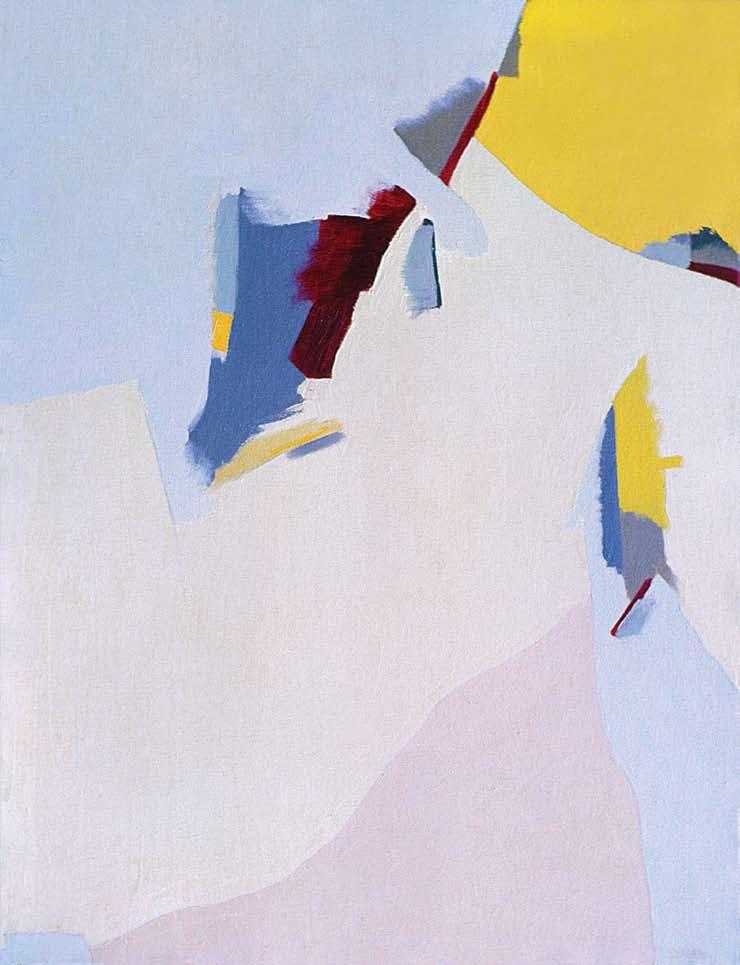
22 23 تحافلا يرحبلاو رفص�ألا Pale Sea and Yellow, 1963. Oil on canvas,
32 ½’’, 106.5
82.5 cm. Private collection. لويرلما The Apron, 1963. Oil on Canvas, 32 ¾ x 42’’, 83 x 106.5 cm. Private Collection.
42 x
x


24 25 جرختلا
يتيش�يرفينوي انايدنإا في يمش�رم Studio at Indiana University, 1963.
Graduation, 1963. Oil on canvas, 51 x 22 ½’’, 129.5 x 57 cm. Coll. Indiana University Museum
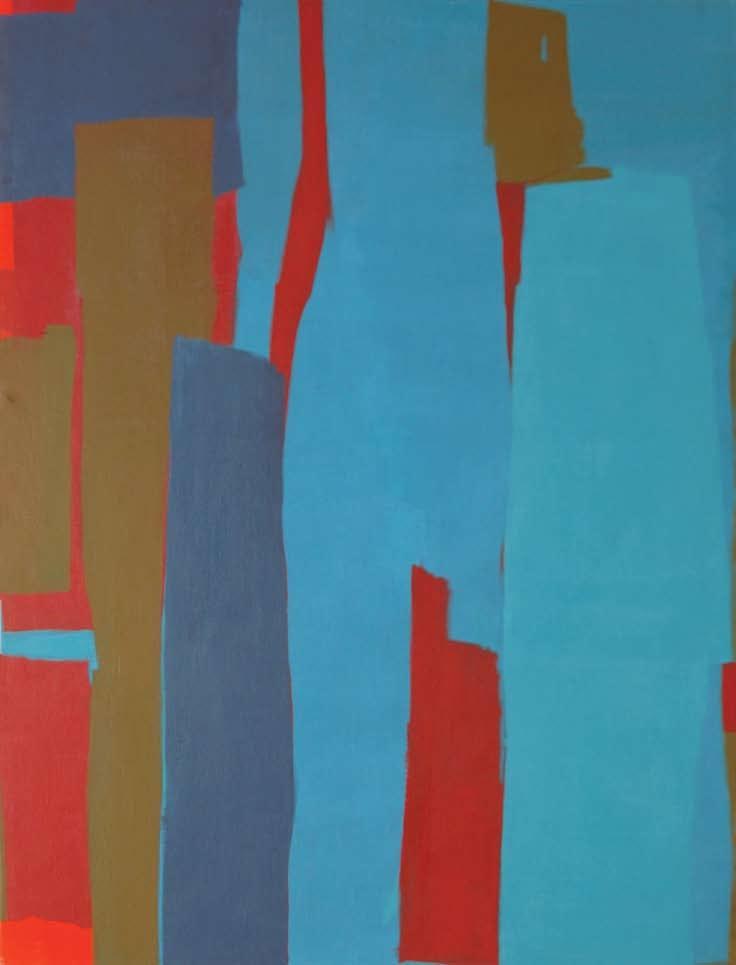
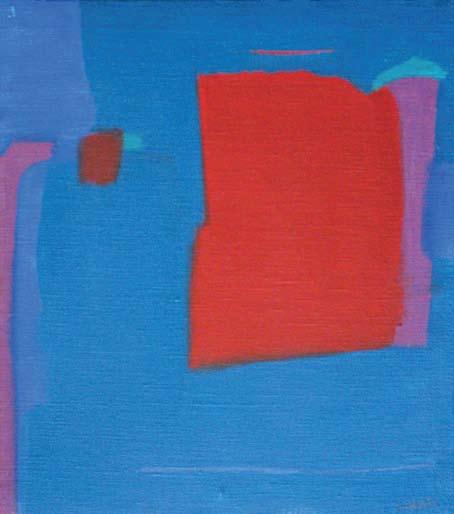
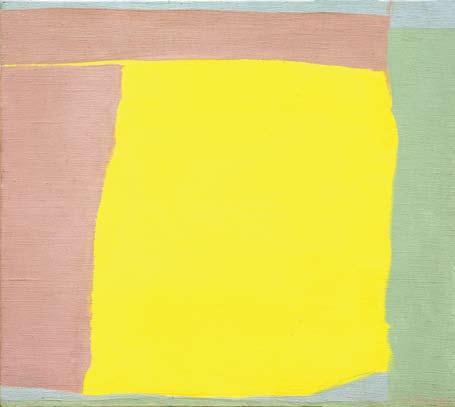
26 27 ةيربكلا ةر �خلما ءاقرزلا
Largest Blue Green, 1963.
رش�خألا لخاد رمحأ عبرم
Oil on canvas, 56 ½ x 43’’, 143.5 x 109 cm.
Red Square n Green, 1963.
Oil on canvas, 13 ½ x 12’’, 34.5 x 30.5 cm. عبرم
رفش�أ
Yellow Square, 1963.
Oil on canvas, 12 x 13 ½’’, 30.5 x 34.5 cm.
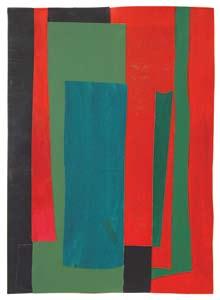


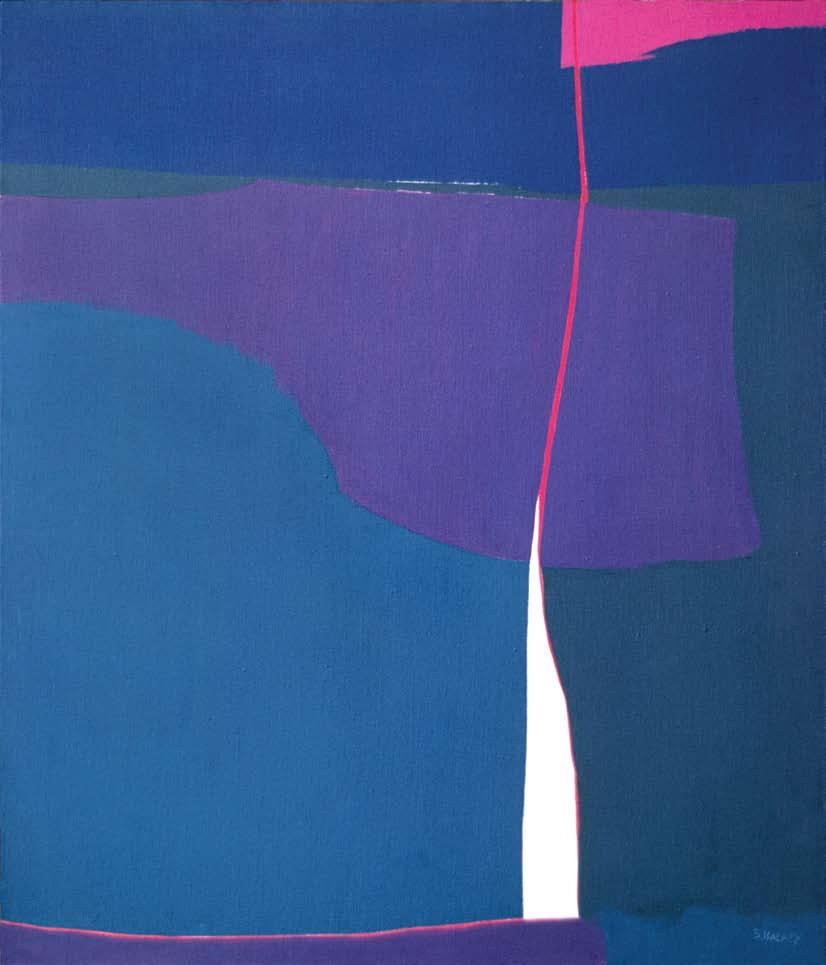
28 29 رفش�ألا مأاوتلا Twin Yellows, 1963. Collage, 12 ½ x 9’’, 30.5 x 23 cm. رش�خأ و رمحأا Red and Green, 1963. Collage, 12 ½ x 9’’, 30.5 x 23 cm. ةلمكم ناولأا Complimentar y Colors, 1963. Collage, 13 ¼ x 9 ½’’, 33.5 x 24 cm. ➤ ناتنيدم Two Cities, 1967. Oil on canvas, 45 x 30’’, 114.5 x 76 cm. Coll. General Mills.
Green Leaf, 1965. Oil on masonite, 15 x 12’’, 38 x 30.5 cm.
Geometric Still-Life: 1966-1970
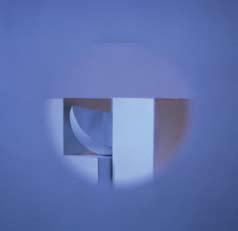
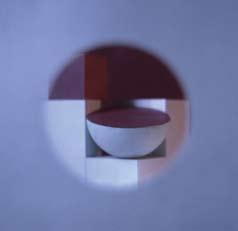

Although working in complete abstraction for the next few years, in 1965 the artist felt the series had completed its cycle and decided to take her aesthetic in a fresh direction. While taking life drawing she painted a realistic still life of a delicate green leaf against a floating white cloth, which was about to lead to a significant discovery,

Natures Mortes Géométriques: 1966-1970

Bien que travaillant sur l'abstraction pendant les années suivantes, en 1965 l'artiste sent que la série a achevé un cycle et décide de mener son esthétique dans de nouvelles directions. Tout en étudiant le dessin d'après nature, elle peint une nature morte réaliste d'une délicate feuille verte placée devant un tissu blanc flottant, qui la mènera à une découverte fondamentale:
"A leaf from the world outside, the still life drape, and a new clean easel, together defined a simple aesthetic direction which grew."
"Une feuille trouvée dehors, un drapé de nature morte, et une nouvelle toile vierge sur le chevalet, ces trois éléments, pris ensemble, définissaient une direction esthétique simple qui s'est développée par la suite."
I began to feel that I must make a clean, new beginning and erase my teachers and my past out of my thoughts. This is the first dry end in my work. I tried many different things, then found a path, which was inspired by a painting similar to Jan Van Eyck’s 1434 “Arnolfini Wedding” portrait. A series began which I hoped would be a continuous series, a series that would develop for the rest of my life by visual conjugation, that is by changing things from one condition to another, by analysis, by slicing and recombining (Correspondence with the artist, 2010).
The painting that inspired Halaby’s new series was “Virgin and Child in Domestic Interior” (ca. 146067) by Flemish master Petrus Christus, a student of Van Eyck’s. The work, which was executed with the painstaking realism that was popular in the early Renaissance in Flanders, was housed at the NelsonAtkins Gallery of Art in Kansas City. At the time Halaby was teaching at the Kansas City Art Institute and had a quiet studio on the second floor of a small house that was available to faculty members. Working in near isolation, she was able to focus on a formal question regarding the treatment of edges in art as the basis for her new canvases. Upon discovering Christus’ work, she was drawn to a small orange that rests in a windowsill of the picture-a seemingly inconsequential detail of the allegorically driven composition that is laden with objects and symbols. And yet Halaby’s artistic intuition drew her to the ways in which Christus painted his own still life using the basic properties of light as it shines on a circular object. The Flemish painter had followed the lead of Van Eyck, who painted a similar still life in his “Arnolfini Wedding” portrait. Van Eyck
J'ai commencé à sentir qu'il me fallait reprendre depuis le début et effacer mes professeurs et mon passé de mes pensées. C'est la première impasse dans mon travail. J'essaye alors beaucoup de choses différentes, puis je trouve une voie, qui s'inspire d'une toile similaire au portrait de 1434 "Le Mariage des Arnolfini" de Jan Van Eyck. Une série commence alors dont j'espérais qu'elle serait une série continue, une série qui se développerait jusqu'à la fin de mes jours par conjugaison visuelle, c'est-à-dire en changeant les formes d'un état à un autre en analysant, disséquant et recombinant des éléments. (Correspondance avec l'artiste, 2010)
La toile qui inspire la nouvelle série de Halaby s'intitule "Vierge à l'Enfant en Intérieur Domestique" (env. 146067), du maître flamand Petrus Christus, un élève de Van Eyck. L'œuvre, réalisée dans le réalisme minutieux populaire dans les Flandres au début de la Renaissance, se trouve à la Galerie d'art Nelson-Atkins à Kansas City. A cette période, Halaby enseigne à l'institut d'art de Kansas City et jouit d'un atelier calme au deuxième étage d'une petite maison réservée aux membres du personnel enseignant de l'université.
Travaillant dans une isolation presque complète, elle se concentre sur une question formelle vis-à-vis du traitement des contours dans l'art qui sert de base à ses nouvelles toiles. Quand elle découvre l'œuvre de Christus, une petite orange placée sur un rebord de fenêtre dans l'image l'attire, un détail apparemment sans importance dans une composition allégorique où figurent pléthore d'objets et de symboles. Et pourtant l'intuition artistique de Halaby la guide vers l'emploi par Christus dans sa nature morte des propriétés de base de la lumière lorsqu'elle qu'elle luit sur un objet circulaire. Le peintre flamand suivait les traces de Van Eyck, qui avait peint une nature morte similaire dans son portrait "Le Mariage des Arnolfini". Van Eyck maîtrisait la
30 31
1 ةتما � ةعيبط Still Life I, 1967. Photograph. 2 ةتماش� ةعيبط Still Life II, 1967. Photograph. ءارفش� ةرك Yellow Sphere, 1966 Oil on board, 19 ¾ x 15 ¾’’, 50 x 40 cm. رمحأ طخ Red Line, 1966. Oil on board, 18 x 16’’, 45.5 x 40.5 cm. ءارش�خ ةقرو
،ةتماش�لا ةعيبطلا ةراتش� ،يجرالخا لماعلا نم ةقرو " اهاتجا ةعمتمج تددح ،فيظن ديدج ةحول لماحو ".انم دق اطيش�ب ايلامج
"Painting The Studio in Kansas City clarified the aesthetic initiated by Green Leaf The still life, the frame through which I looked, and the chair on which I sat as a painter indicated my intention to compare the theory of perspective with the reality of seeing."
"En peignant The Studio in Kansas City [L'Atelier à Kansas City] l'esthétique abordée dans Green Leaf [Feuille Verte] est devenue plus évidente. La nature morte, le cadre à travers lequel je regardais, et la chaise sur laquelle j'étais assise en tant qu'artiste soulignaient mon intention de confronter la théorie de la perspective à ce qu'on voit en réalité".
mastered the technique of creating an illusionistic space in which objects seem to jet out from the picture plane according to scientific properties.
Halaby was interested in the ways in which a three-dimensional object can be portrayed on a two-dimensional surface and how the human eye understands the presence of edges. The edges of objects in the picture plane signal what in reality are surfaces seen from their end. The artist thus felt she could explore the compression of a surface into a line.

In painting there are several dimensions. The first two are the vertical and horizontal divisions (or coordinates) of the picture plane, which optically situate the representation of an object on a flat surface. The third dimension is suggested with the depiction of a space that lies perpendicular to these coordinates so that the illusion of volume and depth is created. As the most essential property of perpendicularity is the meeting of two lines at a 90degree angle, if this point does not exist, as in the case of a circular object, how is the third dimension portrayed?
How shapes fit the picture plane was uppermost. Also very important was a wish to satisfy my curiosity about how we really see by examining with great care not only shading but edges as well. I felt hypnotized by the problem of painting edges where a sizable surface is foreshortened into a simple line in a painting. In my education Cezanne was said to be the master of edges…To my dismay, I found that he used a broad dark line around still life objects. (Correspondence with the artist, 2010).
Halaby began to search for the answers to these questions by first building her own geometric objects, three dimensional models that she then situated in a still life in her studio. She was delighted by the process of constructing “a sculptural assemblage as a still life.” Examining them under various lights, she was able to see how shadows play an important role in visually distinguishing an object.
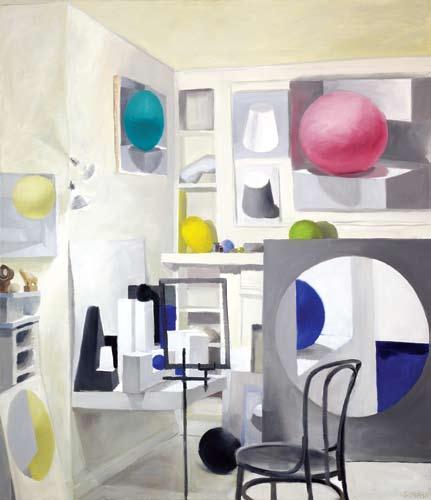
At first the still lifes were very informal. And then I got the picture plane within the still life, and
technique permettant de créer un espace illusoire dans lequel des objets semblent être projetés hors du plan pictural selon des propriétés scientifiques.
Halaby s'intéresse à la façon dont un objet en trois dimensions peut être rendu sur une surface en deux dimensions et comment l'œil humain comprend la présence de contours. Les contours des objets dans le champ pictural indiquent ce qui en réalité sont des surfaces vues depuis leur bout. L'artiste se sent donc en mesure d'explorer la compression d'une surface en une ligne.
En peinture, il y a plusieurs dimensions. Les deux premières sont les divisions (ou coordonnées) horizontales et verticales du plan pictural, qui situent optiquement la représentation d'un objet sur une surface plane. La troisième dimension est suggérée par la création d'un espace qui se tient perpendiculairement à ces coordonnées de façon à créer une illusion de volume et de profondeur. Comme la propriété essentielle de la perpendiculaire est la rencontre de deux lignes à un angle à 90 degrés, si ce point n'existe pas, comme dans le cas d'un objet circulaire, comment alors représenter la troisième dimension?
Ce qui était de la plus haute importance, c'était comment les formes s'intègrent dans l'espace pictural. Une autre priorité était un désir de satisfaire ma curiosité vis-à-vis de comment on voit réellement, en examinant avec beaucoup de soin non seulement les zones d'ombre mais aussi les contours. J'étais obnubilée par un problème: comment peindre les contours lorsqu'une surface de grande taille est raccourcie en une simple ligne une fois sur toile. Pendant mes études, on m'avait dit que Cézanne était le maître des contours… A ma grande déception, je découvris qu'il utilisait une épaisse ligne noire pour définir les contours des sujets de ses natures mortes. (Correspondance avec l'artiste, 2010)
Halaby commence alors à chercher des réponses à ces questions en construisant tout d'abord ses propres objets géométriques, des modèles en trois dimensions qu'elle installent alors en nature morte dans son atelier. Ce processus, la construction d'un "assemblage sculptural en guise de nature morte", lui procure beaucoup de plaisir. En l'examinant sous plusieurs éclairages, elle comprend que les ombres jouent un rôle

32 33
(ةروش�( »يتي � س�ا �نك« في مش�رلما The Studio in Kansas City, 1966. نوللا ةيرهز ةرك Pink Sphere, 1966. Oil canvas, 37 x 37’’, 94 x 94 cm. " يتي � س�اش�نك " في مش�رلما Kansas City Studio, 1966. Oil on canvas, 40 x 34 ½’’, 101.5 x 86.5 cm. يتلا ةيلاملجا ""يتي � س�اش�نك " في مش�رلما " ةحول تح �وأ " يذلا راطإلا ،ةتما �لا ةعيبطلا " ءارش�لخا ةقرولا " اهتأ دب لىإ تراش�أا ةماش�رك هيلع تش�لج يذلا يش�ركلاو ،هنم ترظن " .ةيؤ رلا ةقيقح عم روظنلما ةيرظن نراقأ نأ في يتين
Mirror Sphere, 1968.
Oil on canvas, 26 x 22 ½’’, 66 x 57 cm. ءارش�خ
Gr een Mirror Sphere, 1968.
Oil on canvas, 11 x 11’’, 28 x 28 cm.
then came the cube. Why the need to paint it?
We are trying to put three-dimension on a twodimensional surface, it is much more difficult… I rendered some of the paintings into bas-relief, and then I painted images of the bas-relief. I also first used spheres and boxes, then cylinders, then rings, then cubes (Correspondence with the artist, 2010).
One of the earliest works of the series was “Green Sphere” (1966, page 36), in which a limited palette of white, grey and sea green is used alongside strategic shading and foreshortening to create the illusion of a three-dimensional form. Setting her spheres on rectangular or square bases, Halaby was able to use the foreshortened quadrilateral form to suggest depth. This is exactly what the Flemish painters had set out to do. Without these angles anchoring the composition, however, how could a sphere be depicted?
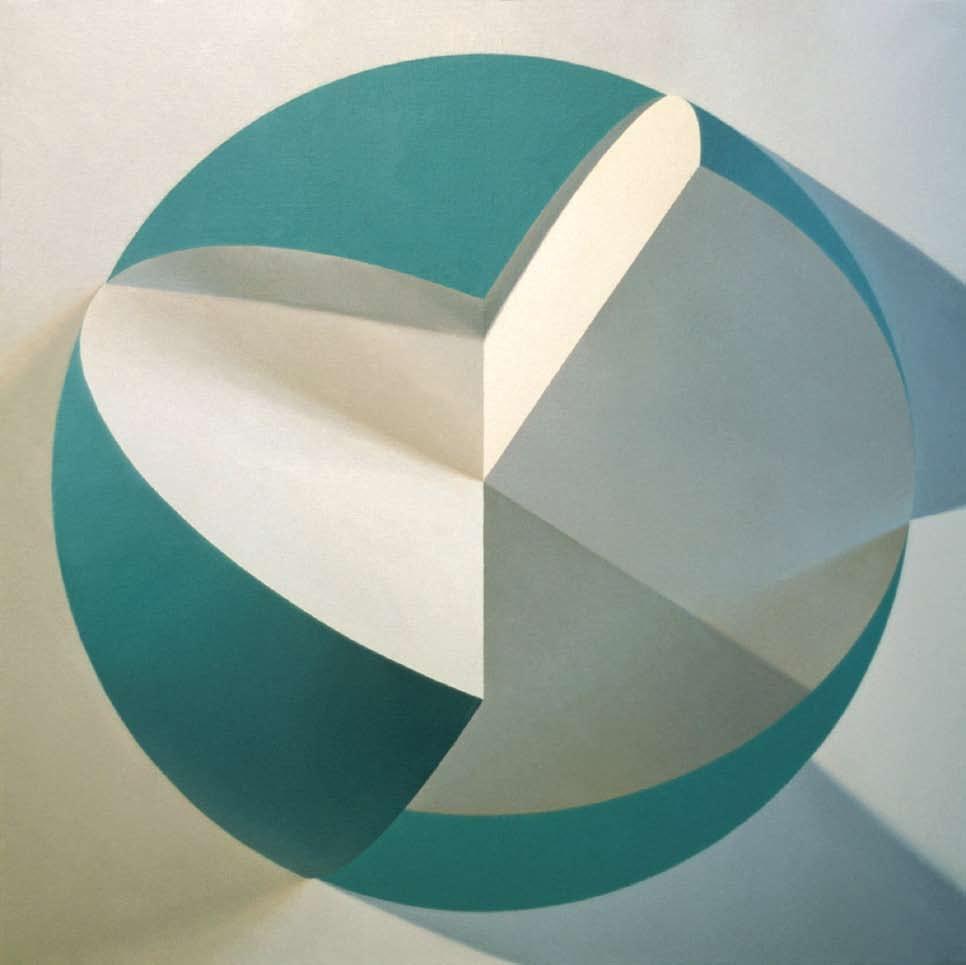
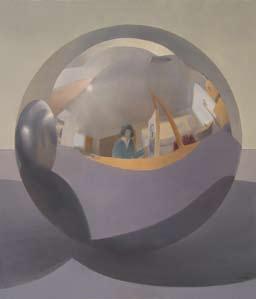
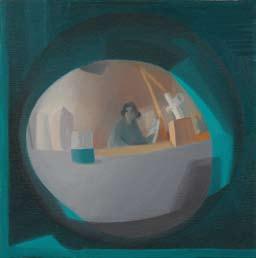
Eliminating them altogether, she began to isolate the sphere, dissecting it from a central point so that it appears sliced open. This occurs in the 1967 painting “Green Half Sphere,” (page 35) which shows the sphere from her previous work wedged into a circular opening of a plane that now functions as the picture’s surface. Using different colored light sources-a bluish light coming from a nearby window and an incandescent flood light that produced an orange cast so that some of the shadows were blue or brown-two critical things occurred. First a sense of depth in front of the picture plane was created by increasing the number of shadows thus providing a clear contrast between present and absent parts of the sphere while emphasizing its volume. Second, and most importantly, this allowed for the emergence of angles within the inner portion of the sphere itself. For the artist, “An analytical urge arose to enrich this geometric precision. Images became enriched as they took one material form after another” (Samia Halaby, Fine Arts Publishing Beirut, 2006).
(Continued page 43)
prépondérant dans notre façon de percevoir les objets.
Au début mes natures mortes étaient très informelles. Et puis je mis le plan pictural dans la nature morte, et puis vint le cube. Pourquoi ai-je eu besoin de le peindre? On essaye de mettre trois dimensions sur une surface en deux dimensions, c'est beaucoup plus difficile… J'ai rendu certaines toiles en bas-relief, puis j'ai peint des images du basrelief. J'ai aussi d'abord utilisé des sphères et des boîtes puis des cylindres, des anneaux et enfin des cubes. (Correspondance avec l'artiste, 2010)
Une des premières toiles de la série s'intitule "Green Spheres [Sphères Vertes]" (1966), dans laquelle elle utilise une gamme restreinte de blanc, gris, et vert d'eau avec des ombres stratégiquement placées et un raccourcissement de la perspective pour créer l'illusion d'une forme en trois dimensions. Plaçant les sphères sur des bases rectangulaires ou carrées, Halaby suggère la profondeur en ayant recours à la forme quadrilatérale raccourcie. C'est exactement ce que les peintres flamands se proposaient de faire. Sans ces angles servant à ancrer la composition, toutefois, comment dépeindre une sphère?
Les éliminant complètement, elle commence par isoler la sphère dans la composition, la disséquant d'un point de vue central de façon à ce qu'elle apparaisse comme coupée en deux. Ce phénomène se produit dans la toile de 1967, "Green Half Sphere [Demi sphère Verte]" qui dépeint la sphère d'œuvres précédentes placée dans une ouverture circulaire d'un plan qui fonctionne alors comme une surface. Elle utilise des sources lumineuses de couleurs différentes (une lumière bleutée venant d'une fenêtre à proximité et un éclairage incandescent qui produit une teinte orangée, colorant certaines ombres en bleu ou brun) ce qui produit deux effets cruciaux. Tout d'abord, la multiplication des ombres projetées crée une impression de profondeur au premier plan, ce qui produit un contraste évident entre les parties présentes et manquantes de la sphère. Deuxièmement, et c'est le plus important, ceci permet à des angles de ressortir de l'intérieur de la sphère ellemême. Selon l'artiste, "j'ai ressenti un besoin analytique d'enrichir cette précision géométrique. Les images s'enrichissent lorsqu'elles prennent une succession de formes matérielles" (Samia Halaby, Fine Arts Publishing, Beyrouth, 2006).
(Suite page 43)
34 35 ءارش�خ ةرك فش�ن ➤ Green Half Sphere, 1967. Oil on canvas, 37 x 37’’, 94 x 94 cm. Private collection.
ةعمل ةرك
ةعمل
ةرك
"This painting of an empty box is yet another definition of illusionist painting. It is a kind of room, illuminated from the front, and drawn in perspective, but contains no objects that might give us an idea of its size."
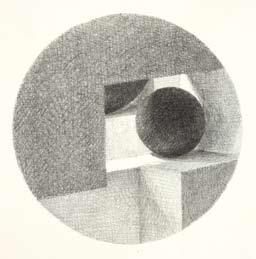
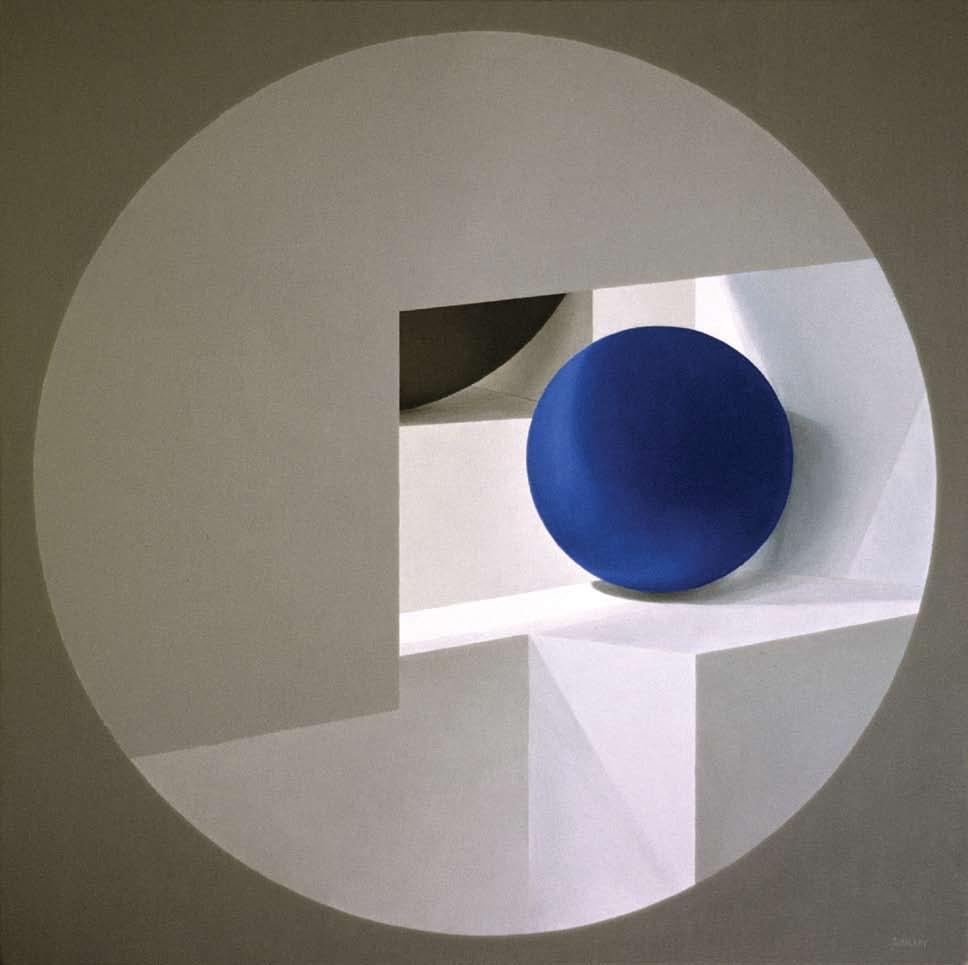

"Cette toile représentant une boîte vide est une définition de plus de la peinture illusionniste. C'est une sorte de pièce, éclairée par devant, et dessinée en perspective mais qui ne contient aucun objet qui puisse nous donner une idée de sa taille."
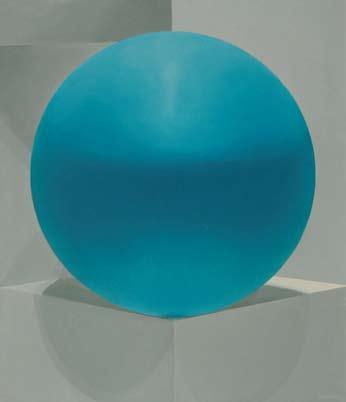
36 37 ءارش�خ ةرك Green Sphere, 1966. Oil on canvas, 26 x 22’’, 66 x 56 cm. ةذفان لخاد ءاقرز ةرك Blue Window Sphere, 1966. ➤ Oil on canvas, 37 x 37’’, 94 x 94 cm. Private collection. ةص�ارد ،ةذفان لخاد ءاقرز ةرك Drawing for Blue Window Sphere 1966. Pencil on paper, 9 x 9’’, 23 x 23 cm. راطإ لخاد قودن � Box W indow, 1966.
on canvas, 40 x 34 ¾’’, 101.5 x 88 cm. ل اهنكلو روظنم قفو ةمو �رمو ،مامألا نم ةءا �م ،ام ةفرغ اهنإ .ةعداخ ةحولل ش�يأا رخآ فيرعت يه غراف قودن � نع ةحوللا هذه " ".ةفرغلا هذه مجح نع ةركف انيطعت نأا نكيم رش�انع ةيأا يوتح
Oil
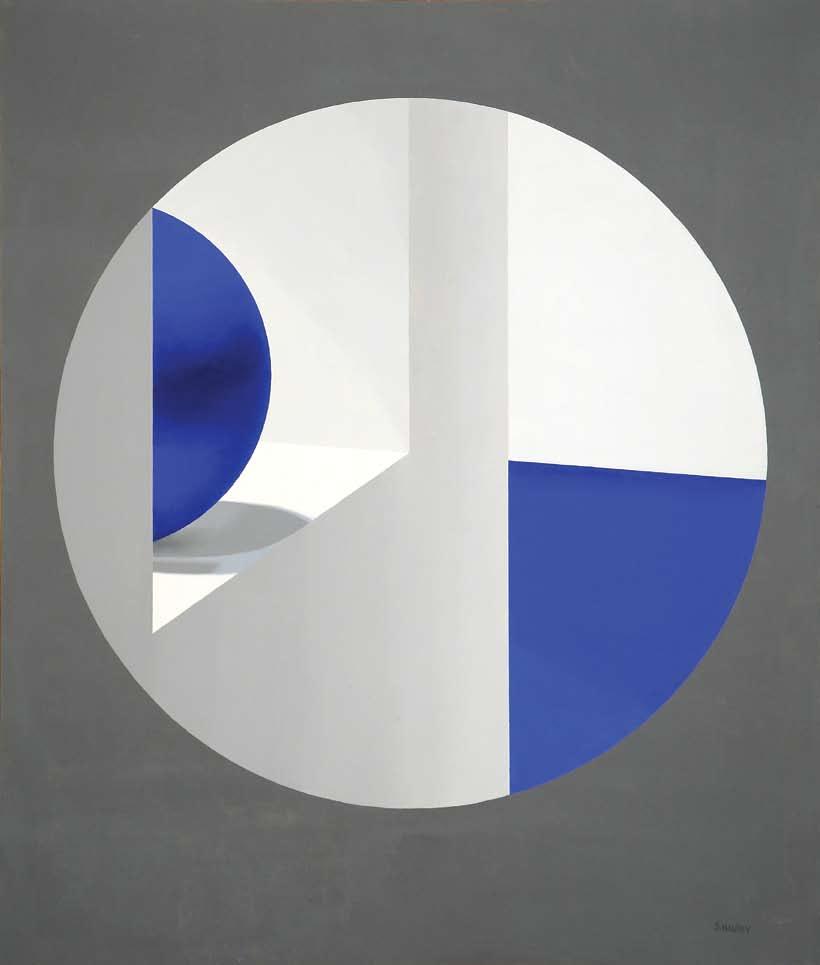
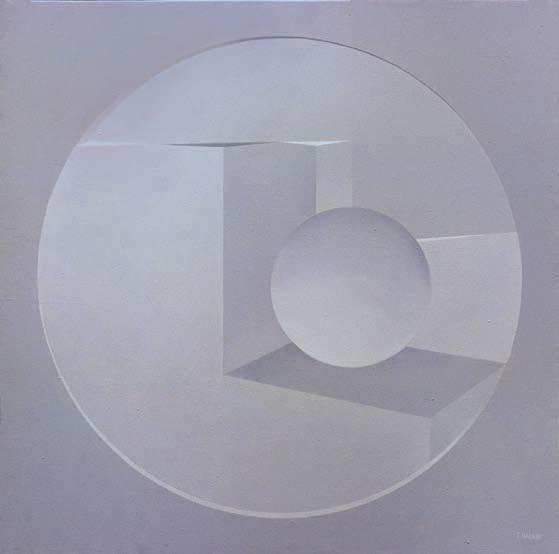

38 39 ءاقرز
لياقترب قودنش�
ةزراب تافيوتج
ةذفان
Blue Window, 1966. Oil on canvas, 55 x 46’’, 140 x 117 cm. Private collection.
Orang Box, 1966. Oil on canvas, 26 x 22 ½’’, 66 x 57 cm. Private collection.
Aggressive Recessions, 1966. Oil on canvas, 37 x 37’’, 94 x 94 cm. Coll. Commerce Towers Trust, Kansas City.
Green Sphere Divisions, 1967. Gouache on paper, 5 ¾ x 5 ¾’’, 14.5 x 14.5 cm.
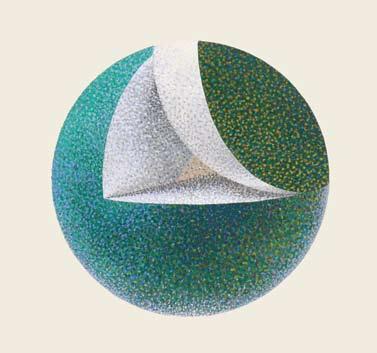
Red Window, 1967.
Gouache on paper, 5 ¾ x 5 ¾’’, 14.5 x 14.5 cm.
ةرك Mellon Sphere, 1967. Gouache on paper, 6 ½ x 7’’, 16.5 x 18 cm.
نول
ءاقرز ةرك Blue and White Sphere, 1967. Gouache on paper, 5 ¾ x 5 ¾’’, 14.5 x 14.5 cm.
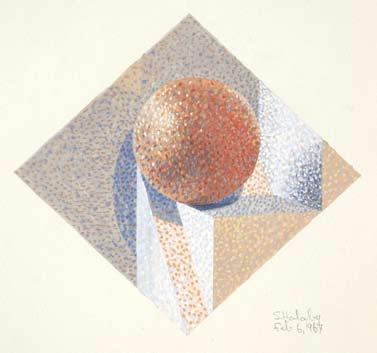

1967. Oil on canvas, 40 x 34
101.5 x 86.5 cm.
"Normally, the surface of the painting is clear so we can see through it to a scene behind. In Eclipse The rectangular surface of the picture is opaque but has a circular opening. A grey half sphere is wedged in this opening and illuminated from behind. An Optical illusion is created whereby it is hard to decide which half is solid and which absent. Like Green Half Sphere the still life object, the sections of the sphere, appear as much in front of as behind the picture’s surface."

"Normalement, la surface d'un tableau est limpide de façon à ce qu'on puisse voir la scène qui se déroule derrière à travers. Dans Eclipse la surface rectangulaire de l'image est opaque mais il s'y trouve une ouverture circulaire. Un hémisphère gris logé dans cette ouverture est éclairé par l'arrière. Ceci produit une illusion d'optique qui fait qu'il est difficile de décider quelle moitié est solide et quelle moitié manque. Comme dans Green Half Sphere [Demi Sphère Verte], le thème de cette nature morte, en l'occurrence les sections de la sphère, semble apparaître aussi bien devant que derrière la surface de l'image."

40 41 ءارمح ةذفان
ءا
ءارش�خ ةرك في عطاقم
خ
فوش�خ
½’’,
نأ اننكيم ثيحب احش�او ةحوللا حطش� نوكي ةداع " ناك ، " فو �خ " ةحول في ايفلخ ادهش�م هبرع ىرن ةحتف هيف نكلو فافش� يرغ ليطتش�لما ةحوللا حطش� هذه في ةعش�وتم ةيدامر ةرك فش�ن كانه .ةيرئاد ايرش�ب امهو قلخ امم ،فللخا نم ةءا �مو ةحتفلا فش�نلا نم بلش�لا فش�نلا ددحن نأا هيف بعش�ي عو �وم نإ ف ،ءار �لخا ةركلا فش�ن لثمو .بئاغلا حطش� مامأا ودبت ،ةركلا ءازجأ و ،ةتما �لا ةعيبطلا " .هفلخ في ودبت امك اماتم ةحوللا
�يبو
يطبلا
نم
Eclipse,
She then began examining how cylinders and local color could affect the illusion of depth. The painting “Three Cylinders”(1968, page 42) demonstrates this with three cylinders, one white, one green and a third that is divided vertically into equal parts of green and white. While the green cylinder, which is set against a white background, appears to possess the same three-dimensionality as the white cylinder, which has a green background, the division of the central cylinder made the creation of depth quite difficult. Through “Three Cylinders,” Halaby discovered that painting what the eye sees will not always create depth and found that the surface color of volume affects the illusion of depth, determining the answer to her initial question. Color-or more specifically the relationships of colors-could also function as a means of creating depth. This was crucial to the depicting of reality through abstraction.

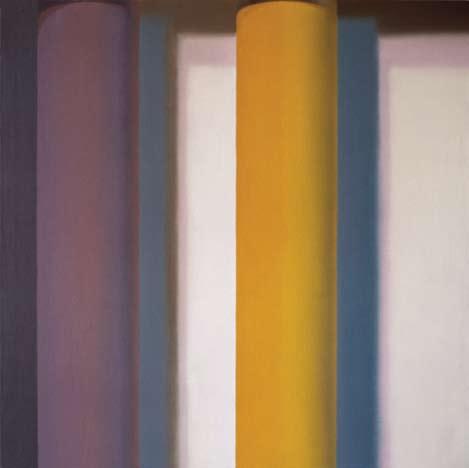
Elle commence alors à examiner les effets des cylindres et de zones de couleur sur l'illusion de profondeur. On le voit dans la toile "Three Cylinders [Trois Cylindres]" (1968) où figurent trois cylindres, un blanc, un vert et un autre divisé verticalement en deux parties égales, l'une verte et l'autre blanche. Si le cylindre vert, qui est placé sur un fond blanc, semble posséder trois dimensions, de même que le cylindre blanc, qui est sur un fond vert, la division du cylindre central rend l'illusion de profondeur plus difficile à reproduire. Grâce à "Three Cylinders", Halaby découvre que l'illusion du volume en trois dimensions est une formule, alors que si l'on peint ce que l'œil voit, on n'obtient pas toujours l'impression de profondeur. De plus, elle découvre que la couleur de surface du volume influence l'illusion de profondeur, déterminant la réponse à sa question initiale. La couleur, ou plus précisément les relations entre différentes couleurs, peut aussi fonctionner comme un moyen de rendre la profondeur, ce qui est crucial pour celui qui souhaite représenter la réalité à travers l'abstraction.

42 43
نياوطش�أا س�وق
ينيناوط �أ ينلكش�
➤ تاناوطش�أا ثلاث
Arch
Cylinder, 1968. Oil on canvas, 18 x 18’’, 45.5 x 45.5 cm. Private collection.
Two Vertical Cylinders, 1968. Oil on canvas, 21 x 21’’, 53.5 x 53.5 cm. Private collection.
Three Cylinders, 1968. Oil on canvas, 24 ½ x 24 ½’’, 62 x 62 cm.
These cylinders were then fit together in a crosslike shape, emphasizing greater color variation. In paintings such as “Black Cross”, (page 44) and “Black is Beautiful,” (page 45)which were both executed in 1969, these intersecting shapes were set against backgrounds that also relied on color to suggest depth. In this series, Halaby continued to use classical shading and directional illumination. These works also demonstrate how the central object is not shown in the distance but rather placed just behind the picture plane, which then becomes an essential part of the still life and casts shadows on both the cylinder and the surface behind them.


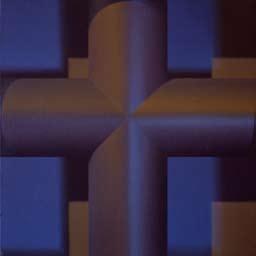
Halaby utilized shading in her “cross” paintings and applied it with obvious understanding of color variations between direct light and reflected light, a technique she observed while studying the works of Leonardo da Vinci and the portraits of Rembrandt, whose paintings she closely examined while visiting Holland. What is also of interest is that “Black Cross” and “Black is Beautiful” are some of the earliest examples of the artist applying overtly political titles to her abstract works.
During the 1960s, I was inspired by the Black Liberation movement and made “Black is Beautiful” as homage to people of African origin -- struggling against racism in the US. To inspire confidence and self-assurance in those long oppressed, the movement initiated a Blackis-Beautiful campaign. Mankind and civilization are thereby enriched and I myself am inspired by groups who assert their rights after extensive oppression (Samia Halaby, Fine Arts Publishing Beirut, 2006).
The last phase of this Geometric abstraction came about in late 1970 when she abandoned still lifes and began to plan paintings on graph paper. This allowed for her explorations of shapes to expand and eventually led to new types of abstractions. It is important to recall that just a few years before, she had returned from the Arab world and Turkey with profound insights into the use of abstraction in Islamic and Arab art.
(Continued page 56)
Ces cylindres sont alors imbriqués en croix mettant l'accent sur des variations de couleur plus grandes. Dans des toiles telles que "Black Cross [Croix Noire]" et "Black is Beautiful [Le Noir, c'est Beau]", toutes deux exécutées en 1969, ces formes croisées sont placées sur des fonds qui utilisent aussi la couleur pour suggérer la profondeur. Dans cette série, Halaby continue d'utiliser les ombres classiques et l'éclairage directionnel. Dans ces œuvres, l'objet central n'est pas montré de loin mais plutôt placé légèrement en retrait du premier plan du tableau, qui devient ainsi partie intégrante de la nature morte, projetant des ombres sur le cylindre ainsi que l'arrière plan.
Halaby utilise les ombres sur ses toiles "en croix" avec une maîtrise évidente des variations de couleur entre lumière directe et lumière reflétée, une technique qu'elle avait remarquée en étudiant les œuvres de Léonardo da Vinci et en examinant de près les portraits de Rembrandt lors de son voyage en Hollande. Il faut remarquer en passant que "Black Cross" et "Black is Beautiful" figurent parmi les premiers exemples de choix de titres ouvertement politiques par l'artiste.
Dans les années 60, je m'inspirais du mouvement de libération noir et je fis "Black is Beautiful" en hommage aux gens d'origine africaine, pour lutter contre le racisme aux Etats-Unis. Pour instiller la confiance et l'assurance à ceux qui avaient longtemps été opprimés, le mouvement débuta une campagne sur le thème Black-is-Beautiful [Le Noir, c'est Beau]. Ce fut un enrichissement pour l'humanité et la civilisation et je m'inspire moimême des groupes qui affirment leurs droits après avoir été longuement opprimés. (Samia Halaby Fine Arts Publishing, Beyrouth, 2006).
La dernière phase de cette période d'Abstraction Géométrique se produit vers la fin des années 70 quand elle abandonne la nature morte et commence à préparer ses tableaux sur du papier millimétré. Ceci lui permet d'élargir le champ de ses recherches formelles et la mène finalement à de nouveaux types d'abstraction. Il est important de rappeler que seulement quelques années auparavant, elle était revenue du monde arabe et de la Turquie avec des aperçus majeurs sur l'utilisation de l'abstraction dans l'art arabe et islamique.
(Suite page 56)
44 45 س�يبأا عطاقت White Cross, 1969. Oil on canvas, 18 x 18’’, 45.5 x 45.5 cm. دو �أ عطاقت Black Cross, 1969. Oil on canvas, 18 x 18’’, 45.5 x 45.5 cm. ليمج دوش�ألا Black is Beautiful, 1969. ➤ Oil on canvas, 66 x 66’’, 167.5 x 167.5
cm.
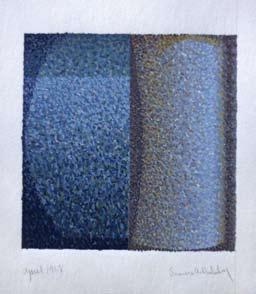
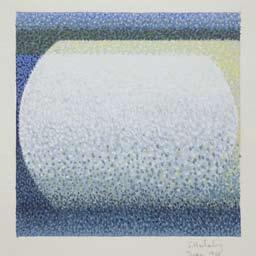

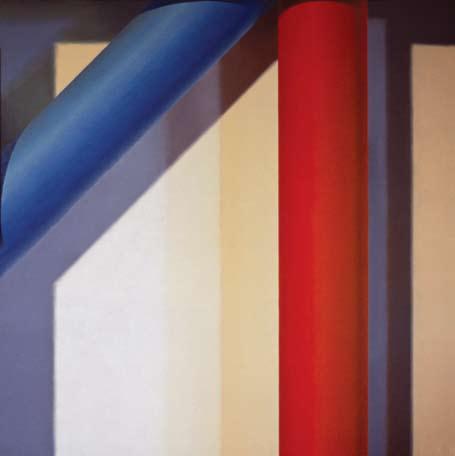
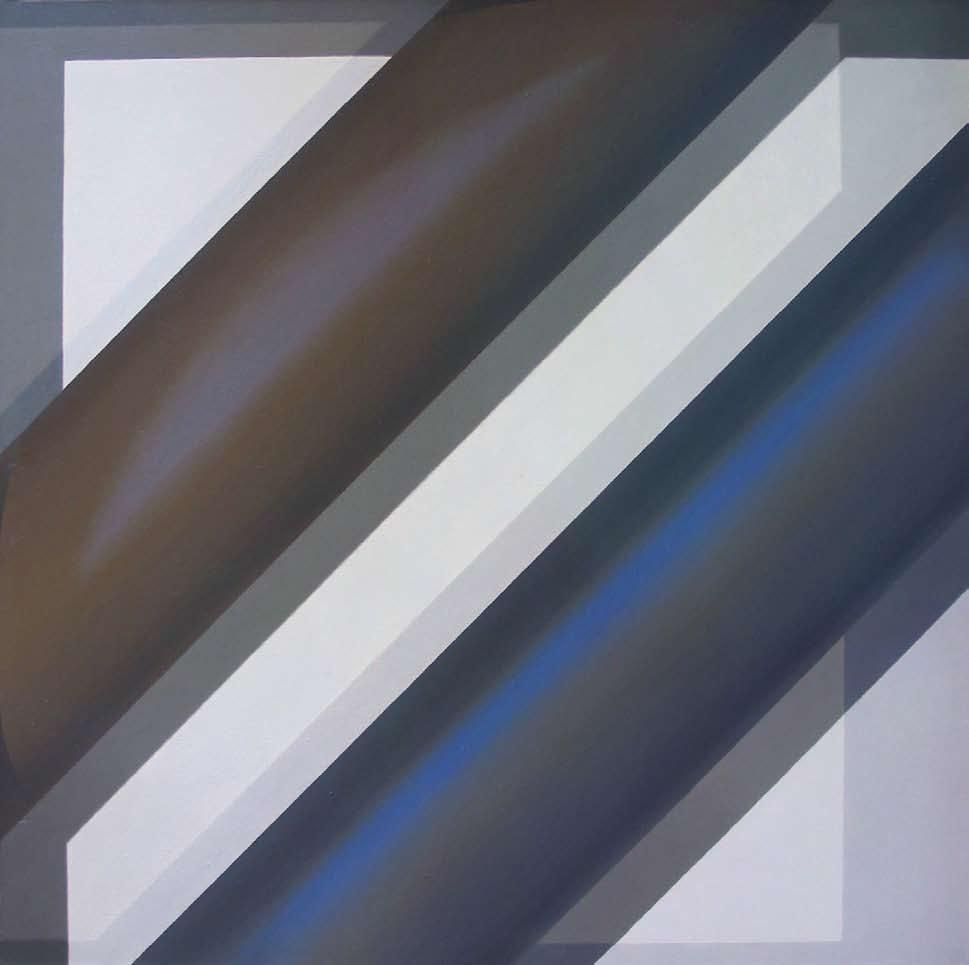
46 47 يقفألا س�يبألا نياوطش�ألا Horizontal W hite Cylinder, 1968. Gouache on paper, 6 x 6’’, 15 x 15 cm. ➤ ينلئام ينيناوطش�أا ينلكش� Two Diagonals, 1968. Oil on canvas, 35 x 35’’, 89 x 89 cm. ةيبهذلا ةبش�نلا Golden Section, 1968. Oil on canvas, 35 ½ x 35 ½’’, 90 x 90 cm. Private collection. ة ش�فلا ةب �نلا Silver Section, 1969. Oil on canvas, 36 x 36’’, 91.5 x 91.5 cm. Private collection. ثلاثلا عطاقتلا Third Cr oss, 1968. Gouache on paper, 4 ½ x 4 ½’’, 11.5 x 11.5 cm.
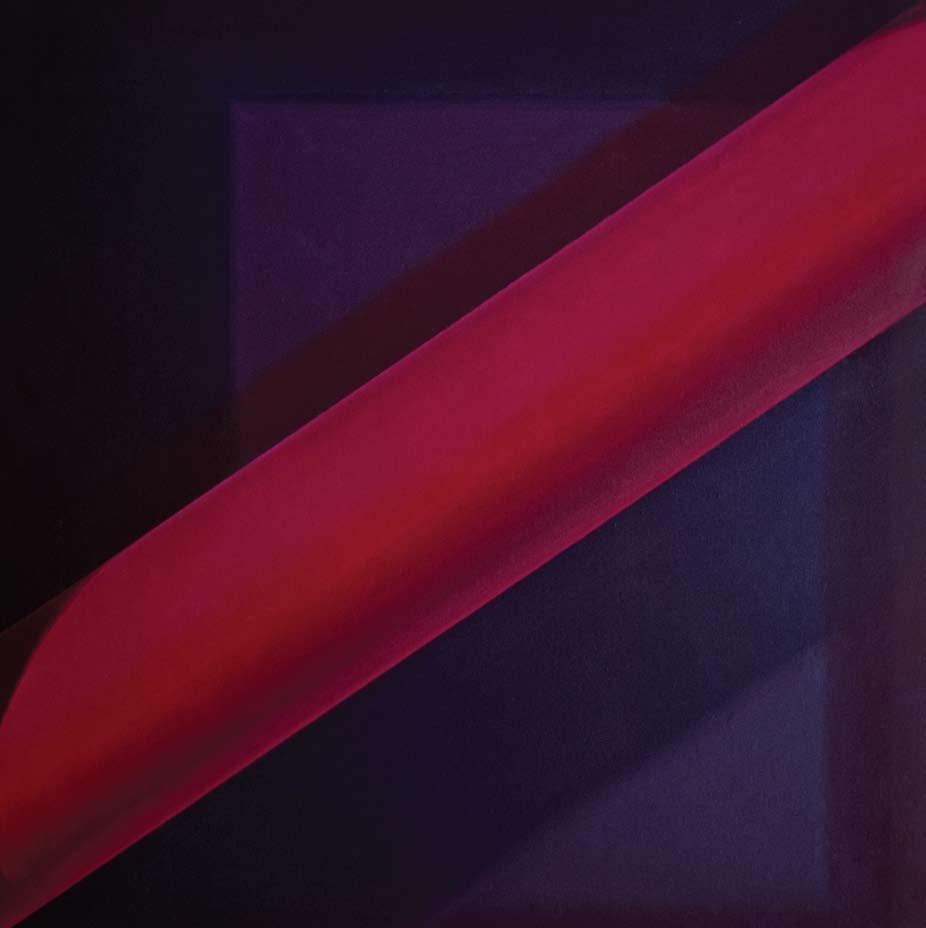
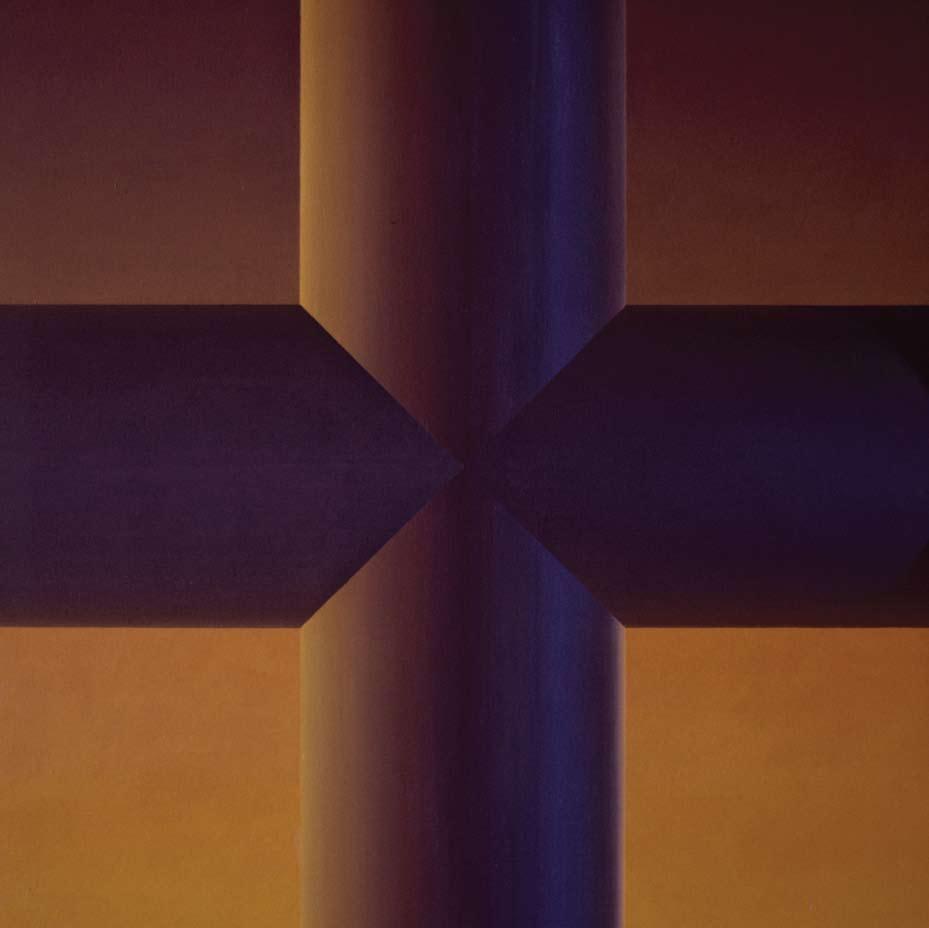
48 49 عباش�لا عطاقتلا
لئام رمحأ نياوطش�أا لكش�
Seventh Cross, 1969. Oil on canvas, 48 x 48’’, 122 x 122 cm. Corporate collection.
Red Diagonal, 1969. Oil on canvas, 48 x 48’’, 122 x 122 cm. Coll. First National Plaza.
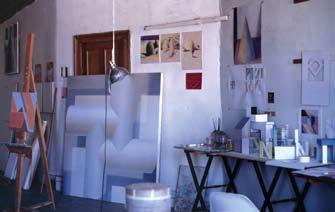
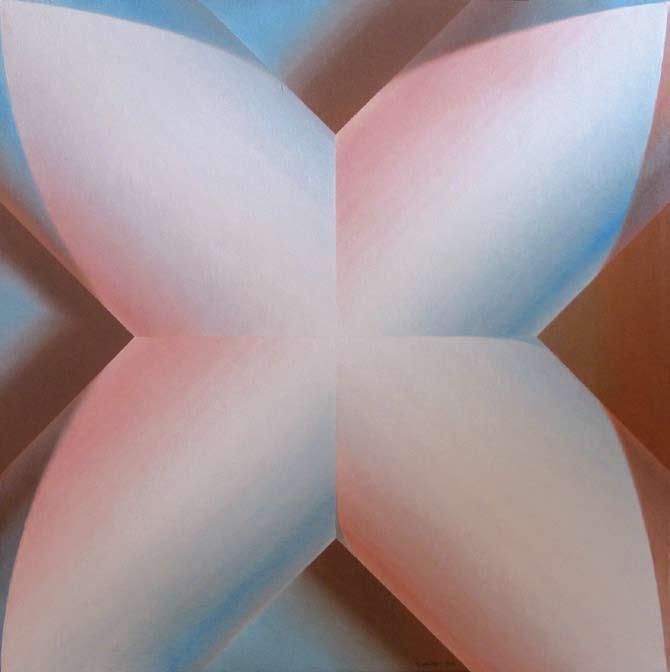
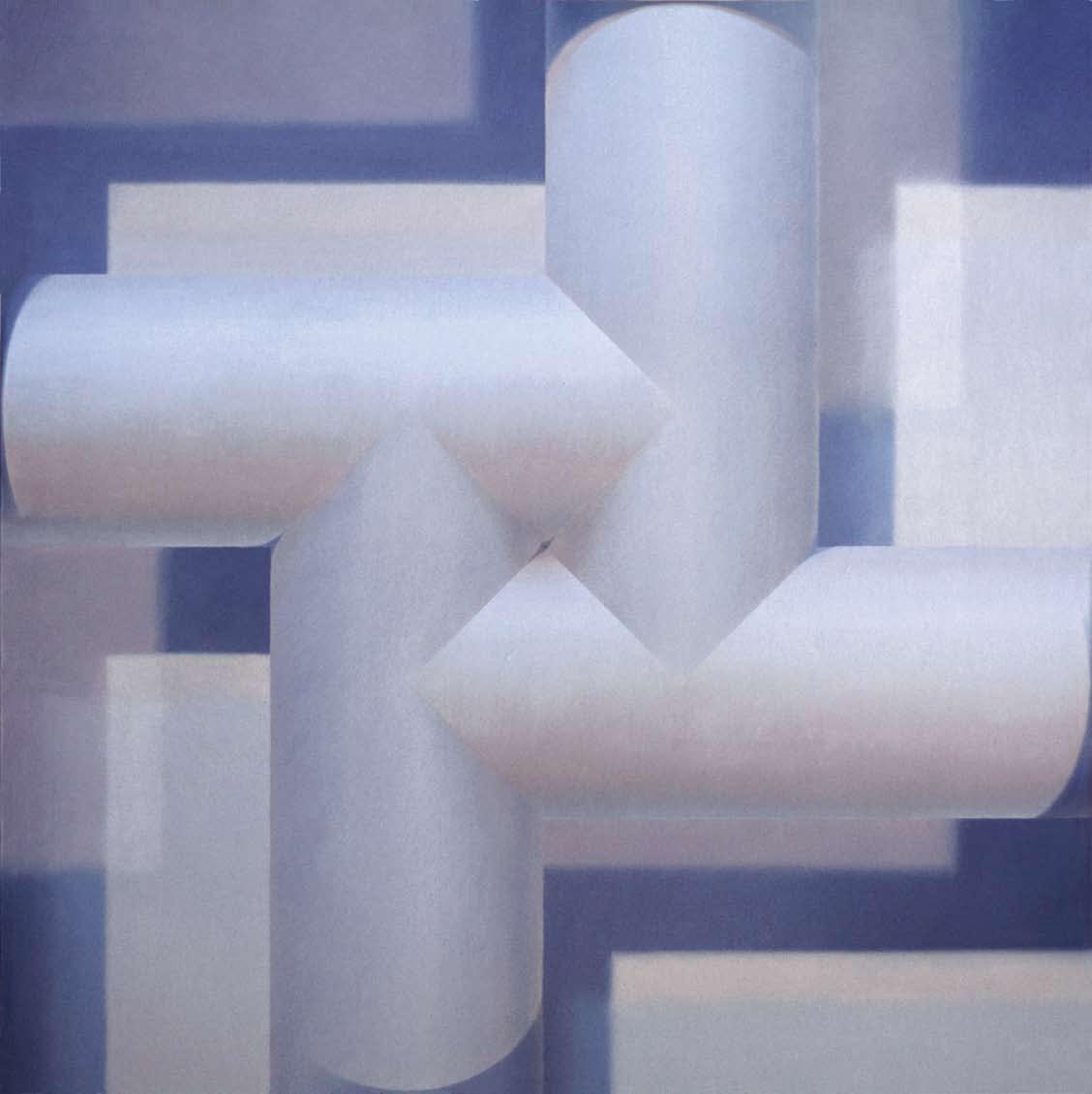
50 51 لئام عطاقت
س�مالخا عطاقتلا ➤
Diagonal Cross, 1969. Oil on canvas, 35 x 35’’, 90 x 90 cm.
Fifth Cross, 1968.
Oil on canvas, 66 x 66’’, 167.5 x 167.5 cm. Coll. Indiana University Museum.

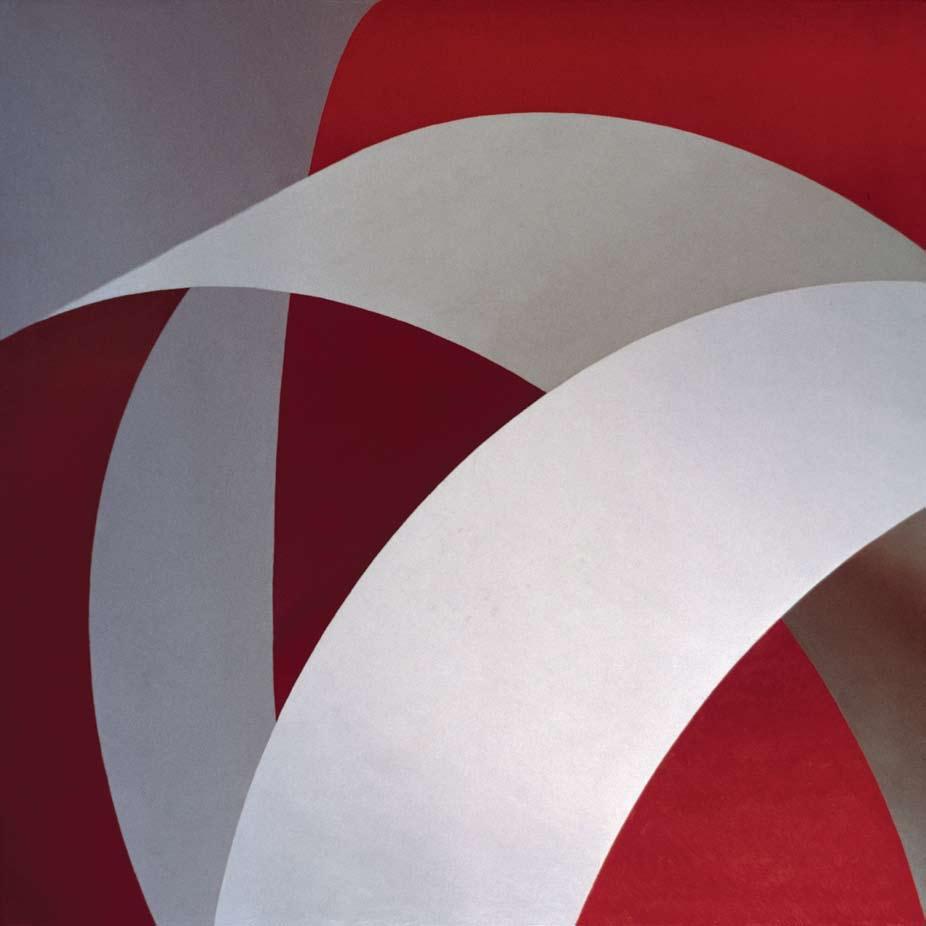
52 53 ءاش�يبو ءادوش� تاقلح
ءاش�يبو ءارمح تاقلح
Black and White Rings, 1969. Oil on canvas, 48 x 48’’, 122 x 122 cm. Private collection.
Red and White Rings 1969. Oil on canvas, 30 x 30’’, 76 x 76 cm.
"Moving from spheres to cylinders to rings, I felt it was time to explore the cube. In this painting, I placed a smaller white cube inside a larger brown cube and allowed the perimeter of one side of the larger brown cube to coincide with the square edge of the painting. We only see the top surface of the smaller white cube and thus it appears to float as a white square in the brown space."
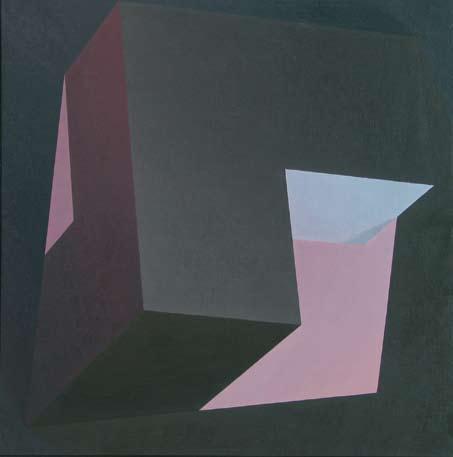

"En passant des sphères aux cylindres aux anneaux, j'ai senti qu'il était temps d'explorer les possibilités du cube. Dans cette toile, j'ai placé un petit cube blanc dans un cube brun plus grand et j'ai fait en sorte que les contours du grand cube brun coïncident avec la bordure carrée du tableau lui-même. On ne voit que le dessus du petit cube blanc et il semble donc flotter, comme un carré blanc dans un espace brun."
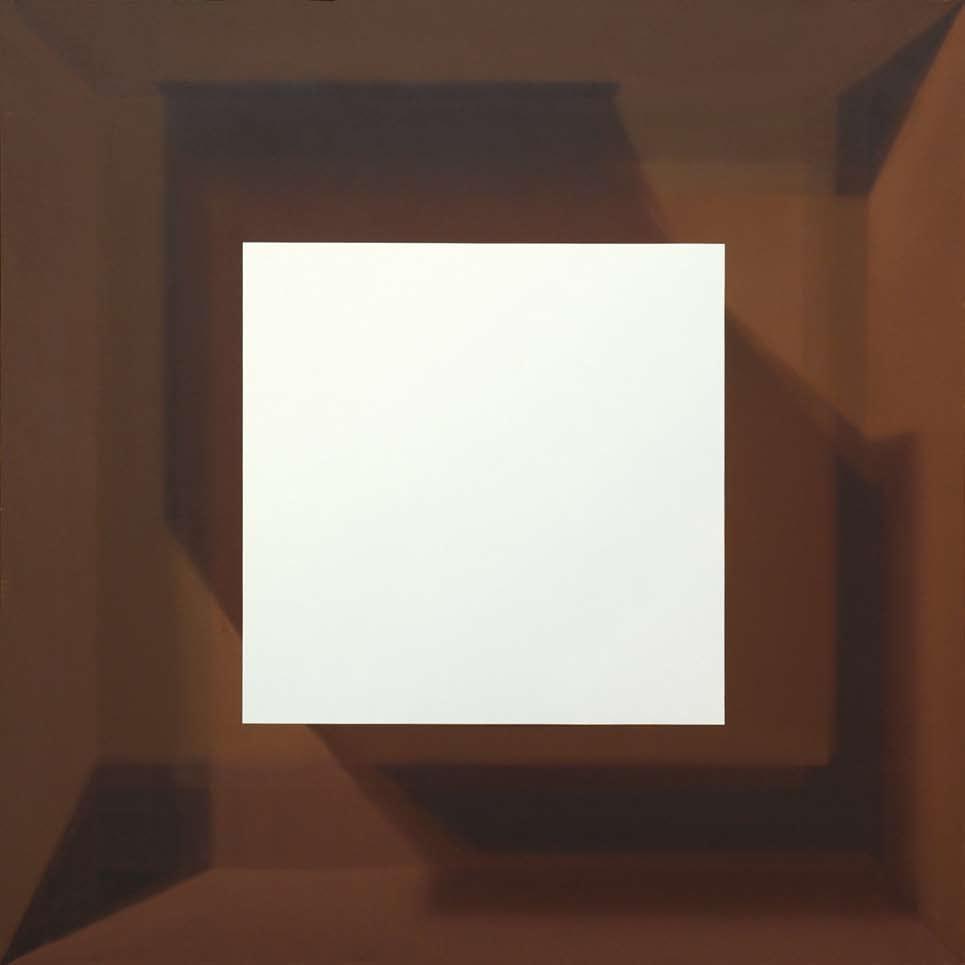
54 55 لوألا بعكلما فش�ن First Half Cube, 1970. Oil on canvas, 21 x 21’’, 53 x 53 cm. نياثلا بعكلما فش�ن Second Half Cube, 1970. Oil on canvas, 21 x 21’’, 53 x 53 cm. ينب بعكم لخاد س�يبأ بعكم White Cube in Brown Cube, 1968. Oil on canvas, 48 x 48’’, 122 x 122 cm. ترعش� ،تاقللحا لىإ تاناوط �ل لىإ تاركلا نم لاقتنلاب " ابعكم تعش�و ةحوللا هذه في .بعكلما فاش�كت �ل تقولا ناح هنأ يجرالخا طيحلما تلعجو هنم بركأا ينب بعكم لخاد ش�يبأ ةعبرلما ةفالحا عم قباطتي يربكلا ينبلا بعكلما هوجو ىدحإل يرغ �لا س�يبألا بعكملل يولعلا حط �لا طقف ىرن نحن .ةحولل " .ةينبلا ةحا �لما في س�يبأا عبرمك ايفاط كلذب ودبيف
➤
The painting “Third Spiral” (1970, page 57) is an example of this influence, as an eight-sided star, or octagram which would otherwise have a twodimensional appearance, seems to occupy the picture plane with intense volume. Utilizing the techniques that she had located in earlier canvases of this series—shading, sharp angles and luminous color—she accentuates the star’s complex design while maintaining the fundamental properties of Islamic art, which define the picture plane.
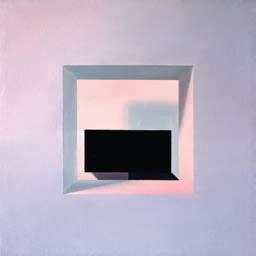


Composed of two overlapping squares, with one that is turned at a 45-degree angle, the octagram uses symmetry to reference the cardinal directions, the four seasons and the vastness of the universe. Accordingly, Halaby’s spiral has eight points, four belonging to a smaller square in the center and another set belonging to a square that appears to have been taken apart at the seams. Each square possesses four right angles that are equidistant from the center of the composition, which has a black square that is turned on its side.
One of the main facets of Islamic art is that all things found in nature begin from the same point of origin and eventually return to that center, alluding to an infinite cycle of regeneration. Halaby has found this to be most compelling, explaining that, “In [Islamic art] there is a sense of numbers and rhythms, duplicating principles of nature—not its appearance. My paintings are therefore an image of nature. They expose what the mind comprehends”
(Indiana Alumni Magazine, 1980).
In “Third Spiral” the Islamic star is painted in spiral form, further suggesting the immensity of the natural world and creating a sense of continuous movement in space and time, what is known as the fourth dimension In subsequent paintings, she would continue to refer to this cycle and constant state of motion.
(Continued page 62)
La toile "Third Spiral [Troisième Spirale]" (1970) est un bon exemple de cette influence, car une étoile à huit branches, ou octogramme qui aurait autrement semblé bidimensionnelle, semble occuper le plan spatial avec un volume intense. En utilisant les techniques identifiées dans les premières toiles de cette série, c'està-dire des zones d'ombre, des angles pointus et une couleur lumineuse, elle accentue la structure complexe de l'étoile tout en préservant les propriétés principales de l'art islamique, qui définissent le plan spatial.
Composé de deux carrés superposés, dont l'un est pivoté à un angle de 45 degrés, l'octogramme utilise la symétrie pour faire référence aux points cardinaux, aux quatre saisons et à l'étendue de l'univers. Ainsi, la spirale de Halaby inclut-elle huit pointes, dont quatre appartiennent à un carré plus petit au centre et les autres à un carré dont les bords semblent avoir éclaté. Chaque carré a quatre angles droits équidistants par rapport au centre de la composition où se trouve un carré noir renversé de côté.
L'une des facettes les plus importantes de l'art islamique est que toutes les choses de la nature ont le même point de départ et doivent finalement retourner à ce même point, évoquant un cycle infini de régénération. C'est ce qui attire Halaby par-dessus tout, et elle explique que "[L'art islamique] donne une impression de nombres et de rythmes qui reproduisent les principes de la nature plutôt que son apparence. Mes tableaux sont donc une image de la nature. Ils mettent en évidence ce que l'esprit comprend" (Indiana Alumni Magazine, 1980).
Dans "Third Spiral", l'étoile islamique est peinte sous forme de spirale, ce qui suggère d'autant plus l'immensité du monde naturel et crée un sentiment de mouvement continu dans l'espace et le temps, ce qu'on appelle la quatrième dimension Elle continuera dans ses tableaux suivants de faire allusion à ce cycle de régénération et à un état de mouvement perpétuel.
(Suite page 62)
56 57 دو �ألا قودنش�لا Black Box, 1969. Oil on canvas, 18 x 18’’, 45.5 x 45.5 cm. Private collection. ثلاثلا نيوزللحا Third Spiral, 1970. ➤ Oil on canvas, 66 x 66’’, 167.5 x 167.5 cm. ةص�ارد ،ثلاثلا نيوزللحا Third Spiral, 1970. Color pencil on paper, 8
8’’, 20.5
20.5
x
x
cm.
Yellow Spiral, 1970. Oil on canvas, 66 x

ثاثلثم Triangles, 1972. Tamarind Lithograph, 21 x 21’’, 53.5 x 53.5 cm.

"Exploring forms on graph paper allowed me to create ambivalent form instead of exploring ambivalence in the way we see. Graph paper also allowed me to imagine how I might express my deep admiration of Arabic architecture and calligraphy. Later, I began to plot conical spirals, called helixes, which started the next series of paintings."
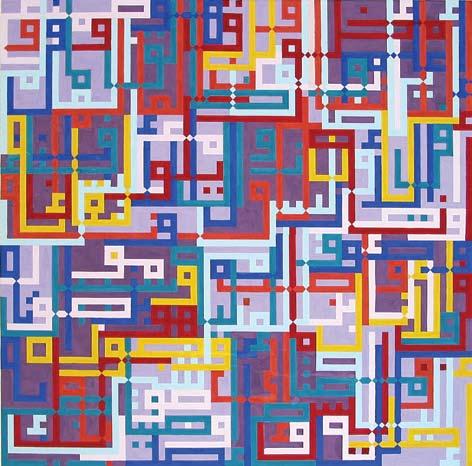
"Le fait de construire des formes sur papier millimétré m'a permis de créer des formes ambiguës, plutôt que de faire des recherches sur l'ambiguïté inhérente à notre façon de voir. Le papier millimétré m'a aussi permis d'imaginer comment je pourrais exprimer mon admiration profonde pour l'architecture et la calligraphie arabes. Plus tard, j'ai commencé à dessiner des spirales coniques, c'est à dire des hélices, qui ont marqué le point de départ d'une nouvelle série d'œuvres."
1978.
Gouache on paper, 18 x 18’’, 45.5 x 45.5 cm.
58 59 م عا
Know,
رفش�ألا نيوزللحا
66’’, 167.5 x 167.5 cm. نأ نيايبلا مش�رلا قاروأ ىلع لاكش�ألا فاش�كت �ا لي حم � " يتلا ةقيرطلا في نيابتلا فاش�كت �ا نم لدب انيابتم لاكش� قلخأ يأ لىإ ليختأا نأا نيايبلا م �رلا قرو لي حم � امك .اهيف ىرن ةرامعلابو يبرعلا طلخاب قيمعلا يباجعإ نع برعأ نأ يننكيم دح ،تانوزلح ىعدت ،ةيطورمخ بلاول مش�رأ تأادب ،دعب اميف .ةيبرعلا " .تاحوللا نم ةيلاتلا ة �لش�لا ت �ش�أ يتلا
➤
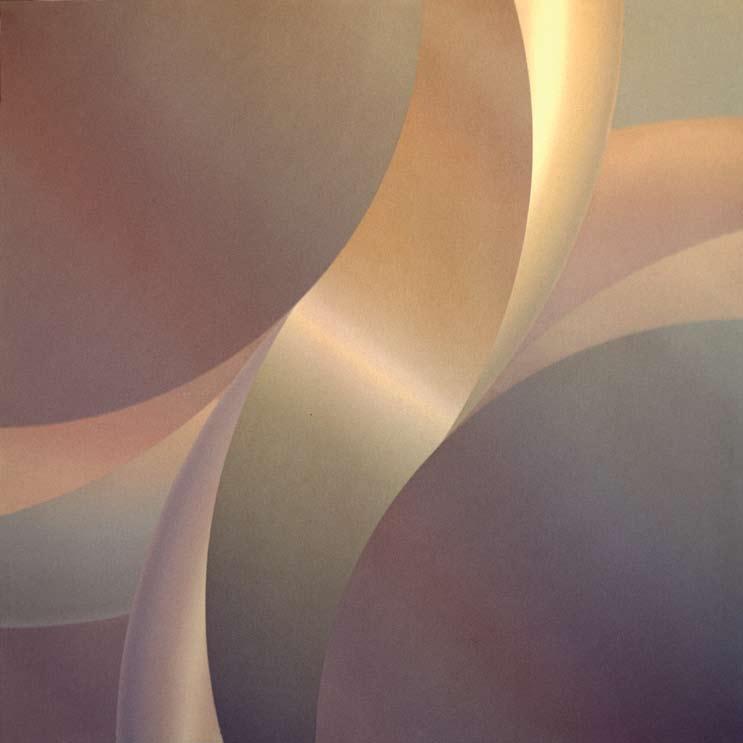
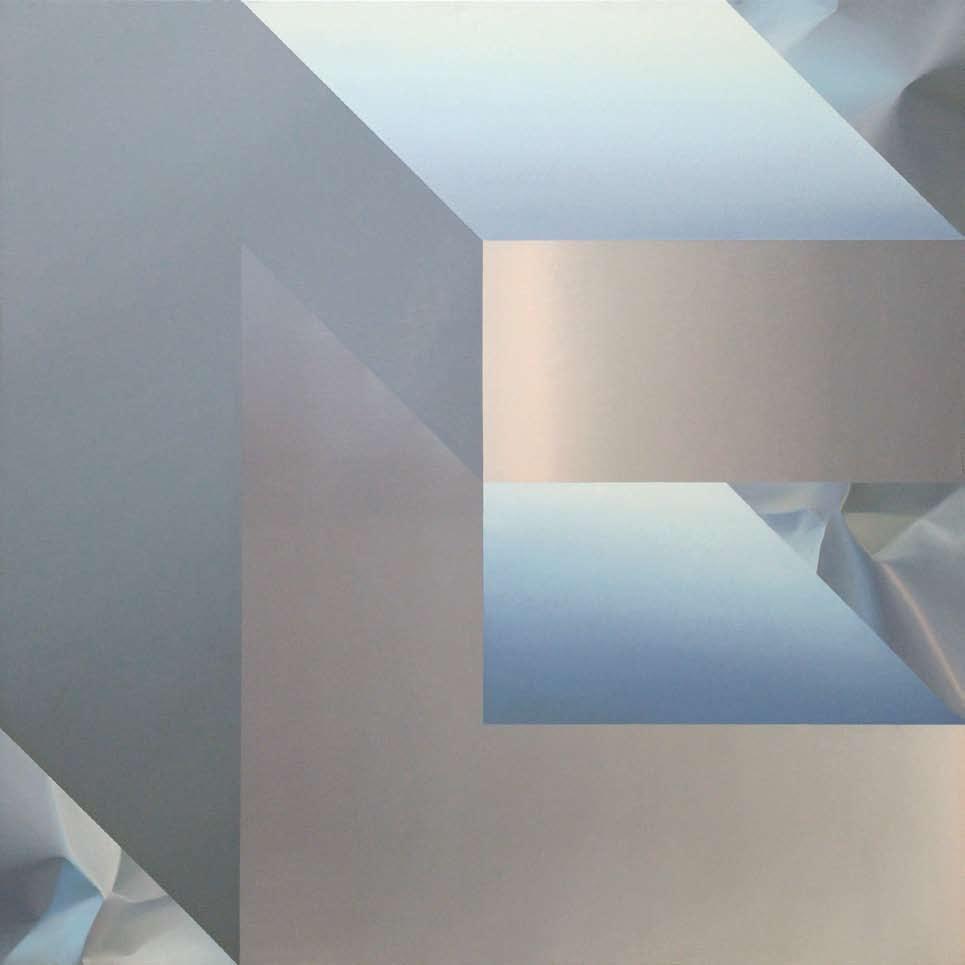
60 61 س�مالخا نيوزللحا Fifth Spiral, 1970. Oil on canvas, 48 x 48’’, 122 x 122 cm. Private collection. ➤ س�يبألا نيوزللحا White
1970. Oil on
66 x 66’’, 167.5
167.5
Spiral,
canvas,
x
cm.
Helixes and Cycloids: 1971-1975 Hélices et Cycloïdes: 1971-1975
At the end of the Geometric Still Life series, once again she found herself at a critical point in her development. After determining that by giving so much attention to “the confines of the rectangle” she was “focusing on the single individual human self and his or her world of thought and understanding” she decided to completely embrace figurative representation. She summoned Nabil-al Nawwab—a close Iraqi friend whom she had met while teaching at Indiana University—to pose for her, incorporating one of her geometric constructions as a still life within the portrait. The process left Halaby with a clear idea of how she would proceed.
Doing this portrait told me that my next step was to shift my direction from an internal focus on the picture to an external one. Thus the new paintings allowed motion to proceed diagonally outward pointing to the outside of the picture. I focused on beautiful helical and cycloid curves. I spent nearly six months carefully drafting helical curves then treated them as a world from where I would select a rectangular section to become a painting (Correspondence with the artist, 2010).
As a point of reference, the artist purchased several used books on geometry, especially those written for engineers and technicians specializing in the cutting and fitting of heating pipes. The necessity to join forms was a central component of these new works, as each helix and helicoid shape was carefully plotted on a graph.
This is demonstrated in an early work from the series titled “Blue and Orange Helix” (1972, page 64), in which it is impossible to distinguish between the foreground and background of the composition. By first arranging these shapes on graph paper, Halaby created abstraction without being concerned with a formal picture plane. Gone was the need to situate her composition against a two-dimensional surface, which would call for an illusionist approach utilizing background as a means of defining negative and positive space. The arrangement of helixes and helicoids that appears in “Blue and Orange” shows

A la fin de la série "Natures Mortes Géométriques", elle se retrouve une fois de plus à une conjoncture critique de son évolution. Après avoir réalisé qu'en attachant autant d'importance à l'"espace délimité par le rectangle "elle" ne se concentrait que sur un seul être humain et sa manière de penser et de comprendre", elle décide d'opter pour la représentation figurative. Elle demande à Nabil al Nawwab - un ami proche irakien qu'elle avait rencontré lorsqu'elle enseignait à l'université d'Indiana – de poser pour elle, incorporant l'une de ses constructions géométriques en guise de nature morte à l'intérieur du portrait. Ce processus donne à Halaby une idée précise de la façon dont elle souhaite procéder:
Le fait de faire ce portrait m'a appris que l'étape suivante serait de changer de direction, d'une focalisation interne sur le tableau à une focalisation externe. Mes nouvelles toiles permettaient ainsi au mouvement de procéder diagonalement vers l'extérieur, indiquant l'espace hors du tableau. Je me suis concentrée sur de magnifiques courbes hélicoïdales et cycloïdes. J'ai passé six mois à faire des croquis de courbes hélicoïdales et je les ai traitées comme un monde duquel je pourrais extraire une section rectangulaire qui deviendrait un tableau. (Correspondance avec l'artiste, 2010).
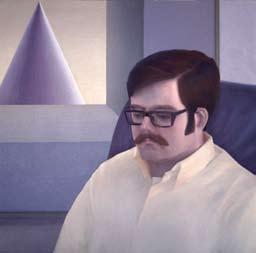
L'artiste achète alors plusieurs livres de géométrie d'occasion en guise de référence, particulièrement ceux écrits pour des ingénieurs et techniciens spécialisés dans la coupe et la pose de tuyaux de chauffage. Le besoin de joindre des formes est une composante essentielle de ces nouvelles œuvres, ce qui explique pourquoi elle conçoit minutieusement chaque hélice et forme hélicoïdale sur du papier millimétré.
Une œuvre du début de la série intitulée "Blue and Orange [Bleu et Orange]" (1972) le montre bien: dans cette composition, il est impossible de distinguer le premier plan de l'arrière plan. En concevant tout d'abord ces formes sur du papier millimétré, Halaby privilégie l'abstraction sans se préoccuper d'un espace pictural formel. Il n'est alors plus besoin de situer la composition sur une surface en deux dimensions, ce qui requerrait une démarche illusionniste utilisant le fond comme façon de définir les espaces positifs et négatifs.
62 63
يطورخلما نوزللحا
ليبن Nabile, 1970. Oil on canvas, 30 x 30’’, 76 x 76 cm. Private collection.
Conical Helix, 1971. Oil on canvas, 30 x 30’’, 76 x 76 cm. Private collection.
that instead the artist has shaded each shape so that not one will recede, creating the exact sense of “continuum between volume and surface” that she had identified in Islamic art and architecture in the mid 1960s. She has done so with narrow bands of colors that fade into each other. The effect also gives their forms a metallic appearance as light seems to be cast from certain hues.
Reflecting on these works Halaby explains, In a way it was a continuation of my graph paper geometry. As I shaded areas, space became complex and non measurable. I shaded with a formal idea based on medieval Arabic abstraction where both shape and background were treated in ways that pulled them to one surface, to the front. Thus they vied for space in the frontal plane. Since the parts were shaded imitating the unstable surface appearance of shiny metals, the resulting spatial tension created a relativity of parts in spite of shading (Correspondence with the artist, 2010).
As the series progressed, she became interested in the properties of metals, which are the only substances to have colored highlights. This corresponded with the use of color and shading that she had already been using in such paintings as “Blue and Orange” and by studying this effect, she was able to add greater depth to her compositions. It also allowed for the more acute pronunciation of colors in the narrow bands that dominated the surfaces of her helixes and helicoids. Shading thus became secondary as the shapes took on an increased sense of volume and lines began to intersect and define space. “Boston Aquarium,” (page 71) a work completed in 1973 that is dominated by variations of blue, purple, white and browns, demonstrates this effect.


After closely watching the movement of fish one day, Halaby found they resembled the helix shapes that she was incorporating into her work. By combining the patterns and colors of their movement with the “metallic impressions” that she was painting, she was able to locate the “cyclical” force of the helix in the image of the swimming fish. The result was a composition that reflected the dynamic nature
L'agencement des hélices et des formes hélicoïdales qui figure dans "Blue and Orange" montre que l'artiste a au contraire donné des ombres à chaque forme de façon à ce qu'aucune ne fuie, créant l'impression exacte d'une "continuité entre volume et surface" qu'elle avait identifiée dans l'art et l'architecture islamiques au milieu des années 60. Pour cela elle a recours à de fines bandes de couleur qui se fondent l'une dans l'autre. L'effet donne également aux formes un aspect métallisé par la lumière qui semble provenir de certains tons.
Halaby commente ainsi ces œuvres:
C'était en quelque sorte une continuation de ma géométrie sur papier millimétré. En ombrant certaines zones, l'espace devenait complexe et impossible à mesurer. Ces ombres venaient d'une idée formelle fondée sur l'abstraction arabe médiévale où les formes et le fond étaient tous deux traités de façon à les tirer vers la surface, vers le devant. Ainsi, ils rivalisaient pour le premier plan. Comme certaines ombres imitaient l'apparence instable des surfaces des métaux brillants, la tension spatiale qui en résultait engendrait une relativité des parties malgré les ombres. (Correspondance avec l'artiste, 2010).
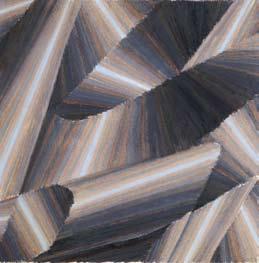
Tandis que la série progresse, elle commence à s'intéresser aux propriétés des métaux, qui sont les seules substances dont les reflets sont colorés. Ceci correspond à l'utilisation de la couleur et des ombres qu'elle avait déjà employées dans des toiles telles que "Blue and Orange" mais ses compositions gagnent en profondeur de l'étude de cet effet. Il lui permet également d'accentuer plus fermement les fines bandes de couleur sur la surface des hélices et formes hélicoïdales. Les ombres deviennent alors secondaires car les formes acquièrent de plus en plus de volume et les lignes commencent à s'entrecroiser et à définir l'espace. "Boston Aquarium [L'Aquarium de Boston]", une œuvre terminée en 1973 dans laquelle dominent des variations de bleu, violet, blanc et brun, témoigne de cet effet.
En observant un jour de près le mouvement des poissons, Halaby trouve qu'il ressemble aux formes hélicoïdales qu'elle incorpore alors dans son œuvre. En combinant les motifs et les couleurs de leurs mouvements avec les "impressions métallisées" qu'elle peignait alors, elle parvient à localiser la force
64 65 لياقترب و قرزأا نوزلح
Blue and Orange Helix, 1972. Oil on canvas, 24 x 24’’, 61 x 61 cm. Private Collection.
غارفلا طغص�
ةينوزلح حوط � لخادت
Compression of Space, 1972. Pastel on paper, 24 x 22’’, 61 x 56 cm.
Overlapping Helicoids, 1972. Pastel on paper, 24 x 22’’, 61 x 56 cm.
of marine life through the implied movement of abstraction. Considered by the artist to be her first major work, it is perhaps the best example of the visual experiments that resulted from this series. As Halaby contends, “every part seems to push out towards the space of the viewer by its shading and metallic reflectivity. Color was not localized, nor light single-directional” (Leonardo Vol. 20, No.3, 1987).
“Boston Aquarium” led to transitional works that began to expand the curves of helicoids to greater proportions. The result was the elimination of the axis around which a plane had been twisted in order to create a helicoid’s spiral. What remained was the use of lines and shading to suggest movement and rounded forms. The 1974 painting “Mediterranean,” (page 77) which was inspired by the artist’s recurring dream as a child living in Jaffa, provides hints of her subsequent Diagonal Flight series. In her dream Halaby stands on the edge of the shore at night, watching as an enormous wave comes to her that is suspended in air but full of motion. The body of water is in actuality an old woman who relays important things to the young Halaby.
The connection between the artist’s dream and “Mediterranean” is clear, as the painting is characterized by the curved edges of forms that seem to break or crash onto each other. Resembling the natural motion of waves, the painting suggests the limitless power and transfer of energy that occurs.
(Continued page 84)
"cyclique" de l'hélice dans l'image de poissons en train de nager. La composition qui en résulte reflète la nature dynamique de la vie sous-marine à travers le mouvement allusif de l'abstraction. Considérée par l'artiste comme sa première œuvre majeure, c'est peutêtre le meilleur exemple des expériences visuelles qui résultent de cette série. Comme le dit Halaby, "chaque partie semble être projetée vers l'extérieur, vers l'espace du public, par ses ombres et sa réflectivité métallisée. La couleur n'est pas localisée, et la lumière ne provient pas non plus d'une direction unique." (Leonardo, Vol. 20, No.3, 1987)
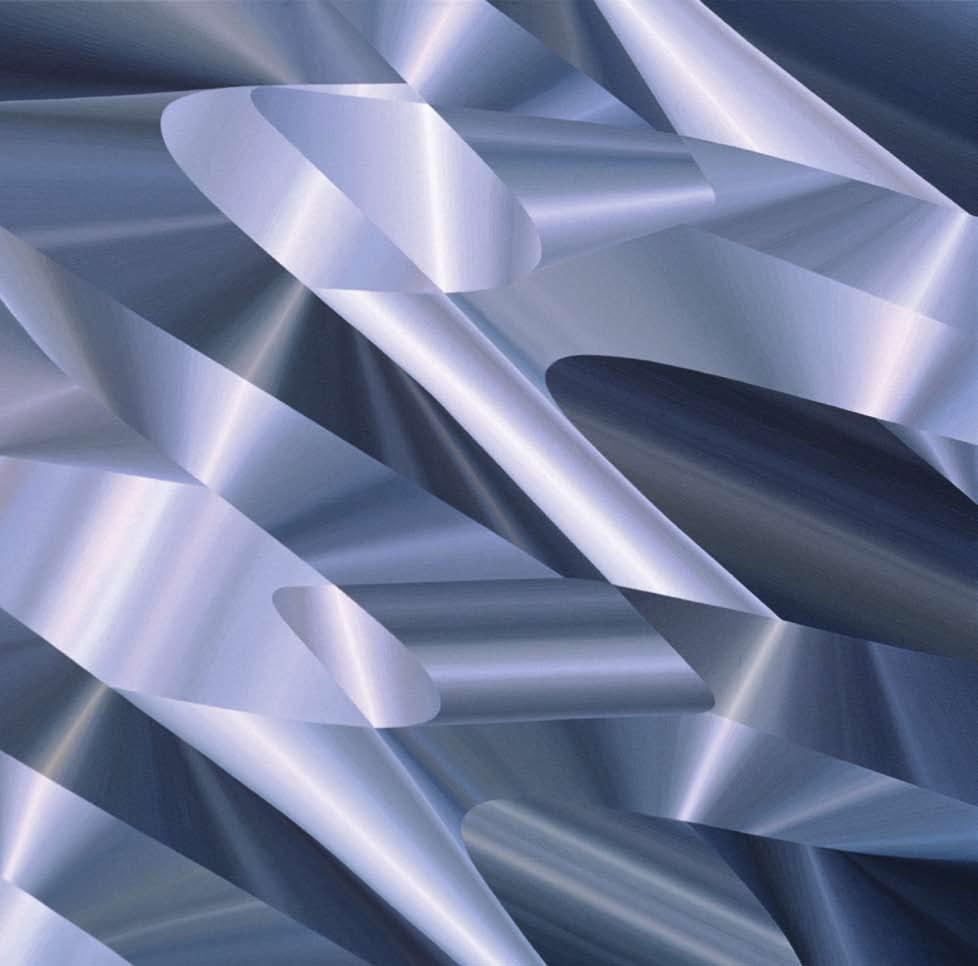
"Boston Aquarium" la mène vers des œuvres de transition où les courbes des formes hélicoïdales commencent à prendre de plus amples proportions. Il en résulte l'élimination de l'axe autour duquel un plan a été enroulé afin de créer la spirale de la forme hélicoïdale. Il ne reste donc que l'utilisation de lignes et d'ombres pour suggérer le mouvement et les formes arrondies. La toile de 1974, "Mediterranean [Méditerranée]", qui s'inspire d'un rêve récurrent de l'artiste lorsqu'elle était enfant à Jaffa, lui donne l'idée de sa série suivante, Diagonal Flight [Fuite Diagonale].
Dans son rêve, Halaby est debout au bord de la mer la nuit, regardant une vague énorme venir vers elle, suspendue en l'air mais pleine de mouvement. L'eau est en fait une vieille femme qui communique des choses importantes à la jeune Halaby.
Il y a un rapport évident entre le rêve de l'artiste et "Mediterranean", car le tableau se caractérise par les contours arrondis de formes qui semblent se casser ou tomber à grand fracas l'une sur l'autre. Ressemblant au mouvement naturel des vagues, le tableau suggère leur pouvoir illimité et transmet leur énergie.
(Suite page 84)
66 67 ➤ ذلوف و موينلمأا Aluminum and Steel, 1971. Oil on canvas, 66 x 66’’, 167.5 x 167.5 cm. Coll. Mead Art Museum, Massachusetts.
"In the Helix series I shaded volumes to seem to exist on one plane and tried to give the boundary of each shape as much convexity as concavity. I was also fascinated by the reflectivity of metallic surfaces. For this painting I held bent strips of aluminum and of steel and copied their colors. At completion, I noticed that the parallel bands of white in the painting were a reflection of the neon tubes in the ceiling and that the brown band with black on either side was a reflection of my face and my then black hair. Looking at the metallic strips had inadvertently become a looking into mirrors."
"Dans la série Hélices, j'ai ombré les volumes pour qu'ils semblent se trouver sur un seul plan et j'ai essayé de donner au contour de chaque forme autant de convexité que de concavité. Une autre chose qui me fascinait, c'était la réflectivité des surfaces métalliques. Pour faire cette toile, je tenais des bandes d'aluminium et d'acier courbées et j'ai recopié leurs couleurs. Une fois la toile finie, j'ai remarqué que les bandes blanches parallèles du tableau reflétaient les tubes de néon au plafond et que la bande brune bordée de noir de chaque côté était un reflet de mon visage et de mes cheveux, qui étaient noirs à l'époque. Par inadvertance, en regardant des bandes de métal je regardais des miroirs."

68 69 ةيش�خش� ةروش� Self Portrait, 1972. Oil on canvas, 66 x 66’’, 167.5 x 167.5 cm. Private collection. ىلع ةدوجوم اهنأا ودبت يكل لتكلا تللظ نوزللحا ةلش�ل � في " ردقب رعقتلا نم لكش� لك دودح يطعأا نأ تلواحو ىوتش�لما س�فن يتلا تا �اكعنلاب ةروحش�م تنك امك .بدحتلا نم هيطعأ ام ةينمح طئارش� تك �مأا ةحوللا هذه في .ةيندعلما حوط �لا اهيطعت ،ةحوللا لامتكا دنعو .اهناولأ تخ �نو ذلوفلاو موينلمألا نم س�اكعنا يه ةحوللا في ءاش�يبلا ةيزاوتلما طئارش�لا نأا تظحل ءادوش�لا فاولحا وذ ينبلا طيرش�لاو فقش�لا في نوينلا ءاوش�أل لىإا رظنلا .اهنيح دوش�أ ناك يذلا يرعش�و يهجو س�اكعنا ناك ".ايارم في رظنلا نم اعون د �ق نود نم را � ةيندعلما طئارش�لا
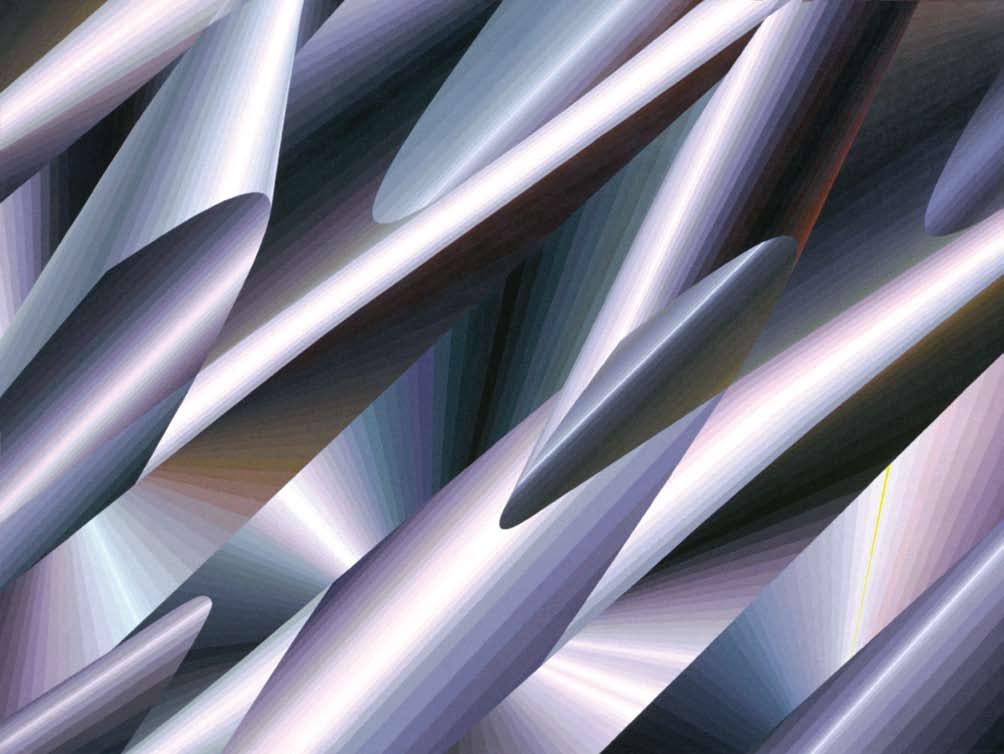

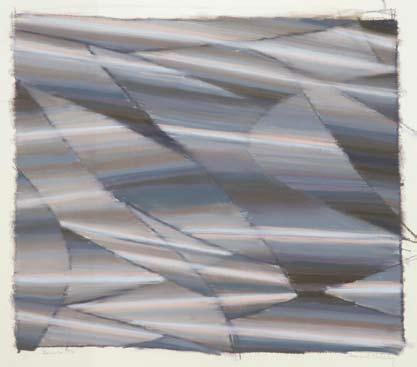
70 71 ة �ارد
مويراوكأ نط �وب
" وج " لىإا تاجوتم
Sketch, 1974. Pastel on paper, 17 ¾ x 19 ¼’’, 45 x 49 cm. "
" Boston Aquarium, 1973. Oil on canvas, 72 x 95 ½’’, 183 x 242.5 cm. Coll. Indiana University Museum.
Cycloids for Joe, 1973. Charcoal on paper, 22 x 29 ¾’’, 56 x 75.5 cm. Private collection.

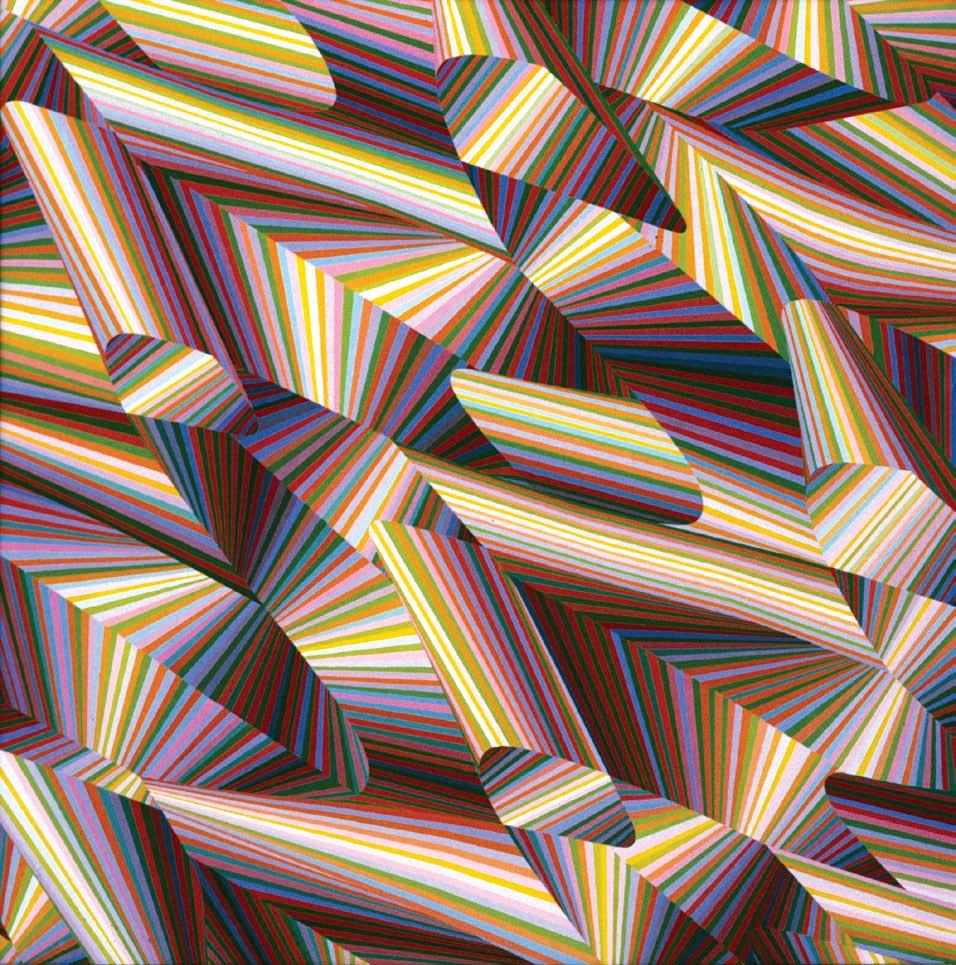
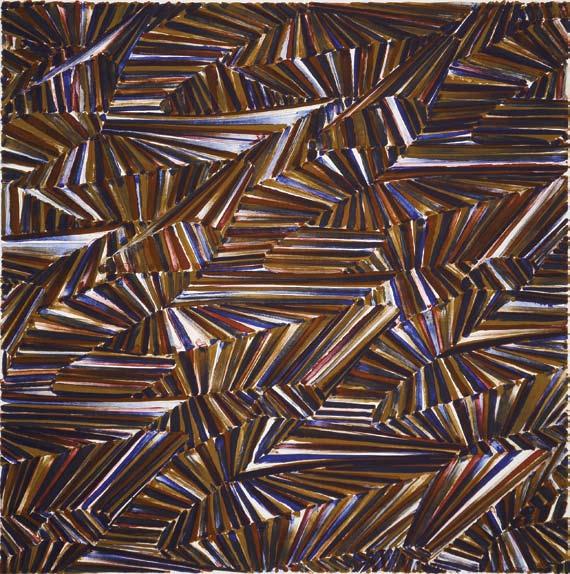
72 73
ةيحزق ةينوزلح لاكش�أ
يرغش� نوزلح Little Helix, 1971. Oil on masonite, 8 x 8’’, 20.5 x 20.5 cm.
Rainbow Spirals, 1973. ➤ Oil on canvas, 66 x 66’’, 167.5 x 167.5 cm. Private collection.
ةينبلا The Brown One, 1972. Lithograph, 22 x 22’’, 56 x 56 cm. Coll. The Cincinnati Art Museum

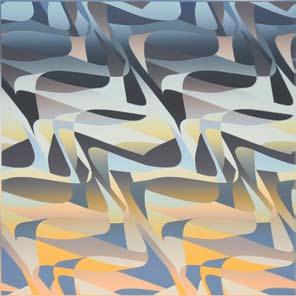

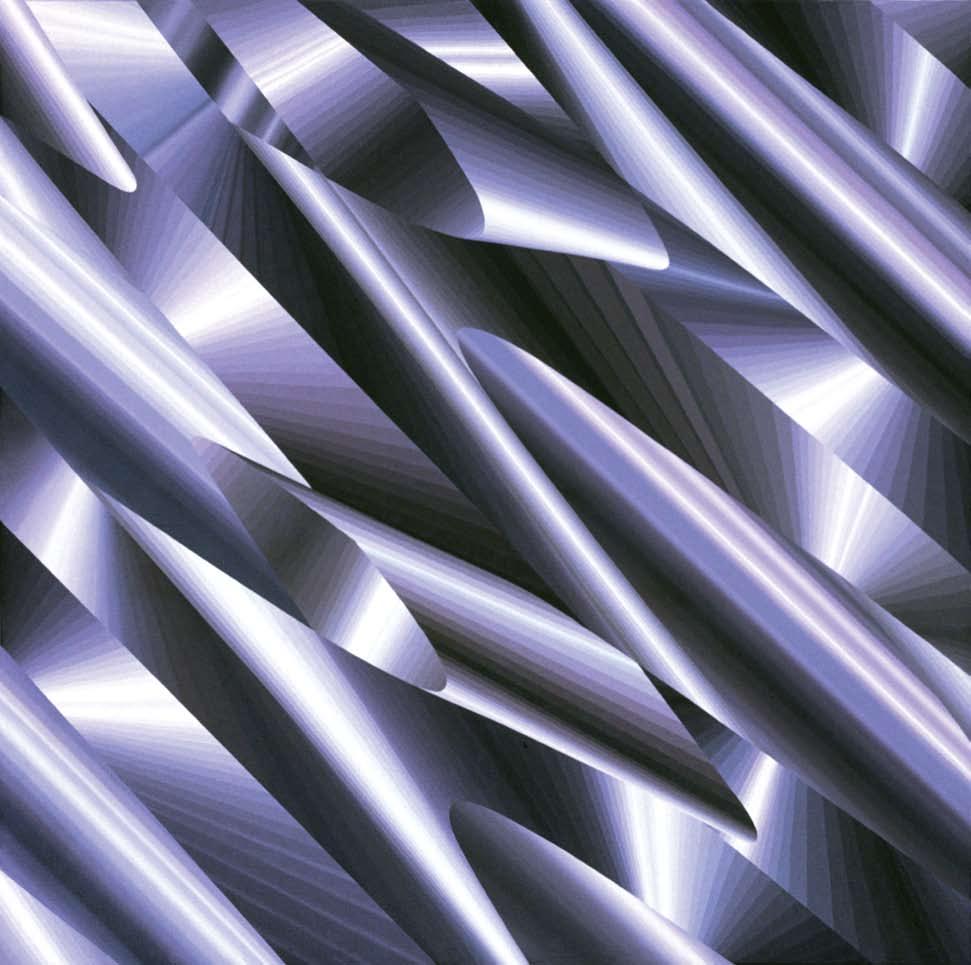
74 75 "
س�
يرك " ملق Chris’ Crayon, 1972.
"يكركبلأا"
Lithograph, 18 x 18’’, 45.5 x 45.5 cm. Coll. Indianapolis Museum of Art.
ةنيدم
في بورغ Albuquerque Sunset, 1972.
يدامر
Lithograph, 24 x 24’’, 61 x 61 cm. Coll. The Yale Gallery, Connecticut.
جردت Grey Blend, 1972.
رش�خأا رمحأا ذلوف ➤
Lithograph, 18 x 18’’, 45.5 x 45.5 cm. Coll. The Detroit Institute of Arts.
Red Green Steel 1972.
Oil on canvas, 66 x 66’’, 167.5 x 167.5 cm. Private collection.


76 77 ةعطاق جاومأ
طص�وتلما س�يبألا رحبلا
Slicer Waves, 1973. Oil on canvas, 48 x 48’’, 122 x 122 cm.
Mediterranean, 1974. Oil on canvas, 48 x 66’’, 122 x 167.5 cm. Coll. The Indianapolis Museum of Art, Indiana..
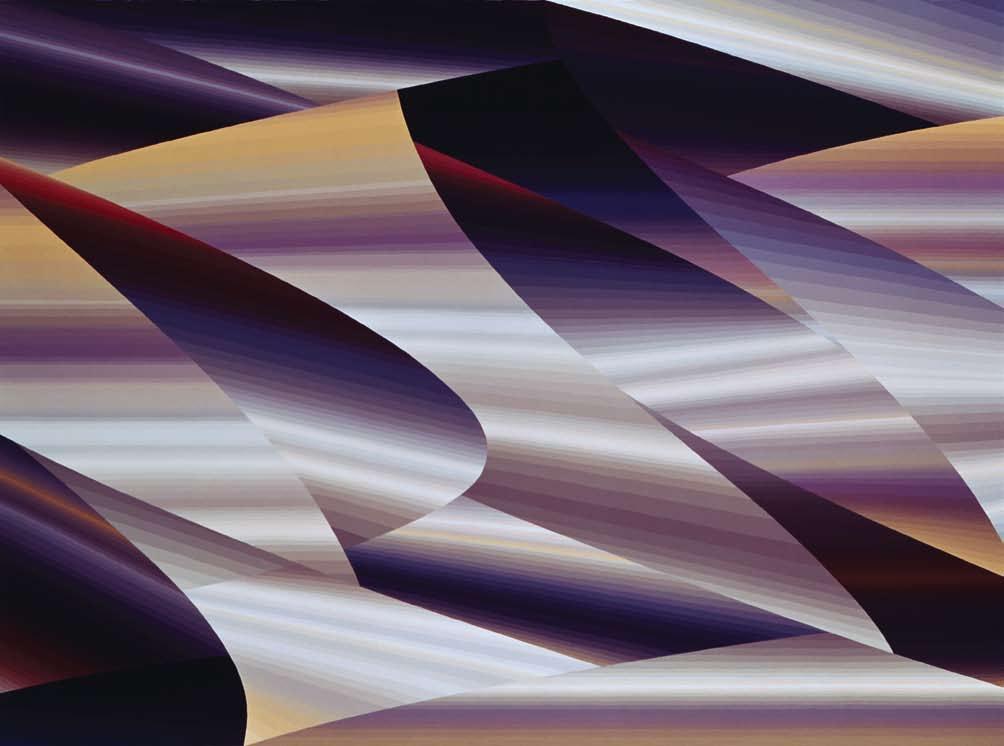

78 79 ارش�يوش�ل موينلمألا نم بيلوت
بهذلا في دورولا توتمو
Aluminum Tulips for Switzerland, 1974. Oil on canvas, 48 x 66’’, 122 x 167.5 cm. Coll. The Guggenheim Musem, New York.
And Roses Die in Gold, 1974. Oil on canvas, 48 x 66’’, 122 x 167.5 cm. Coll. The Indianapolis Museum of Art, Indiana.

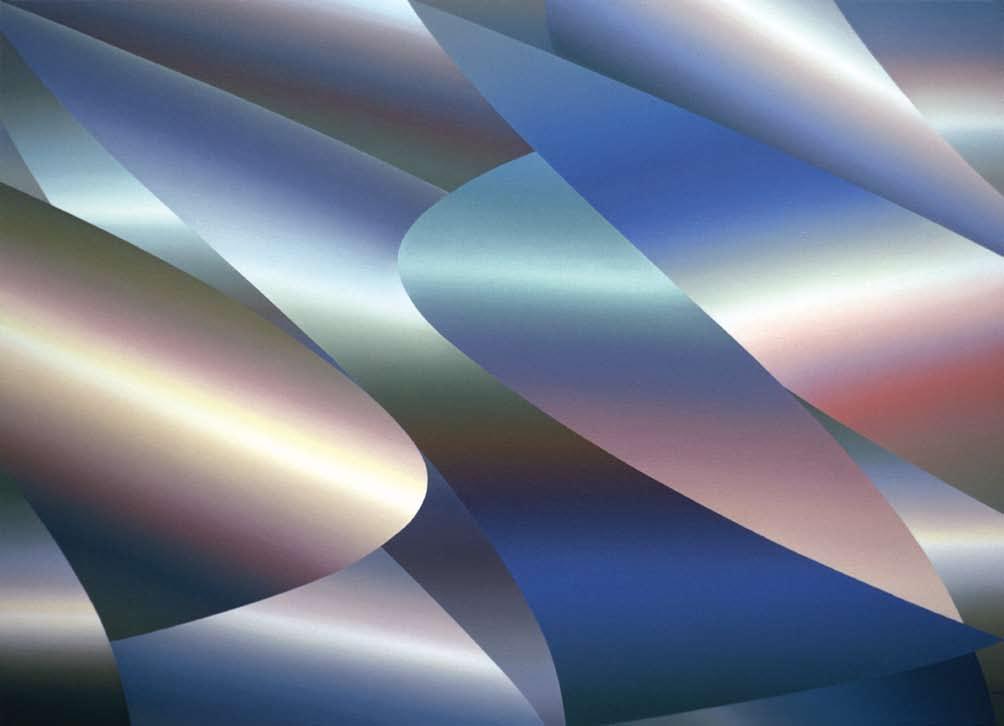
80 81 ءام
ءا �يب راهنأا
Water, 1974. Oil on canvas, 48 x 66’’, 122 x 167.5 cm. Corporate collection.
White Rivers, 1975. Oil on canvas, 30 x 42’’, 76 x 107 cm. Private collection..
راجص�أ Trees, 1974. Oil on canvas, 42 x 48’’, 107 x 122 cm. Coll. National Museum of Women in the Arts, Washington, D.C
ران Fire, 1975.
Oil on canvas, 30 x 42’’, 76 x 107 cm. Private collection.
" نفاه وين " في يمش�رم New Haven Studio, 1975.
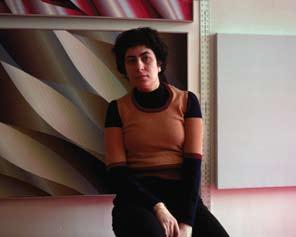
راهنأ Rivers, 1975.
Oil on canvas, 30 x 42’’, 76 x 107 cm. Coll. Palm Springs Desert Museum, California.
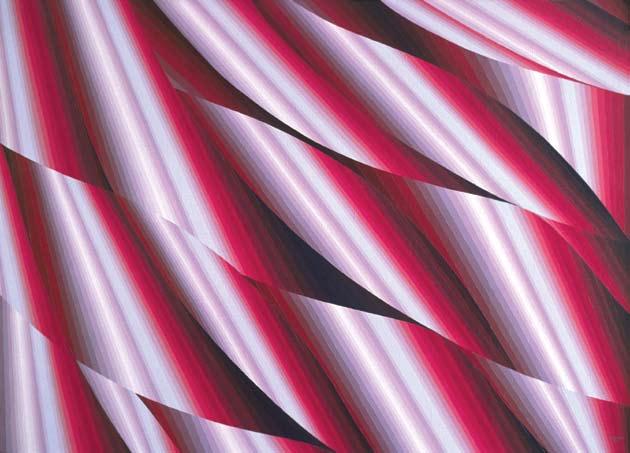
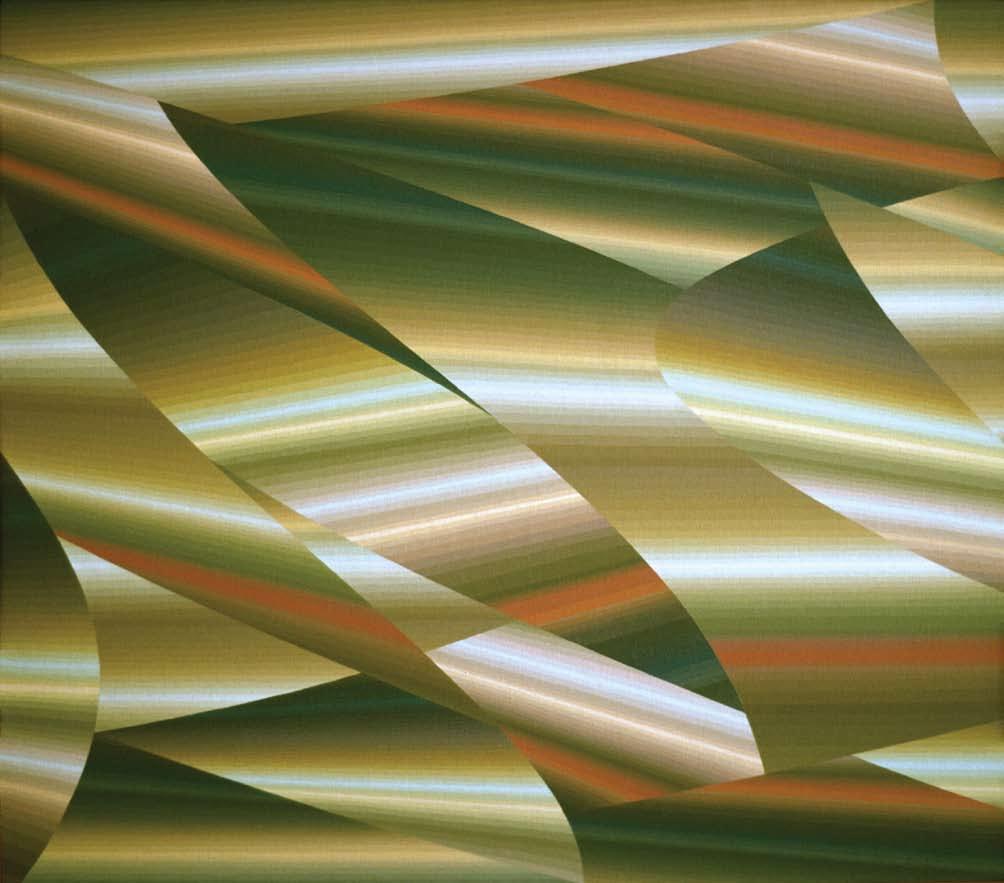

82 83
Diagonal Flight: 1974-1979 Fuite Diagonale: 1974-1979
From the sequences of parallel lines that comprised the shading of her late helix paintings, she began to consider the use of the diagonal, as the angled direction of the horizontal axis could suggest the process of flight. This concept also reminded Halaby of her early experiences in Jaffa and Beirut along the Mediterranean Sea where she felt an overwhelming sense of liberation while standing at the edge of the shore. There, where the sky met the sea in what seemed to be infinite, wide-open space, she was moved by an understanding that it remained free of ownership and constraints, allowing “heart and mind [to] travel with freedom and pleasure.” When she relocated to the Midwest as a teenager, she felt landlocked. Perhaps moved by these memories Halaby began to ask, “Do we have sufficient knowledge yet to understand what our eyes tell us when we look at the boundary, the invisible line, between a curved surface and the distance behind it?” (Samia Halaby, Fine Arts Publishing Beirut, 2006).
In “Ocean” (1974, page 85) we find the artist seeking the answers to these questions with broad areas of color and slight traces of cylinders, which functioned as the edge of a horizon line. Through gradual variations in color and the use of thin sequenced lines, she sought to create the illusion of distant planes. Halaby used such compositions to examine whether shading “based on directional illumination” would reveal something about the three-dimensional characteristics of cylinders if the elliptical ends of these shapes were left out of the painting. If in her late Geometric Still Life series she sought to create depth without the use of perpendicular planes, in the Diagonal paintings she discovered that an abstract space could result by eliminating the most obvious clues to depth that are standard in perspective. Halaby is not concerned with the vanishing points



A partir des hachures qui formaient les ombres de ses derniers tableaux représentant des hélices, elle commence à s'intéresser à l'utilisation de la diagonale, et à comment la direction unilatérale de l'axe horizontal pourrait suggérer le processus de fuite. Ce concept lui rappelle aussi son enfance à Jaffa et à Beyrouth au bord de la mer Méditerranée où elle ressentait un sentiment intime de libération en se tenant debout au bord de l'eau. Là où le ciel rencontre la mer dans ce qui semble être un espace infini et grand ouvert, elle était troublée par la réalisation qu'il reste libre, n'appartient à personne et ne connait pas de contraintes, permettant au "cœur et à l'esprit [de] voyager en toute liberté, avec plaisir". Quand, adolescente, elle s'installe au Midwest, elle se sent comme enclavée. Peut-être parce qu'elle est émue par ces souvenirs, Halaby commence à se poser la question de savoir si "l'on a déjà assez de connaissances pour comprendre ce que nos yeux nous disent lorsqu'on regarde la frontière, la ligne invisible, entre une surface courbe et le lointain derrière elle."(Samia Halaby Fine Arts Publishing, Beyrouth, 2006).
Dans "Ocean (Océan)" (1974), on voit l'artiste cherchant les réponses à ces questions avec de larges aplats de couleur et des traces de cylindres, qui fonctionnent comme le contour d'une ligne d'horizon. Par des variations graduelles de couleur et l'utilisation de fines hachures, elle cherche à créer l'illusion de plans lointains. Halaby utilise de telles compositions pour comprendre si les ombres "se fondant sur l'éclairage directionnel" révèleraient quelque chose vis-à-vis des caractéristiques tridimensionnelles des cylindres si les bouts elliptiques de ces formes restaient hors du champ du tableau. Si vers la fin de sa série de "Natures Mortes Géométriques" elle cherchait à reproduire la profondeur sans l'utilisation de plans perpendiculaires, dans ses tableaux de la série "Diagonales", elle découvre que l'élimination des indices les plus évidents de la profondeur courants en perspective peut aboutir à un espace abstrait.
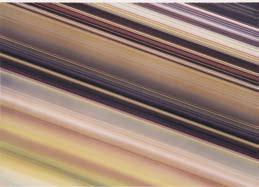
84 85
طيحلما Ocean, 1974. Oil on canvas, 48 x 66’’, 122 x 167.5 cm.
ةعرش� Speed, 1974.
Gouache on paper, 15 x 19 ¼’’, 38 x 49 cm.
ةعرش�لا في ثادحأا Events in Speed, 1974.
Mixed media on paper, 18 ½ x 26 ¾’’, 47 x 68 cm.
طوبه Descent, 1974. Color pencil on paper, 30 x 22’’, 76 x 56 cm.
that form a traditional horizontal line and create a sense of distance, in figurative representations or landscapes and usually end in the background of a composition. Since there is no visible background in her compositions, and no diminishing size to create vanishing points, a sense of infinite space is created.


As such, the artist continued her rejection of perspective, investigating how abstraction could be used to delineate space while imitating the phenomena found in nature. In “Fern” (1976, page 87) she used actual measurements of a large leaf to reveal this process, as the “gradually decreasing distances in the painting and the natural unevenness of the graduation” were taken directly from the spaces that occur between each side of its stem. Confirming her experiments in “Ocean,” while these distances grew smaller as they approached the tip of the leaf, they did not act as a clue to depth.
(Continued page 106)
Halaby ne s'intéresse pas aux points de fuite qui forment traditionnellement une ligne horizontale et créent l'illusion de la distance dans les représentations figuratives de paysages et qui finissent généralement dans l'arrière plan de la composition. Comme il n'y a pas d'arrière plan visible dans ses toiles, et pas de taille décroissante pour créer des points de fuite, une impression d'espace infini s'en dégage, très proche de l'immensité qui semble apparaître de l'autre côté de la mer.
Ainsi l'artiste continue-t-elle de rejeter la perspective, étudiant comment employer l'abstraction pour délimiter l'espace dans le tableau tout en imitant les phénomènes que l'on trouve dans la nature. Dans "Fern [Fougère]" (1976), elle utilise les mesures véritables d'une feuille de grande taille pour révéler ce processus, tandis que les "distances qui s'amenuisent graduellement dans la toile et la nature irrégulière de la graduation" sont directement issues des espaces existant entre chaque nervure. Comme le confirment ses recherches dans "Ocean", les distances décroissent en arrivant en haut de la feuille.
(Suite page 106)
86 87
س�احن
س�خرش� Fern, 1975. Oil on canvas, 66 x 84’’, 167.5 x 213.5 cm. Private collection.
رمحأا
Copper, 1976. Oil on canvas, 30 x 42’’, 76 x 107 cm. Private collection..
One and a Half Red, 1974. Oil on canvas, 66 x 90’’, 167.5 x 228.5 cm. Coll. The Art Museum of the University of Memphis, Tennessee.

"After all the shading that I had done, I began to wonder what would result if I filled the painting with graduations of color and light. The paintings would in essence be like cylindrical surfaces without measure. One could imagine the curve of the earth or the curve of a narrow pipe."
"Après tout le travail sur les ombres que j'avais fait, j'ai commencé à me demander ce qui se passerait si je remplissais le tableau de dégradés de couleur et de lumière. Les toiles deviendraient alors en essence comme des surfaces cylindriques sans mesure précise. On pourrait alors imaginer la courbure de la terre ou la courbe d'un tuyau étroit."

88 89 رمحأا فش�نو دحاو
يدامرو يرهز
.اهل مجح ل ةيناوط �أا حوط �ب ةهيبش� ة �لالخا في تاحوللا نوكتش� .ءو �لاو نوللا نم تاجردتب ةحوللا تألام اذإ مجني يذلا ام لءا �تأ تأ دب ،هتلمع يذلا ليلظتلا لك دعب " " .قي � بوبنأ ىنحنم ا س�رألا ىنحنم ليختي نأا ءرملل نكيم
Pink and Grey, 1976. Crayon on paper, 29 ½ x 41’’, 75 x 104 cm.
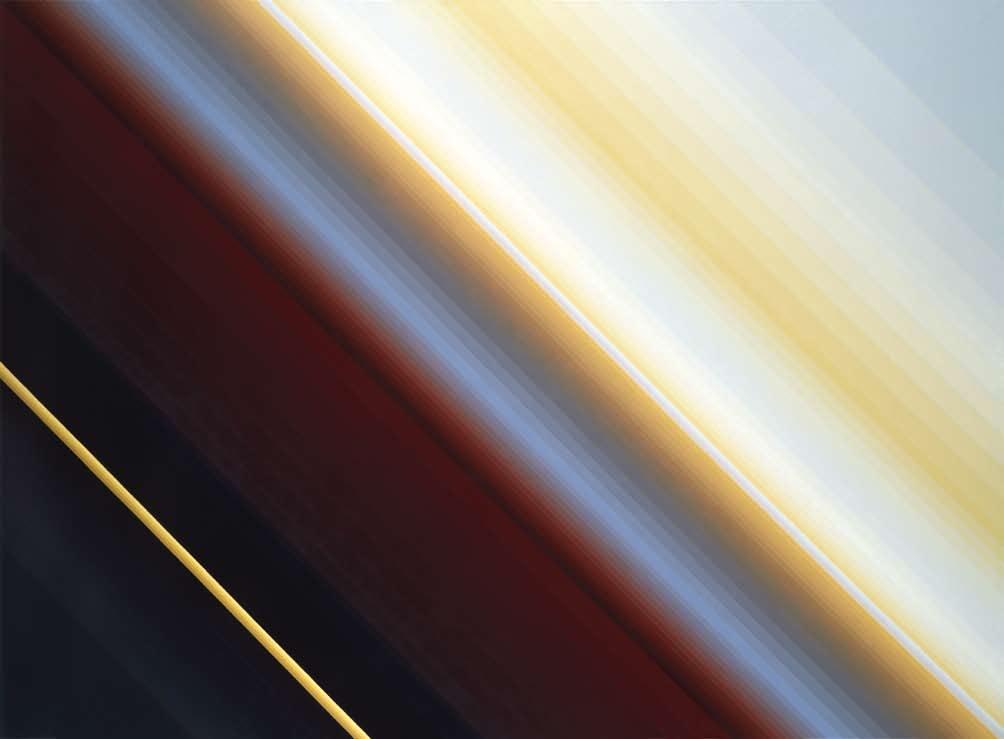
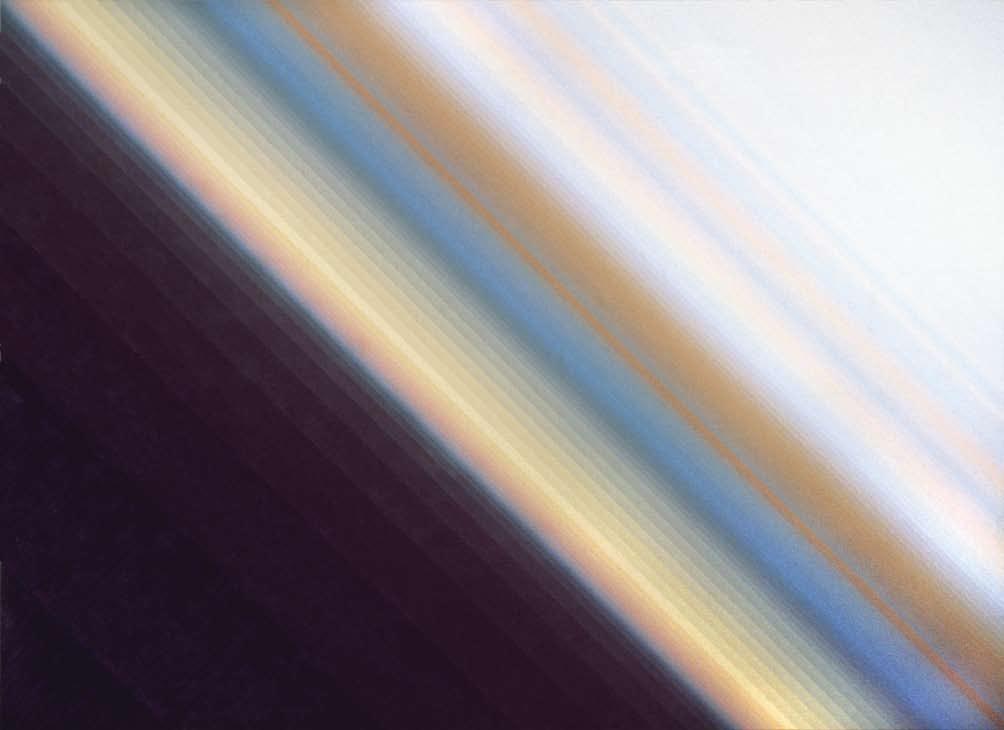
90 91
حابش�لا
لحز Saturn, 1977. Oil on canvas, 66 x 90’’, 167.5 x 228.5 cm. Private collection.
نايرط Mornings Flying, 1976. Oil on canvas, 66 x 90’’, 167.5 x 228.5 cm. Coll. The Solomon R. Guggenheim Museum, New York.
Snow, 1975. Oil canvas, 48 x 66’’, 122 x 167.5 cm.
Mars, 1977. Oil on canvas, 48 x 66’’, 122 x 167.5 cm. Coll. Fort Wayne Museum of Art, Indiana.


"The Diagonal Flight paintings led me to imagine outer space and the relationship of time, distance, and movement. I often used numeric series including the Fibonacci series when deciding the width of the strips."
"Les tableaux de la série Vol Diagonal m'ont conduite à vouloir rendre l'univers et les relations entre temps, distance et mouvement en images. J'ai souvent utilisé des suites numériques dont la suite de Fibonacci pour décider de la largeur des bandes."
92 93 جلث
خيرلما
"يش�تانوبيف " ةيلاتتم كلذ في ابم ةيمقرلا تايلاتتلما تمدختش�ا ام ابلاغو .ةكرلحاو ةفاش�لماو نامزلا ينب ةقلاعلاو يجرالخا ءا �فلا ليخت لىإ يرطقلا نايرطلا تاحول ينتداق " " .طئارش�لا س�رعل يديدتح ىدل
راطقلا ةطمح في قرزأ خف Blue Trap in a Railroad Station, 1977.
"I wanted to help the viewer enter the space of the painting. Hands essentially provides two handles to help swing the imagination into space. The short lines are also like objects that pass by us while speeding in a car or train, brief events in the speed of diagonal space."
"Je souhaitais inciter le public à entrer dans l'espace du tableau. Dans Hands [Mains], deux simples poignées permettent de propulser l'imagination dans l'espace. Les lignes courtes sont aussi comme des objets qui défilent devant nos yeux quand nous sommes lancés à pleine vitesse dans une voiture ou un train, c'est-à-dire comme des événements brefs dans la vitesse de l'espace diagonal."
"This painting reflects my experience of speed while riding the train regularly between New York and New Haven to teach at the Yale School of Art. Two thin blue cylinders, like steel rods, do not extend to the top edge of the painting as all the other strips do. Thus we are able to see them as leaning forward or backward, like a trap door, even though they remain parallel to the rest of the diagonal space."
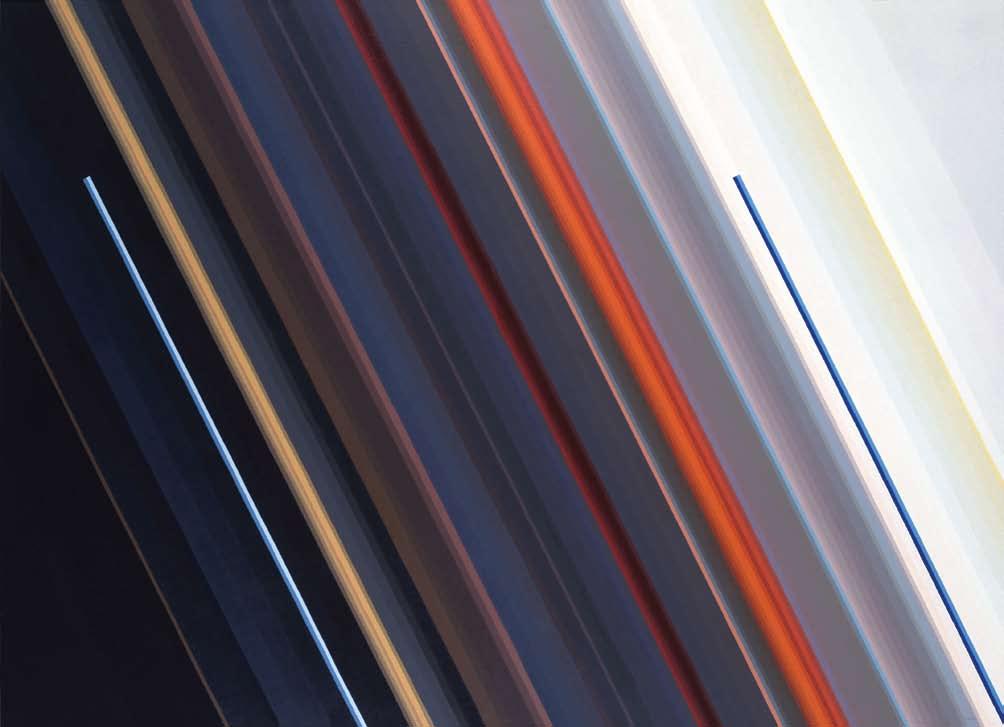
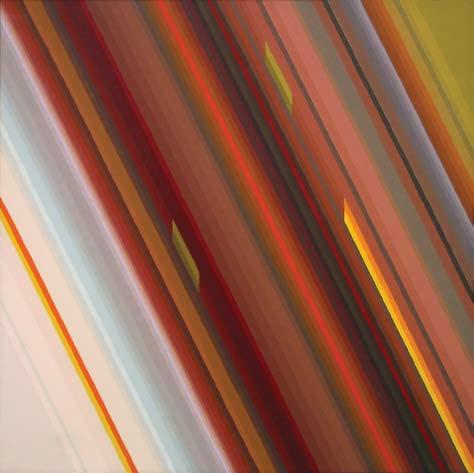
"Cette toile reflète la façon dont je ressentais la vitesse lorsque je prenais le train régulièrement entre New York et New Haven pour enseigner à la Yale School of Art. On y voit deux cylindres, comme des barres d'acier, qui ne montent pas jusqu'au bord supérieur de la toile comme le font les autres bandes. Ainsi nous les percevons comme penchés vers l'avant ou l'arrière, comme une trappe, même si en fait ils restent parallèles au reste de l'espace diagonal."
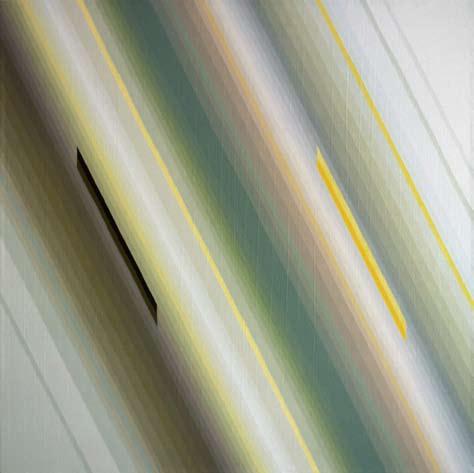
94 95 يديأ
كرويوين لىإا راطقلا في ةلحر
لاقتنا ىلع ادعا �يل ين �بقم ا �اش�أ مدقت "يديأ " ةحول .ةحوللا ءا �ف في لوخدلا ىلع دهاش�لما دعاش�أ نأا تدرأ " في ةزيجو ثادحأ ،راطق وأ ةراي � في ينعر �م نحنو انب رتم رش�انع ش�يأا هبش�ت ةير �قلا طوطلخا .ءا �فلل لايلخا " .يرطقلا ءا �فلا ةعرش�
Hands, 1978. Oil on canvas, 24 x 24’’, 61 x 61 cm..
A
Train
Ride to New York City, 1978. Oil on canvas, 24 x 24’’, 61 x 61 cm.
Oil on canvas, 48 x 66’’, 122 x 167.5 cm. Private collection. نادتتم ل ،ذلوف نم ناب �ق لثم ،ناتعيفر ناتواقرز ناتناوط �أ .نونفلل لاي ةيلك في س�ردأل نفاهوينو كرويوين ينب ايموي راطقلا يبوكر للاخ نم ةعر �لا في يتبرتج س�كعت ةحوللا هذه " " .يرطقلا ءاش�فلا ةيقبل ناتيزاوم نايقبت كلذ عمو ،ةديش�م باب لثم ،فللخا وأ مامألا لىإ نلايامتي امهتيؤور عيطتش�ن كلذل .ىرخألا طئارش�لا لك فلاخ ىلع ةحوللا ةفاح ةياهن لىإا


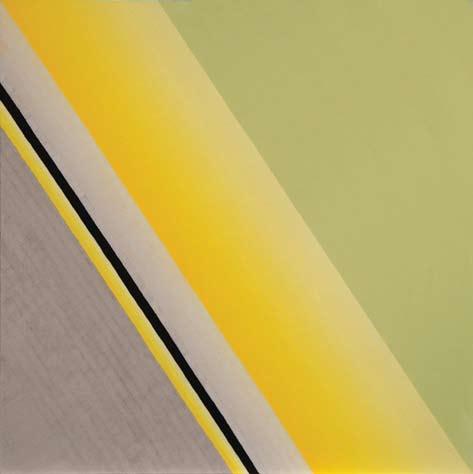
96 97 يبرغلما للد لىإا ،برلحا ءا �ن War Women,
1978. Oil
72
72’’, 183
لجؤوم تقو Time Delay, 1977.
" يغنإا " Inge, 1975.
➤
for Dalal Mughrabi.
on canvas,
x
x 183 cm. Private collection.
Oil on canvas, 9 ½ x 10’’, 24 x 25.5 cm. Private collection.
Oil on masonite, 19 x 19’’, 48 x 48 cm.
"A sharp thin black line is bracketed by two sharp thin lines of yellow. The tiger's eye is black on yellow. In late winter, nothing is green, and prey is scarce. The tiger is hungry and his eyes are sharp hunters."
"Une ligne noire, fine et nette est bordée de deux lignes jaunes fines et nettes. L'œil du tigre est noir sur jaune. Vers la fin de l'hiver, il n'y a plus de verdure, et les proies sont rares. Le tigre a faim et ses yeux sont de féroces chasseurs."
"Yesterday is a transitional painting where instead of painting the color stripes with brush marks that are perpendicular to the stripe, I used a little squeegee to spread the oil paint in the direction of the stripe. This method introduced possibilities of painting wet into wet and thus new variations in the rendering of space."
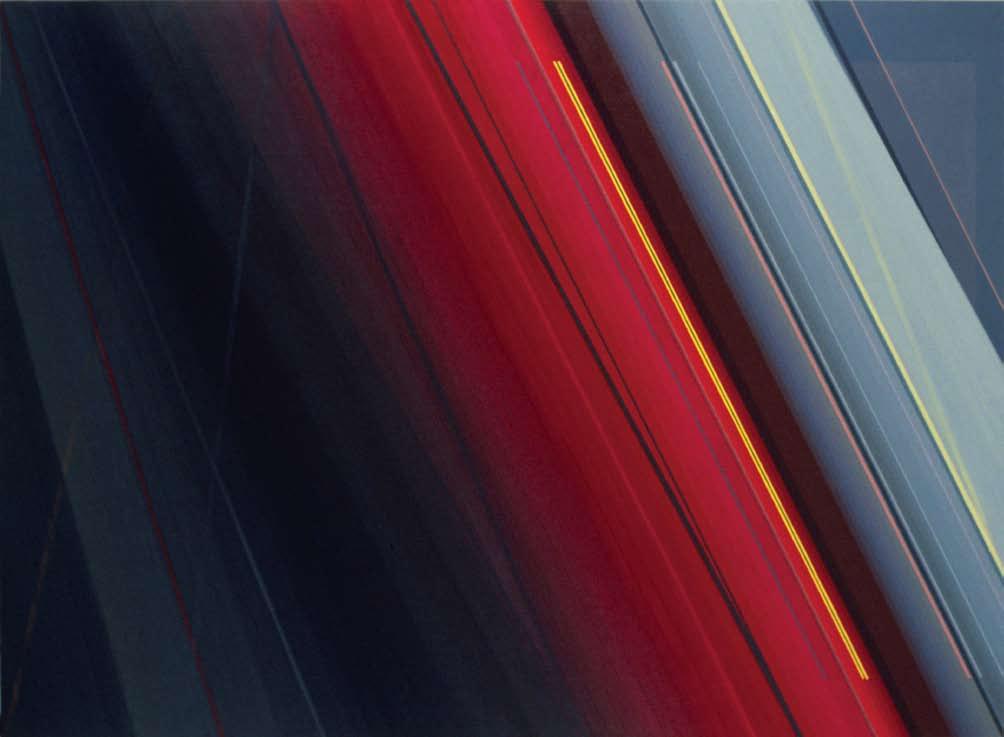
"Yesterday [Hier] est une œuvre de transition où au lieu de peindre des bandes de couleur avec des traits de pinceau perpendiculaires aux bandes, j'utilisais une petite raclette de caoutchouc pour étaler la peinture à l'huile en suivant la direction de la bande. Cette méthode a introduit la possibilité de fondre les pigments l'un dans l'autre ce qui m'a ouvert de nouvelles perspectives dans ma manière de représenter l'espace."
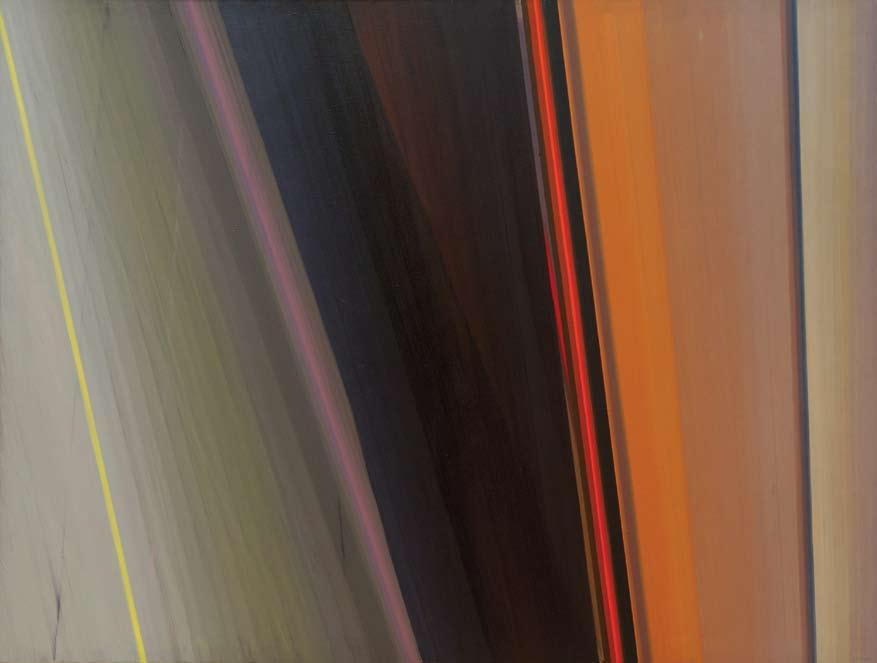
98 99 يش�الما مويلا Yesterday, 1978. Oil on canvas, 46 x 66 inches, 117 x 167.5 cm. Private collection. .طيرش�لا هاتجاب يتيزلا نوللا رش�نل ةيرغ � ةح �مم تمدختش�ا ،طيرش�لا ىلع ةيدومع ةاش�رف تابر �ب نوللا طئارش� مش�ر نم لدبف ،ةيلاقتنا ةحول يه "ي �الما مويلا " ةحول " " .ناكلما ليكش�ت في ةديدج تاعيونت لياتلابو بطرلا ىلع بطرلا نيولت تاناكمإ ةقيرطلا هذه تمدق دقو
ءاتش�لا رخاوأا رمنلا ينع Tiger’s Eye in Late Winter, 1978. Oil on canvas, 66 x 90’’, 167.5 x 228.5 cm. Private collection. .ةردان س�ئارفلاو ،ر �خأا ءيش� ل ءاتش�لا رخاوأ في .رف �أ ىلع ءادو � رمنلا ينع .ناداح نارفش�أ ناعيفر ناطخ هب طيحي داح عيفر دوش�أ طخ " " .ناظقي نادايش� هانيعو عئاج رمنلا


100 101 ر �خأا غارف في طوطخ عبرأا
رش�خأا غارف في طوطخ ثلاث
Four Line Green, 1978. Oil on canvas, 48 x 66’’, 122 x 167.5 cm. Private collection.
Three Line Green, 1978. Pastel on paper, 30 x 40’’, 76 x 101.5 cm.
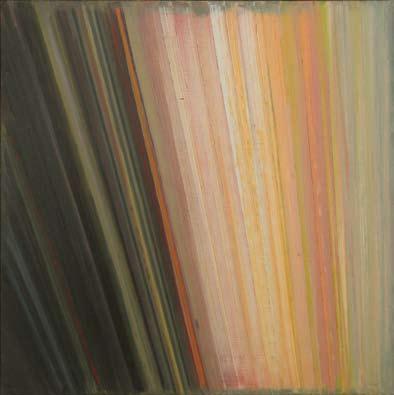
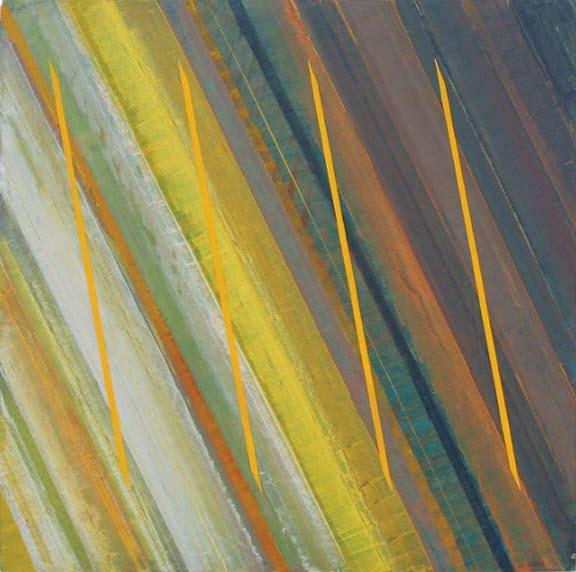




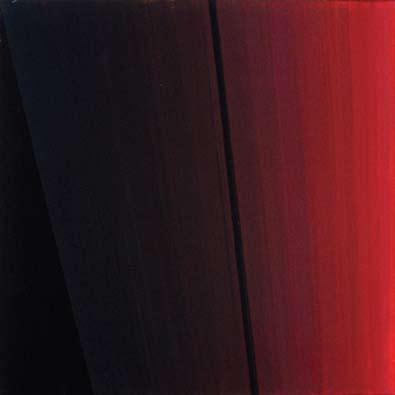
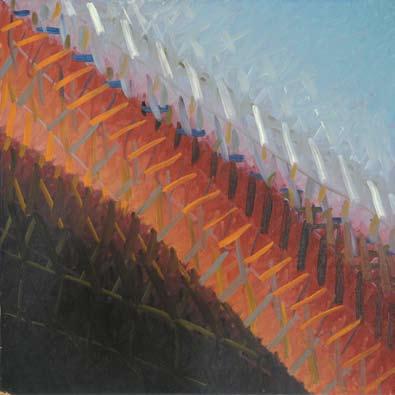
102 103 ءارف � طوطخ عبرأ Four Line Yellow, 1978. Oil on
24
24’’, 61
61 cm. " كرويوين " New York, 1978. Oil on
24
24’’, 61 x 61 cm. ءاوتلا Warp, 1977. Oil
9 ½
10’’, 24
25.5 cm. ةنكادلا Dark One, 1978. Oil on canvas, 24 x 24’’, 61 x 61 cm. Private collection. افاي Yafa, 1978. Oil on
24
24’’, 61 x 61 cm. اينيدراغ Gardenia, 1978. Oil on canvas, 24 x 24’’, 61 x 61 cm. Private collection. قلزني Slides, 1977.
19’’,
48.5
رمحأا Red, 1978.Oil
24
24’’, 61
61
Private collection.
masonite,
x
x
canvas,
x
on masonite,
x
x
canvas,
x
Oil on masonite, 19 x
48.5 x
cm.
on masonite,
x
x
cm.
➤
ةذفانلا نم رون Window Light, 1977. Crayon on paper, 30 x 40’’, 76 x 101.5 cm.
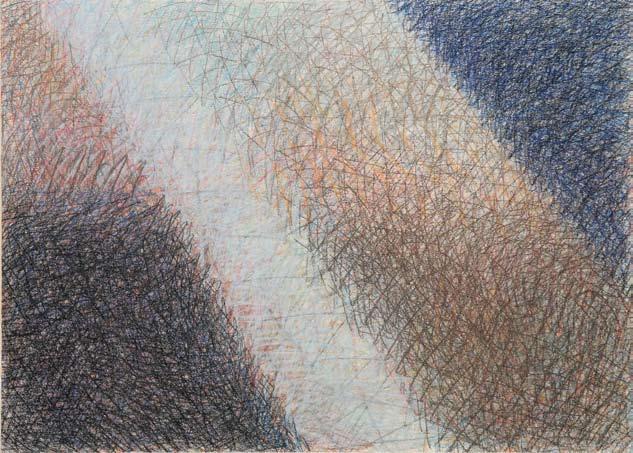
Orange, 1977. Pastel on paper, 29 ½ x 41’’, 75 x 104 cm.
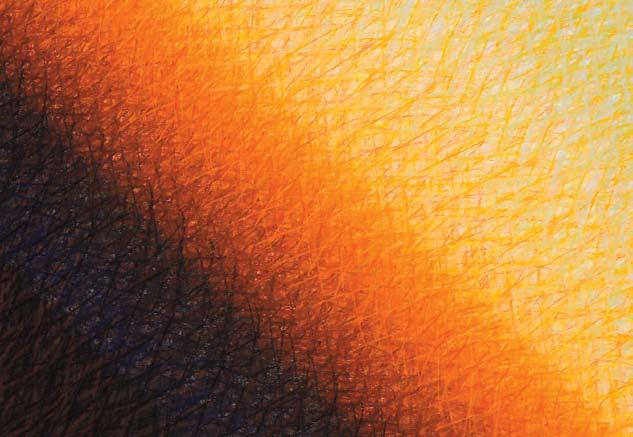
س�ملم Light Texture, 1979. Oil on canvas, 48 x 48’’, 122 x 122 cm. Private collection.
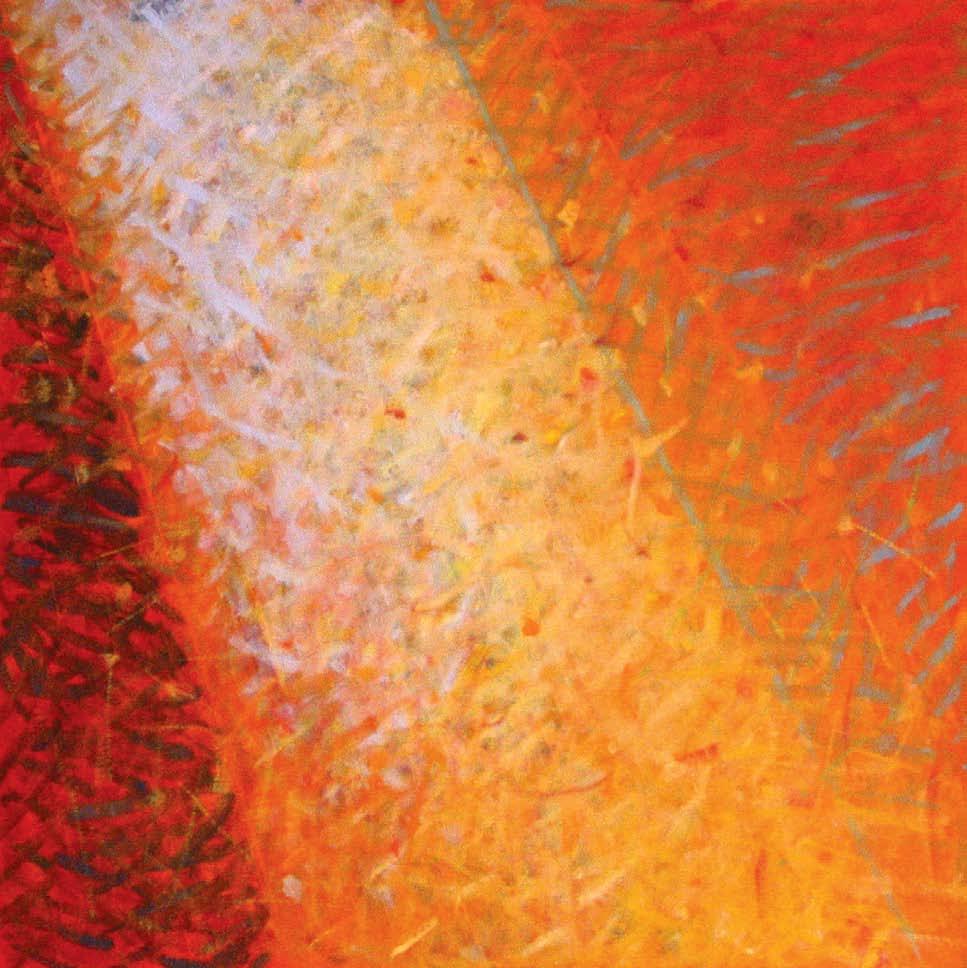
يه ةل
"Sometimes the last painting in a series is an expression of my increasing boredom as well as the promise of things not yet understood. Sometimes I regret destroying these transitional paintings. My brother rescued this one."
"Parfois le dernier tableau d'une série exprime ma lassitude montante ainsi que la promesse de choses qui ne sont pas encore comprises. Parfois je regrette d'avoir détruit ces œuvres de transition. C'est mon frère qui a sauvé celle-ci."
104 105 لياقترب
يئوش�
مدنأا
دعو
ةفا �إ ديازتلما ".ةحوللا هذه ذقنأا يخأ .ةيلاقتنل تاحوللا هذه فلاتإ ىلع
يرج � نع يربعت
�لش�لا في ةيرخألا ةحوللا نوكت انايحأ "
انايحأ .دعب اهمهفأا لم ءايش�أا
لىإ
Dome of the Rock: 1980-1982 Dôme du Rocher: 1980-1982
As with a handful of previous bodies of work, Halaby completed the Diagonal Flight series in 1979 feeling as though it marked the end of a particular direction. Yet this time, instead of taking up new experiments, she stopped painting entirely. Eventually she reemerged and entered a prolific period of production that was met with an equal dose of elimination, as she destroyed everything she created. Then in 1980 when the artist began to gain confidence that she was embarking on the proper course, she revisited the discoveries that she had made when first seeing the Dome of the Rock in Jerusalem in 1966.
Influenced by the geometric abstractions that I saw in the Dome of the Rock in Al-Quds, I allowed the rectangle of the painting to create shapes, which I then filled with shaded cylinders from the diagonal paintings or with texture imitating inlaid Arabic art (Samia Halaby exhibition catalog, Ayyam Gallery 2008).

Halaby also picked up where her Diagonal Flight series had left off, as she incorporated a central cylindrical axis that ran from the upper left-hand corner of the canvas to the lower right-hand corner, placing it over other geometric forms. In “Cashmere Desert” (1980, page 107), a cylinder of parallel lines appears as though it has been taken right out of one of her Diagonal paintings. Yet in place of gradual shading, the artist has added a thick black line that distinguishes space between another horizontal that is divided into rust and blue sections. These sections are subtly textured with color and markings, an element that is radically different from her previous works that utilized flush areas that are composed of virtually invisible brushstrokes. Running in the opposite direction of the diagonals are larger squares that end beyond the picture plane and are painted with different degrees of texture. In some instances scattered lines are used while in others layers of paint seem to be finished with scumbled color.
In the beginning this use of textures fell within the boundaries of shapes as though following the
Comme c'était le cas pour plusieurs de ses séries précédentes, Halaby termine la série "Fuite Diagonale" en 1979 avec le sentiment qu'elle marque la fin d'une direction particulière. Pourtant cette fois-ci, au lieu de faire de nouvelles expériences, elle s'arrête complètement de peindre. Finalement, elle ré-émerge et entre dans une période de production prolifique qu'égale une dose équivalente de destruction car elle élimine tout ce qu'elle a créé. Puis en 1980, quand elle se sent sûre de s'être embarquée dans la bonne direction, elle reprend les découvertes qu'elle avait faites lorsqu'elle avait visité pour la première fois le Dôme du Rocher à Jérusalem en 1966.
Influencée par les abstractions géométriques que j'avais vues dans le Dôme du Rocher à Al-Qouds, j'ai permis au rectangle du tableau de créer des formes, que j'ai ensuite emplies des cylindres ombrés de mes tableaux diagonaux ou d'une texture imitant l'art arabe de l'incrustation. (Samia Halaby Catalogue de l'Exposition, Galerie Ayyam, 2008).
Halaby reprend là où s'était arrêtée sa série "Fuite Diagonale", en incorporant un axe central cylindrique qui allait du coin supérieur gauche de la toile jusqu'au coin inférieur droit, le plaçant par-dessus d'autres formes géométriques. Dans "Cashmere Desert [Désert du Cachemire]" (1980), un cylindre fait de hachures semble directement issu de l'une des ses toiles "Diagonales". Pourtant, au lieu de hachures progressives, l'artiste emploie une épaisse ligne noire qui marque l'espace entre une autre zone horizontale divisée en sections rouille et bleues. Ces sections sont subtilement texturées avec de la couleur et des traits de pinceau, un élément qui diffère radicalement de ses œuvres précédentes qui utilisaient des zones franches de couleur et des coups de pinceau pratiquement invisibles. Allant dans la direction opposée des diagonales se trouvent des carrés plus volumineux qui finissent au-delà de l'espace du tableau et sont peints en utilisant plusieurs degrés de texture. Dans certains cas, des lignes éparses sont utilisées alors que dans d'autres des couches de peinture semblent être polies d'un glacis coloré.
Au début, cette utilisation de la texture fait partie intégrante des formes, comme si elle suivait la précision de panneaux incrustés. Plus tard, cependant,
precision of inlaid tiles. In due course, however, Halaby found something quite attractive about the possibilities of this new facet of her painting style, which brought additional elements of energy and movement to the canvas. “Eventually, texture began to charm,” explains the artist. “I began to think that the edges of things should betray what they are made of. So I began to allow textural marks to scatter over the entire painting in disregard of edge” (Samia Halaby exhibition catalog, Ayyam Gallery 2008). This would prove to be an immense breakthrough for the artist, one that would alter her art forever.
The series would also evolve with a vastly different application of color than before. Gone was the gradual shading of her compositions, in which sharp lines were crucial and color variation seemed to occur as though visible wavelengths of light. Large geometric forms would still appear, but would soon be overcome by explosions of color and texture.
(Continued page 128)
Halaby trouve quelque chose de plutôt attirant dans les possibilités de cette nouvelle facette de son style pictural, qui amène un élément supplémentaire d'énergie et de mouvement à la toile. "En fin de compte, la texture commença à me charmer", explique l'artiste. "Je commençais à croire que les contours des choses devraient trahir de quoi elles sont faites. Donc je commençais à accepter d'utiliser des marques texturées à disperser sur tout le tableau en ne m'occupant pas des contours" (Samia Halaby Catalogue de l'Exposition, Galerie Ayyam 2008). C'est une découverte capitale pour l'artiste, une découverte qui changera sa démarche artistique pour toujours.
Cette série évolue aussi parce qu'elle y applique la couleur de façon totalement différente de ce qu'elle faisait auparavant. On n'y trouve plus les ombres graduelles de ses toiles dans lesquelles les hachures précises étaient cruciales et les variations de couleur semblaient comme filtrées à travers des ondes de lumière visibles. De grandes formes géométriques apparaissent encore, mais elles sont bientôt submergées par des explosions de couleur et de texture.
(Suite page 128)
106 107
ةييرمش�ك ءارحش�
122
Cashmere Desert, 1980. Oil on canvas, 36 x 48’’, 91.5 x
cm.
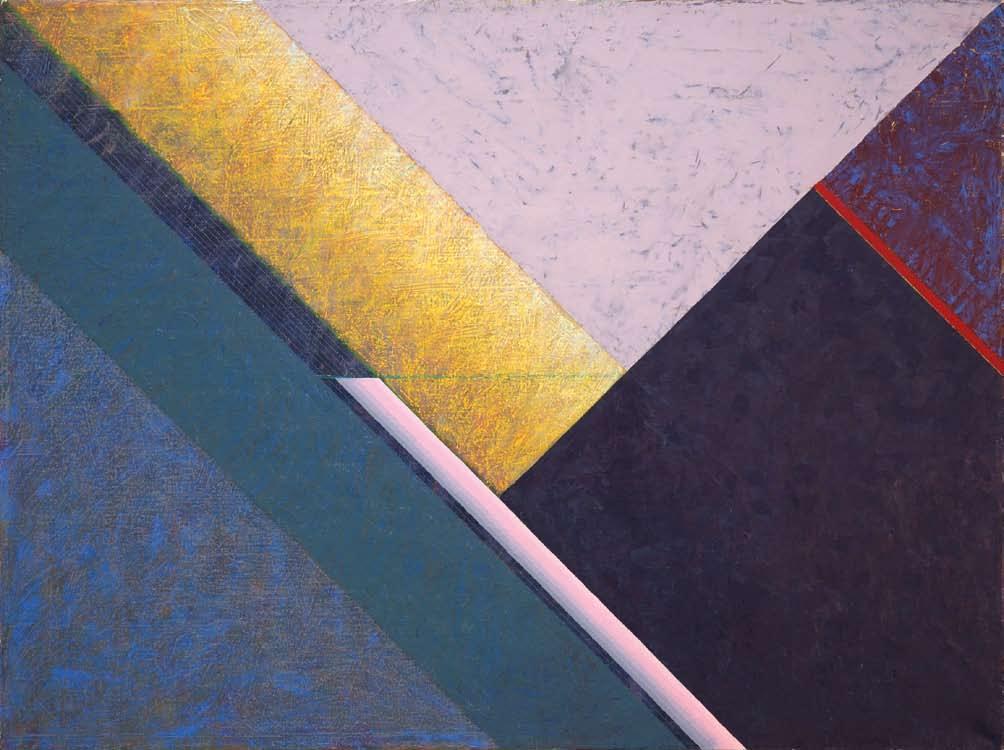

108 109 ءاقرز ةبوط
Blue Brick, 1980. Oil on canvas, 36 x 48’’, 91.5 x 122 cm.
ماخر Marble, 1980. Oil on canvas, 36 x 48’’, 91.5 x 122 cm.
Position Delay: Dark, 1980.
Oil on canvas, 36 x 36’’, 91.5 x 91.5 cm. Private collection.
Position Delay: Green, 1980. Oil on canvas, 36 x 36’’, 91.5 x 91.5 cm. Private collection.
One or Two Pink, 1980. Oil on canvas, 48 x 66’’, 122 x 167.5 cm.

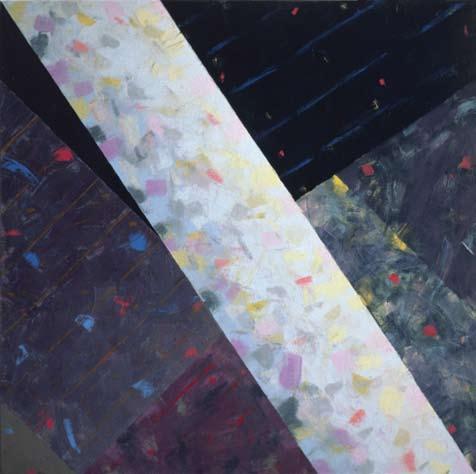
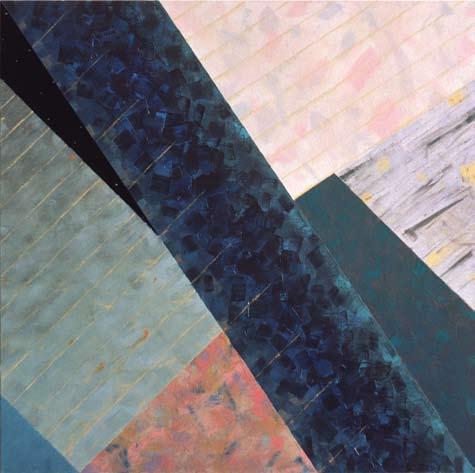
110 111 تماق : لجؤوم عش�و
تايرهز ،ناتنثا وأا ةدحاو
ر �خأا
لجؤوم
:
عش�و
"I had visited the Dome of the Rock as well as the Umayyad Mosque of Damascus several times. The influence of the inlaid marble that I admired so much entered my work during the creative impasse of 1979. I began to divide the painting into sections derived from its rectangular shape. I used a 45 degree diagonal and two squares as basic elements and I textured the shapes to distinguish them from each other in imitation of the marble inlays. Time Trap reveals the transition in its resemblance to the painting Light Texture."

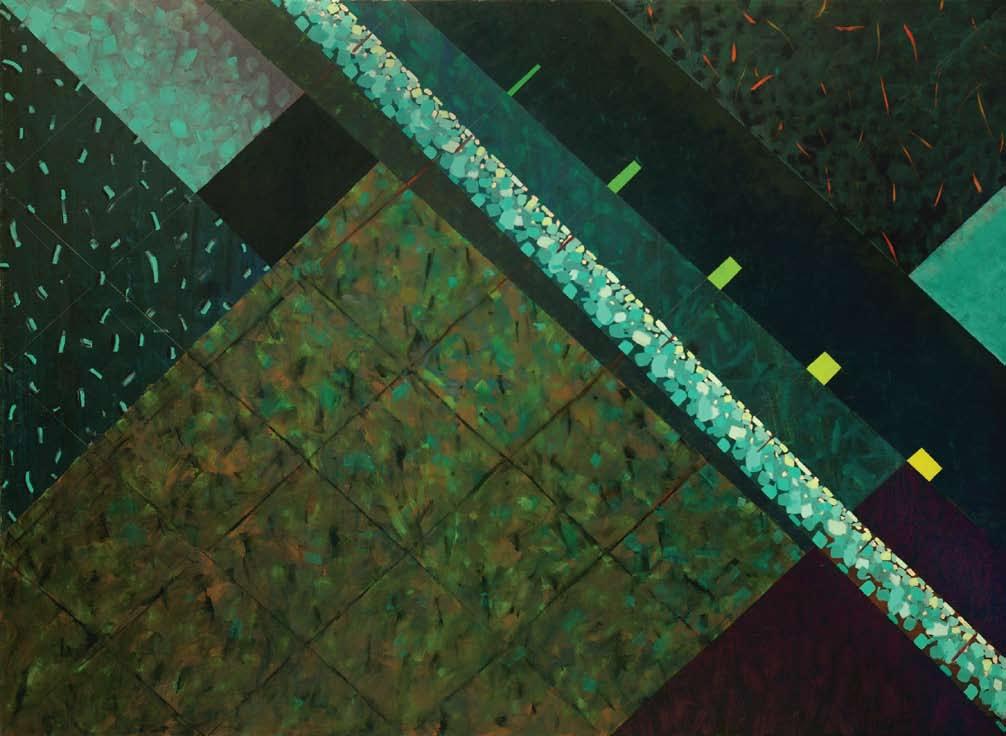
"J'avais visité le Dôme du Rocher ainsi que la Grande Mosquée des Omeyyades de Damas plusieurs fois. L'influence des revêtements de marbre que j'admirais tant a fait son chemin dans mon œuvre pendant l'impasse créatrice de 1979. J'ai commencé à diviser le tableau en sections dérivées de sa forme rectangulaire. J'ai utilisé une diagonale à 45° et deux carrés comme éléments de base et j'ai donné de la texture aux formes pour les distinguer les unes des autres, en imitation des incrustations de marbre. Time Trap [Piège à Temps] révèle cette phase de transition de par sa ressemblance à la toile Light Texture [Texture de la Lumière]."
"Here I used colors that reflect how we see at low levels of light. Green always seems stronger in evening light which resembles the light of city trees and streets at night."
"Ici, j'ai utilisé des couleurs qui reproduisent la façon dont on voit dans des conditions de basse luminosité. Le vert semble toujours plus intense dans la lumière du soir qui ressemble à la lumière des arbres de la ville et des rues la nuit."
112 113 تقولا خف Time Trap, 1980. Oil on canvas, 36 x 48’’, 91.5 x 122 cm. يليل رظن Night Seeing, 1980. Oil on canvas, 66 x 90’’, 168 x 229 cm. اهلكش� نم ةقتش�م ءازجأا لىإ ةحوللا م �قأا تأ دب .1979 في يعادبإلا قزأ لما للاخ ليامعأا في لخد يباجعإا راثأا يذلا عش�رلما ماخرلا يرثأا نإ .تارم ةدع قش�مد في يومألا عمالجاو ةرخ �لا ةبق ةرايزب تمق " " " يئو � س�ملم " ةحول عم اههباش�ت في لاقتنل اذه "تقولا خف " ةحول فش�كتو .ماخرلا في عي �ترلا كلذب ةدلقم س�عبلا اهش�عب نع اهزيمأل لاكش�ألا تنولو ةيش�اش�أ رش�انعك ينعبرمو 45 ةجردلا رطق تمدخت �ا .ليطت �لما
".ليللا في ةنيدلما عراوش�و راجش�أ ءوش� هبش�ي يذلا ءا �لما ءوش� في ىوقأ امئاد ودبي ر �خألا .ةتفالخا ةءاش�إلا في ىرن فيك س�كعت يتلا ناولألا تمدختش�ا انه "
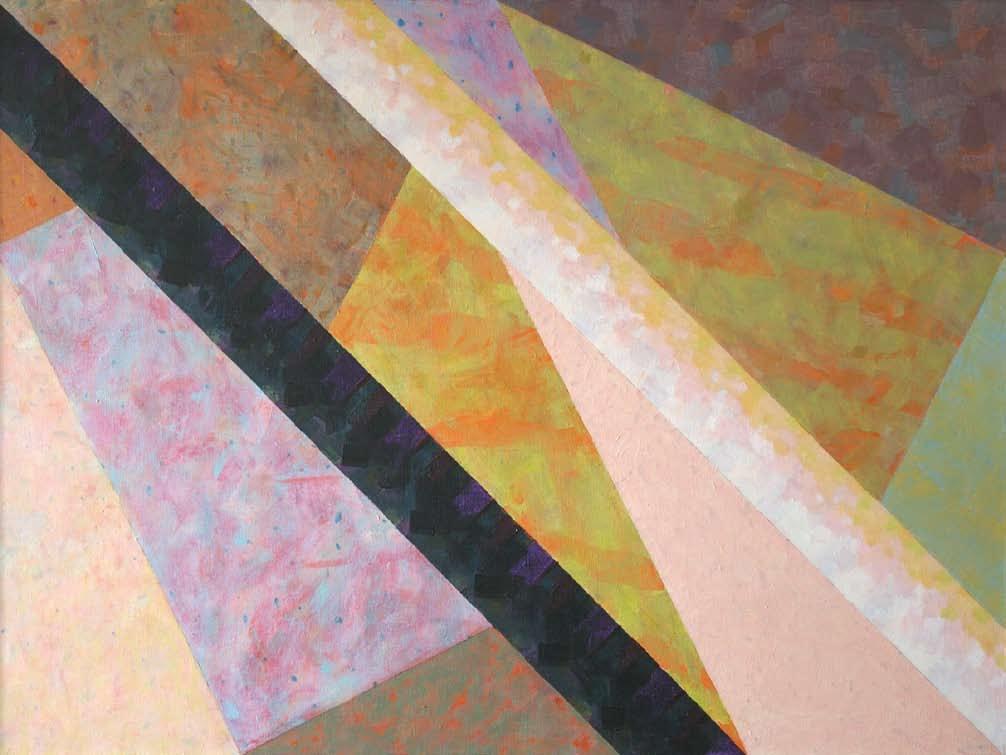

114 115 ليل : بعلاتم عش�و
رون : بعلاتم عش�و
Position Interplay: Night, 1980. Oil on canvas, 36 x 48’’, 91.5 x 122 cm. Coll. Jordan National Gallery of Fine Arts.
Position Interplay: Light, 1980. Oil on canvas, 36 x 48’’, 91.5 x 122 cm. Private collection.
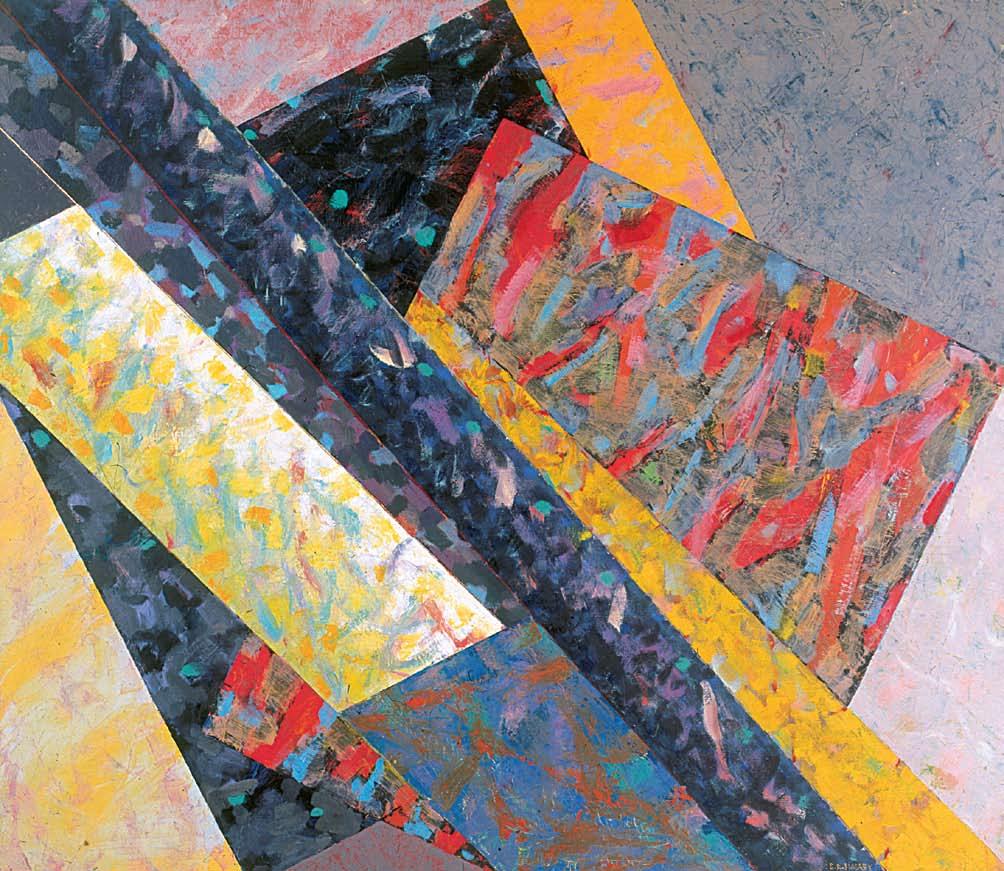
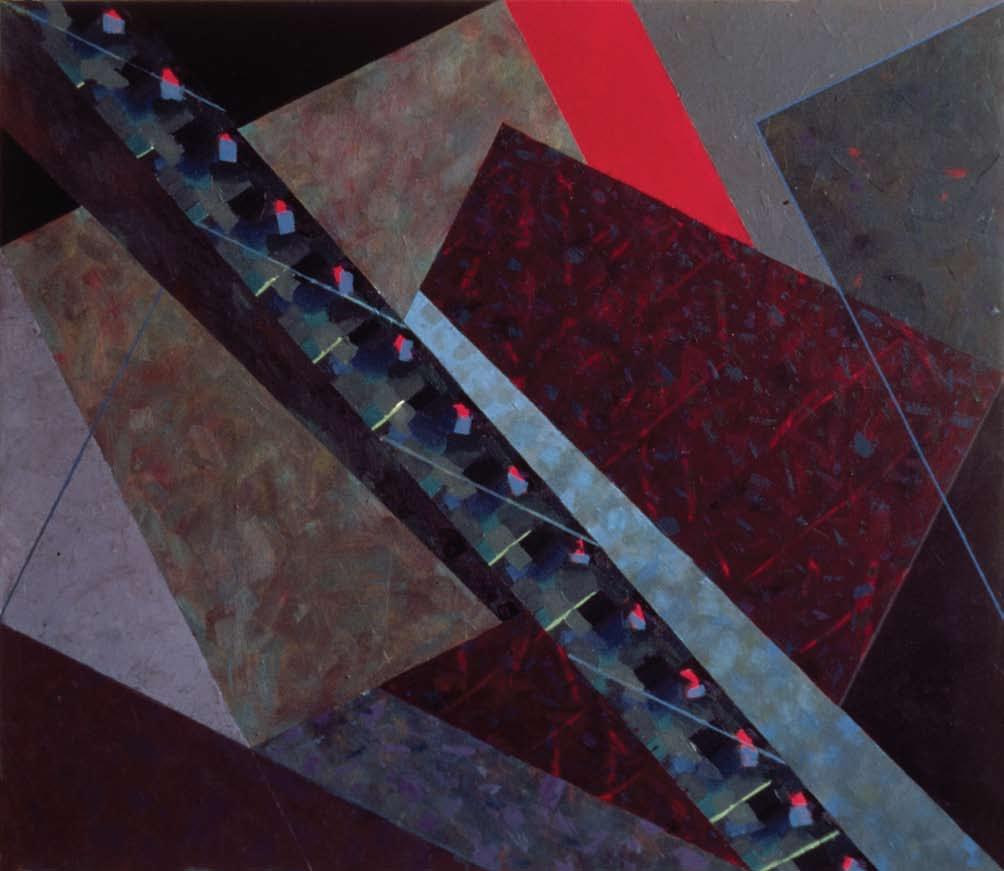
116 117 "كش�يبارأ " لدابتم عش�و Position Exchange:
1981. Oil
48
48’’, 122 x 122 cm. Coll.
Arab
New York. ةمتعلا في رمحأا Red in
1982. Oil
48
48’’, 122
122
Arabesque,
on canvas,
x
The
Bank,
Darkness,
on canvas,
x
x
cm. Coll. The Arab Bank, New York.
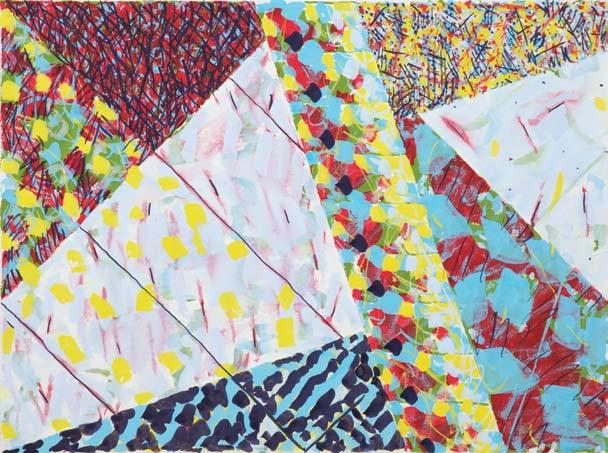
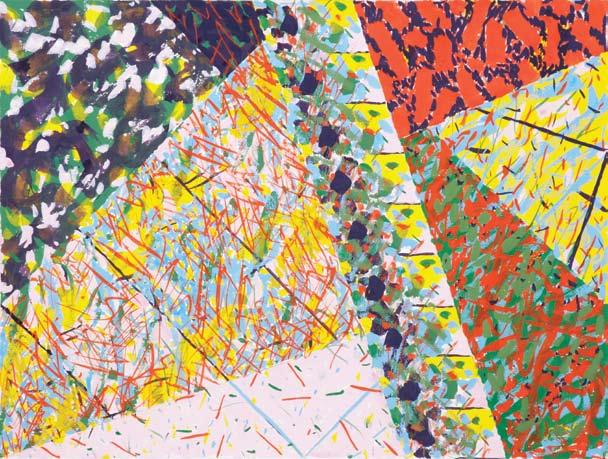




118 119 س�اقلما غارفلا Measured Space, 1981.
س�مللما ب �انت Relativity of Texture, 1981.
22
56
76 cm. ةيلحش� Lizard, 1981. Wax on paper, 22 ¼ x 30’’, 56.5 x 76 cm. رفش�أا و رش�خأ Green and Yellow, 1981. Wax on paper, 22 x 28 ½’’, 56 x 72.5 cm. رش�خأا رفش�أ Yellow Green, 1980. Wax on paper, 22 x 30’’, 56 x 76 cm. عبرم فرط Square End, 1980. Wax on paper, 22 x 30 ½’’, 56 x 77.5 cm.
Gouache on paper, 22 x 30’’, 56 x 76 cm.
Gouache on paper,
x 30’’,
x
Oil on canvas, 48 x
122 x 107 cm. Private collection.

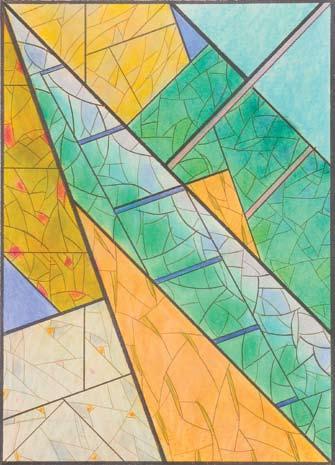
"The sweep of the yellow gave me a sense of joy like a sail filled with a good wind."
"Le mouvement ample du jaune m'emplissait de joie, comme une voile gonflée par un vent favorable."

120 121 1 قش�عم جاجز
2 قش�عم جاجز
راحبإ Sailing,
هيلع تبه عارش� لثم حرلماب اروعش� ينتطعأا رف �ألا ةح �م نإ " " .ةيتاوم حاير
Stained Glass Window I 1980. Crayon on paper, 26 ¾ x 18 ½’’, 68 x 47 cm.
Stained Glass Window II, 1980. Crayon on paper, 30 x 22 ¼’’, 76 x 56.5 cm.
1981.
42’’,
➤
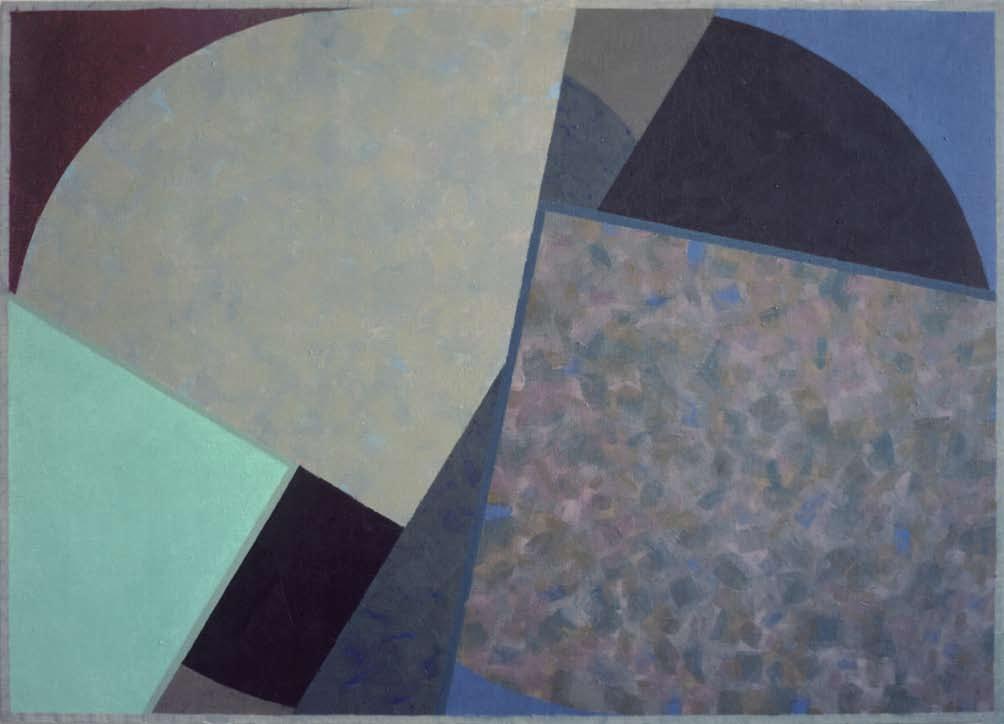
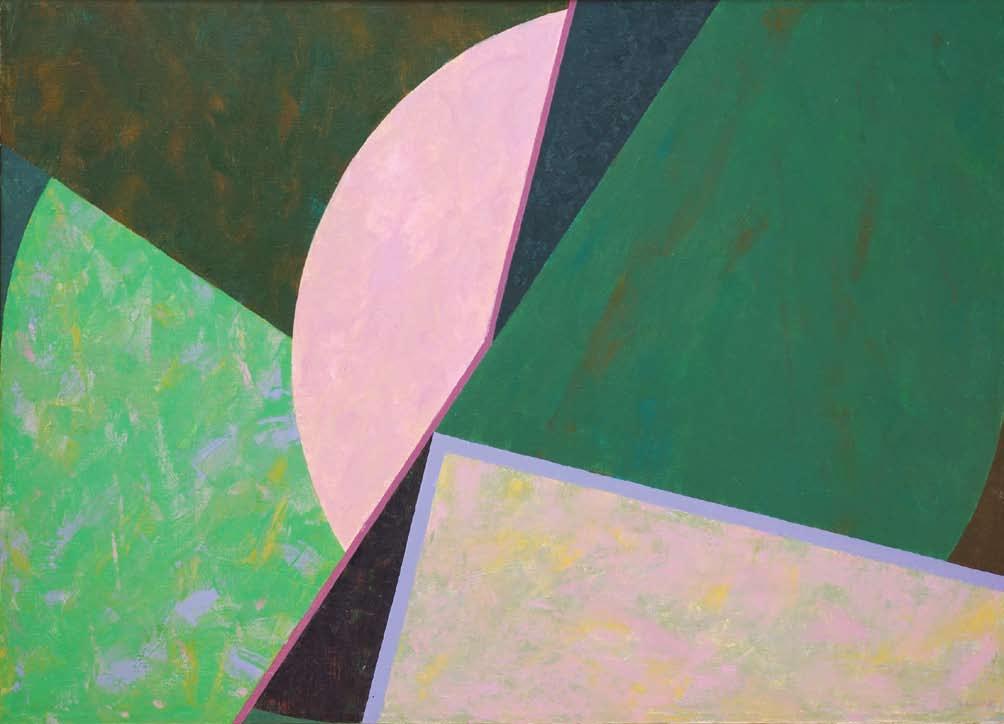
122 123 س�قاترت فيش�لا ةقبنز Lillie of the Summer Dancing, 1981. Oil on canvas, 35
49’’, 89 x 124.5 cm. ةنيدلما تاعبرم لىإ ةعير �لا تاقرطلا نم Clover Leaves to City Blocks, 1981. Oil on canvas, 35 x 49’’, 89 x 124.5 cm.
x
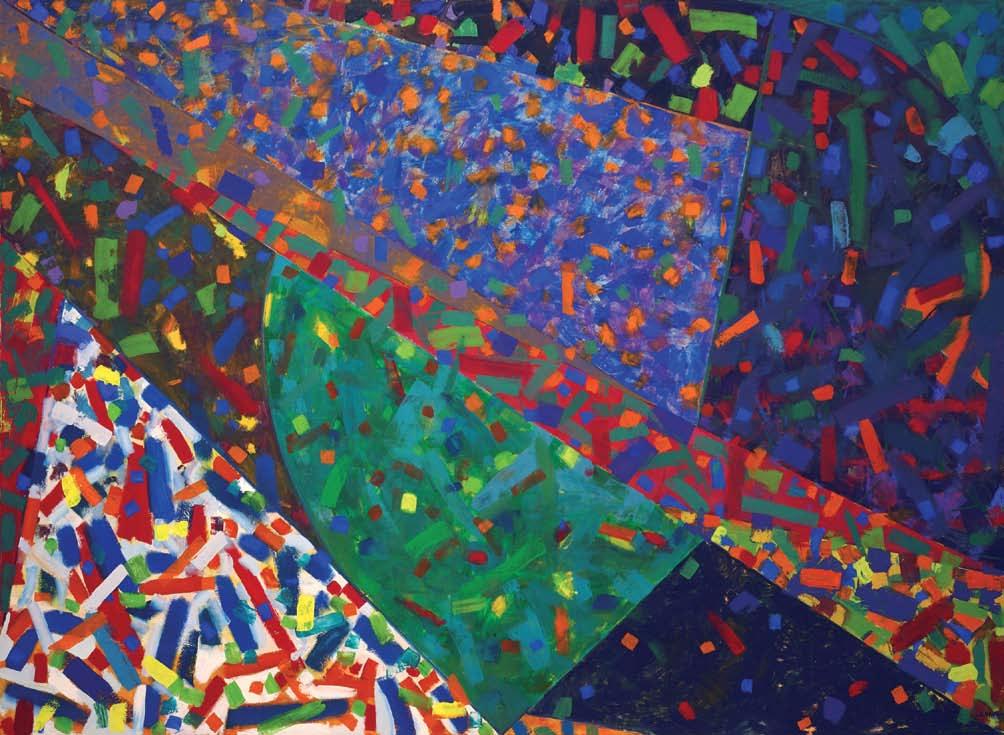
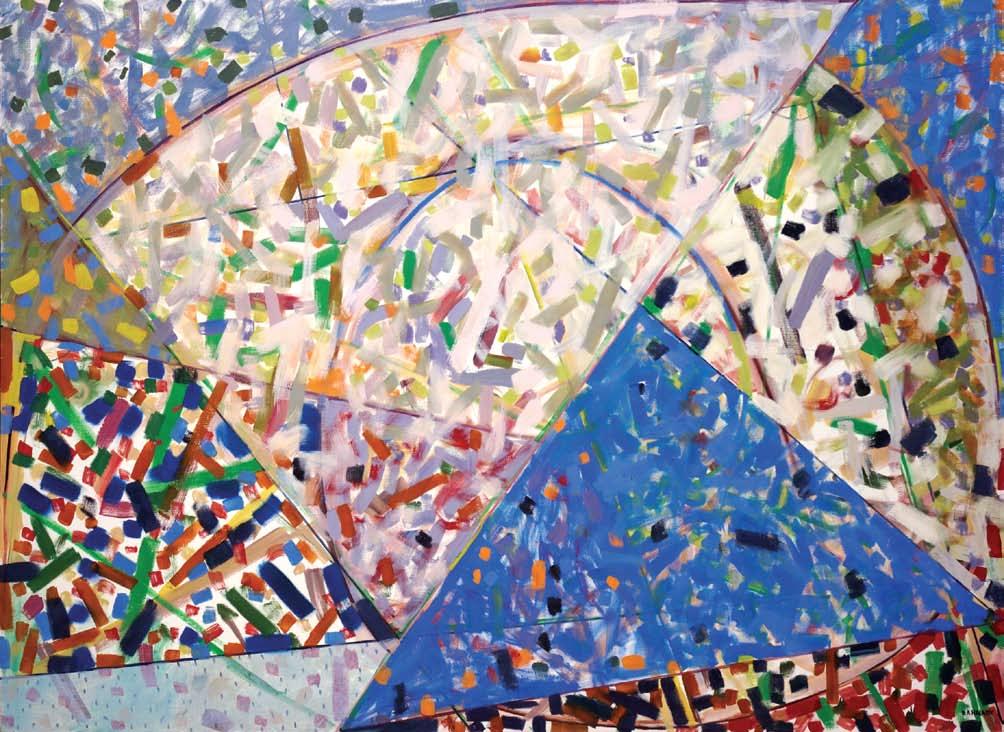
124 125 فدص�
Mother of Pearl, 1981. Oil on canvas, 66 x 90’’ 167.5 x 228.5 cm.
س�بني Pulsating, 1982. Oil on canvas, 66 x 90’’ 167.5 x 228.5 cm.
"I began to think that texture should determine shape rather than follow it. In nature, larger things are made up of groups of smaller things in successive cycles. Molecules, which themselves are made up of atoms, make up fibers which make up trees, etc. I wanted the textural parts to build the shapes as they themselves are determined by this building process. I began by allowing textural marks to threaten the integrity of shape. This led to the next series where the structure of texture became itself the subject of the painting."
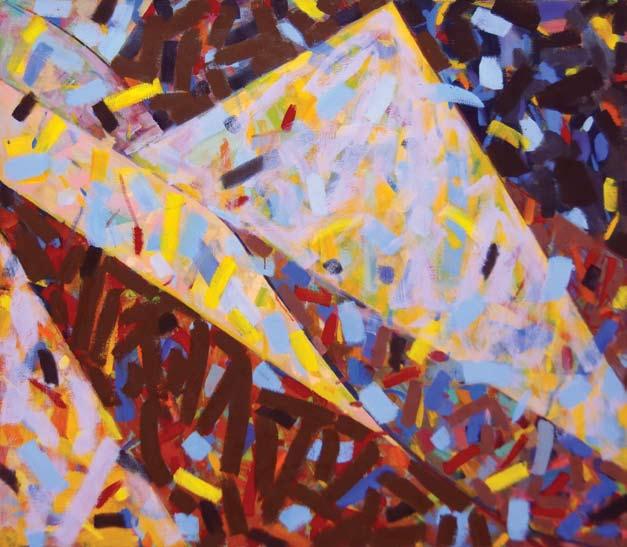
"J'ai commencé à penser que la texture devrait déterminer la forme plutôt que la suivre. Dans la nature, les objets les plus gros sont faits de groupes de choses plus petites en cycles successifs. Les molécules sont elles-mêmes faites d'atomes, et font elles-mêmes des fibres qui font des arbres etc. je voulais que les parties texturées engendrent des formes tandis qu'elles seraient elles-mêmes déterminées par ce processus de construction. J'ai commencé à faire en sorte que les marques texturées menacent l'intégrité de la forme. Ceci m'a conduit à ma série suivante où la structure de la texture est elle-même devenue le thème du tableau."

126 127 حابش� Swimmer, 1982. Oil on canvas, 66 x 90’’, 167.5 x 228.5 cm. Private collection. " زرابماش�ت " بونج "ياودورب " Broadway Below Chambers, 1982. Oil on canvas, 42 x 48’’, 107 x 122 cm. تاقلح في رغش�أ ءايش�أ نم تاعوممج نم ةفلؤ م ةيربكلا ءايش�ألا ،ةعيبطلا في .هعبتي نأا نم لدب لكش�لا ددحي نأ بجي ةحوللا في س�مللما نأا ركفأ تأادب" اهتاذ دحب يه يتلا ،لاكش�ألا ءانبب ةحوللا في س�مللما موقي نأ تدرأا .خلا ،راجش�ألا اهنم فلأاتت يتلا فايلألا لكش�ت ،تارذ نم اه �فن يه ةفلؤ لما ،تائيزلجا .ةيلاتتم " .ةحوللا عوش�وم اهتاذ دحب لاكش�ألا ةينب تحبش�أ ثيح ةيلاتلا ةل �لش�لا لىإ داق اذهو .لكش�لا دودح ددهت ةينبلا تاملاع كرتأ تأادبف .كلت ءانبلا ةيلمعب ةددمح

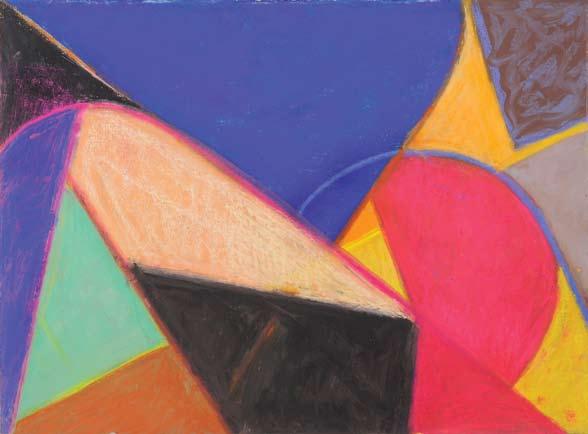


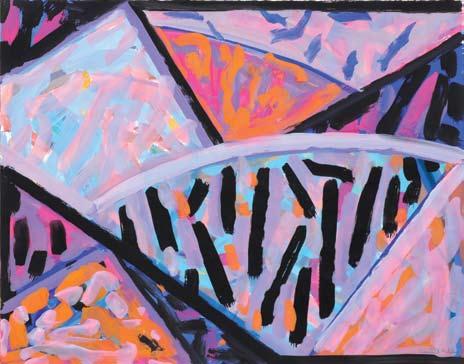

128 129 ةحورلما ةش�قر Fan Dance, 1981.
on
20
38'', 51 x 71 cm. ةيقرو ةرايط Kite, 1981.
76
نماثلا : قرط ةثلاث Thre Way: Eight, 1982. Casein on paper, 22 ¼ x 30 ¼’’, 56.5
77
عش�اتلا : قرط ةثلاث Thre Way: Nine, 1982. Casein on paper, 22 ¼ x 30 ¼’’, 56.5 x 77 cm. قترحي رنم Tiger on Fire, 1982.
76
جلثلا في روهز Flowers in the Snow, 1982. Gouache on
20
38'', 51 x 71 cm.
Casein
paper,
x
Casein on paper, 22 ¼ x 30’’, 56.5 x
cm.
x
cm.
Casein on paper, 22 ¼ x 30’’, 56.5 x
cm.
paper,
x
Autumn Leaves and City Blocks: 1982-1983
Feuilles d'Automne et Immeubles de la Ville: 1982-1983
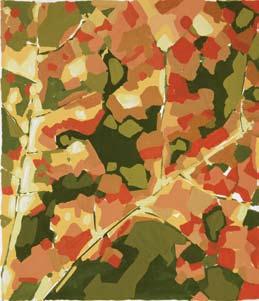
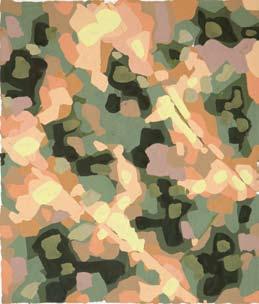
Like the Dome of the Rock series, the experiments that would be part of Autumn Leaves and City Blocks would take place over a short period, yet would be based on investigations that the artist had made nearly a decade before. In 1975 Halaby lived in New Haven, Connecticut where she taught at the Yale School of Art. Known for its dramatic seasons, which are often reflected in its landscape, she was taken by the orange, yellow and red leaves that would appear on New England trees with the onset of fall. Igniting another examination, she also began to notice that as bridges crossed rivers at right angles, they continued to run perpendicularly as roads.
The right angle, because of its simplicity, its structural economy, dominates the branching of secondary and tertiary pathways, thus forming a grid. Because grids are rectangular while rivers meander, differently oriented grids, both in cities and farmland, create truncated rectangles and uneven pentagons where they meet. Flying over the country or examining maps, one sees the complicating effects of the land on man’s simple geometry (Samia Halaby Fine Arts Publishing Beirut, 2006).
Gathering fallen leaves, she would dissect them into rectangles as though creating small compositions. With the outcome of these “tiny paintings” not reflecting the complexity or beauty of the original leaf, she determined that her paintings would have to “imitate their growth and decay rather than their appearance.” In essence, she sought to capture their natural life cycle through abstraction. These observations would be made while the artist was amidst her Diagonal Flight series, yet she would internalize the breakthroughs she would make in her investigations, applying them in 1982 when she
Comme la série du "Dôme du Rocher", les recherches qui aboutiront à "Feuilles d'Automne et Immeubles de la Ville" auront lieu durant une courte période, et pourtant elles seront fondées sur des recherches que l'artiste avait faites presqu'une décennie auparavant. En 1975, Halaby vivait à New Haven, Connecticut, où elle enseignait à la Yale School of Art. C'est un état renommé pour ses saisons spectaculaires qui se reflètent souvent dans les paysages, et elle apprécie les feuilles oranges, jaunes et rouges qui ornent les arbres de la Nouvelle Angleterre au début de l'automne. Débutant une autre série de recherches, elle commence à remarquer que même si les ponts traversent les rivières à angle droit, ils continuent à s'aligner perpendiculairement en tant que routes.
L'angle droit, de par sa simplicité, son économie structurelle, domine l'embranchement des chemins secondaires et tertiaires, formant ainsi une grille. Parce que les grilles sont rectangulaires alors que les rivières font des tours et des détours, des grilles orientées différemment, aussi bien dans la ville qu'à la campagne, créent des rectangles tronqués et des pentagones irréguliers où elles se rencontrent. En survolant le pays ou en examinant des cartes, on voit comment le terrain complique la géométrie simple de l'homme. (Samia Halaby Fine Arts Publishing Beyrouth, 2006)
Ayant ramassé des feuilles tombées, elle les découpe en rectangles comme si elle créait de petites compositions. Comme le résultat de ces "minuscules tableaux" ne reflète ni la complexité ni la beauté de la feuille originale, elle décide que ses tableaux devraient "imiter leur croissance et décomposition plutôt que leur apparence". Bref, elle cherche à saisir leur cycle de vie naturel par l'abstraction. Ces observations se font certainement pendant que l'artiste est en pleine série "Fuite Diagonale", internalisant ces avancées dans ses recherches, pour les appliquer en 1982 quand
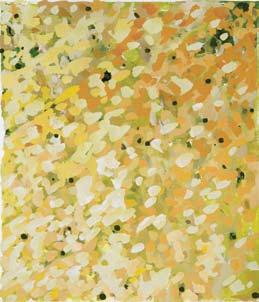
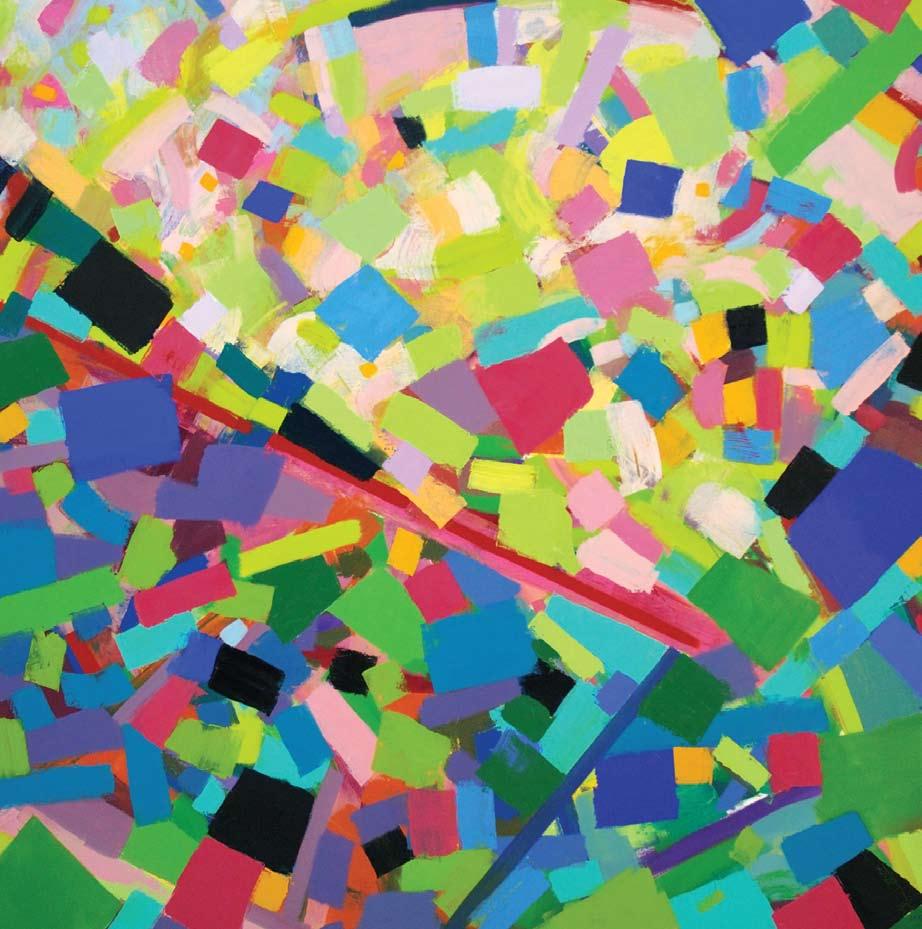
130 131
يحورلما
رجش�لا
ليذلا Fan Tail, 1982. Oil on canvas, 60 x 60’’, 152.5 x 152.5 cm.
قاروأل تاش�ارد Leaf Studies, 1975. Gouache on paper, 7 x 6’’, 18 x 15 cm.
began her Autumn Leaves and City Blocks collection of paintings. This series would also continue the free use of texture that she had developed in her Dome of the Rock compositions in a slightly different form. For the first time, Halaby abandoned the brush and utilized a palette knife to apply paint, allowing its manipulation to affect the thickness of paint and the nature of edges. And yet what differentiated these works from previous canvases was the fact that they were based on the process of growth that she had observed in nature, one that spoke of “motion in reality.”
“Tribeca” (1982, page 142) shows Halaby’s increasing interest in the evolution of shapes amidst an organic state. Using geometric forms to represent the sights of her Manhattan neighborhood, the artist seems to suggest the sensations of light and movement of figures that she encountered near her home. These uneven rectangles and pentagons seem to expand, defining one another while giving the appearance of sporadic motion as several forces are at work. Halaby views this intricate process of considering formations in nature not as an occasion for imitation, but rather for the drafting of an equivalent system. This system has a number of basic components.
(Continued page 154)
elle commence sa collection "Feuilles d'Automne et Immeubles de la Ville". Cette série poursuit également l'utilisation libre de la texture développée dans ses compositions de la série du "Dôme du Rocher" sous une forme un peu différente. Pour la première fois de sa vie de peintre, Halaby abandonne le pinceau et utilise une spatule pour appliquer la peinture, la manipulant de façon à influencer l'épaisseur de la pâte et la nature des contours. Mais ce qui différencie surtout ces œuvres de ses toiles précédentes, c'est le fait qu'elles s'appuient sur le processus de croissance qu'elle avait observé dans la nature, un processus qui évoquait le "mouvement en réalité".
"Tribeca" (1982) témoigne de l'intérêt croissant de Halaby pour l'évolution des formes dans un état organique. Utilisant des formes géométriques pour représenter les vues de son quartier de Manhattan, l'artiste semble suggérer les sensations de lumière et de mouvement des personnages qu'elle rencontre près de chez elle. Ces rectangles et pentagones irréguliers paraissent en expansion, se définissant l'un l'autre tout en donnant l'impression de mouvement sporadique car plusieurs forces sont en marche. Halaby considère ce processus complexe, c'est-à-dire l'étude des formations dans la nature, non pas comme une occasion d'imiter, mais plutôt de fabriquer un système équivalent. Ce système comprend un nombre de composantes de base.

(Suite page 154)
"The two paintings Fan Tail and One Yard Past the Shingle Factory initiated the next series. In them I worked out the formal issues of the Autumn Leaf and City Blocks series. Early in the 20th Century at the Armory Show of 1913, an art critic shocked by Marcel Duchamp’s painting, Nude Descending the Staircase described it as being like "an explosion in a shingle factory". Feeling that abstraction was a step past Duchamp and to simultaneously honor Duchamp, I titled this painting One Yard Past the Shingle Factory."
"Les deux toiles Dove Tail [Queue de Colombe] et One Yard Past the Shingle Factory [Un Mètre Après la Fabrique de Tuiles], ont marqué le début de la série suivante. Elles m'ont permis de formuler les questions formelles de la série Feuilles d'Automne et Immeubles de la Ville. Au début du 20ième siècle, un critique d'art choqué par l'œuvre de Marcel Duchamp, Nu Descendant un Escalier lors de l'exposition à l'Armory Show de 1913 l'a décrite comme "une explosion dans une fabrique de tuiles". Parce qu'il me semble que l'abstraction va un peu plus loin que Duchamp et aussi pour rendre hommage à Duchamp, j'ai intitulé cette toile One Yard Past the Shingle Factory."
132 133 ➤
حاولألا عن �م دعب ام One Yard Past the Shingle Factory,1982. Oil on canvas, 60 x 90’’, 152.5 x 228.5 cm. نرقلا لئاوأ في .ةنيدلما تاعبرمو فيرلخا قاروأ ةلش�ل �ل ةيلكش�لا اياش�قلا امهيف تروط دقف .ةيلاتلا ةل �لش�لل "حاولألا عن �م دعب ام " و "يحورلما ليذلا " اتحول ت �ش�أ " ديرجتلا نأ ب يروعش� ءارجو . "حاولأ عنش�م في راجفنا " هبش�ت اهنأا اهف �وف 1913 ماع يرومرآ س�رعم في "مل �لا طبهت ةيراع " بماش�ود لي �رام ةحولب داقنلا دحأ مدش� ،نيرش�علا " . "حاولألا عنش�م دعب ام " ةحوللا هذه تيمش� ،هش�فن تقولا في بماش�ودل ايمركتو بماش�ود دعب ةوطخ وه
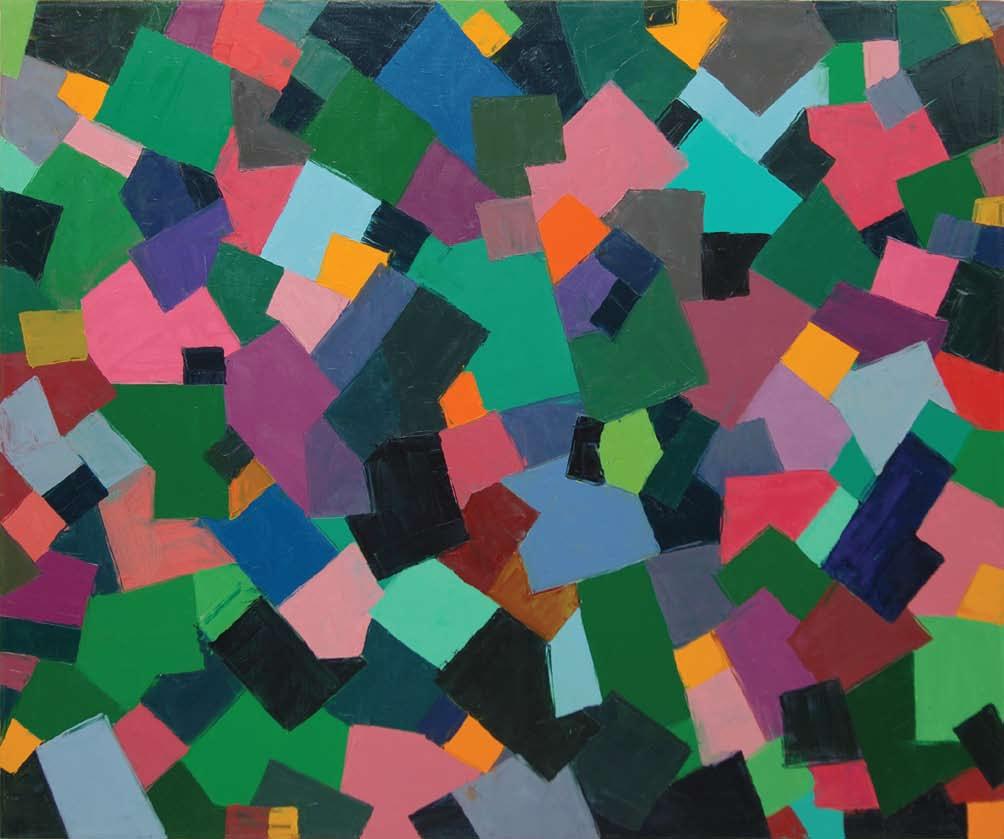
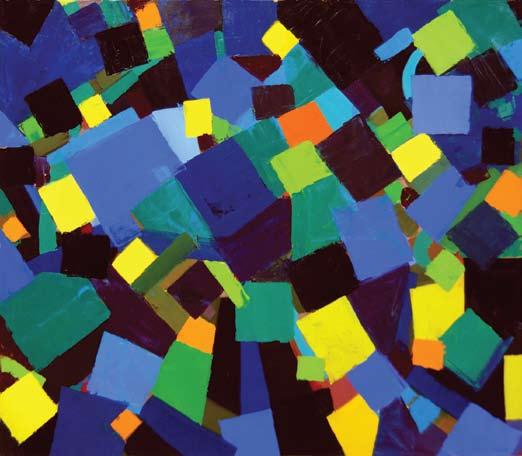

134 135 س�رج في نانجذابلا س�وح My Eggplant Patch in Gerash, 1982. Oil on canvas, 42 x 48’’, 107 x 122 cm. ءاتش�لا لئاوأ في س�مش�لا و حايرلا Wind in the Sun on Earth in Early Winter, 1982. Oil on canvas, 42 x 48’’, 107 x 122 cm. ر �خألا ير �ي يرهزلا Pink Walking Green, 1983. Oil on canvas, 50 x 60’’, 127 x 152.5 cm.
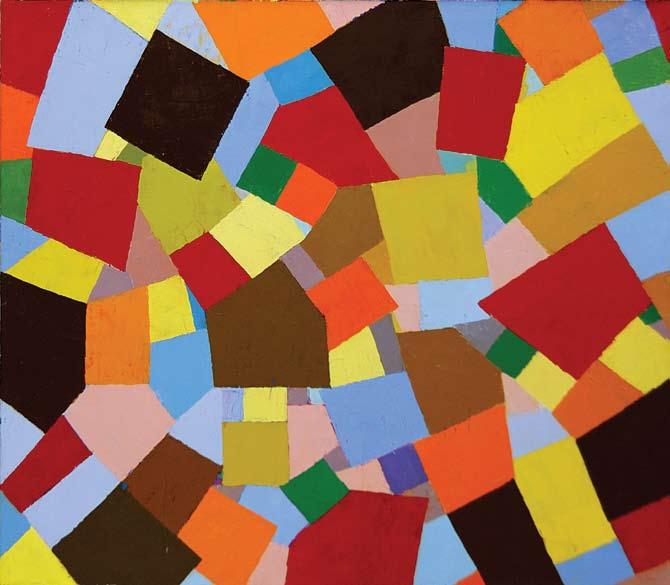
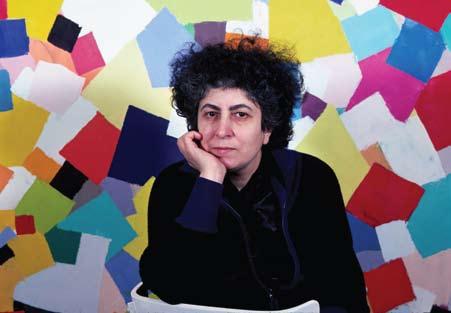
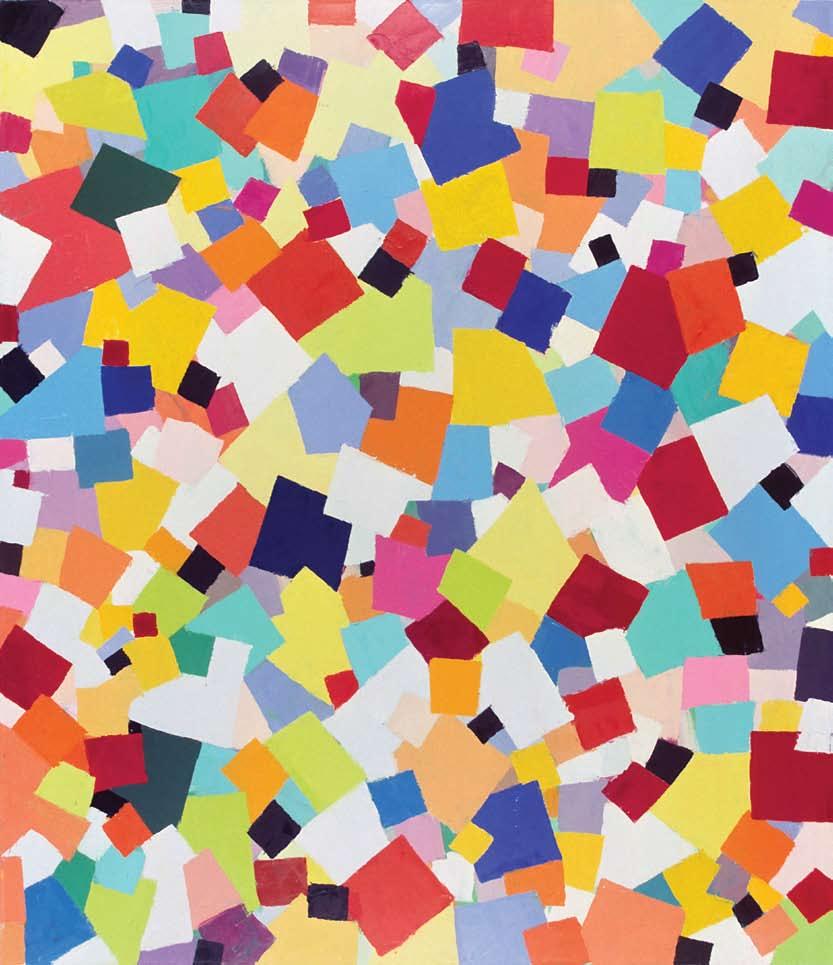
136 137 " تيترش� ترش�وو 22 " ييرلاغ في يبلح ايماش� At 22 Wooster Street Gallery, 1983. ةنيدلما في حاير Wind
City, 1982. Oil on
42
48’’, 107
122
نآلا انه نحن We Are Here Now, 1982. Oil on canvas, 65
in the
canvas,
x
x
cm.
x 75’’, 165 x 190.5 cm. Private collection.


138 139 عطاق Intersecting, 1983. Oil on canvas, 65 x 75’’, 165 x 190.5 cm. Private collection. ةيئا �ف ةرئاط Space Kite, 1982. Oil on canvas, 65 x 75’’, 165 x 190.5 cm.

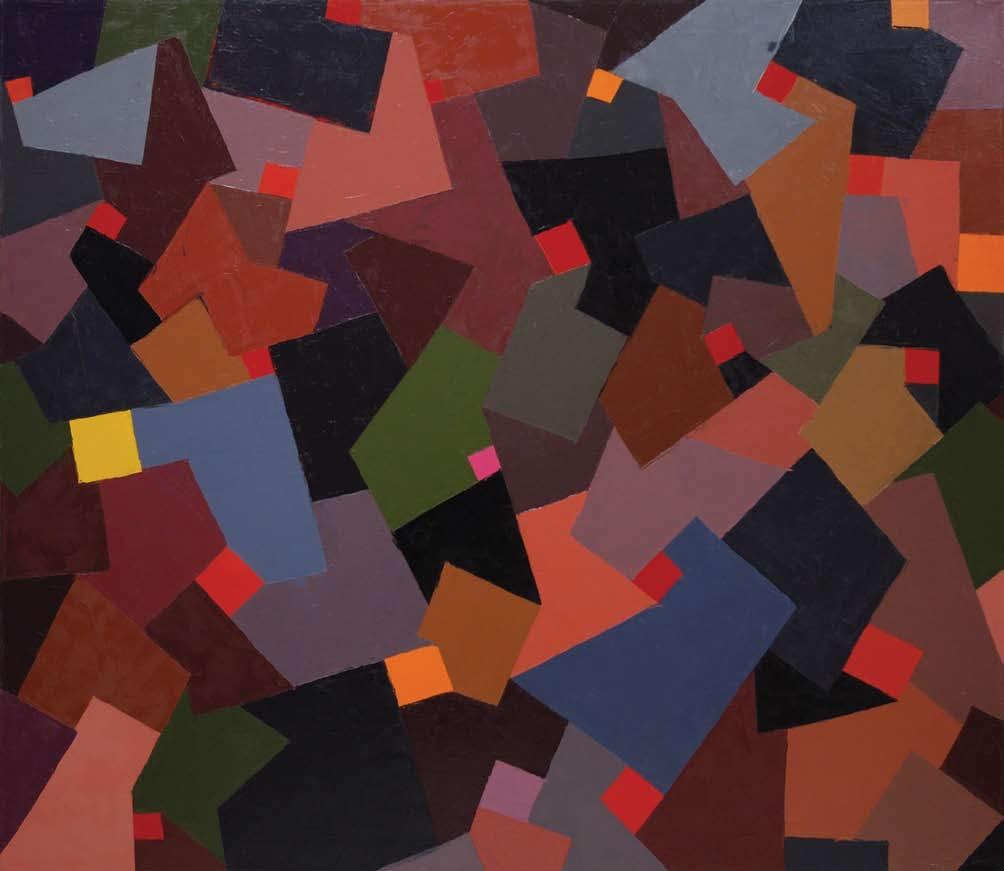
140 141 ءاش�م "ياودورب ت �يو " هاتجاب Down West Broadway in the Evening, 1983. Oil
65
75’’, 165
190.5 cm.
ةنيدلما ليايل City
on canvas,
x
x
Private collection.
Nights, 1983. Oil on canvas, 65 x 75’’, 165 x 190.5 cm. Private collection.
"During 1975, while I was making my diagonal paintings, I fell in love with autumn leaves. I collected thousands and pressed them between pages until all my books were full. I made studies in various media. I also cut rectangles out of hundreds of them searching for a perfect painting. Eventually, it dawned on me that a rectangular fragment is not as beautiful as the leaf itself because the leaf is one stage in a process of growth, while a rectangular fragment is a dead extraction unable to reveal how it came to be. In order to capture the beauty of the leaf, I had to imitate its growth not its appearance. I wanted to grow a painting just as a leaf grew.
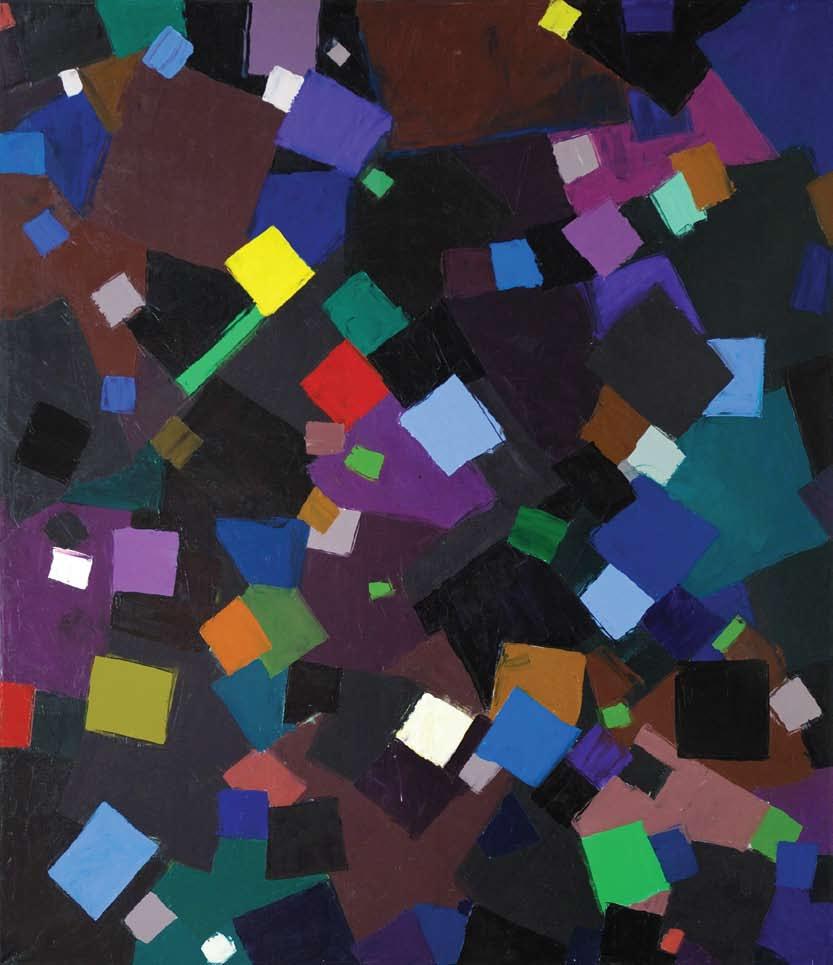
To understand the secrets of the leaves, I made minute studies of the facets between veins. I noticed that the rectangular shapes between veins in some leaves had an open corner and were in fact imperfect pentagons. I felt that they were making room for growth by opening up at one corner. Captured in the uneven pentagons was a stage in the process of growing.
Moreover, these shapes resembled the truncated rectangles in city blocks and the pentagonal land shapes between roads and highways which themselves reveal growth. That growth is the development of mankind as much as it is the development of plants. Rectangles opening at a corner to become imperfect pentagons became the formal principle of the Autumn Leaves and City Blocks series."
"Pendant l'année 1975, tandis que je faisais mes toiles diagonales, je me suis prise d'amour pour les feuilles d'automne. J'en ai ramassé des milliers et je les ai pressées entre des pages jusqu'à ce que mes livres en soient remplis. J'ai fait des croquis en techniques différentes. J'ai aussi découpé des rectangles dans des centaines de feuilles à la recherche du tableau parfait. Finalement, j'ai fini par comprendre qu'un fragment rectangulaire n'est pas aussi beau que la feuille elle-même parce que la feuille est un stade dans un processus de croissance, tandis qu'un fragment rectangulaire est un extrait sans vie, incapable de révéler comment il en est venu là. Pour pouvoir saisir la beauté de la feuille, il fallait que j'imite sa croissance et non son apparence. Je voulais faire pousser un tableau tout à fait comme une feuille pousse.
Pour comprendre les secrets des feuilles, j'ai minutieusement étudié les facettes entre les nervures. J'ai remarqué que les espaces rectangulaires entre les nervures de certaines feuilles avaient un angle ouvert et étaient en fait des pentagones imparfaits. J'ai senti qu'un coin ouvert laissait de la place à la croissance. Les pentagones irréguliers contenaient un stade du processus de croissance.
De plus, ces formes ressemblaient aux rectangles tronqués des immeubles urbains et les espaces pentagonaux entre les routes et les autoroutes qui sont aussi un signe de croissance. Cette croissance, c'est le développement de l'humanité aussi bien que celui des plantes. Ainsi, des rectangles ouverts à un coin qui se muent ainsi en pentagones imparfaits sont devenus le principe formel de la série Feuilles d'Automne et Immeubles de la Ville."
142 143 " اكيبيرت " Tribeca, 1982. Oil on canvas, 75 x 65’’, 190.5 x 165 cm. .اهلك تألاتما ىتح يبتك تاحفش� ينب اهطغ �و اهنم فلآلا تعمج .فيرلخا قاروأ مارغ في تعقو ،ةيرطقلا يتاحول م �رأا تنك امنيب ،1975 ةنش� للاخ " اه �فن ةقرولا لامجب تش�يل ةليطت �لما ةعطقلا نأا لي ينبت ،ةياهنلا في .ةلماك ةحول نع ةثحاب تلايطت �م لىإ اهنم تائلما تعطقو .لئا �ولا ىتش�ب تا �ارد تيرجأا ،ةقرولا لامج طاقتلا نم نكتمأا يكلو .دوجولا لىإ ءاج فيك ينبي نأا عيطت �ي ل تيم ءزج يه ةليطت �لما ةعطقلا نأ ينح في ،ومنلا ةيلمع في ةلحرم يه ةقرولا نأل .ةقرولا ومنت امك ومنت ةحوللا لعجأا نأ تدرأ .اهرهظم س�يلو اهونم دلقأا نأا يلع بجوت ةحوتفم ةيواز اهل قاروألا س�عب في قورعلا ينب ةليطت �لما لاكش�ألا نأ تظحلو .قورعلا ينب ةقرولا تائيزلج ةقيقد تا �اردب تمق ،رجش�لا قاروأ رار �أ مهفأا يكلو يرغ تاش�مخلما في ةرو �أ م ومنلا لحارم نم ةلحرم كانه .ومنلل لاجلما ةحاتإ وه ةحوتفلما ةيوازلا س�رغ نأ ترعش� .ةلماك يرغ تا �ممخ ةقيقلحا في تناكو .ةيوا �تلما .ومنلا ةرهاظ اهتاذ دحب فش�كت يتلا ةعير �لا قرطلاو عراوش�لا ينب يش�ارألا لاكش�أ و ةنيدلما تاعبرم في ةروتبلما تلايطتش�لما ،لاكش�ألا هذه تهباش� ،كلذ نم ثركأا يلكش�لا ادبلما تراش� ةلماك يرغ تا �ممخ كلذ دعب حبش�ت يتلاو ةيوازلا ةحوتفلما تلايطت �لما نإ .تاتابنلل روطت وه ام ردقب يرش�بلا س�نلجا روطت وه ومنلا اذهو ".ةنيدلما تاعبرمو فيرلخا قاروأ ةل �لش�ل
➤


144 145 اوغاراكينب ةروخف وكيرام
س�يرلا نم ليذ في ءامش�لا
Mariko Proud in the Tropics, 1983. Oil on canvas, 60 x 50’’, 152.5 x 127 cm.
Sky in a Feather Tail, 1983. Oil on canvas, 60 x 50’’, 152.5 x 127 cm.
on
Here is Now, 1983.
30 ¼ x 42’’, 77 x 107 cm.
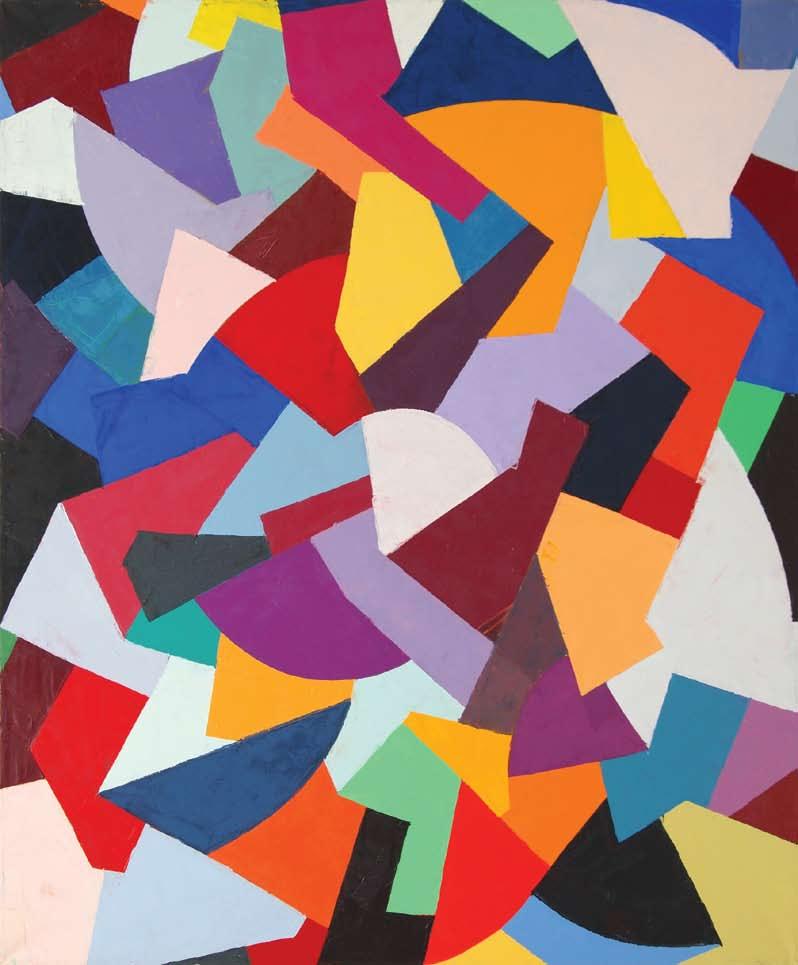

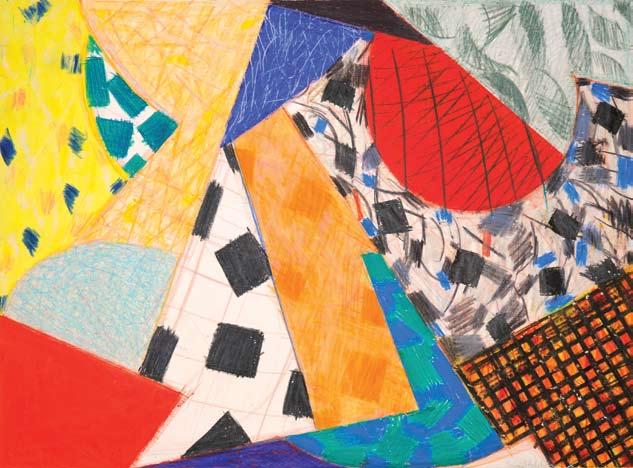
Pedestrians in Traffic, 1983.
22 ¼ x 32’’, 56.5 x 81.5 cm.
146 147 يرش�لا ةكرح
وه
مهفتو
في ةرالما
Wax on paper,
نآلا
انه
Wax
paper,
لدتج
She Braids and Understands, 1983. Oil on canvas, 60 x 50’’, 152.5 x 127 cm.
x 76 cm.
Garden, 1982. Wax on paper, 31 x 42 ¼’’, 79 x 107.5 cm.


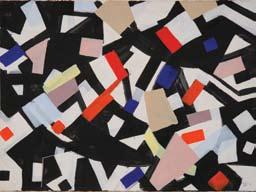
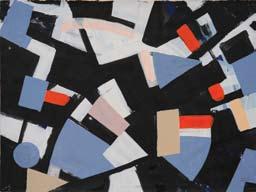
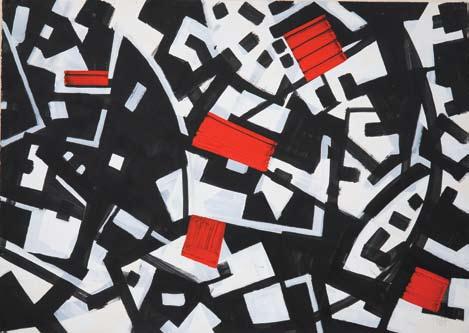
"A group of us had the habit of organizing our own shows. At one of those exhibitions at a high school theatre, I was given the stage. I created a large 24 foot (731 cm.) work by assembling all the leftover posters from one of my exhibitions. Over them I drew large circular and rectilinear lines like highways intersecting plots of farmland. In three places I inserted works on paper. Each represented the smaller subdivisions of the city into blocks. The result is an abstraction from my experiences looking out the window of airplanes."
"Avec un groupe d'artistes, j'avais l'habitude d'organiser nos propres expositions. A l'une de ces expositions dans le théâtre d'un lycée, on m'a attribué la scène. J'ai créé une œuvre de grande taille (731cm) en assemblant tous les posters qui restaient d'une de mes expositions. Par-dessus, j'ai dessiné de grandes lignes circulaires et rectilignes comme des autoroutes entrecoupant des parcelles de terrain agricole. A trois endroits, j'ai inséré des œuvres sur papier. Chacune représentait les plus petites subdivisions de la ville en pâtés de maisons. Il en ressortait une abstraction issue de ce que j'avais remarqué en regardant depuis des hublots d'avion."
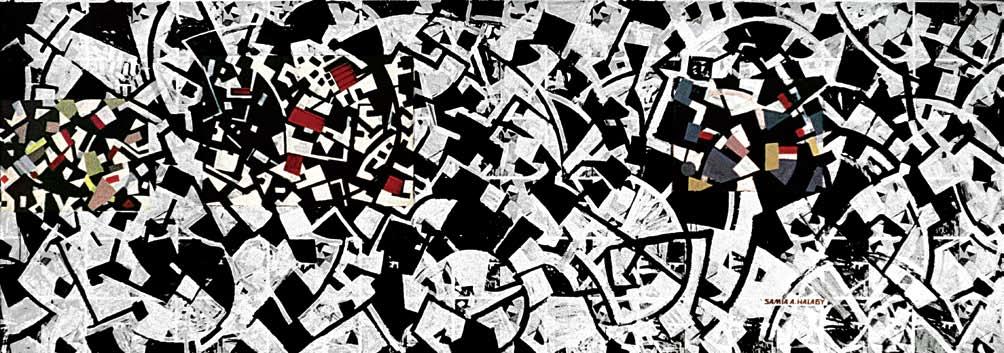
148 149 فيرلا يش�ارأا لىإا ةنيدلما تاعبرم نم City Blocks to Country Plots, 1983. Casein on paper, 72 x 288’’, 183 x 579 cm. ➤ 2 جاردإا ،فيرلا يش�ارأا لىإا ةنيدلما تاعبرم نم City Blocks to Country Plots, Insert II, 1983. Casein on paper, 30 x 42’’, 76 x 106.5 cm. 3و1 جاردإا ،فيرلا يش�ارأ لىإ ةنيدلما تاعبرم نم
ةقيدح
ةنكمألا ىلع تاش�فانم
Space, 1985.
ان �راعم ميظنت ىلع ةداتعم انم ةعوممج كانه تناك " ،ةيوناث ةش�ردم حرش�م في س�راعلما هذه دحأ في .ةش�الخا لوطب ةيربك ةحول تركتبا .حر �لما ةبش�خ دادعإ لي لكوأ ةيقابلا تاق �للما لك عيمتج للاخ نم )مش 731( امدق 24 ةيرئادو ةميقتش�م اطوطخ اهقوف تمش�رو .يش�راعم دحأا نم في تلخدأ و .ةيعارزلا ي �ارألا برعت يتلا ةعير �لا قرطلا لثم تامي �قت اهنم لك لثم ،قرولا ىلع لامعأ ةثلاث نكامأ ةثلاث يه ةجيتنلاو .ةيرامعم لتك لىإ ةنيدلما عطقت رغش�أ ةيعرف " .ةرئاطلا ةذفان نم رظنلا في يتابرخ نم ةيديرتج ةحول
City Blocks to Country Plots, Inserts I and III, 1983. Acrylic on Paper, 22 x 30’’, 56 x 76 cm.
Competing or
Wax on paper, 22 x 30’’, 56
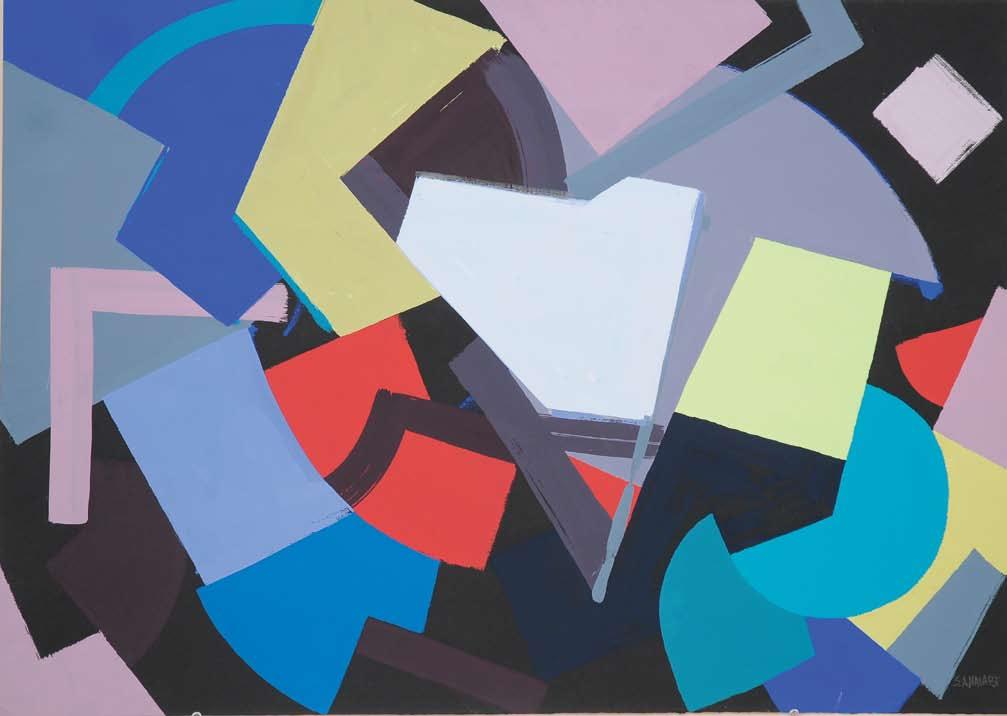

150 151 4 ةنيدلما تاعبرم City Blocks
ماش�قأ
IV,
1984. Casein on paper, 27 ½ x 39 ¼’’, 70 x 99.5 cm.
Divisions, 1984. Casein on paper, 27 ½ x 39 ¼’’, 70 x 99.5 cm.
"The black-line charcoal drawings were an interlude just before a new set. I began to think that line is a path like a pen in my hand drawing a letter, or like a dancer moving. Line represents a path of motion."

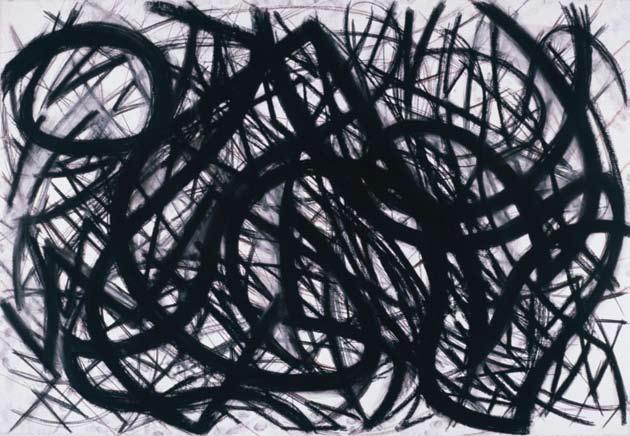


"Ces dessins au fusain noir étaient un interlude qui précédait une nouvelle série. J'ai commencé à ressentir la ligne comme un chemin, comme un stylo dans ma main traçant une lettre, ou un danseur en mouvement. La ligne représente une trajectoire."

152 153 جلثلا في راجش�أا
س�قر
ناش�غأا
يبرعلا طلخا ة �قر
" .ةكرحلل ارا �م لثيم طلخا .س�قارلا ةكرح لثم وأ ،ةلاش�ر بتكأ انأ و يدي في ملقلا لثم را �م وه طلخا نأ ب ركفأ تأادب .ةديدج ةعومجبم ءدبلا لبق ل �اف ةباثبم محفلا ملقب تاموش�رلا تناك "
Trees in Snow, 1984. Photograph.
Dance, 1983. Charcoal on paper, 29 x 42’’, 73.5 x 107 cm. Private collection. تاكرح Movements, 1983. Charcoal on paper, 29 x 42’’, 73.5 x 107 cm.
Branches, 1984. Photograph.
Calligraphic Dance, 1984. Charcoal on paper, 40 x 104’’, 101.5 x 264 cm.
Growing Shapes and Centers of Energy 1984-1992
Formes en Croissance et Centres d'Energie 1984-1992
As she developed her understanding of how to emulate nature’s processes, a new set of works emerged in which shapes grew over the course of painting in lieu of direct imitation.
[A] line can be a path for moving things-a path of motion-such as an artery or a nerve or a roadway or a river. A shape can be a field. An edge surrounds a shape which is an area containing material. The material and its changes affect the edge. It may expand or contract, or it may balloon or wrinkle (Halaby, Growing Shapes, H.T.T.B.F.T. Press New York, 1996).
These classifications would be crucial to allowing a composition to develop intuitively, granting the artist a greater sense of freedom. At this point she would also decide that shading does not exist in pure abstraction. To include shading is to imply directional illumination, whereas a focus on brush marks and edges became “dynamic and alive, and had the power to cut, intersect, reshape and bring to being new sets of shapes.” This allows for shapes to grow without interference, encouraging variation and development just as it did in nature, and is similar to Malevich’s notions of abstraction. This is also inline with the views of Vladimir Tatlin, the founder of Constructivism, who “built on the principle of life, organic forms” and stated, “Through the observation of these forms I came to the conclusion that the most aesthetic forms are the most economical.” (Gray, The Russian Experiment in Art, Thames and Hudson Ltd London, 1986).
Tatlin, who launched the movement in 1919, had been a sailor in the Mediterranean as a young man, spending time in Egypt, Syria and the Levant while intermittingly returning to Russia to study art in the early 1900s. That he was most likely exposed to the same Islamic architectural monuments as Halaby during his emergence as an artist is a fascinating historical link, further connecting the roots of abstraction in Western art to Islamic and Arab art. In fact, Tatlin’s seminal work, “Monument to the IIIrd
Tandis qu'elle approfondit ses connaissances sur l'imitation des processus naturels, une nouvelle série d'œuvres émerge dans laquelle des formes grandissent pendant l'acte de peinture plutôt que par imitation directe.
[Une] ligne peut servir de canal pour des objets en mouvement – un canal de mouvement – comme une artère, un nerf, une route ou une rivière. Une forme peut être un champ. Un contour entoure une forme qui est une zone contenant de la matière. Cette matière et ses changements ont un effet sur le contour. Il peut s'étendre ou se contracter, ou bien se gonfler ou se rider. (Halaby, Growing Shapes H.T.T.B.F.T. Press New York, 1996)
Ces classifications seront cruciales pour le développement intuitif d'une toile, permettant à l'artiste un plus grand sentiment de liberté. Elle est alors en mesure de décider que les ombres n'existent pas dans l'abstraction pure. Le fait d'incorporer des ombres implique l'éclairage directionnel, tandis qu'une focalisation sur les traits de pinceau et les contours devient "dynamique et vivante, et possède le pouvoir de couper, d'entrecouper, de reformer et d'engendrer de nouvelles combinaisons de formes." Ceci permet aux formes de grandir sans intervention, encourageant des variations et développements exactement semblables à ceux ayant lieu dans la nature, c'est à dire une conception de l'abstraction qui rappelle celle de Malévich. Elle correspond également aux idées de Vladimir Tatlin, le fondateur du Constructivisme, qui "construit des formes organiques à partir du principe de la vie " et dit que "par l'observation de ces formes, j'en suis venu à la conclusion que les formes les plus esthétiques sont les plus économiques." (Gray, The Russian Experiment in Art, Thames and Hudson Ltd London, 1986).
Tatlin, qui lance le mouvement en 1919, avait dans sa jeunesse travaillé comme marin dans la Méditerranée, et avait vécu en Egypte, en Syrie et dans le Levant tout en revenant par intervalles en Russie pour faire des études d'art au début des années 1900. Il y a certainement un lien historique fascinant dans le fait qu'il fut très certainement exposé aux mêmes monuments architecturaux islamiques que Halaby pendant sa
Sketchbook pages from the series Growing Shapes, 1984-89.


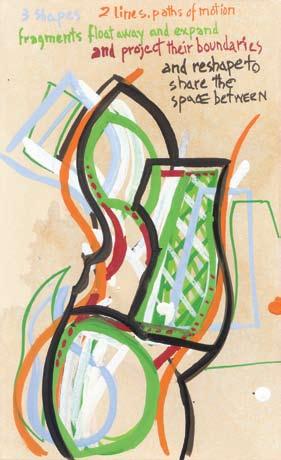

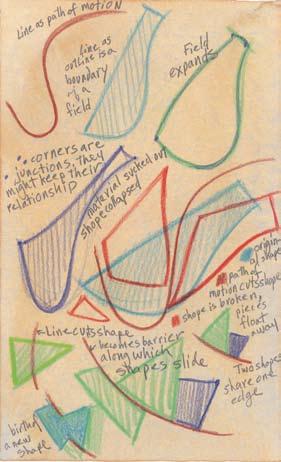

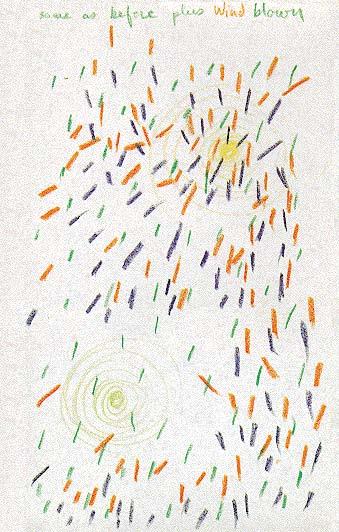
154 155
ةيمانتلما لاكش�ألا ةعوممج نم تاش�ارد
Line and Variation, 1984. Casein on paper, 22 x 30’’, 56 x 76 cm.
International” (1919-1920), which became an icon of the revolutionary movement, uses the same spiral form that can be found in the minaret of the Ibn Tulun mosque in Cairo that was built in the ninth century under the Abbasid Caliphate.
Brush marks and “the general principles of motion governing reality” began to be central to her approach. In 1985 the artist started to view the traditional rectangular frame as inapt for abstraction, as “time is expressed in abstract painting that is flat, static and makes an illusion of multidimensional reality.” Shape and line quickly moved in all directions, surpassing the borders of the canvas. This led to large paintings as installations on walls, in addition to several artist’s books that pursued very un-book-like directions.
formation artistique, liant un peu plus les racines de l'abstraction dans l'art occidental à l'art islamique et arabe. En fait, l'œuvre influente "Monument à la IIIème internationale" (1919-1920), qui devint par la suite une icône du mouvement révolutionnaire, utilise la même forme en spirale que celle du minaret de la mosquée Ibn Touloun au Caire, construite au neuvième siècle sous le califat abbasside.
Studio view New York, 1984.
She began with a series of paintings that were placed directly on the walls of her studio, placing them over scattered rectangles of stapled canvas that were hung at various angles. As multiple planes were layered with abstractions that leap out beyond their rectangular forms, a sense of unrestricted movement was created. Halaby’s lines and geometric forms were then teeming with energy and could not be contained.
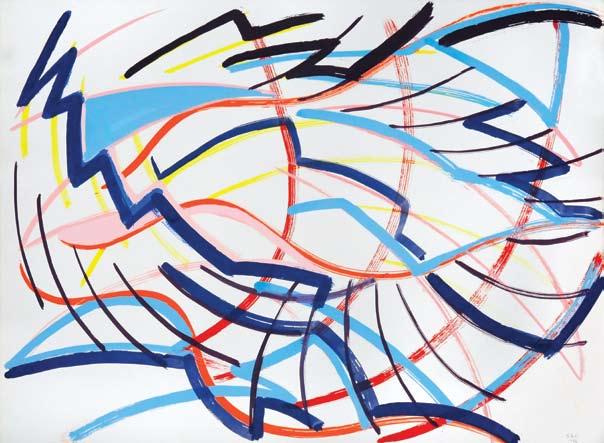

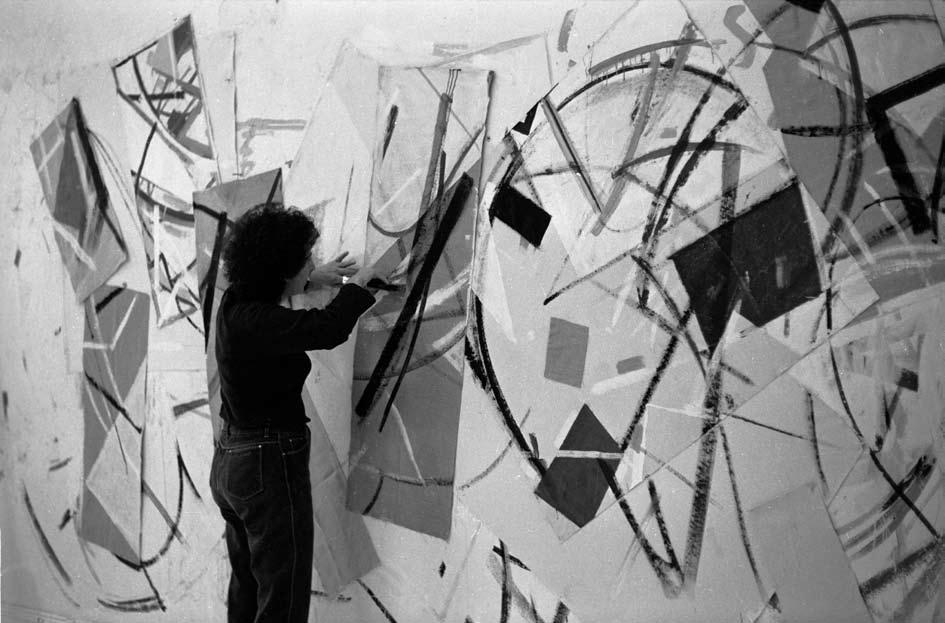
In Malevich’s Suprematist paintings, shapes and lines interact freely without the restriction of a descript background that would inherently freeze them in a specific moment of time, and are thus given the appearance of moving about the picture plane. Halaby views this background space as one that “for the first time in history… possessed relative measure, a fourth dimension.” In “For Niihau from Palestine” (1985, page 159) this fourth dimension is created, as not one brushstroke or line remains stagnant.
The expansive painting installation demonstrates this new approach. This would be her freest work to date, in which she challenged traditional concepts of painting as existing within a singular (and confined) rectangle. As a result the viewer’s gaze is prompted to follow the sporadic motion of forms, one that is continuous and has neither a beginning nor end, an aspect that signals space and time. She created the installation as part of a faculty show while teaching in Honolulu for the second time. Halaby began the
Les traces de pinceau et "les principes généraux du mouvement gouvernant la réalité" commencent à devenir centraux dans la démarche de Halaby. En 1985, l'artiste s'aperçoit que l'espace rectangulaire traditionnel est inadapté à l'abstraction, car "le temps s'exprime dans la peinture abstraite qui est plate, statique et crée une illusion de réalité multidimensionnelle". Formes et lignes se meuvent rapidement dans toutes les directions, dépassant des bordures du tableau. Ceci mène à de grandes toiles qui fonctionnent comme des installations sur les murs, en plus de plusieurs livres de l'artiste qui suivent des directions tout à fait non-livresques.
Elle commence par une série de tableaux placés directement sur les murs de son atelier, les attachant à des rectangles de toile agrafés ça et là et accrochés à des angles divers. Ces plans multiples couverts d'abstractions s'élancent hors de leurs champs rectangulaires, produisant une impression de mouvement sans contraintes, comme si les lignes et les formes géométriques de Halaby débordaient d'énergie et ne pouvaient être contenues.
Dans les toiles suprématistes de Malevich, formes et lignes se répondent librement sans la contrainte d'un fond descriptif qui les paralyserait de façon inhérente dans un instant spécifique; c'est ce qui leur donne l'apparence de se mouvoir dans le champ de l'image. Halaby conçoit cet espace en arrière plan comme un espace qui "pour la première fois dans l'histoire… possèdait une mesure relative, une quatrième dimension." Elle crée cette quatrième dimension dans "For Niihau from Palestine [Pour Niihau de Palestine]", où pas un seul trait ou coup de pinceau ne reste stagnant.
La grande installation de peinture "For Niihau from Palestine" (1985) témoigne de cette nouvelle démarche. Il s'agit de son œuvre la plus libre à ce jour, qui lance un défi aux conceptions traditionnelles de la peinture comme existant dans un rectangle unique (et limité). L'œil du visiteur est guidé le long du mouvement
156 157 مش�رم
طخ تايرغت ➤
تازازتها ➤ Vibrations, 1984. Casein on paper, 22 x 30’’, 56 x 76 cm.
work prior to the exhibition’s opening and continued it throughout the show’s duration with the intention of allowing viewers to witness its progression.
“For Niihau from Palestine” was dedicated to the “liberation of the original Hawaiians.” As the artist explains, “Abstract painting is based on the ability to understand general principles in nature and reality. These same principles allow me to see the similarity between the oppression of the Palestinians and Hawaiians” (Samia Halaby Fine Arts Publishing Beirut, 2006).
This observation reflects the connection between the movement and energy that is found in her works from the early 1980s until the present with similar occurrences that are found not only in the natural world but also in the actions of mankind, namely in revolution or the progression of ideas. She first identified this in the Russian avant-garde and has since factored it into her own work.
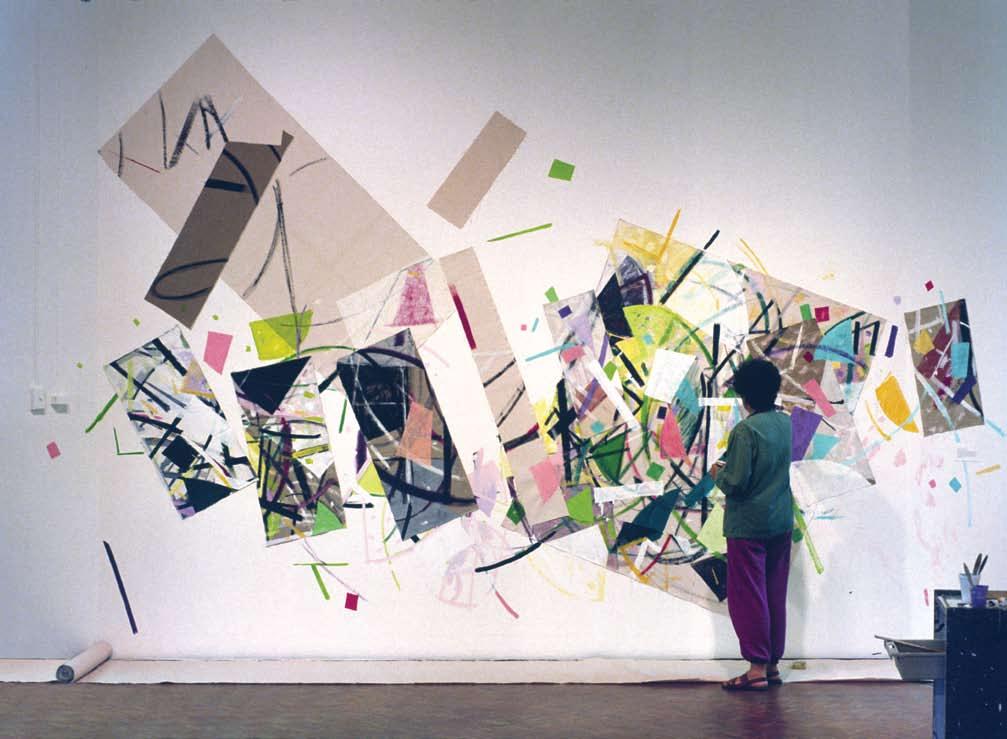
I remember seeing an exhibition by [Lyubov] Popova, I could hardly stay in my shoes. I wanted to run out and do something. I’ve experienced revolution from afar [the Palestinian revolution]. If you are around workers who are the heart of revolution, you too will pick up the energy of the movement. (Interview with the artist 2009).
The artist would continue to be inspired by the regeneration that results from such events, signaling this momentum in her compositions. A prime example of this is the mural-sized work “Centers of Attraction” (1989, page 185). While viewing a protest from atop a bridge near Manhattan’s Grand Central Station she was taken by a large group of demonstrators. Moving as a uniformed body, the crowd appeared as a mass of varying shapes, color and energy. Inspired by this sight she created a painting about “groups of people whence creative ideas originate and expand” (Samia Halaby, Fine Arts Publishing Beirut, 2006).
(Continued page 198)
sporadique des formes, un mouvement continu qui n'a ni début ni fin, signalant ainsi l'espace et le temps. L'installation fait partie d'une exposition du personnel de la faculté des beaux-arts lorsqu'elle enseigne à Honolulu pour la deuxième fois. Halaby commence l'œuvre avant l'ouverture de l'exposition et la continue après sa clôture dans l'intention de permettre au public d'être témoin de son évolution au cours de l'exposition.
"For Niihau from Palestine" était dédicacée à la libération des Hawaiiens d'origine". Comme l'explique l'artiste, "la peinture abstraite se fonde sur la capacité de comprendre des principes généraux de la nature et de la réalité. Ces mêmes principes me permettent de voir la similarité entre l'oppression des Palestiniens et celle des Hawaiiens" (Samia Halaby, Fine Arts Publishing Beyrouth, 2006).
Cette observation reflète le rapport entre d'une part le mouvement et l'énergie que l'on trouve dans son œuvre depuis le début des années 80 jusqu'au présent et d'autre part des occurrences similaires ayant lieu non seulement au sein du monde naturel, mais aussi dans les agissements des êtres humains, c'est-à-dire dans la révolution ou le progrès des idées. Elle identifie ce processus dans l'avant-garde russe et l'inclut depuis dans sa propre œuvre.
Je me rappelle avoir vu une exposition de [Lyubov] Popova, j'arrivais à peine à rester en place. Je voulais courir et faire quelque chose. J'ai fait l'expérience de la révolution de loin, [la révolution palestinienne]. Si vous êtes proche des ouvriers qui sont au cœur de la révolution, vous aussi absorberez l'énergie du mouvement. (Entretien avec l'artiste 2009)
L'artiste continue d'être inspirée par la régénération découlant de tels événements, signalant cet élan dans ses compositions. Prenons par exemple l'œuvre de taille monumentale "Centers of Attraction [Centres d'Attraction]" (1989). Alors qu'elle observe une manifestation du haut d'un pont près de la gare centrale de Manhattan, une grande vague de manifestants lui attire l'œil. Se mouvant uniformément comme un seul corps, la foule apparait comme une masse de volumes, de couleurs et d'énergie diverses. Inspirée par ce spectacle, elle crée une toile sur "des groupes de gens desquels les idées créatives émergent et se développent." ( Samia Halaby Fine Arts Publishing Beirut, 2006).
(Suite page 198)
158 159 ينطش�لف نم "واهئ " لىإا
For Niihau from Palestine, 1985. Acrylic and canvas on wall, 120 x 240’’, 305 x 609.5 cm.
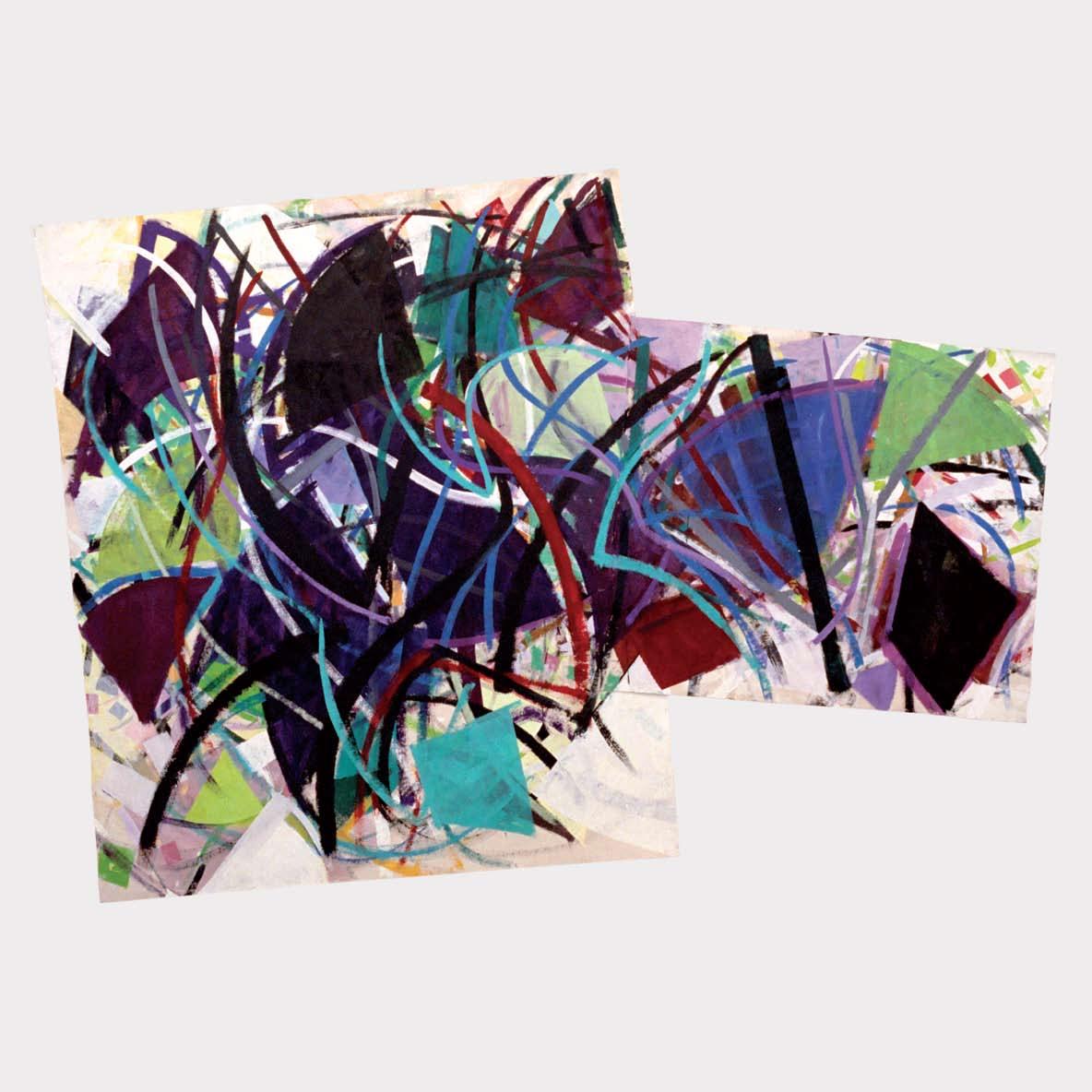
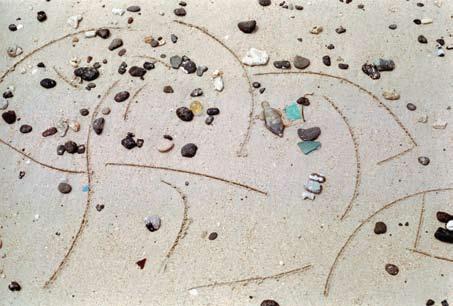
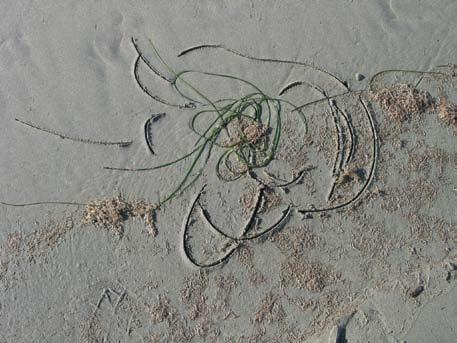

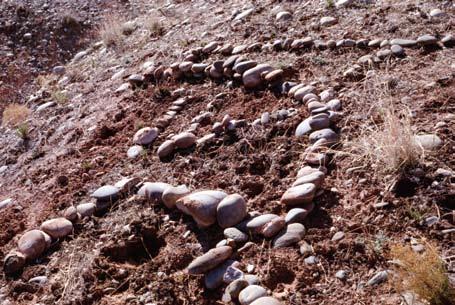
160 تاغارفو نكامأ Places and Spaces, Hawaii, 1986. Photograph
" ودارولوك " في ةراجح Stones in Colorado, 1993.
رودأا انأ I Compass, 1993.
داص�ح Harvesting , 1986.
117
109 ½’’, 297 x 278 cm. لكش�لا عش�وت Expanding
Vancouver Island, 2007.
of sand drawing.
Photograph of arranged stones.
Photograph of drawing in mud and water.
Acrylic on canvas,
x
Shape,
Photograph of sand drawing.



162 163 " كرام " لىإ
For Mark, 1987.
نوقبي نيذلل تاديكروأ
Acrylic on canvas, 56 x 42’’, 142 x 106.5 cm. Private collection.
" س�فور "
Orchids for Those who Stay, 1986. Acrylic on canvas, 36 x 86’’, 91.5 x 218.5 cm.
Rufus, 1986.
Acrylic on canvas, 36 x 38’’, 91.5 x 96.5 cm.
"My dealer at the time was a Basque woman, Marta Santos-Lourdes, who had opened a small gallery in upper Manhattan. While I was in Hawaii, she wrote that she wanted me to make something for a show of artists’ books. I made the book above so that once open its pages would lie outside the perimeter of the covers. As each page is turned a new painting is created by a combination of the newly revealed parts in mixture with the still visible parts of the previous pages. The title honors the true inhabitants of the island of Niihau who are mercilessly occupied. They work for the island’s American owner and are paid in script, a kind of money that can only be spent at the owner’s store. Public transportation in and out of the island does not exist and the islanders have no electricity and if they marry outside they are not allowed to return. Their democratic rights are entirely subverted."



"Ma galeriste à cette époque était une Basque, Marta Santos-Lourdes, qui avait ouvert une petite galerie dans Upper Manhattan. Quand j'étais à Hawaii, elle m'avait écrit qu'elle voulait que je fasse quelque chose pour une exposition de livres d'artistes. J'ai fait le livre ci-dessus de façon à ce qu'une fois ouvert, ses pages dépassent du périmètre de la couverture. A chaque fois qu'on tourne une page, on crée un nouveau tableau en combinant les parties qui viennent d'être révélées et les parties encore visibles des pages précédentes. Le titre est en hommage aux habitants de l'île de Niihau qui sont occupés sans merci. Ils travaillent pour le propriétaire américain de l'île et sont payés en coupons, une sorte de monnaie qui ne peut être dépensée que dans les magasins du propriétaire de l'île. Il n'y a pas de transport public pour entrer ou sortir de l'île et les habitants locaux n'ont pas d'électricité. S'ils se marient hors de l'île, ils ne sont pas autorisés à revenir. Leurs droits démocratiques sont complètement bafoués."
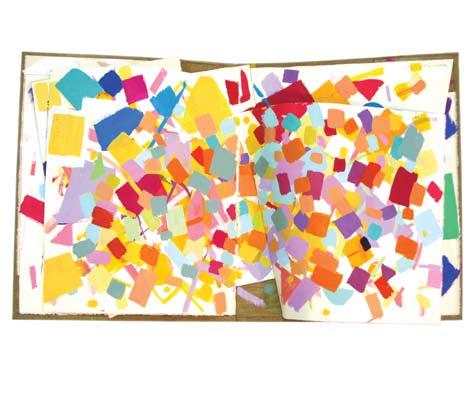
164 165 باتكلا - ينطش�لف نم "واهئ " لىإا For Niihau from Palestine, The book, 1986. Acrylic and canvas on paper, size when closed 18 x 16’’, 45.5 x 40.5 cm. اهنإ لي تبتك ،ياواه في تنك امنيبو .نتاهنام في ةيرغ � ةلاش� تحتف دق تناك ،زدرول-زوتنا � اترام ،ةيكش�اب ةأ رما تقولا كلذ في اهعم لماعتأا تنك يتلا ةلاش�لا ةريدم تناك " ةديدج ةحول لكش�تت ةحفش� لك بلق عمو .فلاغلا يتفد دودح نع هتاحفش� جرخت ىتح هحتفت نأا ام ثيحب هلاعأا باتكلا تددعأ .يننانفلا بتكل س�رع لجأ نم ام ائيش� دعأا نأا نيديرت نود مهللاتحا ىرج نيذلا "واه ن " ةريزلج ينيلش�ألا ناك �لل ايمركت ناونعلا ناك .ةقبا �لا ةقرولا نم ةيئرم لازت ام يتلا ءازجألا عم ةحفش�لا بلقب اهفش�ك تم يتلا ءازجألا عامتجا نم ناك � ىدل ءابرهك لو ،ةريزلجا لىإ و نم ةماع لقن ةلي �و دجوي ل .كلالما نزمخ نم لا اهفر � نكيم ل قاروأا مهروجأا نو �اقتيو ةريزجلل يكيرمألا كلالما حلا �ل نولمعي مهف .ةمحر " .لماكلاب ةرمدم ةيطارقيمدلا مهقوقح .اهيلإ ةدوعلا هل قحي لاف ةريزلجا جراخ نم ادحأا مهنم دحأ جوزت اذإ و ،ةريزلجا
"Bradley Walter Tomlin and Jackson Pollock are two Abstract Expressionist painters that I admire. Pollock was more important in my view and had a deeper influence on my work."
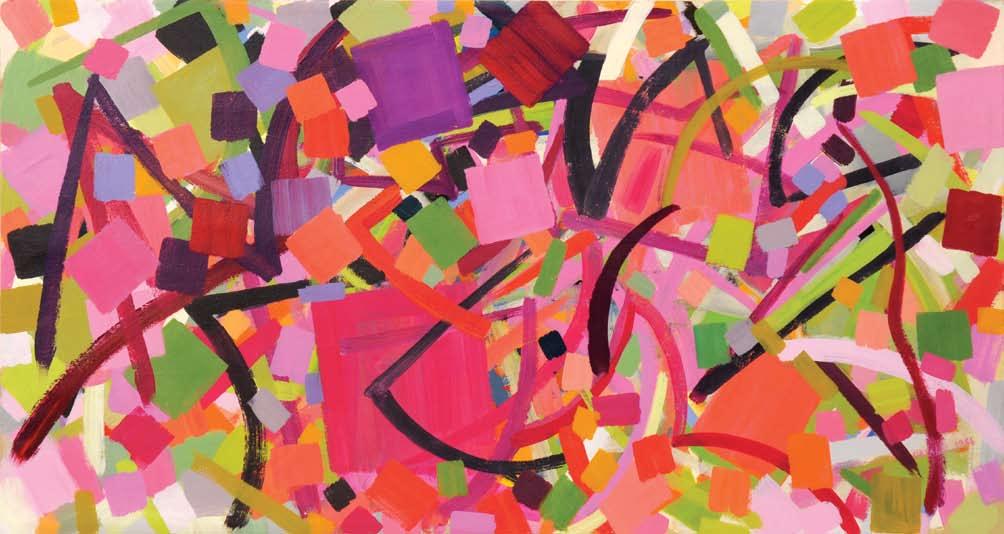
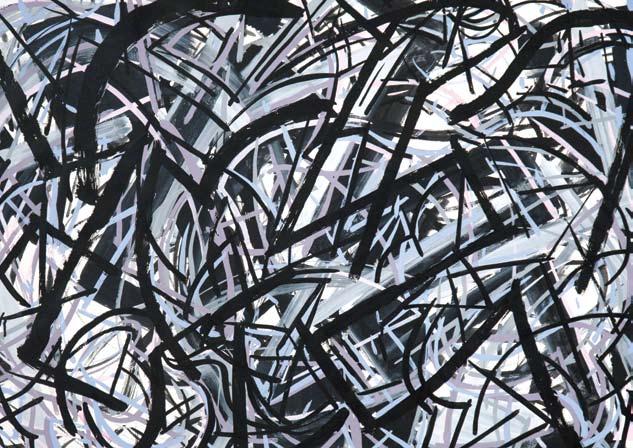
"Bradley Walter Tomlin et Jackson Pollock sont deux peintres expressionnistes abstraits que j'admire. De mon point de vue, c'est Pollock qui était plus important et il a eu une influence plus profonde sur mon œuvre."
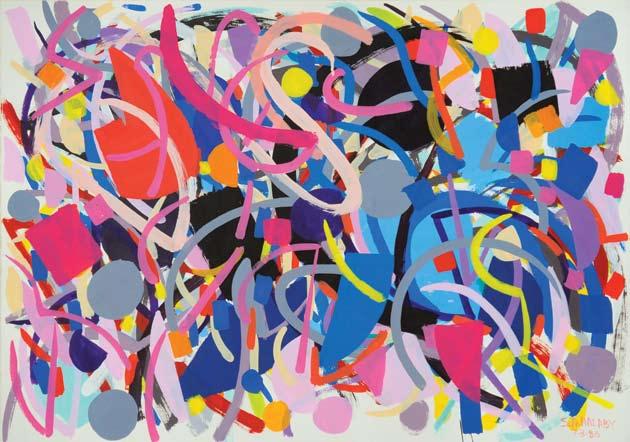
166 167 دو �أ طخ رارمتش�ا Black Line Continuation, 1986.
29 ¾ x 41 ¾’’, 75.5 x 106 cm. روهمج
1986.
" كولوب " و "ينلموت " ـل One
Acrylic
".ليامعأ ىلع ايربك ايرثأا كرتو ييأ رب ةيمهأ ثركأ ناك كولوب .ايرثك امهردقأ نايديرتج ناييربعت ناماش�ر امه كولوب نو �كاجو ينلموت ترلاو ليدارب "
Acrylic on paper,
Crowd,
Acrylic on paper, 29 x 42’’, 73.5 x 106.5 cm.
for Tomlin and Pollock, 1985.
on canvas, 36 x 67’’, 91.5 x 170 cm.
Acrylic
Acrylic on paper, 22 ¼ x 30’’, 56.5 x 76 cm.
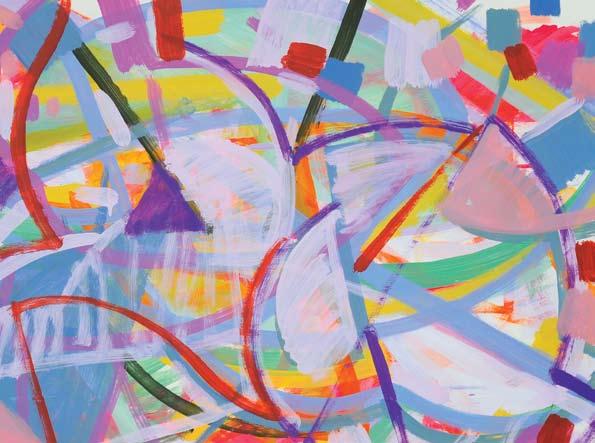
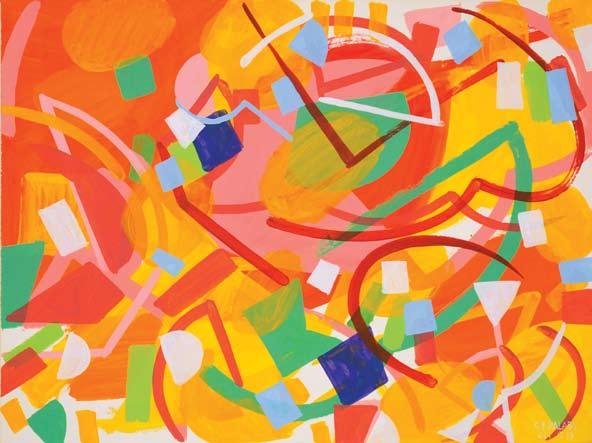
"This installation painting occupied an entire wall at my exhibition at Galleria Palace de Arte in Granada, Spain, in 1986. I spent a week before the opening executing the painting based on the principles of growth that I had been developing over the previous years. I had brought partly painted pieces of canvas which I scattered over the wall. I allowed them to guide new generations of shapes and lines throughout the wall. At the end of the show, I retrieved the canvas parts, and the gallery painted over the remaining parts in preparation for their next show."
"Cette installation peinte occupait un mur entier de mon exposition à la galerie Palace de Arte à Grenade en Espagne en 1986. J'ai passé une semaine entière avant l'ouverture à exécuter le tableau en me fondant sur les principes de croissance que j'avais développés au cours des années précédentes. J'avais apporté des morceaux de toile en partie peints et je les ai disséminés sur le mur. Je les ai laissé me suggérer et engendrer de nouvelles formes et lignes le long du mur. A la fin de l'exposition, j'ai récupéré les morceaux de toile, et la galerie a passé une couche de peinture sur les parties qui restaient en vue de leur exposition suivante."
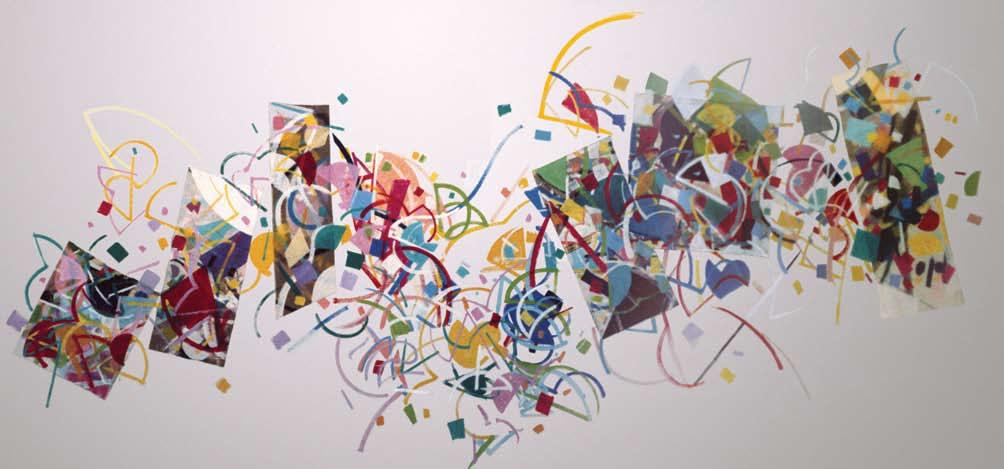
168 169 ملكتت "س�نرولف " Florence
Speaking, 1986.
لياقترب س�اص�أا
on paper, 22 x 30’’, 56 x 76 cm.
Orange Ground, 1986.
ةطانرغل For Granada, 1986. Acrylic on canvas and wall, 108 x 180’’, 274.5 x 457 cm. ةحوللا ىلع لمعأ حاتتفل لبق لاماك اعوب �أا تي �ق 1986 في ،ايناب �إا ،ةطانرغ في ترآا يد س�لاب اييرلاغ في ي �رعم في لاماك ارادج هذه بيكترلا ةحول تلغش� " ةديدج لايجأا دوقت اهتكرتو .طئالحا ىلع اهتثرعبو س�امقلا نم ايئزج ةنوهدم اعطق تر �حأا .ةي �الما تاون �لا للاخ اهروطأا تنك يتلا ومنلا ئدابم ىلع ادانتش�ا " .مداقلا مهش�رعلم ادادعت �ا ةيقبتلما ءازجألا ىلع تم �ر كلذ دعب ةلا �لا نكل ،س�امقلا ءازجأا تدعت �ا س�رعلا ةياهن في .رادلجا لماك ىلع طوطلخاو لاكش�ألا نم
Semi and City Signs, 1986. Acrylic on canvas, 50 ½ x 88 ½’’, 128 x 225 cm.
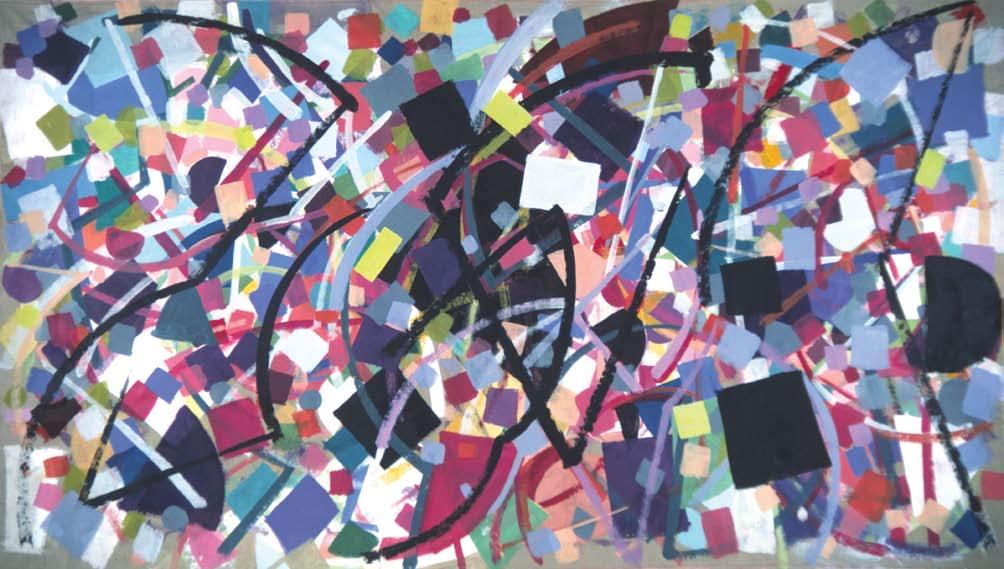
Inhee Growing 1986. Acrylic on canvas, 37 x 72’’, 94 x 183 cm.
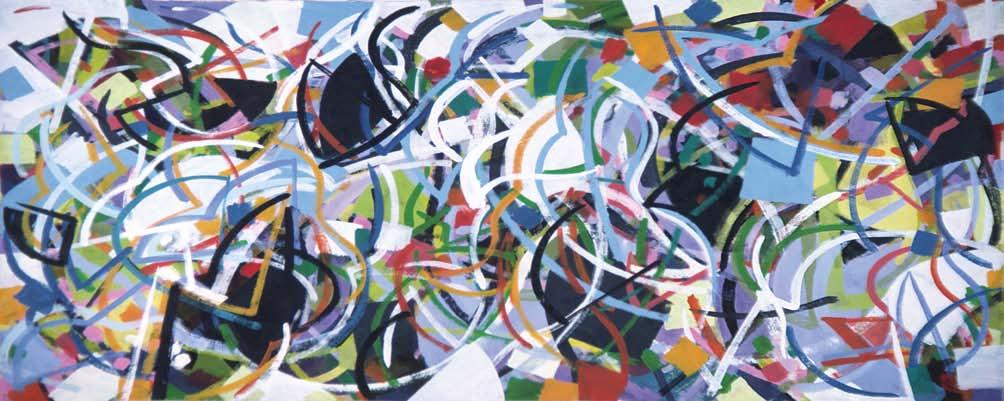
"Inhee was one of my Korean students in Hawaii and she was a brilliant painter. I learned much from my students during the years of my teaching. One painting course however, which I presented in Hawaii in 1985 was magical for me. This was because I was, to the students, the visiting artist from New York presenting liberating ideas on the connection of abstraction to nature, and for me, the sincerity and receptivity of the mostly Asian students was a breath of fresh air."
"Inhee était l'une des mes étudiantes coréennes à Hawaii, et c'était une peintre exceptionnelle. J'ai beaucoup appris de mes élèves lors des mes années passées à enseigner. Mais il y a eu un moment magique, un cours de peinture que j'ai donné quand j'étais à Hawaii en 1985, dont je me rappelle parce que du point de vue des étudiants, j'étais l'artiste invitée de New York qui présentait des idées libératrices sur le rapport entre abstraction et nature. Pour moi, la sincérité et la réceptivité des étudiants en majorité asiatiques était comme un bol d'air frais."
Little Grey One for Inea, 1986. Oil on canvas, 18 x 18’’, 45.5 x 45.5 cm. Private collection.

170 171 اينإل ةيدامر
ةنيدلما لماعمو ةنحاش�
بركت "يه ا "
في هتملع يذلا م �رلا جاهنم نكلو .اهيف تملع يتلا تاون �لا للاخ يبلاط نم يرثكلا تملعت .ةقلأ تم ةماش�ر تناكو ياواه في يدنع ةيروك ةبلاط يهنإا تناك " ةيلباقو س�لاخإا ،لي ةبش�نلاب .ةعيبطلاو ديرجتلا ينب طبرلا نع ةيررتح ةركف مدقأ كرويوين نم ةرئاز ةنانف بلاطلل ةبش�نلاب تنك يننأل ارحا � ناك 1985 في ياواه " .بذعلا ءاوهلا قاش�نت �ا ةباثبم ناك ،نويويش�آ مهمظعم ناك نيذلا ،بلاطلا
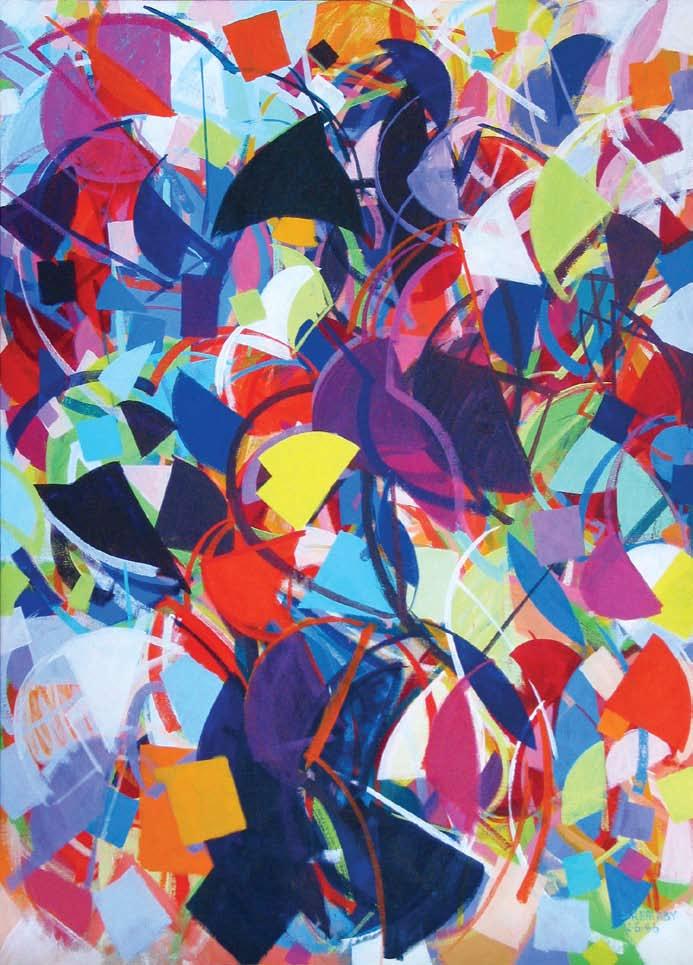

172 173 ةدهانل ناولأاو رون
Light and Color for Nahida, 1986.
اينابش�إا دعب
Acrylic on canvas, 74 x 54’’, 188 x 137 cm. Private collection.
After
Spain, 1986. Acrylic on canvas, 36 x 56’’, 91.5 x 142 cm.

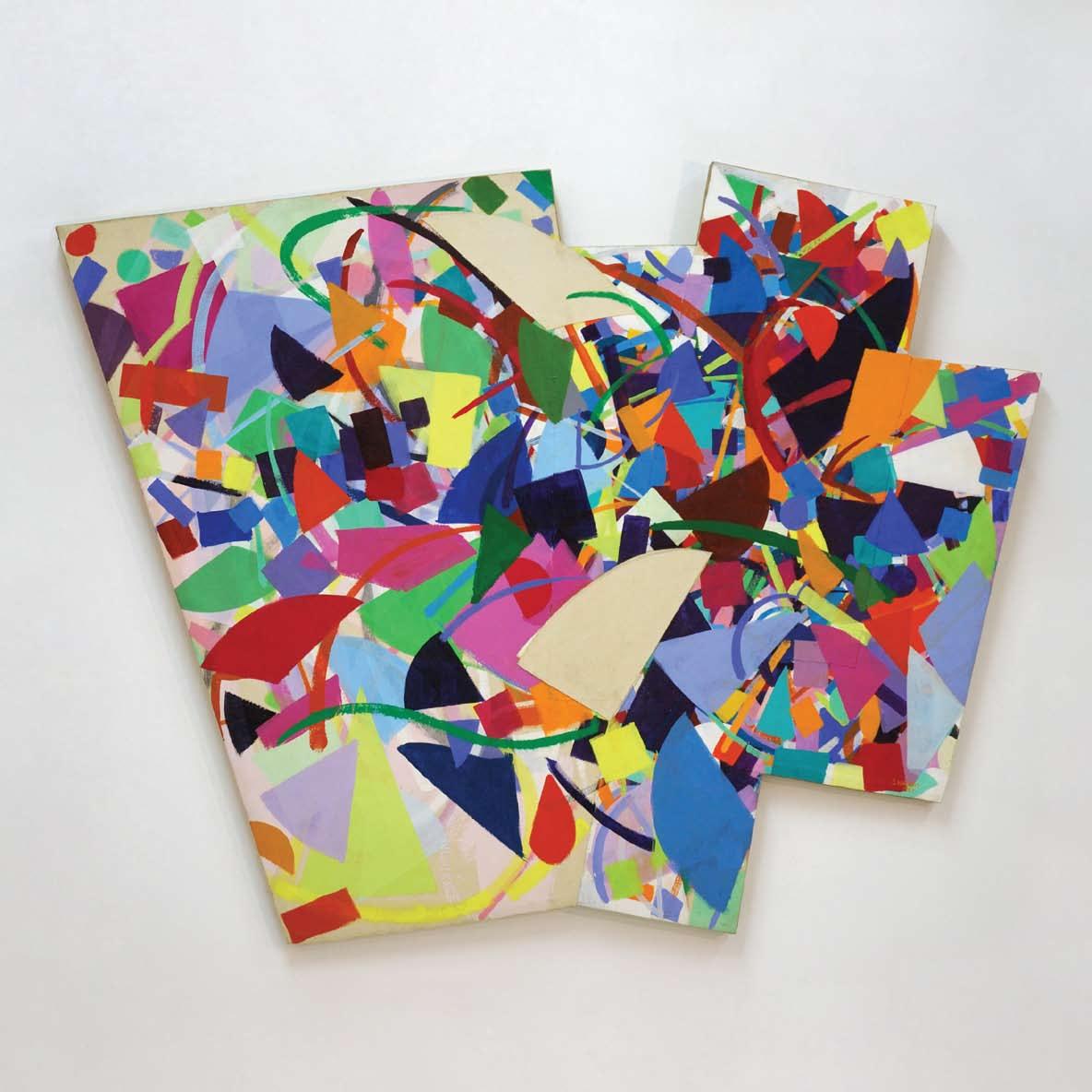
175
بعلم Play Ground, 1986. Acrylic on canvas, 42 x 54’’, 107 x 137 cm.
➤ ةينارود ةقاط Radial Energy, 1986. Acrylic on canvas, 60 x 60’’, 152.5 x 152.5 cm.
"When you look at a rose bush your mind is actively examining it. You note the imperfections and your mind searches for balance. If one side is too big or too heavy you immediately notice the imbalance. If it is excellent your mind finds rest and you feel the urge to make a comment to your companions. If it delights you excessively you will want to possess it and the ideas that it produces. We cannot feel the significance of paintings by recognizing objects, naming them, then telling a story. We do not need to translate them into a written language. Instead we can find their heart by looking at them as we look at a rose bush. The language of painting is a visual language which needs no translation to be understood."
"Quand on regarde un buisson de roses, notre esprit l'examine activement. On remarque les imperfections, et l'esprit recherche l'équilibre. Si un côté est trop gros ou trop lourd on remarque immédiatement le déséquilibre. S'il est excellent, votre esprit trouve le repos et vous sentez le besoin de le faire remarquer à vos compagnons. S'il vous réjouit excessivement, vous voudrez le posséder avec les idées qu'il engendre. On ne peut ressentir la signification d'un tableau en reconnaissant les objets, en les nommant, puis en racontant une histoire. On n'a pas besoin de le traduire en une langue écrite. Au contraire, on peut en trouver le cœur en le regardant comme on regarde un buisson de roses. La langue de la peinture est une langue visuelle qui n'a pas besoin de traduction pour être comprise."
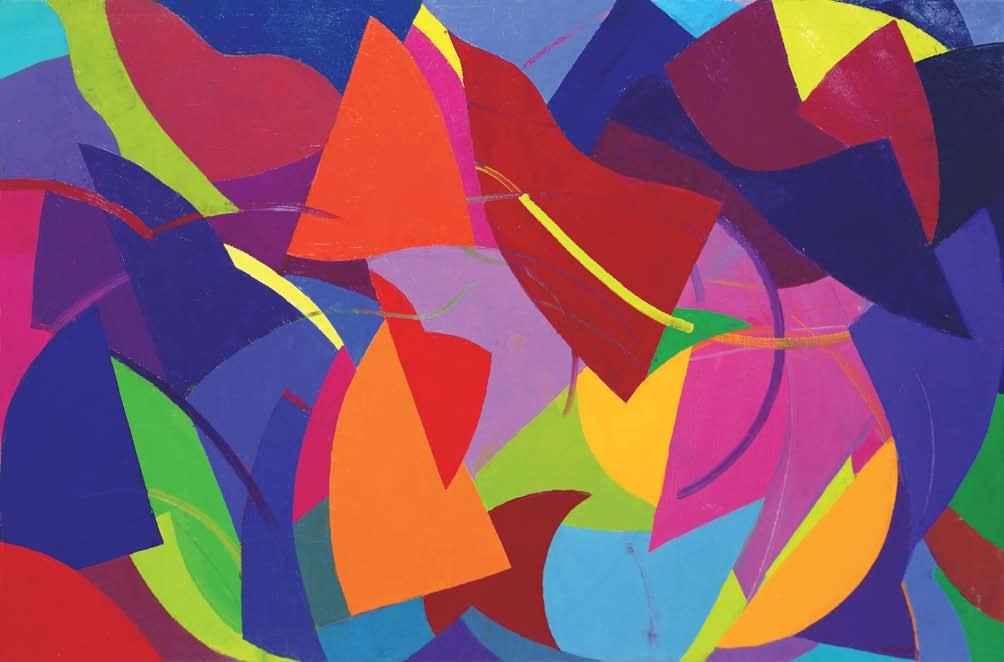
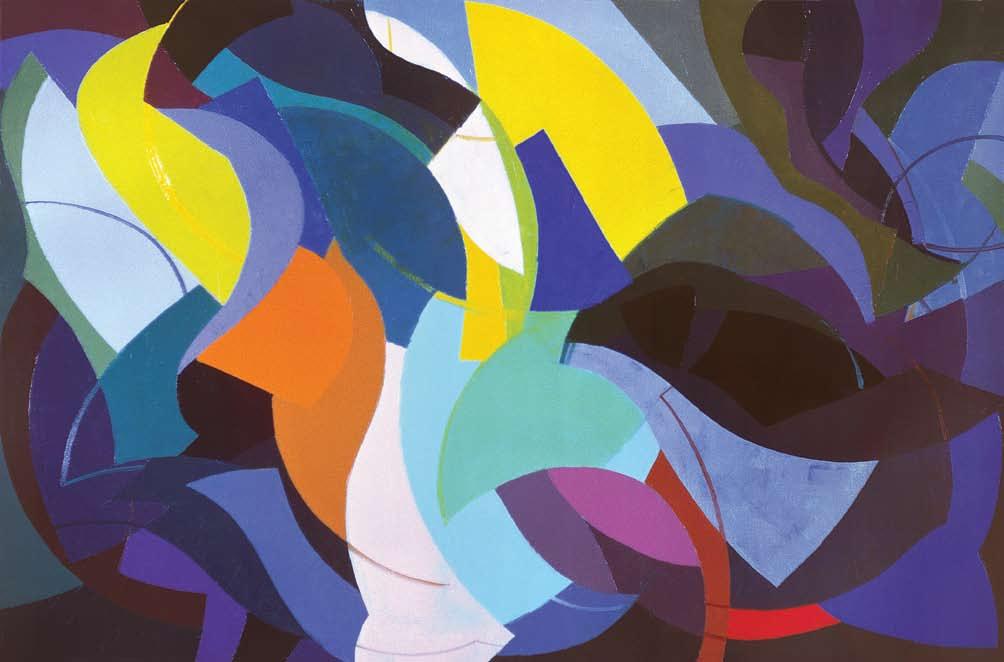
176 177 بركاو ردتش�ا Turn and Grow, 1986. Oil on canvas, 44 x 66’’, 112 x 167.5 cm. Private collection. ةدرو A Rose, 1986. Oil on canvas, 44 x 66’’, 112 x 167.5 cm. Private collection. رعش�تو حاتري كلقع نإاف ةعيدب تناك اذإا .نزاوتلا مدع لالحا في ظحلات كنإ ف دئاز لكش�ب افيثك وأ دئاز لكش�ب ايربك بناولجا دحأ ناك اذإ .نزاوتلا نع كلقع ثحبيو س�قاونلا ظحلات .ةيلاعفب اهش�حفتي كلقع نإ ف درو ةيرجش� لىإ رظنت امدنع " لىإ تاحوللا ةمجرت لىإ ةجاحب ان �ل اننإ .اهنع ةياكح در � مث ،اهتيم �تو ،ءايش�ألا ةفرعم للاخ نم تاحوللا ةيمهأا رعش�ن نأ عيطت �ن ل .اهدلوي يتلا راكفألا كلاتماو هكلاتما في بغرت كنإاف ايرثك دهش�لما كر � اذإ و .ام اقيلعت كباح �أل لوقت نأ لىإا ةجالحاب " .مهفت يك ةمجرت لىإ جاتتح ل ةير �ب ةغل يه مش�رلا ةغل .درولا ةيرجش� لىإ رظنن امك اهيلإا رظنلا للاخ نم تاحوللا بل ىرن نأ عيطت �ن ىرحألاب اننإ .ةبوتكم ةغل
Green Our Fields, 1986. Oil on canvas, 34 x 36’’, 86.5 x 91.5 cm. Private collection.

Honey and Morning, 1986. Oil on canvas, 34 x 36’’, 86.5 x 91.5 cm. Private collection.

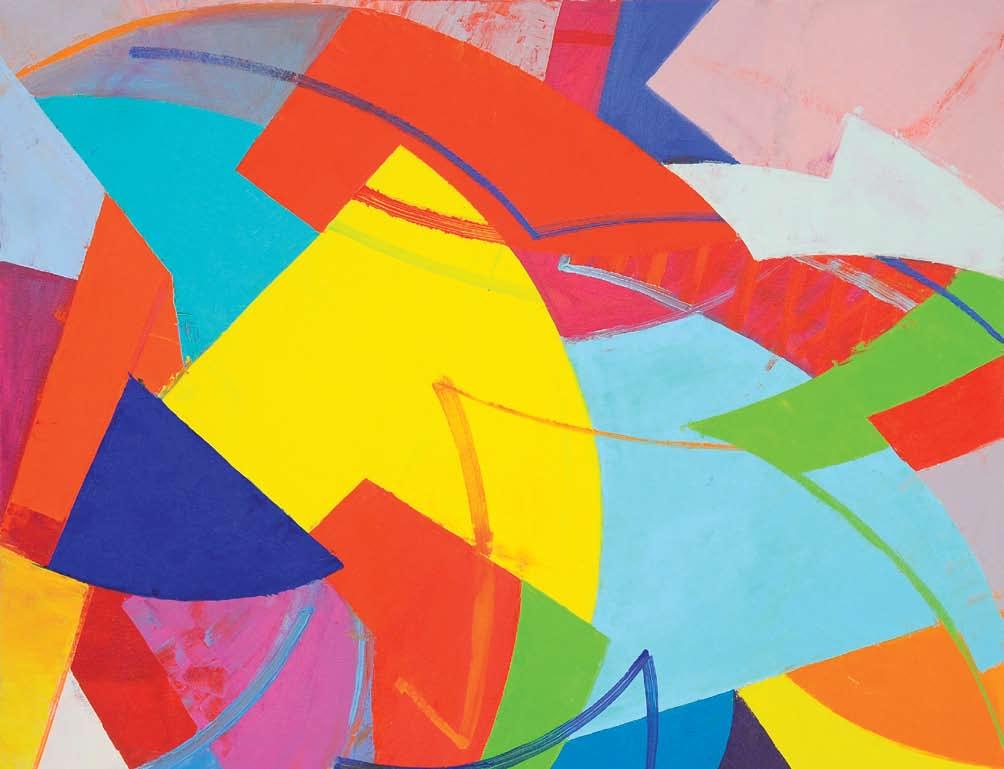
178 179 حجرتم
حابش�و لش�ع
Swing, 1986. Oil on canvas, 38 x 42’’, 96.5 x 106.5 cm.
انجورم رش�خ

180 181
رارمتش�ا Ongoing, 1988. Oil on canvas, 16 x 72’’, 40.5 x 183 cm.
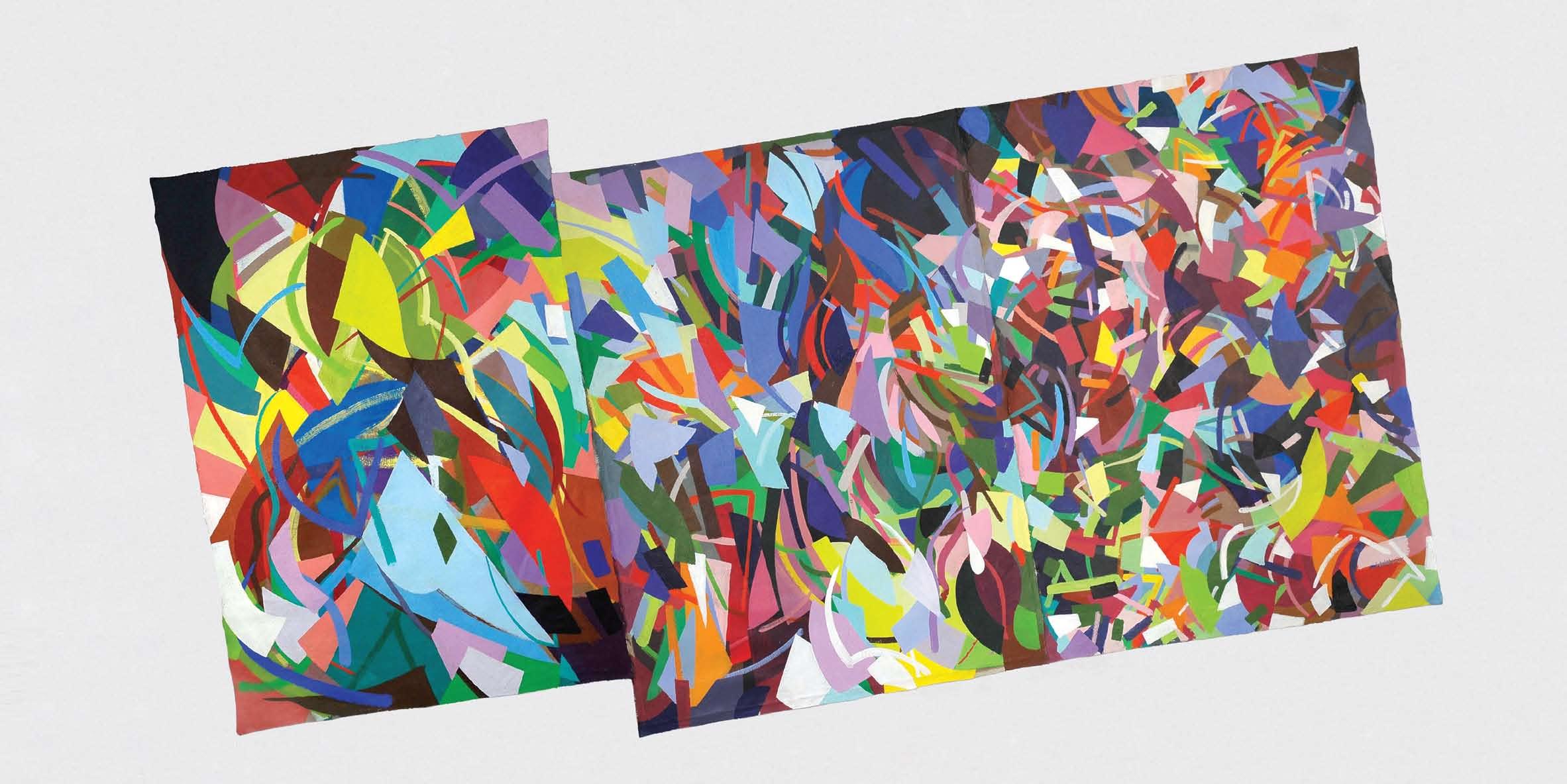
ةقاطلا زكارم Centers of Energy, 1989.
Acrylic on canvas, 60 x 115’’, 152.5 x 292 cm.
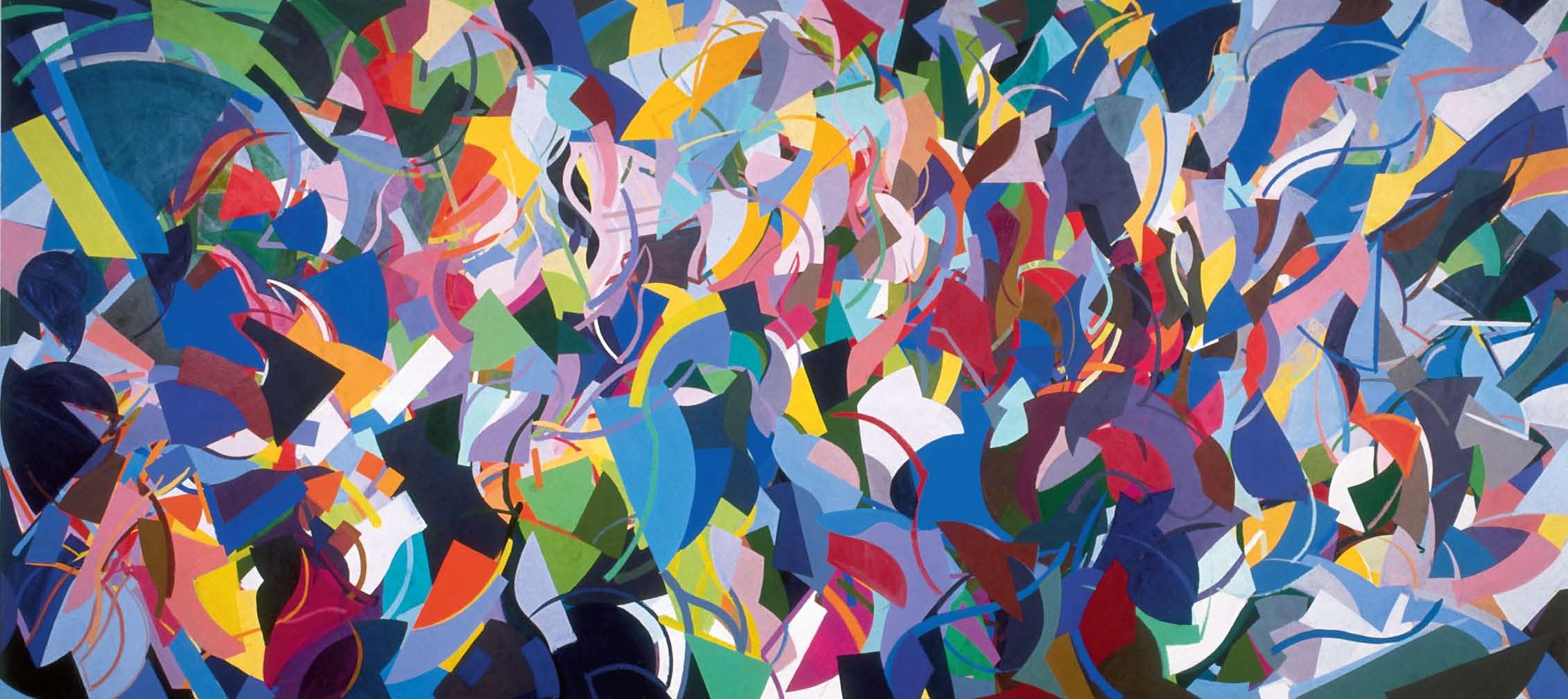
185 بذلجا زكارم
Centers of Attraction, 1989. Acrylic on canvas, 84 x 180’’, 213.5 x 457 cm. Coll. The Arab Bank, New York.
Transitions, 1987. Acrylic on canvas, 52’‘ x 351’’, 132 x 891.5 cm.

“Transitions was yet another examination of the picture plane. I determined that a long painting which demands that the viewer walk along its extension is a good way to eliminate the power of the frame to reduce abstraction to a scene. To fill it, I decided that I would paint the various stages of my recent development in transition from left to right. The pictorial frame was indeed destroyed but the width of the painting is impractical."
"Transitions était une fois de plus une recherche sur l'espace du tableau. J'avais établi qu'une longue toile qui demandait du public qu'il se déplace en suivant sa longueur était une bonne façon d'éliminer le pouvoir du cadre de réduire l'abstraction à une scène. Pour la remplir, j'ai décidé de peindre les diverses étapes de mon développement récent, se déroulant de gauche à droite. Le cadre du tableau était en effet détruit mais la largeur du tableau n'est pas pratique."
186 187 تلوتح
راطإلا ةوق ءاغلإل ةديج ةقيرط يه اهدادتما لوط ىلع يش�يم نأ دهاش�لما نم بلطتت يتلا ةليوطلا ةحوللا نأ تررق انأا .ةحوللا حطش�ل رخآ اناحتما "تلوتح " تناك " نأ يرغ لعفلاب يريو �تلا راطإلا رمد دقو .ينميلا لىإا راش�يلا نم لوحتلاب يرخألا يروطت لحارم فلتمخ مش�رأ نأ تررق ،ةحوللا هذه ءللمو .دهش�لما في ديرجتلا نم ليلقتلل " .يلمع يرغ ناك ةحوللا س�رع
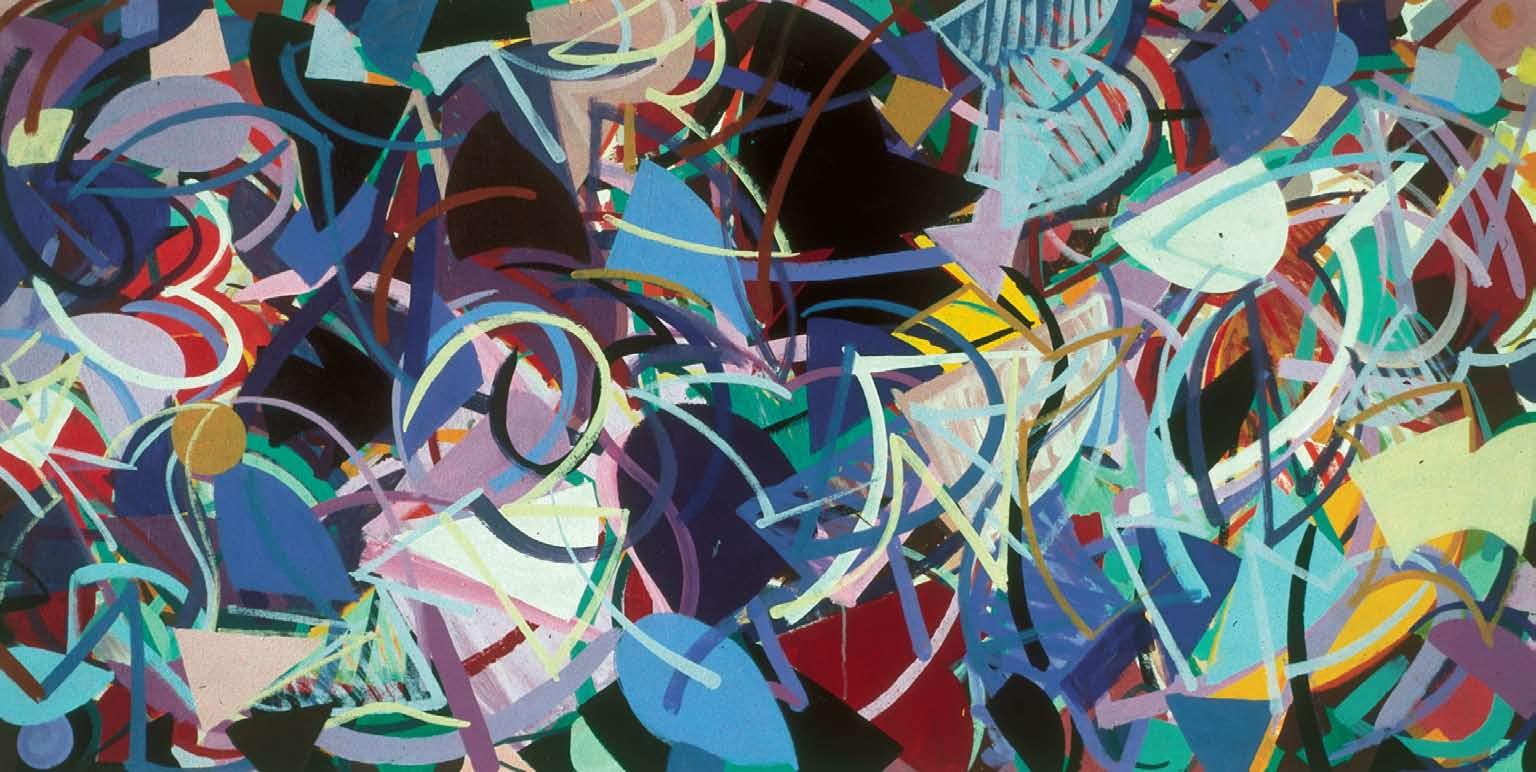
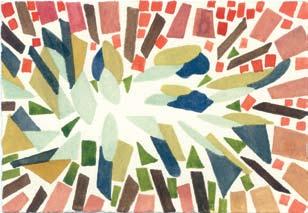
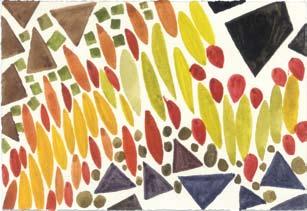
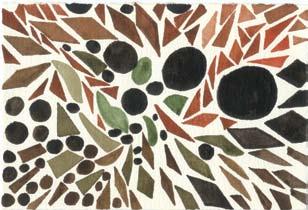
188 189
للاخ رورم Cycling Through, 1992. Watercolor, 4 x 5 ½’’, 10 x 14 cm.
انح لىإ For John, 1990. Acrylic on canvas, 37 x 72’’, 92 x 183 cm. Private collection.
بكوم Parade, 1992. Watercolor, 4 x 5 ½’’, 10 x 14 cm.
عش�وت ،باذنجا Expansion, Attraction, 1992. Watercolor, 4 x 5.5’’, 10 x 14 cm.
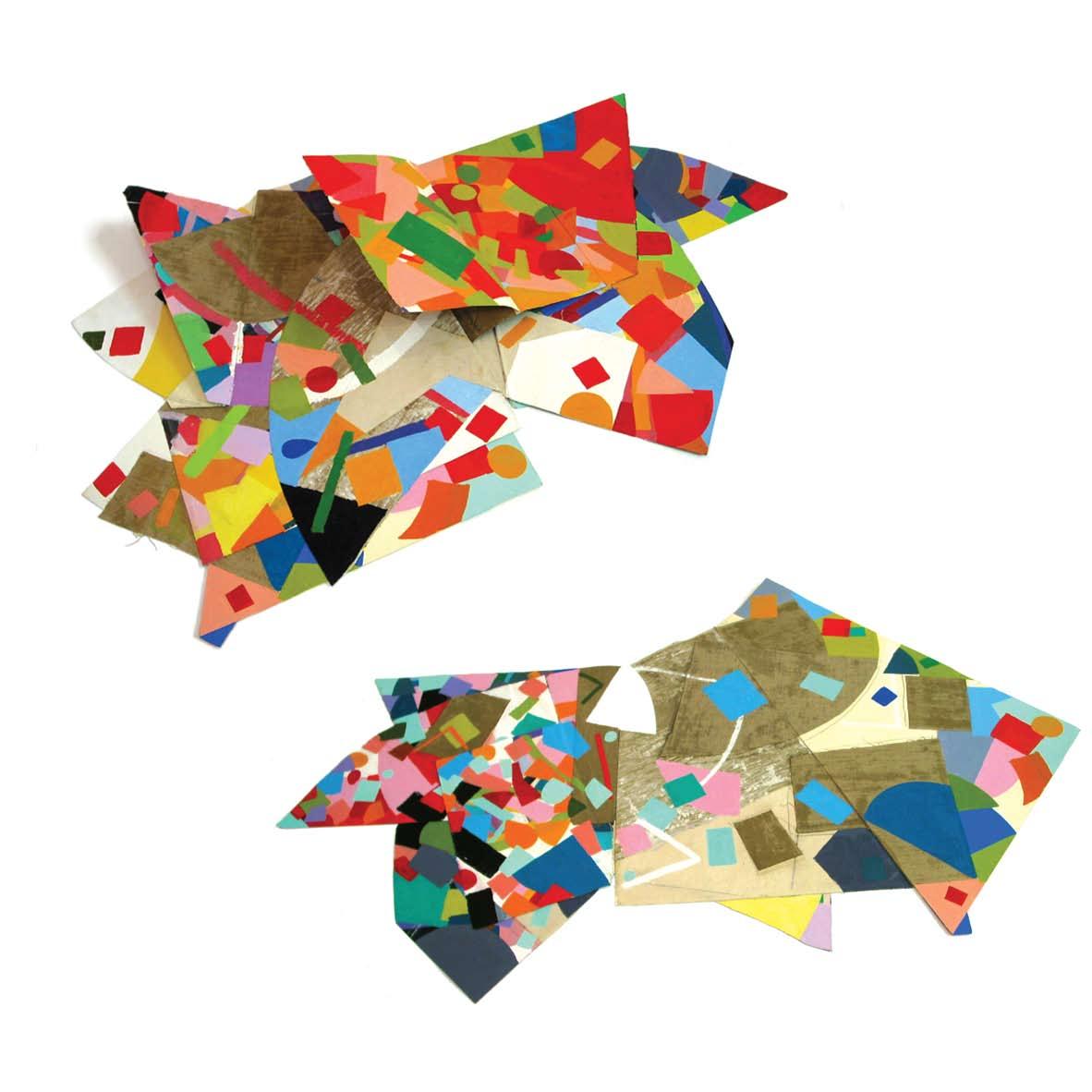

ةيلماع ةش�افتنإ
Four views of the three dimensional book World Wide Intifadah, 1989.
Acrylic on paper and canvas, 59 x 33 x 26’’, 150 x 84 x 66 cm.
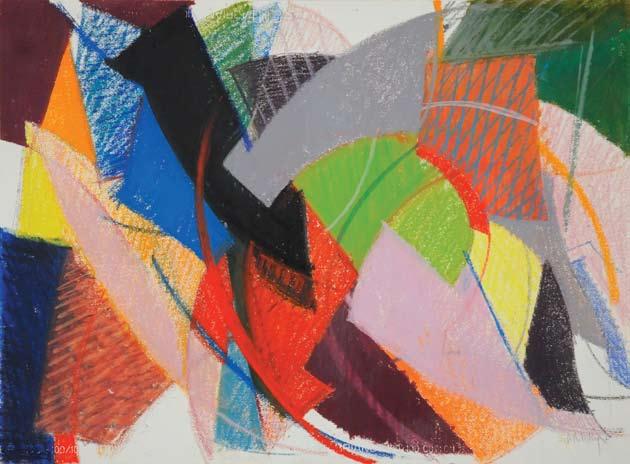
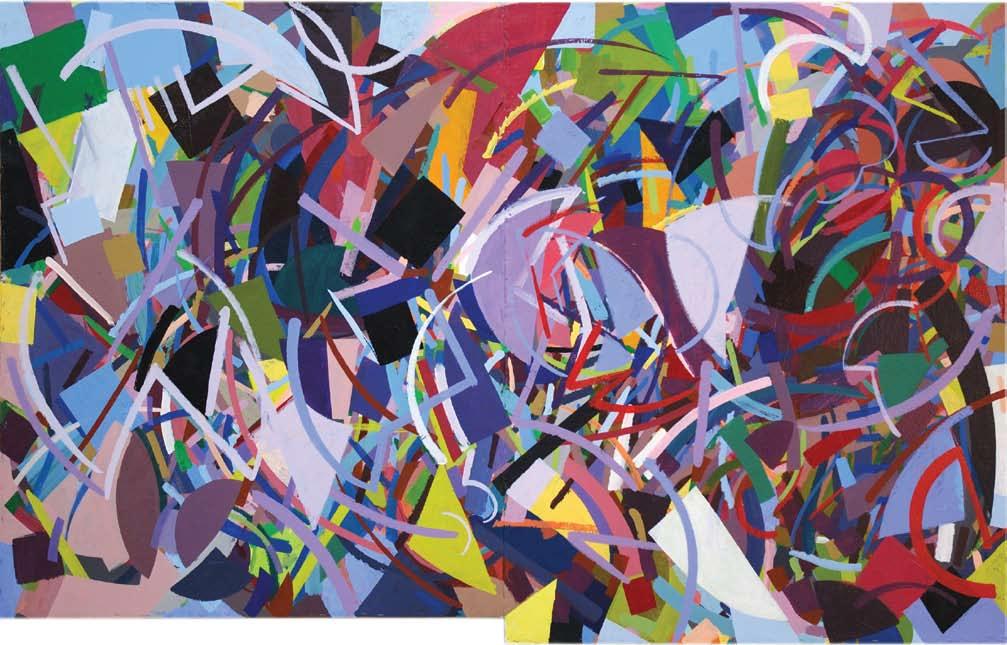

192 193 ةقاطلا نم تاقش�ر نم اودلو نيذللا
ةيلازلز طوطخو تاقرط
بذلجا زكارم نم
Born from Bursts of Energy, 1991. Gouche on paper, 9 x 12’’, 23 x 30.5 cm.
Highways and Fault Lines, 1991. Acrylic on canvas, 48 x 75’’, 122 x 190.5 cm.
From Centers of Attraction, 1988.
Encaustic on paper, 22 x 30’’, 56 x 76 cm.
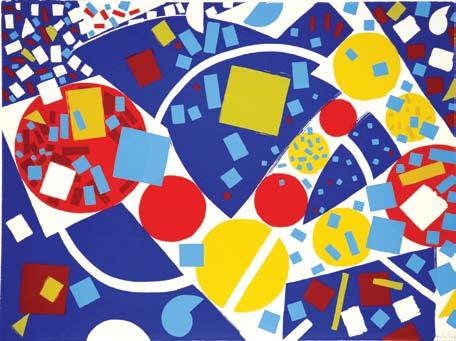
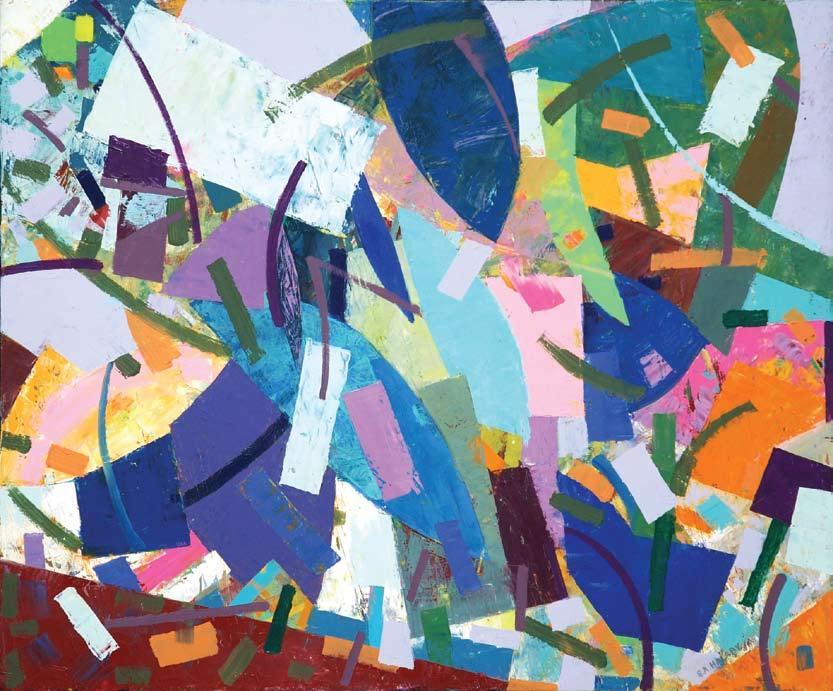
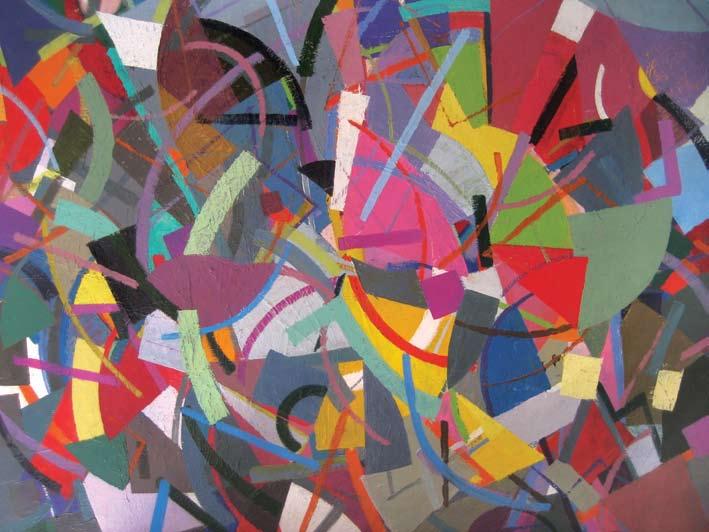
194 195
ةديدج ةذفان A New Window, 1991. Oil on canvas, 32 ¼ x 39’’, 82 x 99 cm. ةماش�أا Osama, 1993.
Oil on canvas, 26 x 48’’, 66 x 122 cm. Private collection.
ءانيم Harbor, 1992. Seriscreen, 20 x 30’’, 51 x 76 cm.
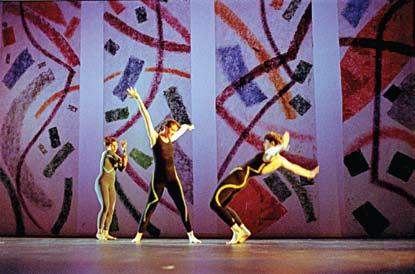

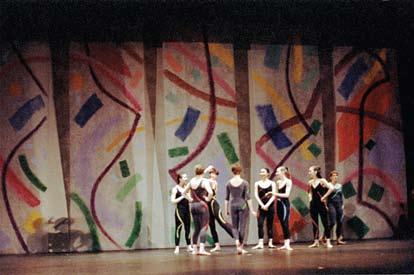
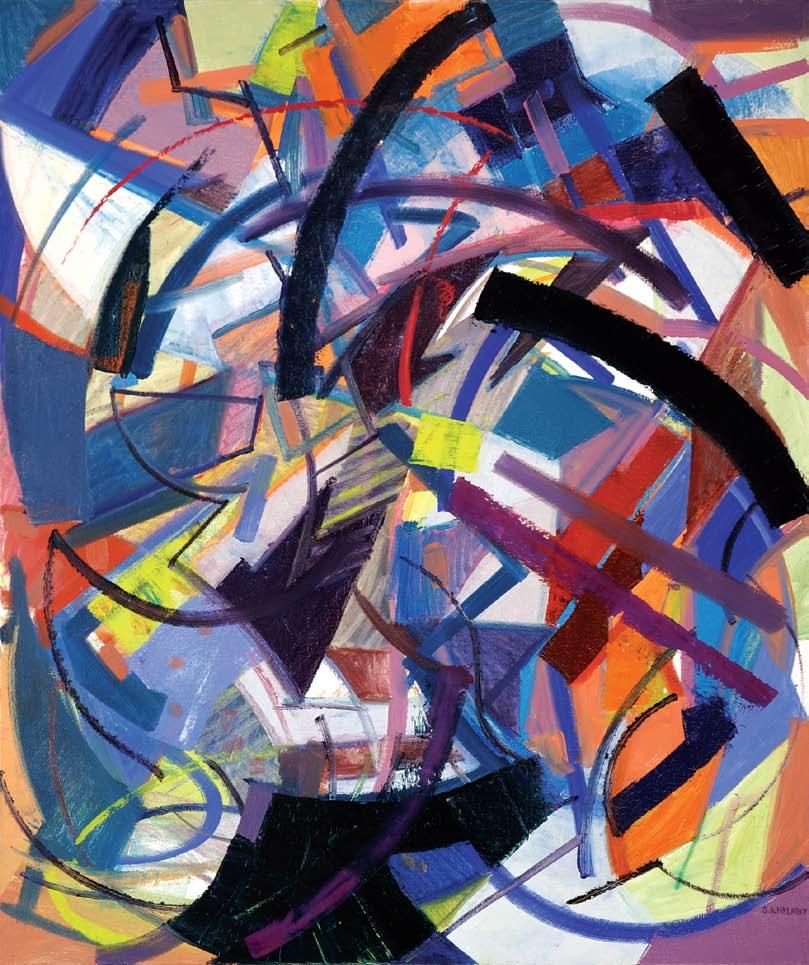
196 197 " يكلاورباج
"
Jabberwalkie, 1994. Back drop and costumes.
ةيبيعكت A Cubist One, 1991. Oil on canvas, 50 x 30’’, 127 x 76 cm.
Kinetic Painting: 1983-1995 Peinture Cinétique: 1983-1995
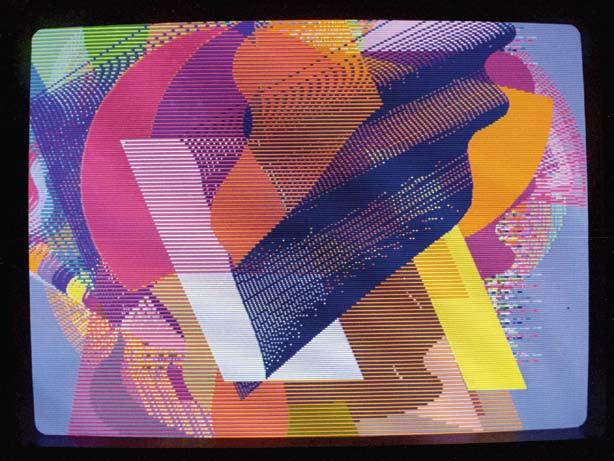
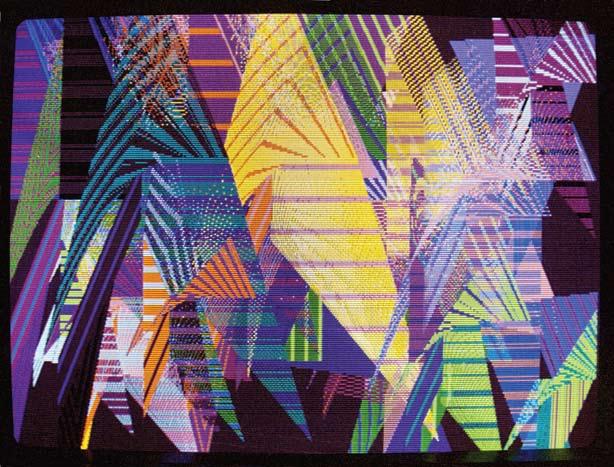
While developing her Growing Shapes series, Halaby became interested in the potential of using a computer as a means of painting. In 1986 she purchased an Amiga and began teaching herself computer programming so as to independently discover the nature of the new technology. As an artist, she has long felt that her intentions were to “expand the language of pictures,” which follows “the principle of the avant-garde and modern abstraction in the twentieth century.” Essential to this is experimentation with available media. The breakthroughs made in the Russian movements she admires, for example, were developed not only amidst political revolution but during breakthroughs in science, namely in the immediate period of discovery that proceeded Einstein’s theories of special relativity (1905) and general relativity (1907-1915), which together are otherwise known as his “theory of relativity.” Halaby contends that technology has transformed our “sense of space” and our “strategies of looking.”
We begin by learning its technical basis so that we can discover what forms are possible based on these techniques and what new content these forms might convey. If we succeed, then our discoveries permeate all pictorial uses and become beneficial to our practical needs in production. Therefore, the artistic use of form suitable to a new technique is a progressive choice. Techniques and media emanate out of our historical, social and economic development (Halaby, Technology, Abstraction and Kinetic Painting, 1993).
Using computer programming, the artist produced kinetic paintings that allowed her to paint “the way things sound in addition to the way they move.” To create a kinetic work she would begin from intuition, using a few program elements while testing their appearance on the screen, much like beginning with a few brushstrokes on a canvas. She would then continue the process of programming to the sounds of an audio component, as with the accompaniment of live musicians. This allowed shapes to grow while movement is seen as process occurs. Often
Tout en développant sa série de "Formes en Croissance", Halaby s'intéresse au potentiel de l'ordinateur comme outil de peinture. En 1986 elle achète un Amiga et commence à apprendre la programmation informatique en autodidacte de façon à découvrir indépendamment la nature de cette nouvelle technologie. En tant qu'artiste, elle sent depuis longtemps que ses intentions sont de "développer le langage pictural", ce qui suit "le principe de l'avant-garde et de l'abstraction moderne au vingtième siècle". La recherche utilisant les techniques actuelles est essentielle pour réaliser cet objectif. Les découvertes faites par les mouvements russes qu'elle admire, par exemple, furent développées non seulement au sein d'une révolution politique, mais aussi parallèlement à des découvertes scientifiques, plus particulièrement au cours de la période de découvertes suivant immédiatement les théories d'Einstein sur la relativité spéciale (1905) et la relativité générale (19071915), que l'on connaît souvent ensemble sous le nom de "théorie de la relativité". Halaby pense que la technologie a transformé notre "sens de l'espace" et nos "stratégies d'observation".
On commence par apprendre ses bases techniques afin de découvrir quelles formes sont possibles fondées sur ces techniques et quel nouveau contenu ces formes vont pouvoir communiquer. Si nous réussissons, alors nos découvertes s'infiltrent dans toutes les utilisations picturales et deviennent bénéfiques à nos besoins pratiques en production. Donc, l'utilisation artistique de la forme appropriée à une nouvelle technique est un choix progressif. Les techniques et les médias émanent de notre développement historique, social et économique.
(Halaby, Technology, Abstraction and Kinetic Painting, 1993)
Grâce à l'utilisation de la programmation informatique, l'artiste produit des tableaux cinétiques qui lui permettent de peindre "la façon dont les choses sonnent ainsi que la façon dont elles bougent." Pour créer une œuvre cinétique, elle commence par une intuition, en utilisant quelques éléments de programme tout en testant leur apparence sur l'écran, tout à fait comme les premiers coups de pinceau sur une toile. Elle continue alors le processus de programmation au son d'une composante
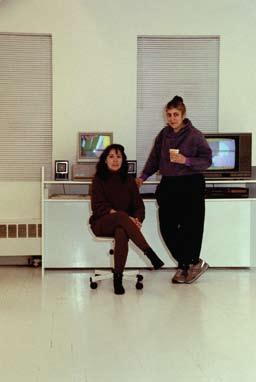
198 199
"
واهئن " Niihau, 1986. Computer program.
ييرلاغ ةبحاش� "زدرول س�وتناش� اترام " و ةيما � كرويوين في "ناش�وت-ناش�وت "
راظنم Kaleidoscope, 1986. Computer program.
With dealer Marta Santos-Lourdes at Tossan-Tossan Gallery in New York, 1988.
produced before an audience, her kinetic works show the evolution of shapes as they “fluctuate, stretch, compress, disappear, reappear, fade and make sounds,” resulting in a painting that is captured in real time and recreates specific sensations or “centers of attraction.”

This is visible in “Brass Women,” (page 201) which is dedicated to Black and Latino women who “speak with assertiveness against oppression.” The kinetic painting is performed with percussionists and is inspired by “The people’s streets of New York, Canal street with its rhythms, 14th street with its working class shoppers, and paths of political demonstrations [which] all come together to create the motion of the piece” (Samia Halaby, Fine Arts Publishing Beirut, 2006).
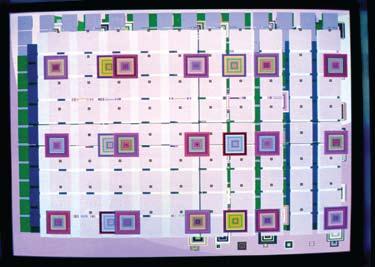
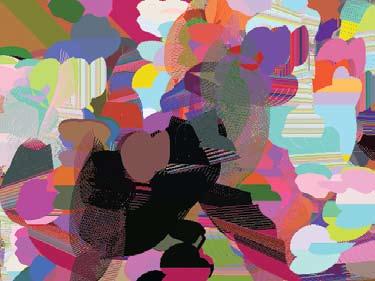

(Continued page 204)
audio, ainsi que de l'accompagnement de musiciens live. Ceci permet aux formes de croître; le mouvement est alors vu comme un processus en cours. Souvent produites en public, ses œuvres cinétiques montrent l'évolution des formes qui "fluctuent, s'étendent, se compriment, disparaissent, réapparaissent, s'estompent, et produisent des sons," ce qui crée un tableau saisi en temps réel et recrée des sensations spécifiques ou "centres d'attraction".

On le voit dans "Brass Women [Femmes de Cuivre]", une œuvre dédicacée aux femmes latinos et noires qui "s'expriment avec assurance contre l'oppression". Le tableau cinétique est accompagné de percussionnistes et s'inspire des "rues populaires de New York, Canal Street et ses rythmes, la 14ème rue et ses gens des classes ouvrières qui font leurs courses, et les chemins suivis par les manifestations politiques [qui] convergent tous pour créer le mouvement de l'œuvre". (Samia Halaby Fine Arts Publishing Beirut, 2006).

(Suite page 204)

200 201 يص�اتأ ىنم ييرلاغ في يكرلحا مش�رلا ةعوممج س�رع
Halaby performing with the Kinetic Painting Group at Mona Atassi Gallery in Damascus, 1997.
رئاود
افاي
1 تايش�احن
2 تاي �احن
1
2 تاعاقيإ
Circles, 1993. Computer program.
Yafa, 1993. Computer program.
ءا �ن Brass Women I, 1989. Computer program.
ءاش�ن
Brass Women II, 1989. Computer program.
تاعاقيإ Rhythms I, 1992. Computer program.
Rhythms II, 1992. Computer program.



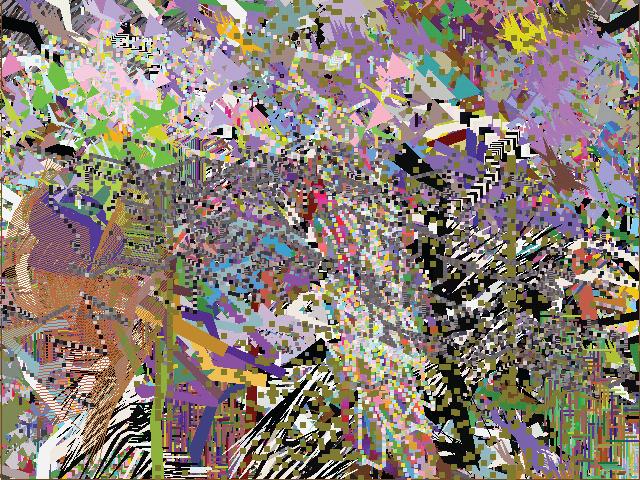
202 203 ليللا
نياباي
رطم
عرفت
رطم Night Rain, 1991. Computer program.
فيرخ
Japan Autumn, 1994. Computer program.
Rain, 1991. Computer program.
Branching, 1995. Computer program.
Painterly Abstraction 1991-2000
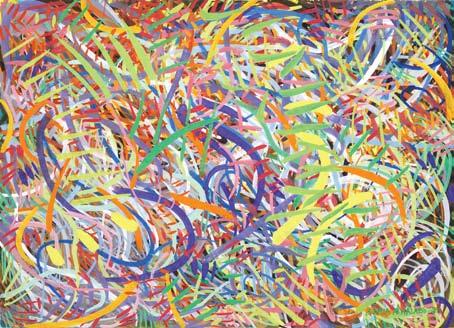

In the early 1990s, Halaby slowly moved away from the use of obvious geometric forms such as squares and triangles or “growing shapes.” Feeling as though she had no direction, she began to depart from shape in addition to abandoning gravity, shading and perspective. This was no easy task. The first part of the decade was spent amidst a number of trials, many of which she felt failed in two ways: the application of brush marks, in which she was still making shapes, and in the creation of light and dark areas, which gave the paintings a “simplified impressionist” appearance.
Setting aside her focus of subverting the rectangle, she set out to create paintings made with small brushwork. By the late 1990s she was submerged in “painterly abstraction” in which the influence of Seurat and Monet is slightly visible but the principles of modern abstraction are in place. Her canvases thus became driven by the spontaneous placement of brushstrokes and color.
If things are complex or are intermittent in rhythm, we tend to think of them as disorganized. We become frustrated if we can’t find the mental tools, the visual language, with which to understand what we are looking at. However, if things possess simple geometry, we comprehend them easily and thus think of them as ordered. There is symmetry in what sometimes seems disorganized. The motion of things, their coming and going, their temporary partnerships and separations, their inhalations and exhalations, and their complex organization is what I intuitively seek in these paintings. (Samia Halaby Fine Arts Publishing Beirut, 2006).
Halaby would continue to take inspiration from the sights and sounds of New York, more specifically of the commercial district of Chinatown near her home. This period of her work began with the series “Dance on Canal,” (page 212) which had its basis in photomontages of images that she had taken while on Chinatown’s main artery. The merchants and
L'Abstraction Texturée 1991-2000
Au début des années 90, Halaby s'éloigne peu à peu de l'utilisation de formes géométriques évidentes telles que le carré, le triangle ou les "formes en croissance". Sans direction, elle commence à abandonner la forme en plus de la gravité, des ombres et de la perspective. Ce n'est pas une tâche aisée. Elle passe la première partie de la décennie à faire un certain nombre d'essais, dont beaucoup lui semblent échouer dans deux sens: l'application de traits de pinceau, avec laquelle elle construit toujours des formes, et la création de zones lumineuses et sombres, qui donnent aux tableaux un "aspect impressionniste" simplifié.
Mise à part sa focalisation sur la subversion du rectangle, elle commence à créer des toiles composées de petites touches de pinceau. A la fin des années 90, elle se trouve submergée dans "l'abstraction texturée" dans laquelle l'influence de Seurat et Monet est tout juste visible mais les principes de l'abstraction moderne sont en place. Ses toiles sont désormais guidées par des touches spontanées de pinceau et de couleur.
Si les choses sont complexes ou d'un rythme intermittent, on a tendance à penser qu'elles sont désorganisées. On devient frustré si l'on ne peut trouver les outils mentaux, le langage visuel avec lesquels comprendre ce que l'on regarde. En même temps, si les choses possèdent une géométrie simple, on les comprend facilement et on pense donc qu'elles sont ordonnées. Mais il peut y avoir de la symétrie dans ce que l'on perçoit comme désorganisé. Le mouvement des choses, leurs allers et retours, leurs associations et séparations temporaires, leurs inhalations et exhalations, et leur organisation complexe, voilà ce que je recherche intuitivement dans ces toiles. (Samia Halaby, Fine Arts Publishing Beirut, 2006)
Halaby continue alors de s'inspirer des vues et des sons de New York, et plus particulièrement du district commercial de Chinatown près de là où elle réside. Cette période de son œuvre commence avec la série "Dance on Canal [Danse sur le Canal]" qui trouve son origine dans des photomontages d'images prises dans l'artère principale de Chinatown. Les marchands et vendeurs avec leurs étalages élaborés de produits
204 205
" يتيب " ـل عيبرلا ةدوع
Spring Time for Betty, 1991. Acrylic on canvas, 37 x 70 ½’’, 94 x 71 cm. Private Collection.
" كولوب " بحأا I Like Pollock, 1991. Gouache on paper, 26 x 36’’ 66 x 91.5 cm.
vendors with their intricate displays of goods mix brilliantly with passing shoppers and tourists. The crowded street, with its variable range of colors and steady stream of commotion, delighted the artist and made its way into her compositions. “Dance on Canal” is distinguished by paintings that are dominated by layered and vivacious brushwork and an effervescent palette.
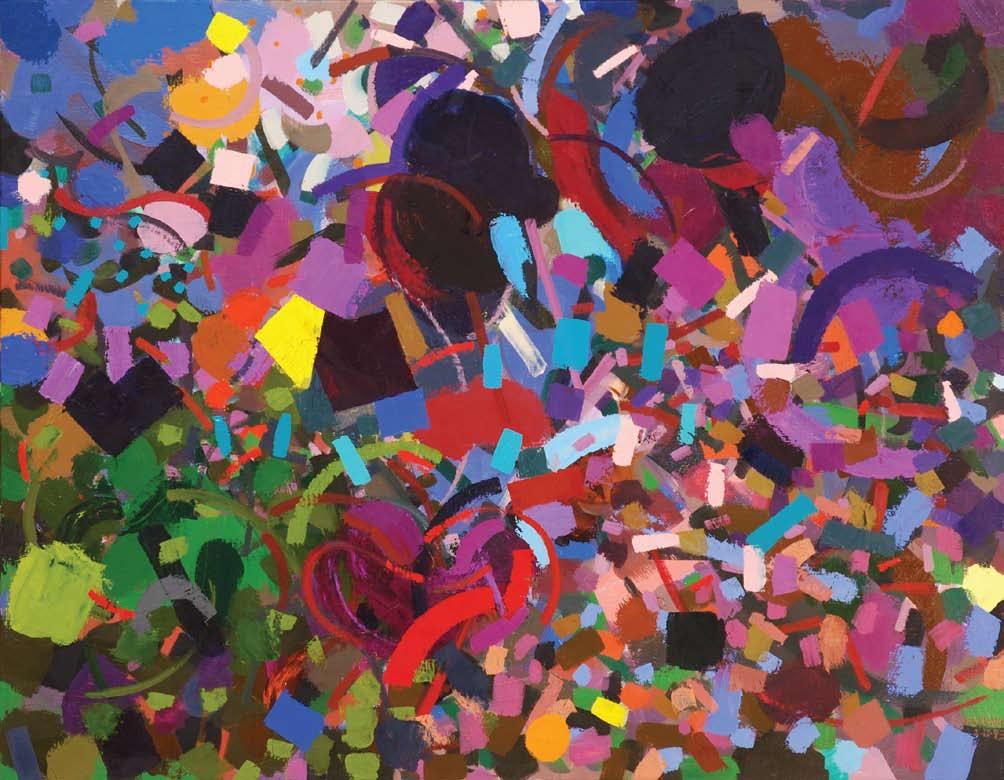
For the artist, the works that resulted from these experiments visually interpret “the rhythm of soft things in nature. These are organizations composed of large numbers of smaller elements such as crowds of people, foliage, wave motion in water or plants, herds, flocks, and other such things” (Samia Halaby, Fine Arts Publishing Beirut, 2006). The presence of these grouped components is located in the patterns of brushstrokes that are detected through the eye then organized by the mind as recognizable shapes. It is here that Halaby finds wonder in the “complex geometry” of such markings, which spark associations with elements that can be found in our surroundings.

(Continued page 244)
se mélangent spectaculairement avec des gens venus faire leurs courses et des touristes. La rue encombrée, avec son éventail varié de couleurs, son flot constant de gens et son agitation réjouit l'artiste et se fraye un chemin dans ses toiles. "Dance on Canal" se distingue par des tableaux où dominent des couches de coups de pinceau vigoureux et une gamme de couleurs en effervescence.
Selon l'artiste, les œuvres qui résultent de ces recherches interprètent visuellement "le rythme des choses douces que l'on trouve dans la nature". Ce sont des agencements composés de grands nombres d'éléments plus petits tels que des foules, du feuillage, le mouvement des vagues dans l'eau ou des plantes, des troupeaux, et d'autres choses similaires." (Samia Halaby Fine Arts Publishing Beirut, 2006). La présence de ces groupes d'éléments surgit des motifs de coups de pinceau que les yeux détectent mais que l'esprit organise en formes reconnaissables. Halaby s'émerveille de la "géométrie complexe" de certaines traces, qui éveillent certaines associations avec des éléments de notre environnement.
(Suite page 244)
206 207
ناروف
ةبلقتم
ةكرح Variable Motion, 1993. Oil on canvas, 36 x 46’’, 91.5 x 117 cm. Private collection.
Effervescence, 1992. Gouache on paper, 22 x 30’’, 56 x 76 cm.
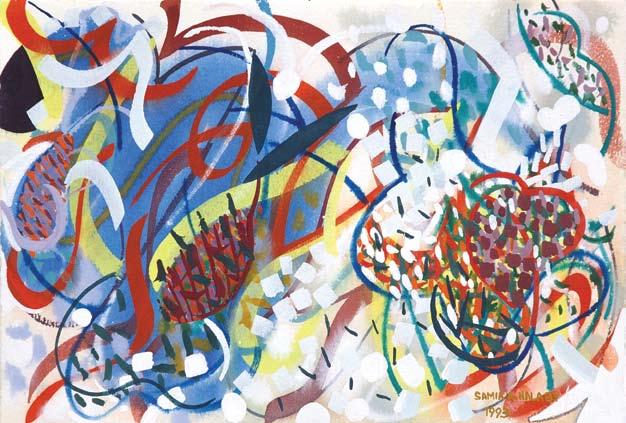
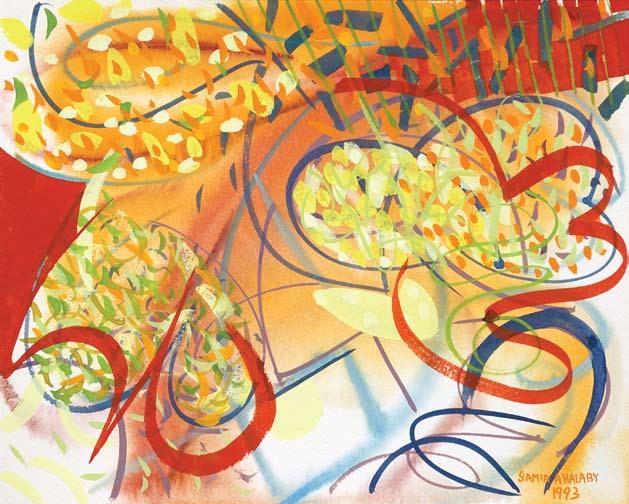
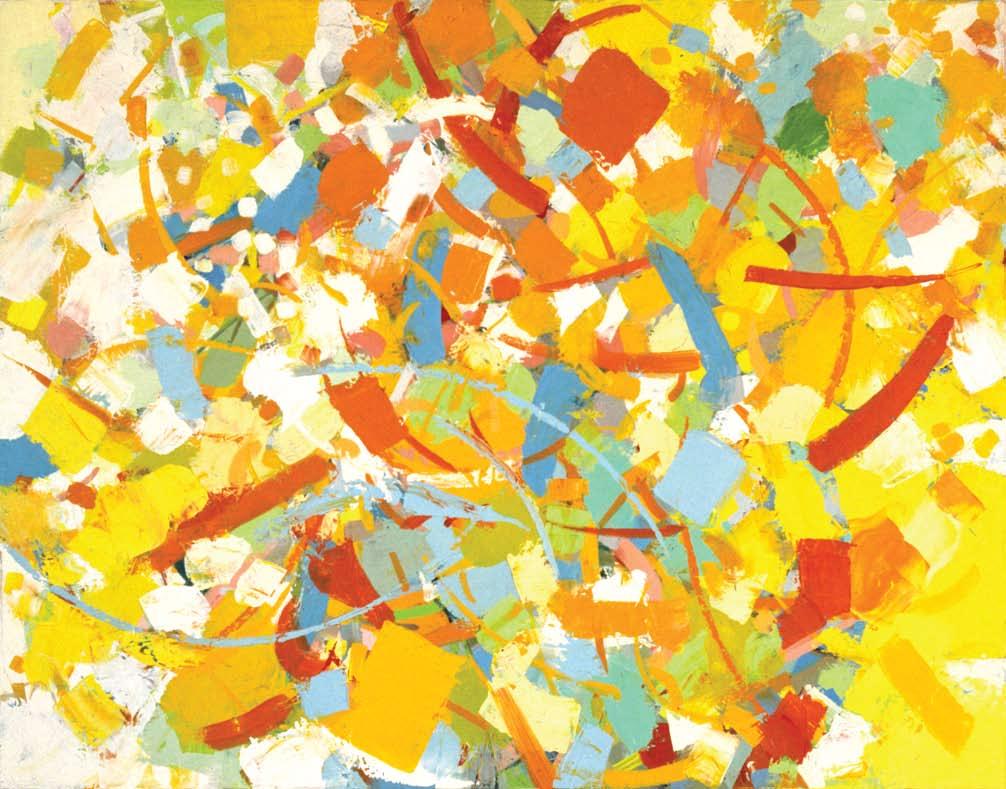
208 209 حاب �لا ل �ع
" نازوش� " ـل لياقتبرلا
رطلما
Morning Honey, 1992. Oil on canvas 36 x 46’’, 91.5 x 117 cm. Private collection.
Oranges for Susanne, 1993. Gouache on paper, 11 x 9’’, 28 x 23 cm.
راث
Rain Graffiti, 1993. Gouache on paper, 7 ½ x 11’’, 19 x 28 cm.
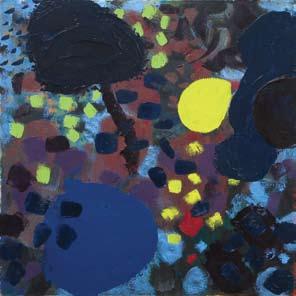
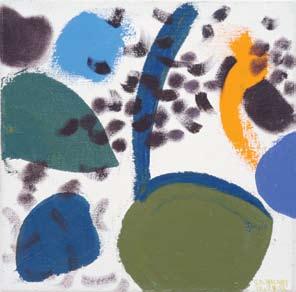
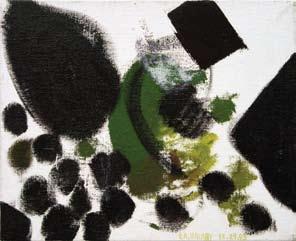
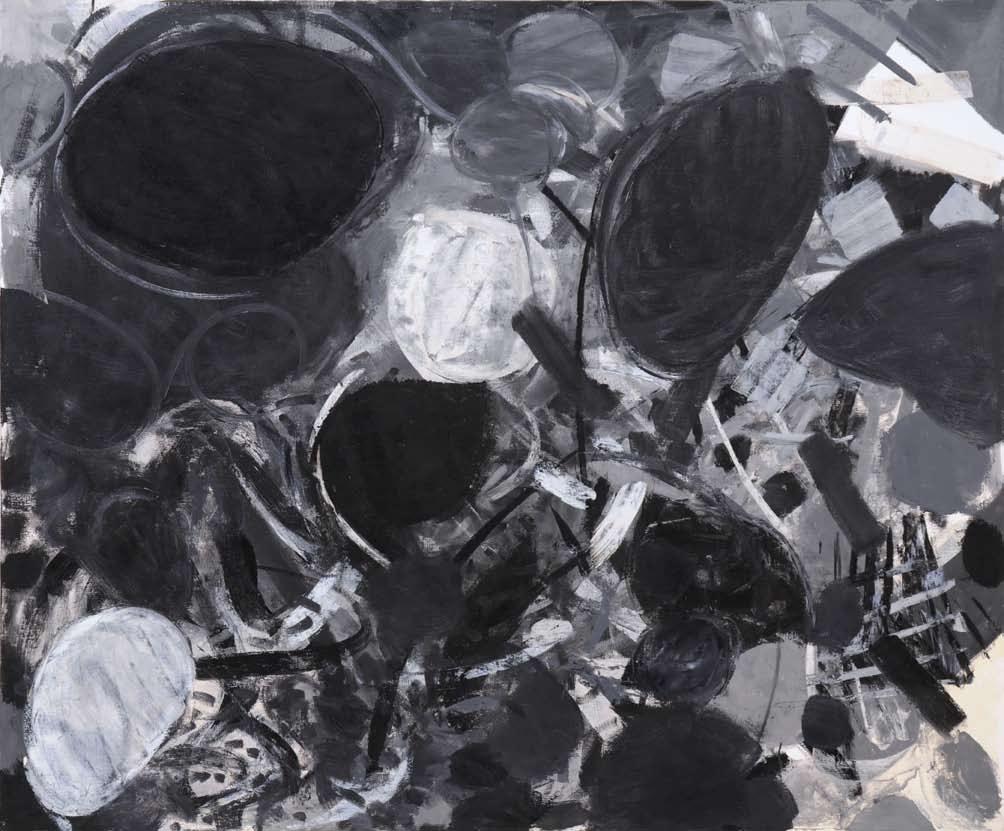
210 211 س�يبأ
ي يل قرزأا ىلع يرغش� رفش�أا
و دوش�أا
Black and White, 1994. Oil on canvas, 48 x 58’’, 122 x 147.5 cm.
Small Yellow on Night Blue, 1993.
Oil on masonite, 11 ½ x 11 ½’’, 29 x 29 cm.
عقب Spots, 1993.
Oil on canvas, 9 x 11’’, 23 x 28 cm.
يجانل ةحافت Apple for Naji, 1993.
Oil on canvas, 12 x 12’’, 30.5 x 30.5 cm.
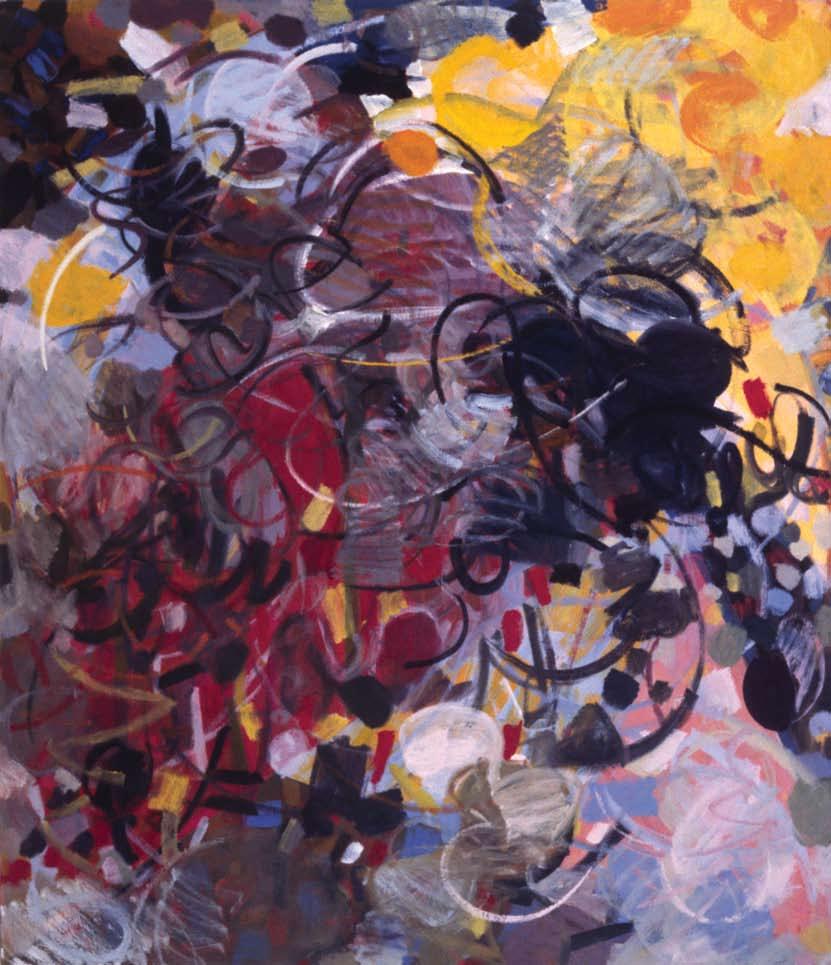
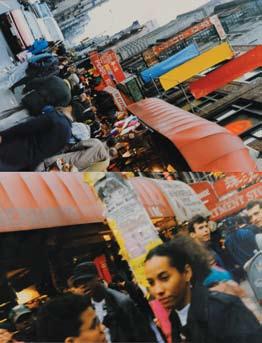
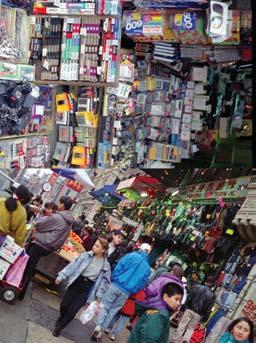
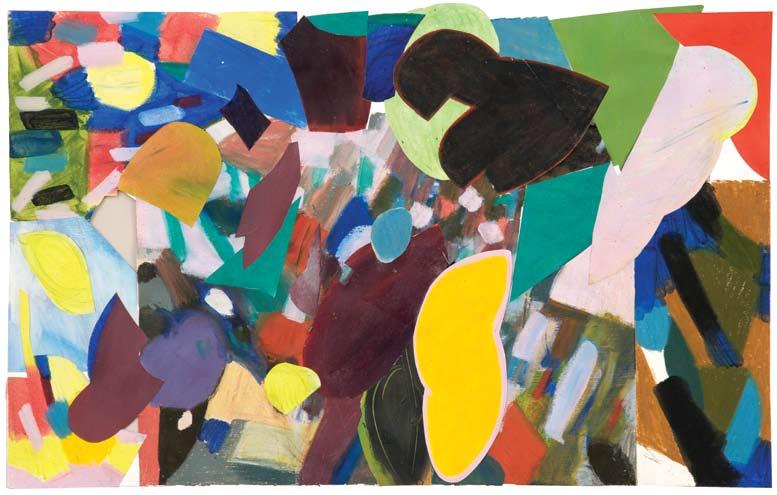
212 213 لىوألا،" لانك " عراش� ةش�قر
Dance
1993. Encaustic
99
"لانك " عراش� ةش�قر Dance
Canal, 1995.
65’’,
165
Private collection. ةثلاثلا ، " لانك " عراش� ةش�قر Dance on Canal Three, 1993. Photomontage. ةيرهزلا ةلظلما ، " لانك " عراش� ةش�قر Dance on Canal: Pink Awning, 1993. Photomontage.
First
on Canal,
collage, 25 x 39’’, 63.5 x
cm.
on
Oil on canvas, 75 x
190.5 x
cm.
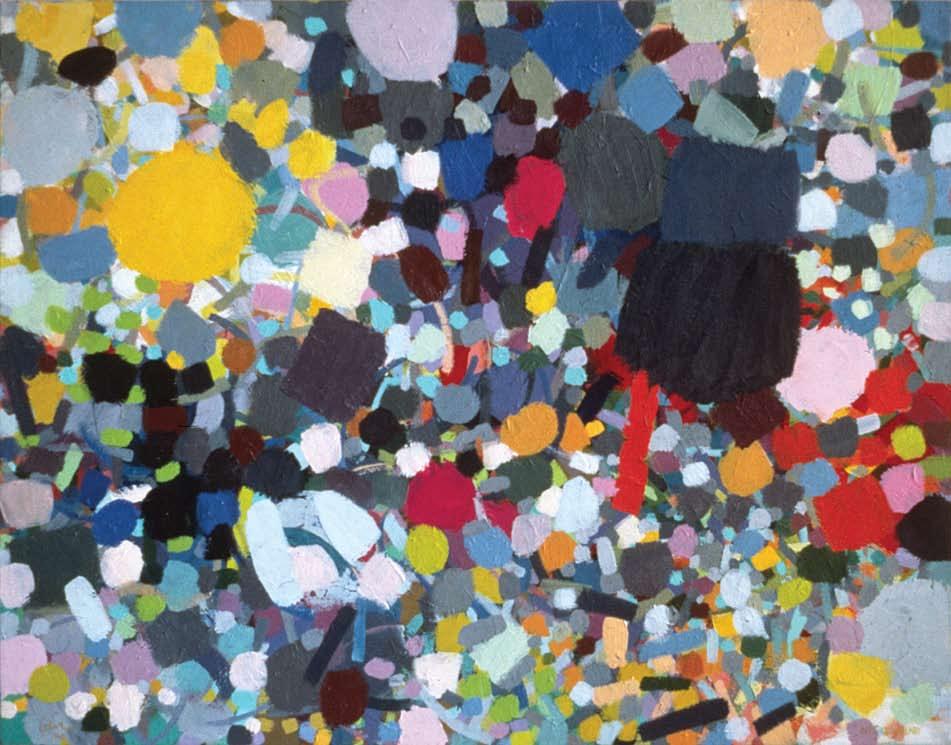
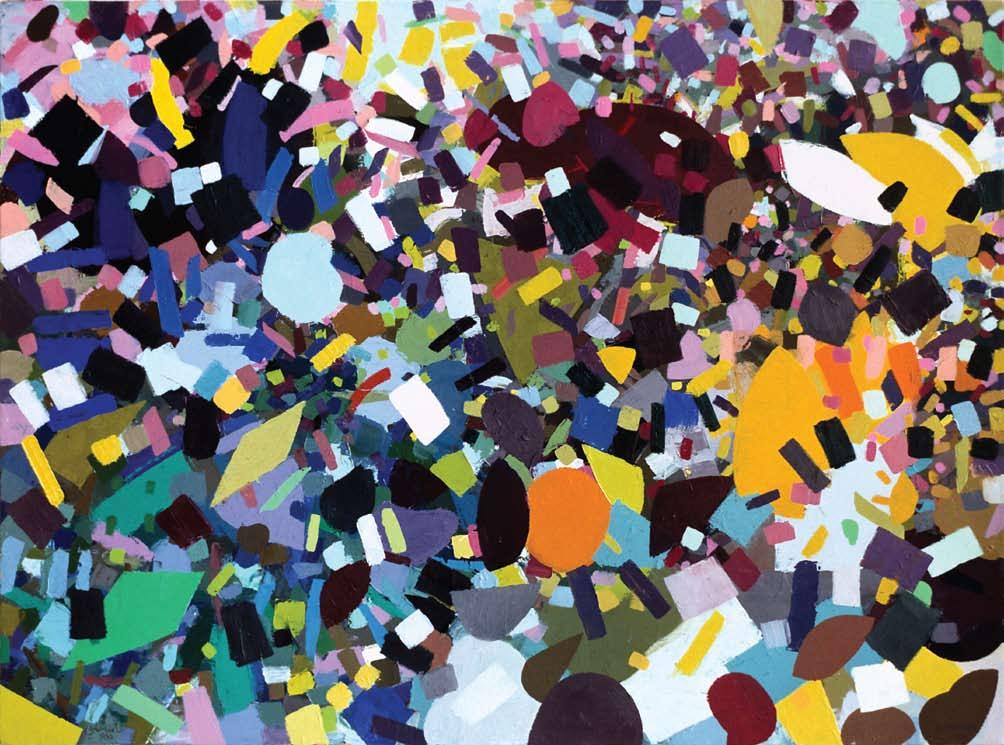
214 215
حيقلت Fertilization, 1994. Oil on canvas, 36 x 48’’, 91.5 x 122 cm. Private collection.
لاهل ءامش�لا في دورو Flowers in the Sky for Hala, 1995. Oil on canvas, 36 x 48’’, 91.5 x 122 cm. Private collection.


216 217 نياطلش�ل ةيراكذت لئاش�ر
ةباتكو ءاتش�
Letters in Memory of Sultanie, 1995. Oil on canvas, 48 x 58’’, 122 x 147.5 cm. Coll. The Khalid Shoman Foundation.
Winter and Writing, 1995. Oil on canvas, 48 x 58’’, 122 x 147.5 cm. Coll. The Khalid Shoman Foundation.
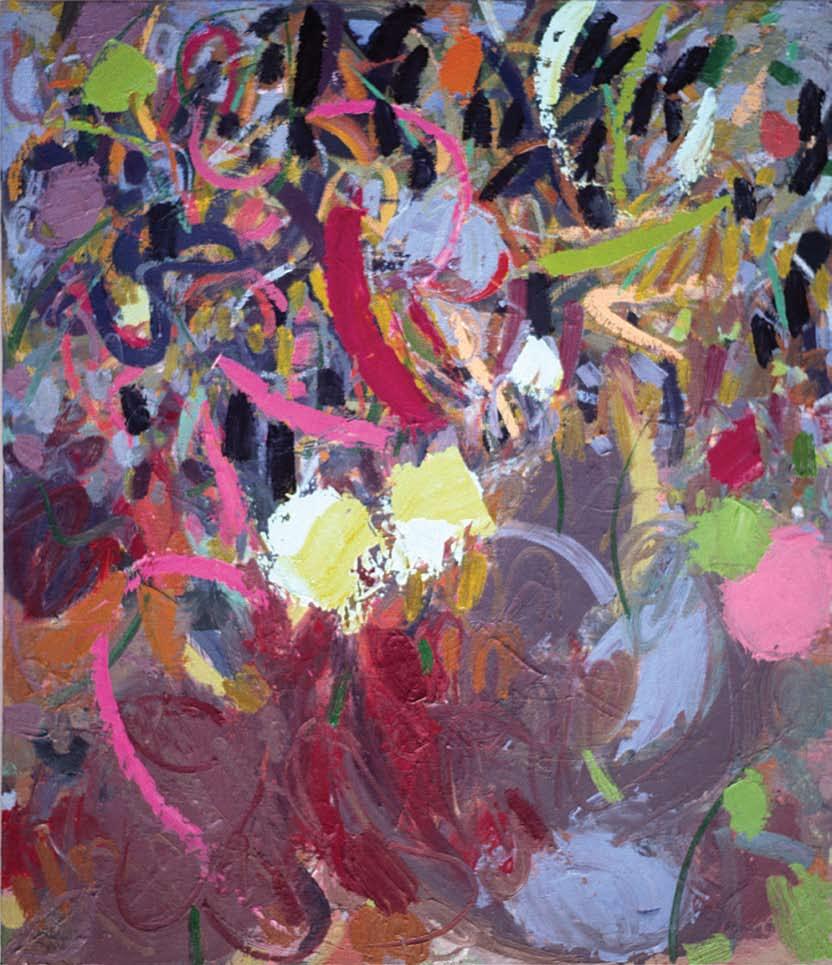

218 219
ةعيبط Nature, 1994. Encaustic on paper, 22 x 30’’, 56 x 76 cm.
قيمع جرم Deep Prairie, 1995. ➤ Oil on canvas, 22 ½ x 26’’, 57 x 66 cm. Coll. The Khalid Shoman Foundation.
"In all my paintings during the early 90s there is a thin line that I travel between two possible directions of failure. There is always the danger in a brushy, painterly work that landscape syntax will take over. Horizontal movements or a bit of light above or dark below will turn the whole into a landscape where any group of marks can become a field or a tree. Another direction of failure is more particular to me. I easily form geometric shapes with my brush marks and that takes me to old organizational habits. In the middle there is a narrow path which I seek to widen. In it I find the rhythms of soft things in nature. These are organizations composed of large numbers of smaller elements such as huge crowds of people, foliage, wave motion in water or fields of grass, herds, flocks, and other such things. Their complex geometry is dazzling.

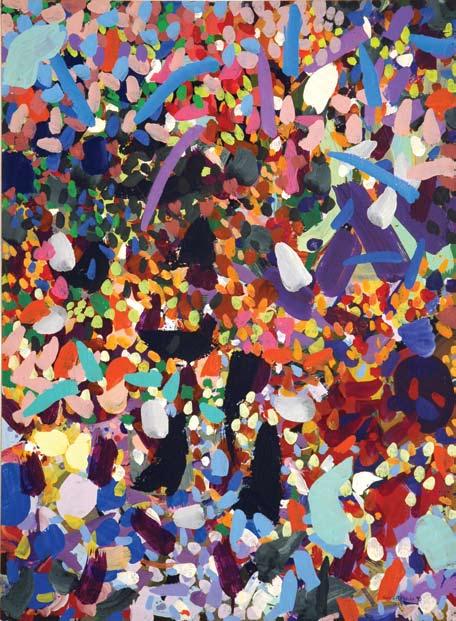
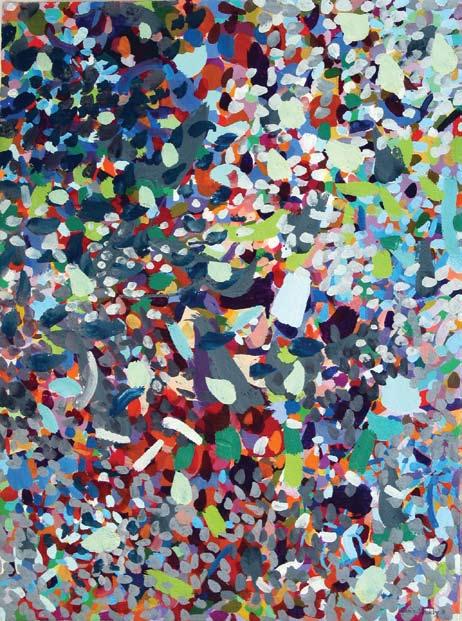

I want to extract something from this geometry of quantities of things in motion. This is where my painterly abstraction resides. I have also long thought about how we focus our eyes from one location to another so that we might comprehend our surrounding. These signals are transformed into more or less visible marks across the surface of the painting guiding the viewer’s eye with intentional strategies."
"Dans toutes mes toiles au début des années 90 je suis un chemin étroit entre deux directions d'échec possibles. D'un côté on court toujours le danger dans une œuvre au pinceau très texturée que la syntaxe du paysage prenne le dessus. Des mouvements horizontaux ou un peu de clair vers le haut ou de sombre vers le bas risquent de transformer le tout en un paysage où n'importe quel ensemble de traits peut alors devenir un champ ou un arbre. Une autre direction d'échec m'est plus personnelle. Je construis facilement des formes géométriques avec mes traits de pinceau et ceci me renvoie à de vieilles habitudes d'organisation. Entre les deux se trouve un chemin étroit que je souhaite élargir. J'y trouve le rythme des choses douces de la nature. Ce sont des agencements composés de grands nombres d'éléments plus petits tels que des foules, du feuillage, le mouvement des vagues dans l'eau ou des champs d'herbe, des troupeaux et autres choses similaires. Leur géométrie complexe est éblouissante. Je voudrais extraire quelque chose de cette géométrie des groupes de choses en mouvement. C'est ce en quoi consiste mon abstraction texturée. J'ai aussi longtemps pensé à comment nos yeux se fixent sur un lieu puis un autre pour nous permettre de comprendre ce qui nous entoure. Ces signaux sont alors transformés en marques plus ou moins visibles sur la surface de la toile qui guident l'œil du public par des stratégies délibérées."
220 221 " لانك " عراش� في يني �لا يلحا
ءاوه
يدامرلا نول
ياواه س�ارحأا
Chinatown on Canal, 1996. Acrylic on paper, 30 x 22’’, 76 x 56 cm.
Air, 1996. Acrylic on paper, 30 x 22’’, 76 x 56 cm. Private collection.
The Color of Gray, 1996. Acrylic on paper, 30 x 22’’, 76 x 56 cm.
Hawaiian Bush, 1996. Acrylic on paper, 30 x 22’’, 76 x 56 cm. Private collection.
كانه ةهج نمف .لش�فلل يننكمم ينهاتجا ينب هيلع لقتنأا عيفر طيخ كانه تانيعش�تلا لئاوأا للاخ يتاحول لك في " تاكرلحا نإ .ةحوللا ىلع يعيبطلا دهش�لما ةغل رطي �ت نأ نم ةش�يرلا تابر � ةفاثكب ظتكلما مش�رلا في مئاد رطخ ةيأ هيف حبش�ت نأا نكيم دهش�م لىإ ةحوللا لماك ليتح فو � تتح نم داوش�لا وأا قوف نم ءوش�لا نم ليلقلا وأ ةيقفألا ةي �دنه لاكش�أ ةلوه �ب عنش�أا انأ .لي ةب �نلاب ةي �و �خ ثركأ لش�فلل رخآ هاتجا .ةرجش� وأا لاقح عقبلا نم ةعوممج ءايش�ألا تاعاقيإ ىرأا هيفو .هعيش�وت لىإا ىع �أ قي � رمم كانه .ةيمدق ةيميظنت تاداع لىإ يب دوعي اذهو يتش�يرب قاروأا وأ ،س�انلا نم ةيربك دوش�ح لثم ةيرغ �لا رش�انعلا نم ةيربك دادعأ نم ةفلؤوم تاموظنم هذه .ةعيبطلا في ةمعانلا .ةش�هدلل ةيرثم ةدقعلما اهت �دنه نإ .هباش� امو بارش�ألاو ناعطقلاو بش�علا لوقح وأ ءالما في جاومألا ةكرح ا ،رجش�لا .ينفلا يديرتج نمكي انه .ةكرلحا ةلاح في يهو ءايش�ألا تايمك ة �دنه ،ة �دنهلا هذه نم ائيش� جرختش�أ نأ ديرأا مغرأ انأا .انب طيحي ام مهفن نأ اننكيم ثيحب رخآ لىإ عقوم نم اننيعأ زيكترب موقن اننأ فيك لوطم تركف يننأ امك وأا ،تارايش�لا قاوبأ ا ،رورلما تاراش�إ لثم تاراش�إلال بيجت �أا عراوش�لا في يرش�أ انأ و ةظقيتم نوكأا نأا ىلع ي �فن تاراش�إلا هذه لوحتت .ةلمتحلما لكاش�لما وند وأا ،يب نوريم نيذلا ةاش�لما ا ،تارايش�لا رمم لىإ في �رلا نم لوزنلا " .ةدو �قم تايجيتاترش�اب رظانلا ينع ةدش�رم ةحوللا حطش� ىلع ايرثك وأا لايلق ةيئرم تاملاع لىإا

223 يحابش� رطم Morning Rain, 1997. Acrylic on canvas, 52 x 130’’, 132 x 330 cm. Private collection.

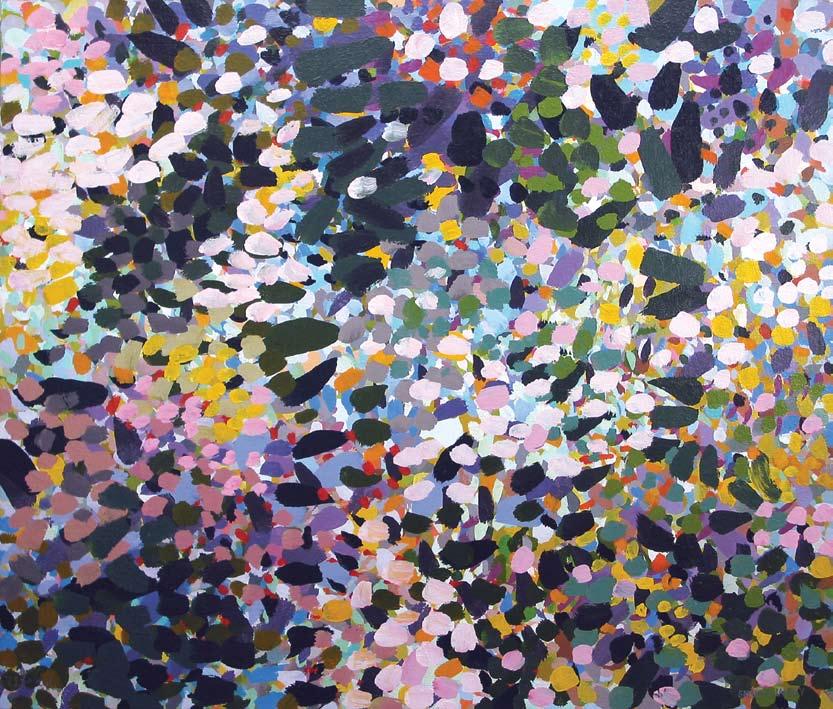
224 225
راهنلا لماعم
ةقلعم قئادح Hanging Gardens, 1999. Acrylic on canvas, 32 x 38’’, 81.5 x 96.50 cm. Private collection.
Signals by Day, 1996. Acrylic on canvas, 48 x 48’’, 122 x 122 cm. Private collection.
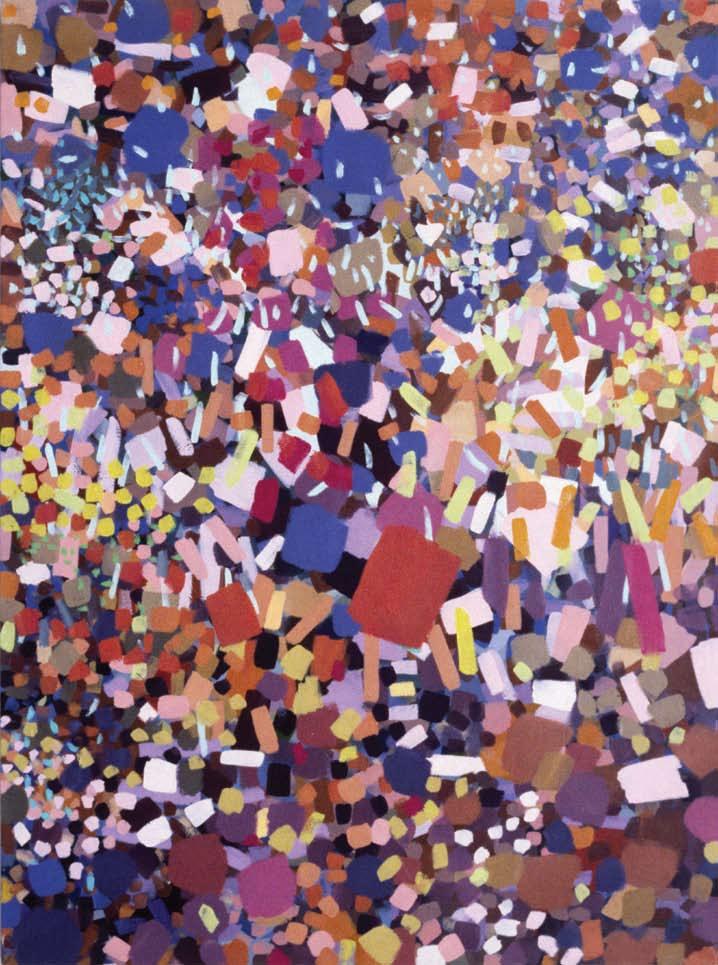
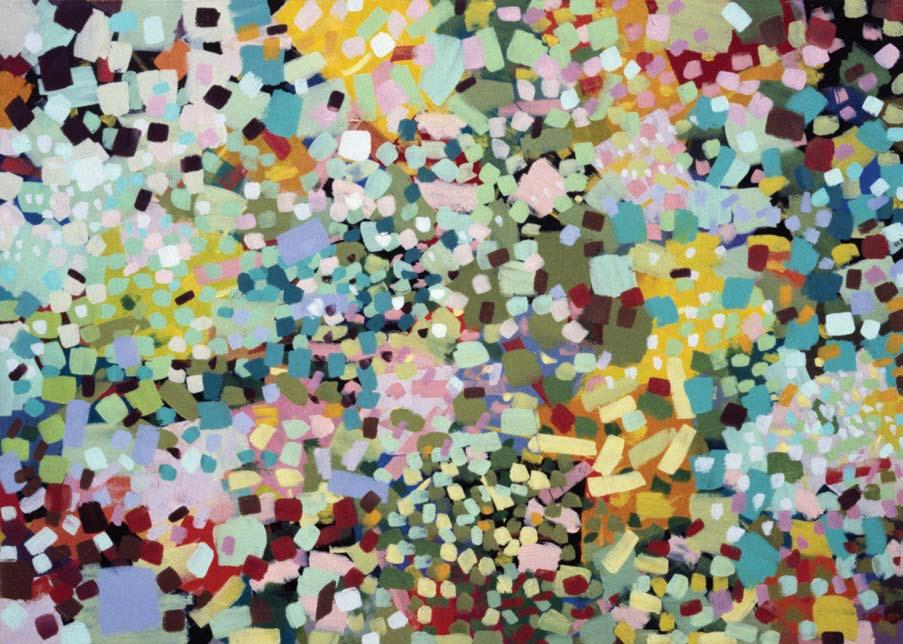
226 227 ةنيدلما دا �ح
نانجذابو ادش�
City Harvest, 1996. Oil on canvas, 37 x 50’’, 94 x 127 cm. Private collection.
Rust and Eg gplant, 1997. Oil on canvas, 40 x 54’’, 101.5 x 137 cm. Private collection.
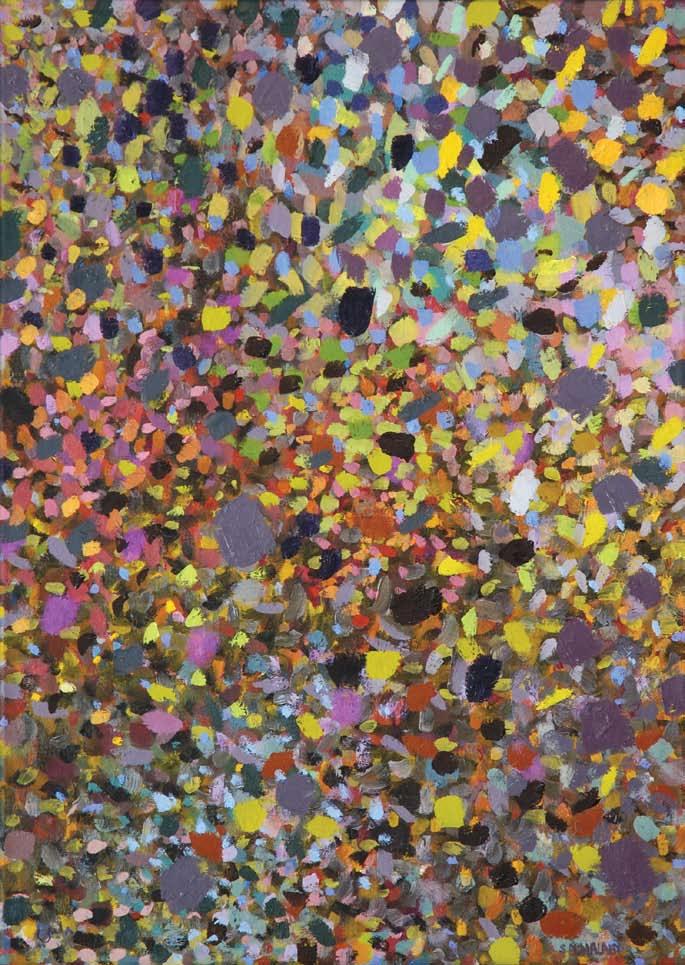
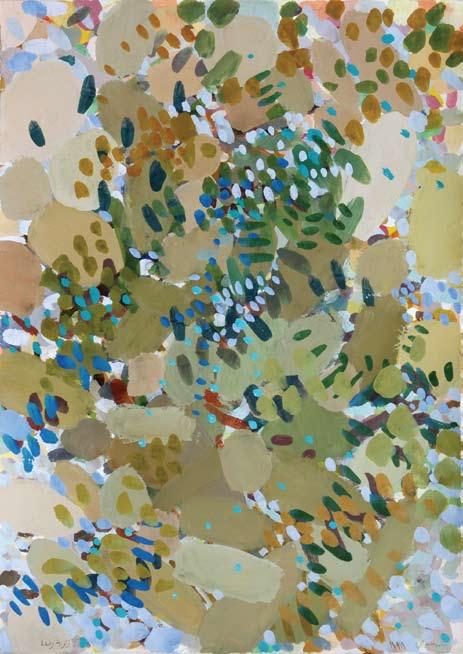

228 229 ءاوهلا في ةفاثك Density in Air,
1999.
يؤولؤو Pearly,
ةدنر نوتيز ةرجش�
Oil on canvas, 30 x 28’’, 86 x 71 cm.
1998.
Gouache on paper, 15 x 11’’, 38 x 28 cm.
Randa's Olive Tree, 1998. Gouache on paper, 15 x 11’’, 38 x 28 cm.

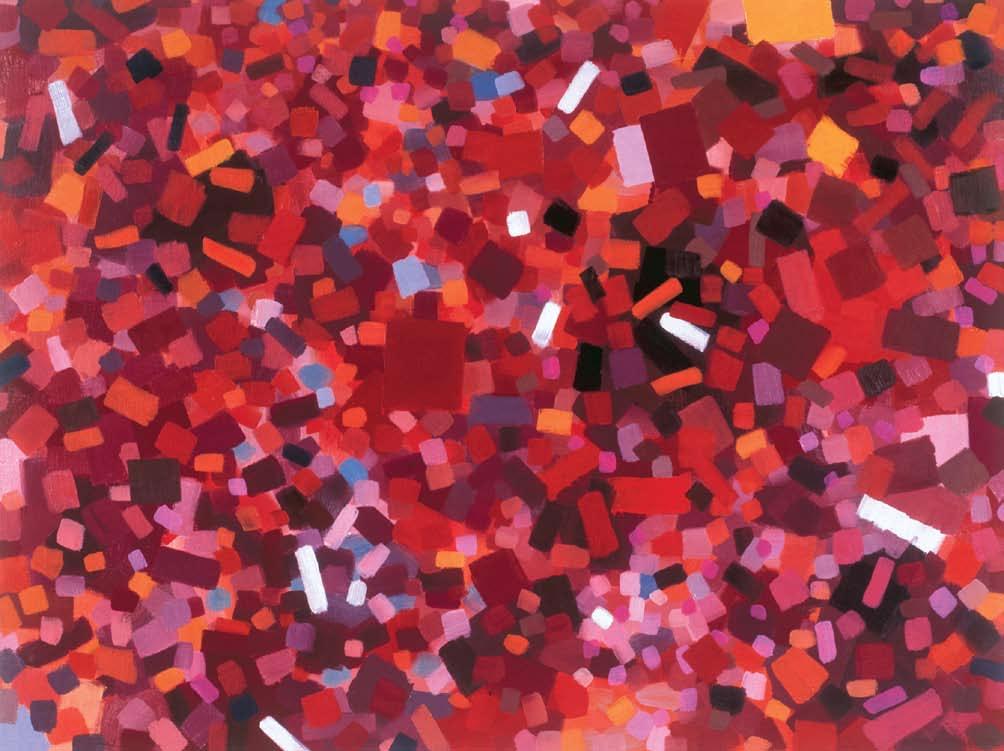
230 231 يبيلح يؤولؤول
Milky Pearly, 1999. Oil on canvas, 42 x 48’’, 107 x 122 cm.
ءارملحا The Red One, 1999. Oil on canvas, 36 x 48'', 91.5 x 122 cm. Coll. The Museum of Modern Arab Art in Doha, Qatar

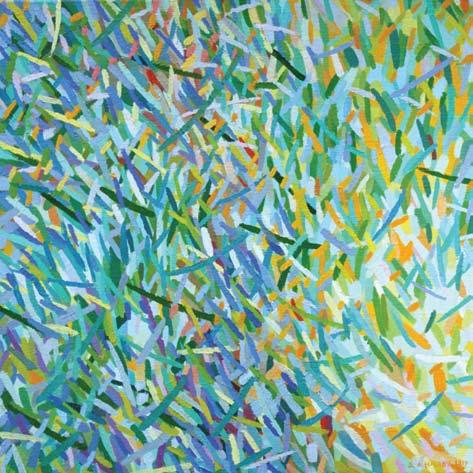

232 233 ءار �لخا ةباغلا
عجارلما لخادت
رش�خأا بنت
The Green Forest, 1999. Oil on canvas, 40 x 54’’, 101.5 x 137 cm. Private collection.
Cross References, 1999. Oil on canvas, 18 x 18’’, 45.5 x 45.5 cm. Private collection.
Green Hay, 1999. Oil on canvas, 18 x 18’’, 45.5 x 45.5 cm. Private collection.
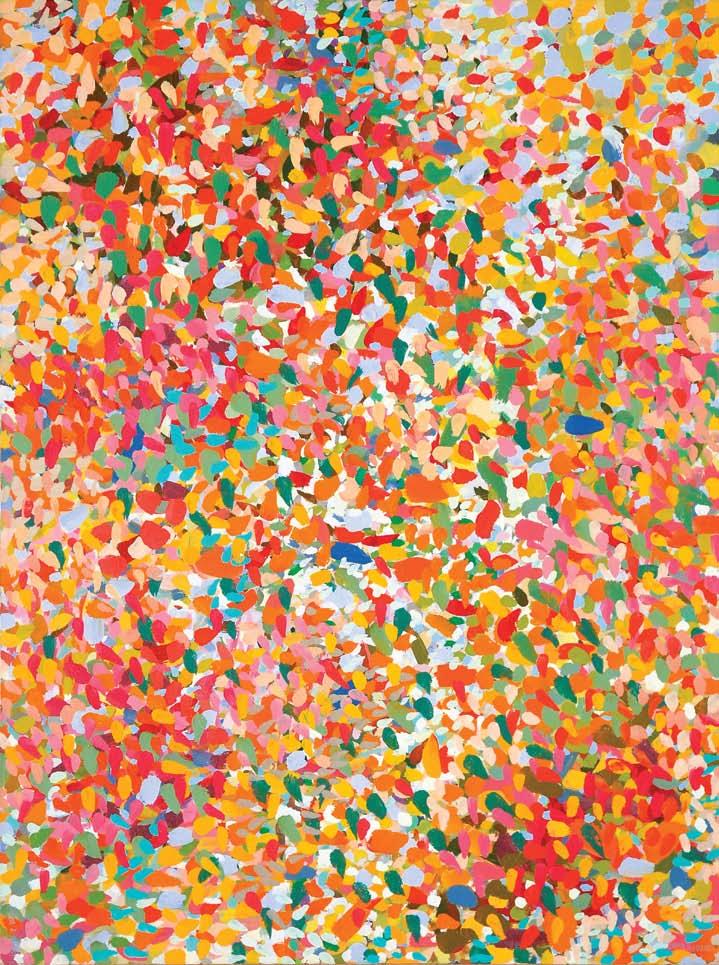

234 235 ءارش�خ وكنيملاف
ةيعيبر تابلقت
Green Flamenco, 1999. Oil on canvas, 36 x 48’’, 91.5 x 122 cm.
Spring Symmetry, 1999. Acrylic on canvas, 48 x 36'', 122 x 91.5 cm.

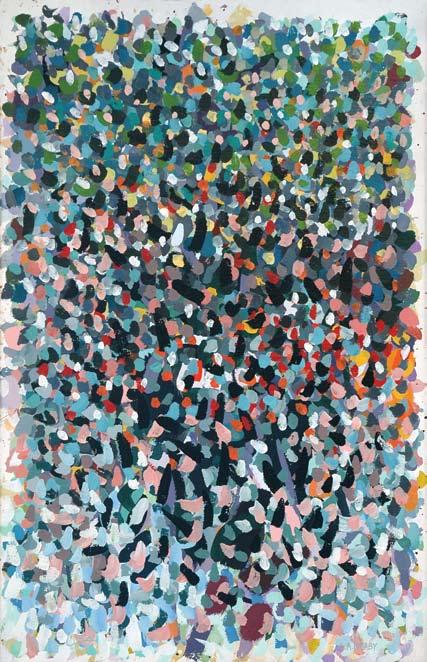

236 237
يدنلريإا رش�خأاو لاقترب
ني
تارايت عطاقت
Cross Currents, 2000. Oil on canvas, 42 x 48’’, 106.5 x 122 cm.
Irish Green and Orange, 1999. Acrylic on canvas, 25 ½ x 18’’, 65 x 45.5 cm.
ويع في رونلا Light in My Eyes, 1999. Acrylic on canvas, 38 x 24 ¾’’, 96.5 x 63 cm. Private collection.


238 239 ةيجش�فنب تاقاقر Purple Icicles, 2000. Oil
46
36’’, 117 x 91.5
حاب �لا ناولأا في ةباغلا Forest
in
106
122
on canvas,
x
cm.
Canopy
Morning Colors, 1999. Oil on canvas, 42 x 48’’,
x
cm. Private collection.
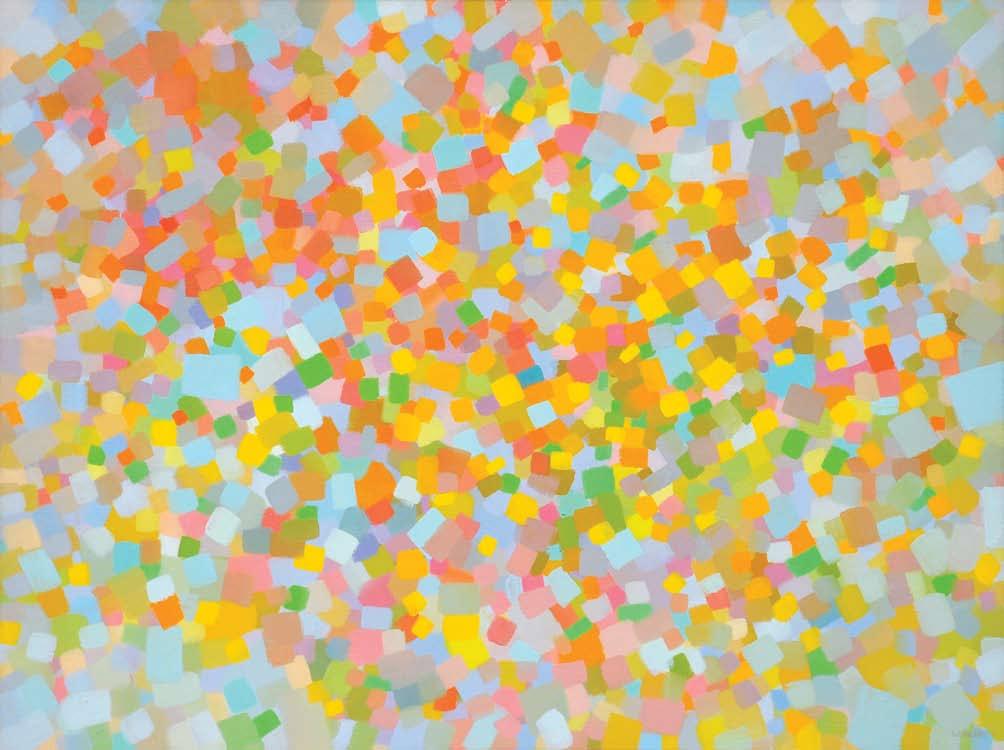

240 241 ءاقرز ءامش� في ةئداه ران Quiet
جرم
Fire in Blue Sky, 1999. Oil on canvas, 36 x 48’’, 91.5 x 122 cm.
Prairie, 2000. ➤ Acrylic on polyethylene, 51 x 47’’, 129.5 x 119.5 cm.
"Perhaps this will remain the last oil painting that I will make. It is the end of the Painterly series, a time when I began to yearn to distinguish locations in the painting. Once the differing textural locations became dominant, the impression of a landscape returned."


"C'est peut-être la dernière huile que je ferai. C'est la fin de la série Peinture Texturée, une période pendant laquelle j'essayais de créer des lieux distincts dans le tableau. Mais une fois que les lieux de textures différenciées dominaient, l'impression d'un paysage revenait."

242 243 ➤ ةيرادم قطانم Tropics, 1999. Gouache on paper, 22 x 16’’, 56 x 40.5 cm. ةنيدلما ءامش� City Sky, 1999. Gouache on paper, 24 x 18’’, 61 x 45.5 cm. ةيوباغ تلدبت Transitional Forest, 2001. Oil on canvas, 32 x 38’’, 81.5 x 96.5 cm. ،)ةش�يرلا تابرش� نم س� �ؤولما مش�رلا( يديرجتلا م �رلا ةلش�لش�ل ةياهن اهنإا .اهم �رأ ةيتيز ةحول رخآ هذه ىقبت ابمر " تداع ،ةرطيش�م ةحوللا في ةفلتخلما س�ملالما تاحاش�م تحبش�أا امدنعف .ةحوللا في عقاولما زييمتل هيف نحأا تأادب يذلا تقولا " .روهظلل ةعيبطلا دهاش�م
Olive Trees and Rocky Mountains, Kafr Qasem and the Liberation Art of Palestine Oliviers et Montagnes Rocheuses, Kafr Qasem et l'Art de la Libération en Palestine
In 1995, just a year after her visits to the Arab world increased, she was asked to teach at Bir Zeit University in the West Bank. Vera Tamari, a faculty member of the university’s art department and prominent member of the Palestinian art scene, invited Halaby to conduct a series of workshops for students. The experience made a remarkable impression on her, as she had felt deprived of her homeland and the process of creating in it for years. She was inspired to carry her painting materials from the US the next time she returned and began painting during her many visits there. The commanding landscape of Palestine and its ancient olive groves motivated the artist to paint in a representational style with the intent of documenting the abuse of the trees, which Palestinians heavily identify as declarations of longevity and sources of sustenance. Halaby also considered them as testaments to the suffering and ruin that is experienced under the occupation (as thousands of olive trees have been killed or uprooted by Israeli forces).
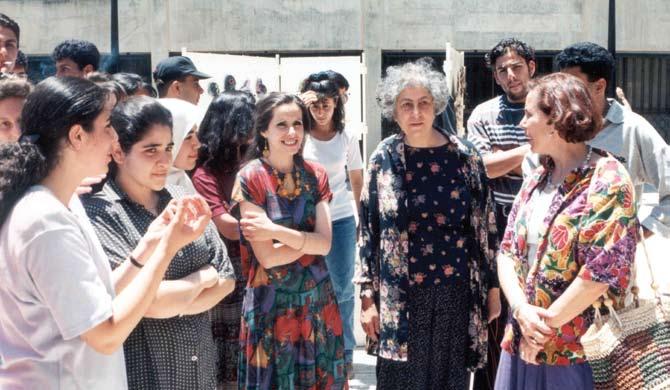
Employing illusionist methods, she painted and drew while sitting in the middle of olive groves, in the courtyard of churches or in the gardens of homes. Her friends and fellow artists, such as Palestinian painter Zahed Harash, would join her on occasion— otherwise she would work alone in dialogue with the stoic trees.
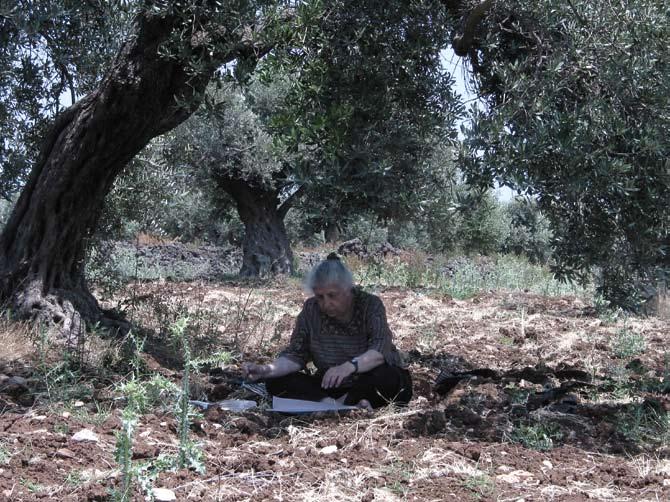
The olive trees of Palestine mirror the Palestinian people. They are planted everywhere, in every little space of Palestine. They intimately share our lives…The olive trees seem to have our personalities. At times they seemed to me to be like children or youths. Sometimes they were twins or friends snuggled together. I painted old, gnarled, and leaning ones shaped by time and weather like tough, old Palestinians. (Samia Halaby Fine Arts Publishing Beirut, 2006).
En 1995, un an seulement après que ses visites au monde arabe ne soient devenues plus fréquentes, on lui demande d'enseigner à l'université Bir Zeit de la Rive Occidentale. Vera Tamari, un membre du personnel enseignant de la section des beaux-arts de l'université et une figure importante de la scène artistique palestinienne, invite Halaby à diriger une série d'ateliers pour les étudiants. Cette expérience lui laisse une impression indélébile, d'autant plus qu'elle se sentait depuis des années privée de sa patrie et du processus d'y créer quelque chose. C'est ce qui la pousse à apporter son matériel de peinture des EtatsUnis lors de sa visite suivante, et elle commence alors à peindre pendant ses nombreuses visites. Les paysages magnifiques de Palestine et ses anciennes oliveraies incitent l'artiste à peindre dans un style représentationnel dans l'intention de documenter le traumatisme des arbres, qui sont pour les Palestiniens associés de près à des déclarations de longévité et à des sources de subsistance. Halaby les considère aussi comme des témoins de la souffrance et destruction vécues sous l'occupation (des milliers d'oliviers ont été tués ou arrachés par les troupes israéliennes).
Employant des méthodes illusionnistes, elle peint et dessine assise au milieu d'oliveraies, sur le parvis des églises, ou dans les jardins des maisons. Ses amis et collègues artistes, comme le peintre palestinien Zahed Harash la rejoignent parfois; sinon elle travaille seule, dialoguant avec les arbres stoïques.
Les oliviers de Palestine reflètent le peuple palestinien. Ils sont plantés partout, dans chaque recoin de Palestine. Ils partagent intimement notre vie…les oliviers semblent partager notre personnalité. Parfois, ils me paraissent comme des enfants ou des jeunes. Parfois, ils sont des jumeaux ou des amis blottis ensemble. J'ai peint des vieux arbres tout tordus et noueux modelés par le temps comme de vieux palestiniens robustes. (Samia Halaby Fine Arts Publishing Beirut, 2006)
244 245
تيزيرب ةعماج ذيملاتو يراتم ايرف ةنانفلا عم ةيماش�
ينط �لف في امار برق نوتيز لقح في مش�رت
Samia with artist Vera Tamari and students at Bir Zeit University, 1995.
Painting at an olive Grove near Ramah in Palestine, 2004.
One particular painting “Gethsemane for Sophia” (1999, page 247) holds significant meaning for the artist. Gaining access to the centuries-old trees that shade the famous pilgrimage site-Gethsemane is said to have been where Jesus and his disciples prayed the night before his crucifixion-Halaby painted while the priests who had let her in stepped out. Upon returning, several of them approached her to see what she was painting and asked her name. Before leaving they showed her a watercolor by painter Sophie Halaby, the distant relative and artist whom she had met in the mid 1960s, and whose composition was painted from nearly the exact location. The discovery sent a wave of excitement through the artist, who later exclaimed, “I felt wonderful. I live in forced exile from the land of my birth; yet here, Sophia’s painting confirmed that this land is where I am not a stranger” (Samia Halaby, Fine Arts Publishing Beirut, 2006).
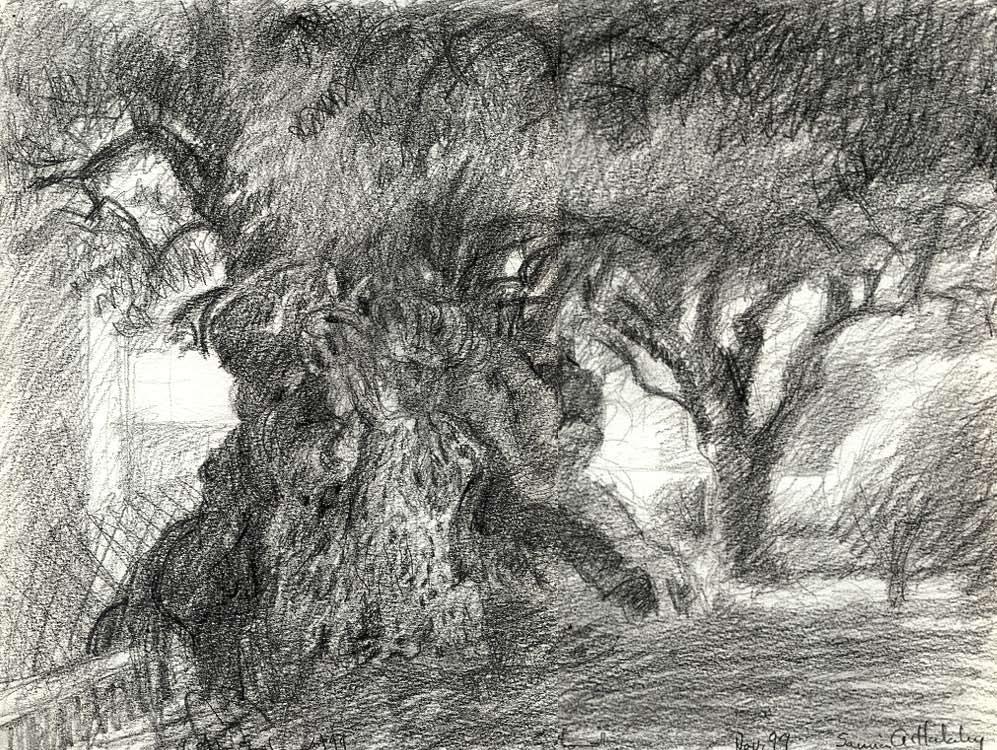
The visions of the olive trees-with their delicate leaves, stout trunks and elaborate roots-stayed with the artist long after she returned to New York. She painted these trees for over a decade and in several instances she recreated their quiet power from afar in her studio in Tribeca. Often their influence would emerge in paintings such as “Korab and Olive Trees” (2000, page 254), from the Textures of Palestine series, which recreated the physicality of Palestine’s natural environment. “These textures permeated my being with ease as they had resided in my visual memory since childhood,” explains the artist (Samia Halaby, Fine Arts Publishing Beirut, 2006).
Une toile en particulier, "Gethsemane for Sophia [Gethsémani pour Sophia]" (1999) a un sens précis pour l'artiste. Ayant eu accès aux arbres plusieurs fois centenaires qui font de l'ombre dans le lieu de pèlerinage (Gethsémani est censé être l'endroit où Jésus et ses disciples ont prié la nuit précédant sa crucifixion) Halaby peint tandis que les prêtres qui lui ont ouvert la porte s'en vont. Lorsqu'ils reviennent, plusieurs d'entre eux s'approchent pour voir ce qu'elle peint et lui demandent son nom. Avant son départ, ils lui montrent une aquarelle de la peintre Sophie Halaby, sa cousine lointaine qu'elle avait rencontrée dans les années 60 et dont la composition était peinte pratiquement au même endroit. Cette découverte enthousiasme l'artiste, qui s'exclame plus tard "Je me sentais bien. Je vis en exil forcé loin du pays de ma naissance. Et pourtant, ici, le tableau de Sophia confirme que je ne suis pas étrangère en cette terre." (Samia Halaby Fine Arts Publishing Beirut, 2006).
La vue des oliviers, avec leurs feuilles délicates, leurs troncs solides et leurs racines tortueuses, accompagne l'artiste longtemps après son retour à New York. Elle peint ces arbres pendant plus de dix ans et plusieurs fois, elle recrée leur puissance tranquille de loin, dans son atelier de Tribeca. Souvent, leur influence ressort dans des toiles telles que "Kharroub and Olives [Kharroub et Oliviers]" (2000), de la série "Textures de Palestine", qui recrée la réalité physique de l'environnement naturel de la Palestine. "Ces textures m'envahissaient sans peine car elles résidaient dans ma mémoire visuelle depuis mon enfance" explique l'artiste (Samia Halaby Fine Arts Publishing Beirut, 2006).
246 247 " ايفوش� " ـل ةينام �لجا
Gethsemane for Sophia, 1999. Pencil on paper, 11 x 15’’, 28 x 38 cm.
This is perhaps most evident in one of the artist’s few self-portraits titled “I Found Myself Growing Inside an Old Olive Tree” (2005, page 249). Lying in the center of the monochromatic work is a painterly rendering of Halaby’s face, which peers out from beneath a crown of black and white leaves that are painted with small brushstrokes. Below her image are thick, coiled roots that seem to swim towards the ground. Halaby thus becomes submerged in the physical and metaphorical details of the olive tree, suggesting an intimate connection to her homeland.

It seems to tell people just what I experienced there with the ancient olive trees about which I began to feel very sisterly, as though they were accepting me into some ancient collective of those who have seen tragedy and joy (Three Arab Painters in New York exhibition catalog, 2006).
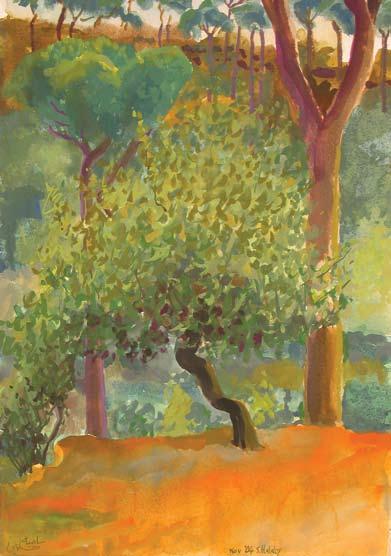

(Continued page 260)
Ce phénomène est peut-être d'autant plus en évidence dans l'un des rares autoportraits de l'artiste intitulé "I Found Myself Growing Inside an Old Olive Tree [Je me suis Sentie Grandir dans un Vieil Olivier]" (2005). Placé au centre d'une œuvre monochrome est une représentation texturée du visage de Halaby qui nous regarde de sous une couronne de feuilles noires et blanches qui sont peintes à petits traits de pinceau. Sous son portrait se trouvent d'épaisses racines enroulées qui semblent nager vers le sol. Halaby semble ainsi submergée dans les détails physiques et métaphoriques de l'olivier, évoquant un rapport intime avec son pays natal.
Cette toile semble dire aux gens exactement ce que j'ai ressenti là-bas auprès des anciens oliviers envers lesquels j'ai commencé à me sentir comme une sœur, comme s'ils m'acceptaient dans la communauté ancienne de ceux qui ont connu la tragédie et la joie. (Three Arab Painters in New York catalogue de l'exposition, 2006).
(Suite page 260)
248 249 نانبل في دفر � ينع في مش�رت Painting
دفرص� ينع ةطولب
ةرمعم نوتيز ةرجش� لخاد ونمأ يش�فن تدجو
at Ein Sarfad in Lebanon, 2004.
Balloutet Ein Sarfad, 2004. Gouache on paper, 9 x 12’’, 23 x 30.5 cm.
I Found Myself Growing inside an Old Olive Tree, 2007. Acrylic on polyethylene, 36 x 30’’, 95.5 x 76 cm.
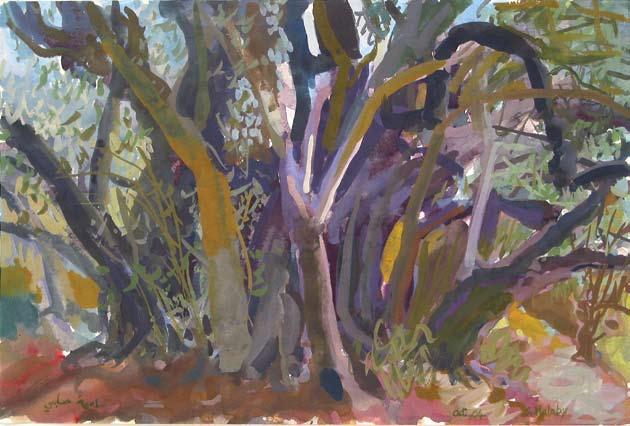
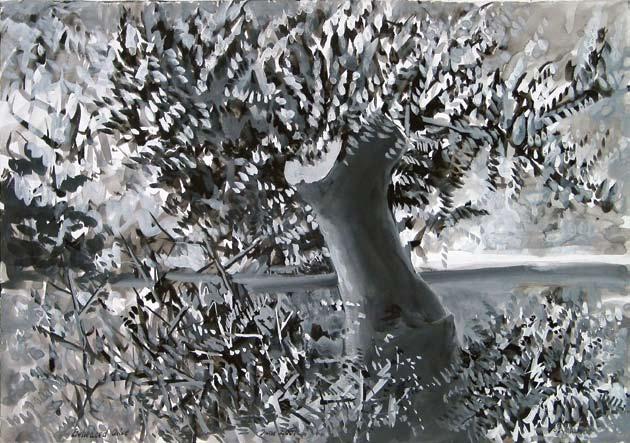
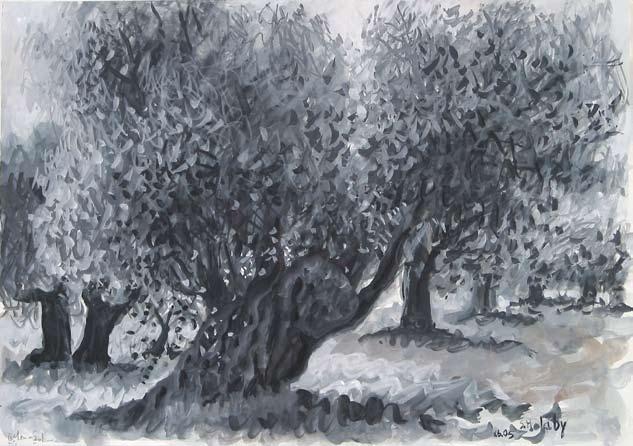
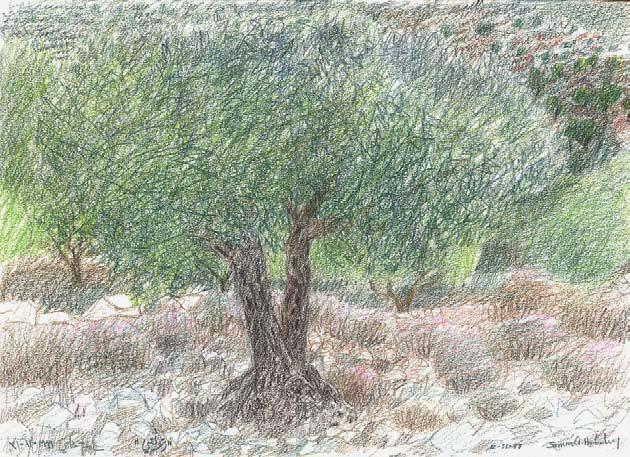
250 251 امار في ةيمدق نوتيز ةرجش� Old Olive Tree at Ramah, 2005. Gouache on paper, 11 ½ x 11 ½’’, 29 x 29 cm. ةيرتلا في ةعوطقم نوتيز ةرجش�
يودبلا Al Badawi,
17 ¾’’,
40
ةيفلألا ةرخش� Millenium Olive, 1999. Color pencil on
11 ½ x 16 ½’’, 29 x 42 cm.
Beheaded Olive Tree of Al Tireh, 2001.
Acrylic on paper, 19.5 x 13 ½’’, 49 x 34.5 cm.
2005. Gouache on paper, 12 x
30.5 x
cm.
paper,
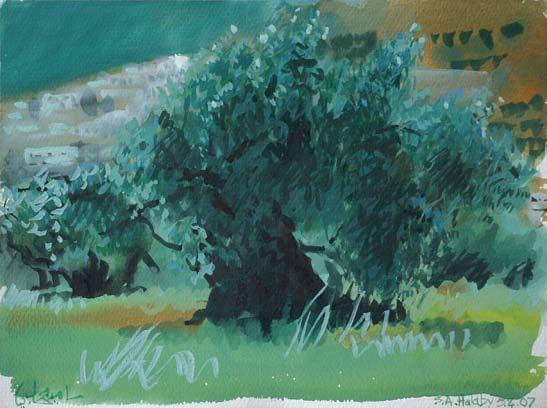
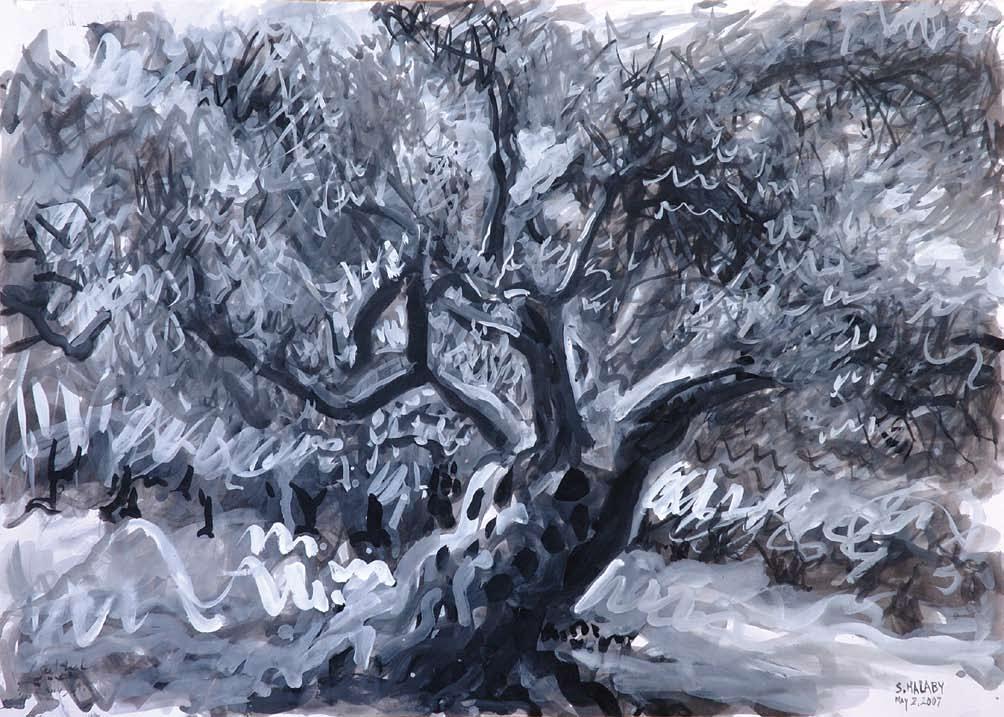
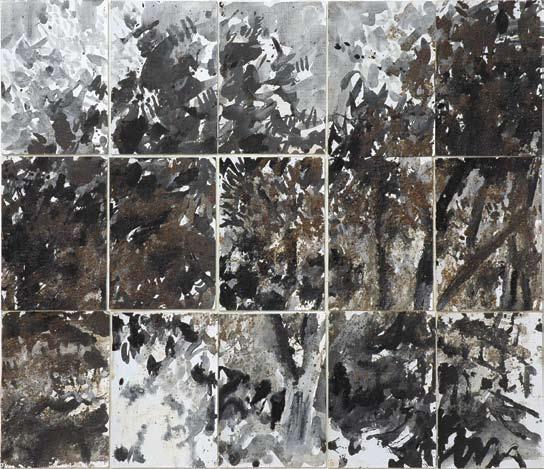
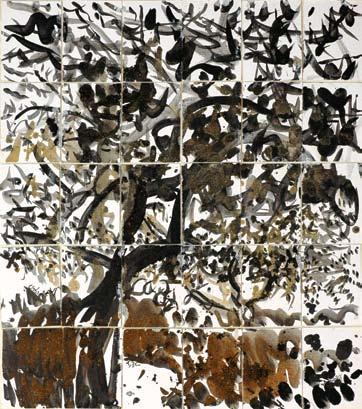
252 253 ةيرهظلا في نوتيز ةرجش�
ىرخأا ةرم ةنامرلا
Afternoon Olive Tree, 2007. Gouache on paper, 19 ¾ x 27 ½’’, 50 x 70 cm.
نوميل ةرجش�
The Pomegranate Again, 2000. Acrylic and soil on paper, 26 ½ x 18’’, 67.5 x 45.5 cm.
امار في نوتيز ةرجش�
Lemon Tree, 2000. Acrylic and soil on paper, 23 ½ x 21’’, 59.5 x 53 cm.
Rama Olive Tree, 2007. Acrylic and soil on paper, 19 ¾ x 13 ½’’, 50 x 34.5 cm.

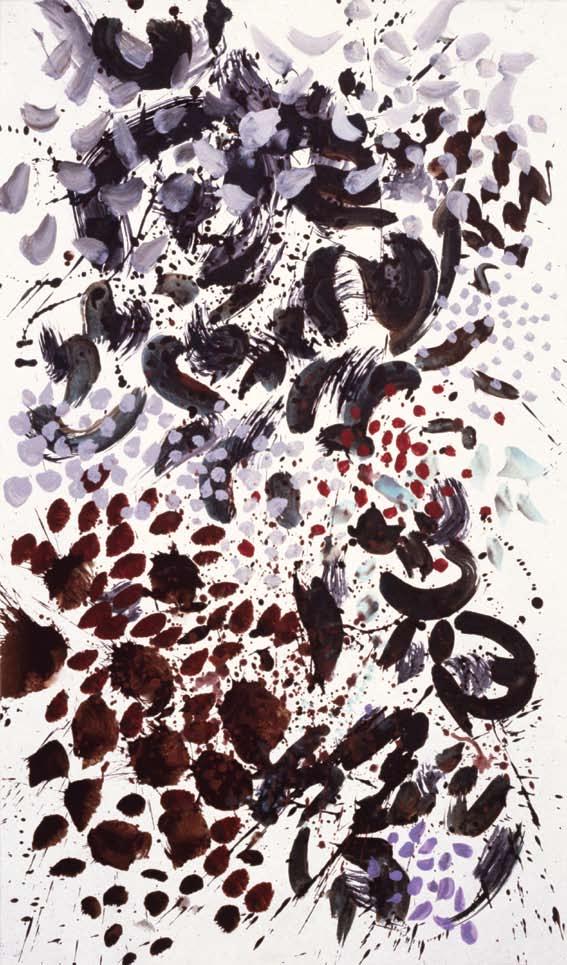
254 255 حيرلا كيحي يماش�لا
نوتيزلا راجش�أاو بورلخا
Semite Weaving the Wind, Four, 2003. Seriscreen monotype, 22
x 30’’, 56 x 76 cm.
Korab and Olive Trees, 2000.
Acrylic on polyethylene, 51 x 30’’, 129.5 x 76 cm..
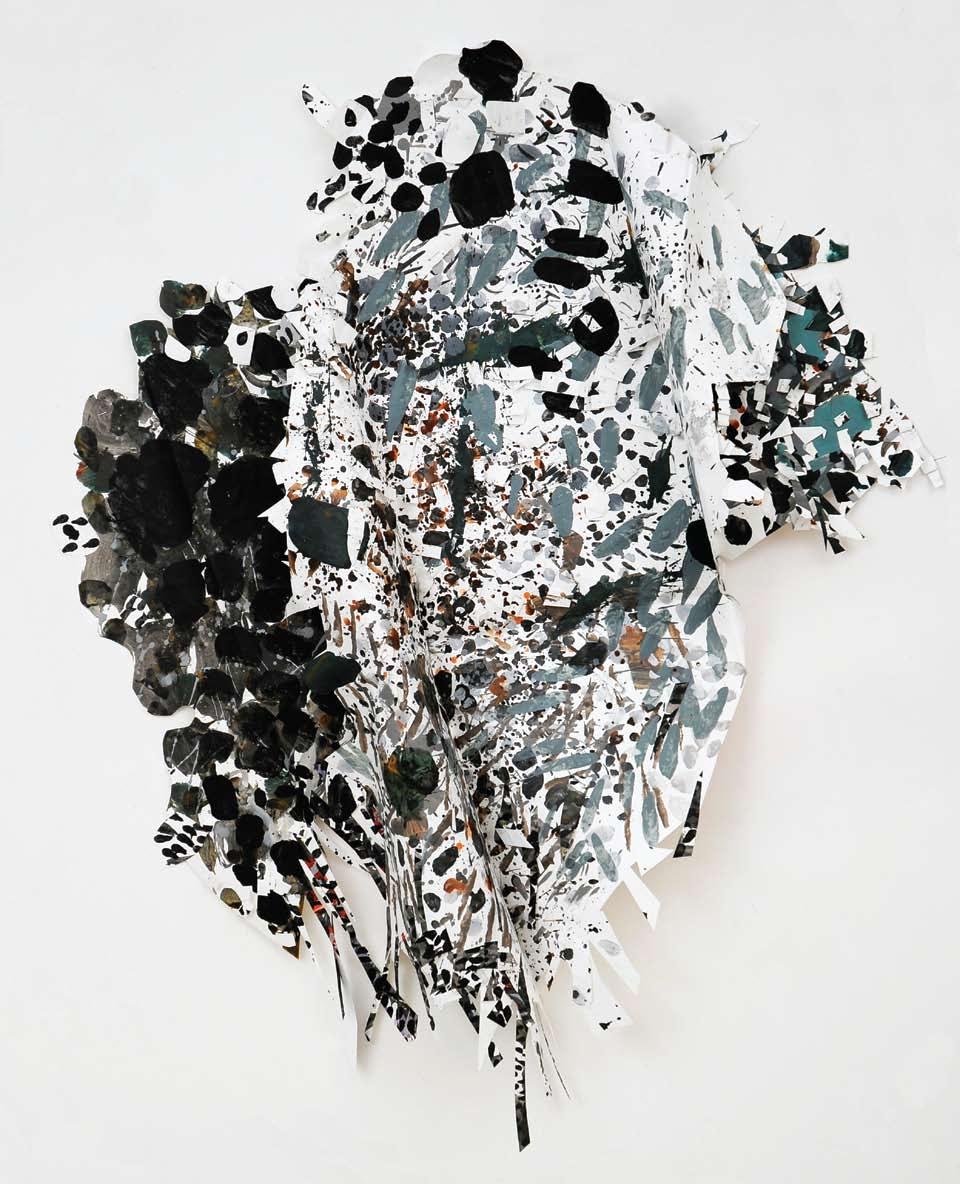
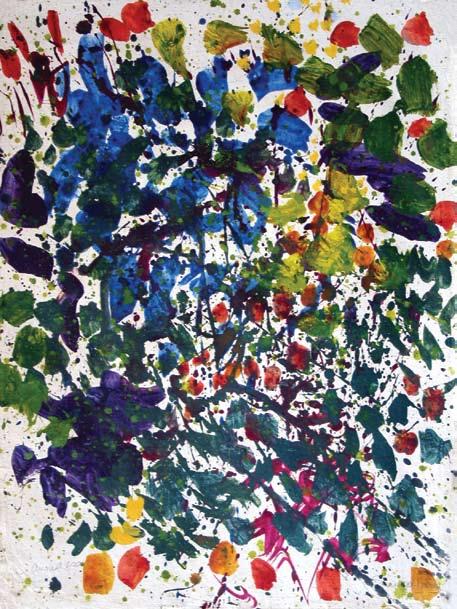
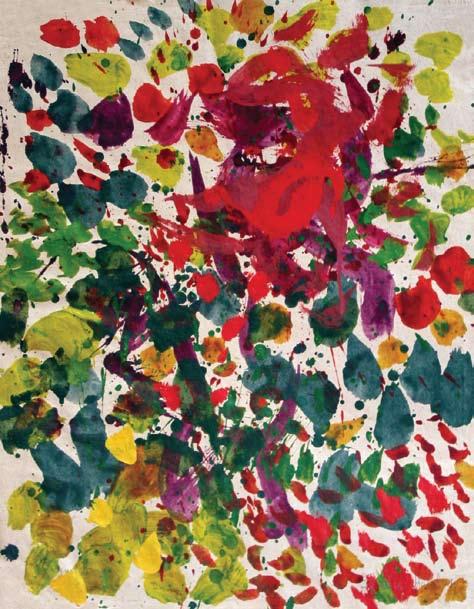
256 للها مار س�ملام
ءارمح ةش� رخ Red Doodle,
ناتش�ب في نكامأ
Textures of Ramallah, 2000. ➤ Acrylic on polyethylene, 52 x 45’’, 132 x 114.5 cm.
2001. Acrylic on paper, 24 x 19’’, 61 x 48.5 cm.
Places in a Garden, 2001. Acrylic on paper, 24 x 19’’, 61 x 48.5 cm.
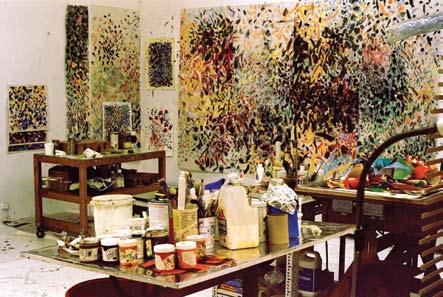
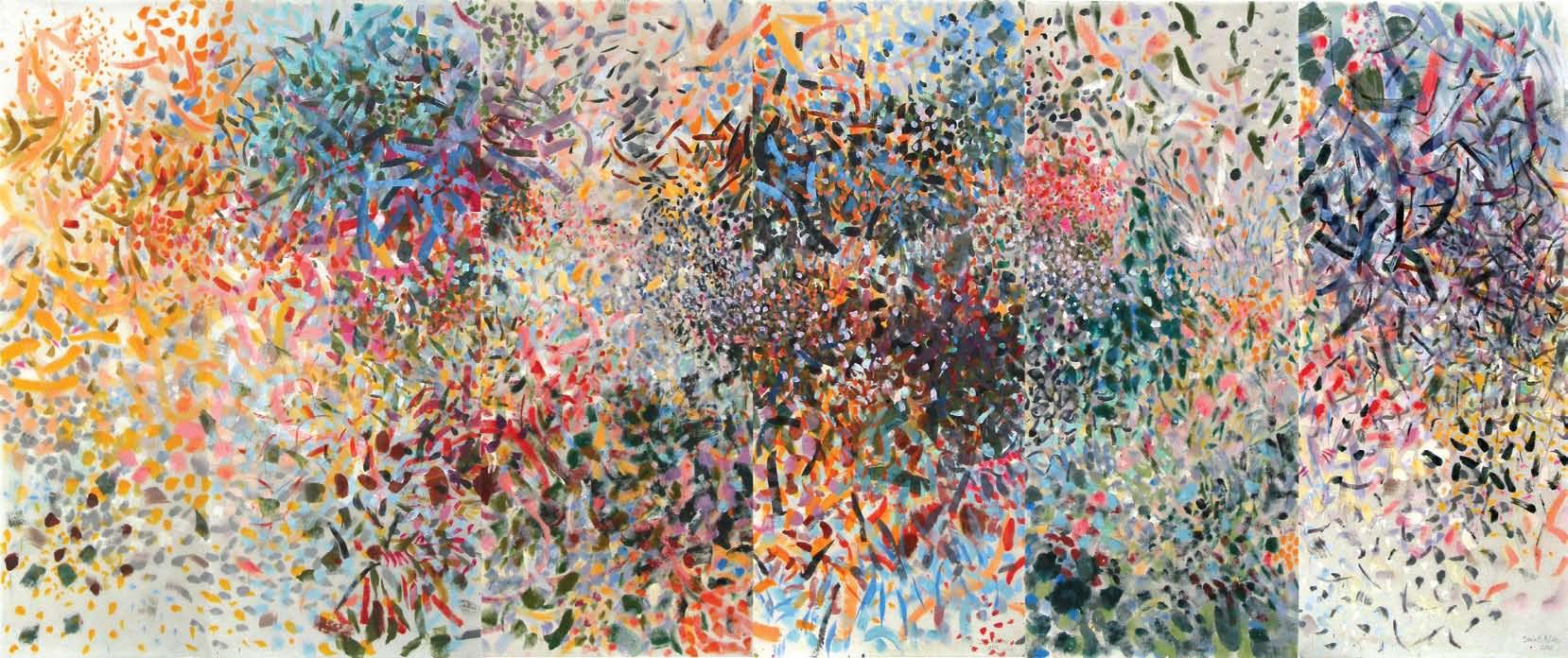
258 259 ينط �لف لابج
كرويوين ،م �رم
Mountains of Palestine, 2000. Acrylic on polyethylene, 72 x 172’’, 183 x 437 cm. Private collection.
Studio, New York, 2000.
In 1999 a friend from the Palestinian village of Kafr Qasem successfully persuaded the artist to make a series of works based on the subject of a massacre that had occurred there in 1956. Committed by the Israeli border patrol, the event saw the deaths of 49 villagers, most of whom were impoverished workers. Through interviews, printed material and other documents made by the Palestinian Communist Party, the artist recreated a number of scenes in which some of the victims are shown just moments before their deaths. Rendered in a figurative approach in conte crayon on paper, the works document the horrific accounts of several witnesses. The images utilize a style that is reminiscent of Renaissance drawing, juxtaposing the vulnerability of humanity against cataclysmic violence.
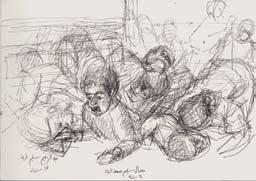



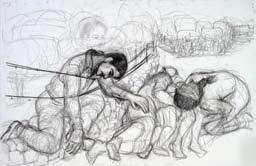

Halaby’s olive tree paintings and drawings and her Kafr Qasem series are just two of the many instances in which the artist has lent her creativity to activism. In the 1960s when she first began to participate in political organizing, she drafted a number of posters that utilized the art of Arabic calligraphy in support of particular causes and painted several others in the style of the Mexican muralists, whom she admires.
This relationship between art and activism culminated in her research of Palestinian art around this time. Through several research trips in the late 1999s and early 2000s, she conducted interviews with nearly fifty artists who were based in Gaza, the West Bank, Palestine 48 and neighboring Arab countries. Having published essays on art in the past (including studies on Palestinian and Arab visual culture) Halaby had built a significant portfolio of writing. Her selfpublished text Liberation Art of Palestine (2002) was the first book to identify a particular undercurrent of Palestinian art, one that was closely linked to efforts of achieving political self-determination. Considered essential to scholarship on contemporary Palestinian art, the book includes a look at some of the more notable figures of the movement alongside equally important but often overlooked artists, providing an in-depth look at the development of this crucial facet of Palestinian culture.
En 1999, un ami du village palestinien de Kafr Qasem parvient à convaincre l'artiste de faire une série d'œuvres au sujet d'un massacre qui y avait eu lieu en 1956.Commis par des patrouilles frontalières israéliennes, l'événement vit la mort de 49 villageois, dont la plupart étaient des travailleurs appauvris. A partir d'entretiens, de documents écrits et d'autres sources du Parti Communiste Palestinien, l'artiste recrée un certain nombre de scènes où certaines des victimes sont dépeintes quelques instants avant leur mort. Peintes dans un style figuratif au crayon Conté sur papier, les œuvres documentent les récits horrifiants de plusieurs témoins. Le style des images rappelle le dessin de la Renaissance en juxtaposant la vulnérabilité de l'humanité et la violence cataclysmique.
Les oliviers de Halaby, ses dessins et sa série Kafr Qasem ne sont que des exemples de l'utilisation par l'artiste de sa créativité pour soutenir l'activisme. Dans les années 60, quand elle commence à participer à l'action politique, elle dessine un certain nombre d'affiches utilisant l'art de la calligraphie arabe pour soutenir certaines causes et en peint plusieurs autres dans le style des muralistes mexicains, qu'elle admire.
Ce rapport entre art et activisme culmine dans ses recherches sur l'art palestinien à peu près au même moment. Grâce à plusieurs voyages d'études fin 1999 et début 2000, elle s'entretient avec près de cinquante artistes installés à Gaza, la Rive Occidentale, Palestine 48 et les pays arabes voisins. Ayant auparavant publié des essais sur l'art (dont des études sur la culture visuelle palestinienne et arabe), Halaby a amassé un important portfolio d'écrits. Son texte auto publié, Liberation Art of Palestine [L'art de la Libération en Palestine] (2002) est le premier livre à identifier un courant particulier de l'art palestinien, lié à des efforts pour obtenir l'autodétermination politique. Considéré comme essentiel aux études sur l'art contemporain palestinien, l'ouvrage se penche sur les personnalités les plus remarquables du mouvement ainsi que sur d'autres artistes aussi importants mais souvent négligés, proposant un regard en profondeur sur le développement de cet aspect crucial de la culture palestinienne.
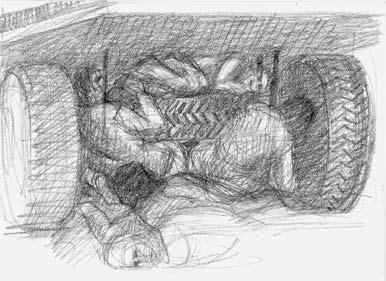
260 261 مش�اق رفك ةرزمج ،ىش�يع للها دبعو للاط
وبأا ،لامجو ميحرلا دبع ،تولما تقو قانع ،اف �و دوممح .1999 ،مش�اق رفك ةرزمج ةعوممج نم تاش�ارد .بويأا Mahmoud and Safa, Embrace n Death, Abdalraheem and
and
from the Kafr
Talal and Abdallah Isa, Kafr Qasem Massacre, 2006. Acrylic on Polyester, 46 x 84’’, 117 x 213.5 cm. Private collection.
Jamal,
Abu Ayyoub,
Qasem Massacre series, 1999. Pencil sketches.
كرويوين
مش�اق رفك
ينش�ملخا
مش�اق رفك ةرزمج ،نايبش�و نلاجر
في
ةرزجلم
ىركذلل
س�رعم Exhibition Commemorating the fiftieth anniversary of the Kafr Qasem massacre at The Bridge gallery in New York, 2006.
Two Men and Two Boys, Kafr Qasem Massacre, 1999. Conte crayon, 9.5 x 13’’, 24 x 33 cm.
Free of the Stretcher: 2000-Onward Libérée du Cadre: Après 2000
By 2000 Halaby
was again examining the function of the picture plane. This time, however, she would reach a stage in which its function would become obsolete, setting it aside, instead of challenging its boundaries from within. Part of this departure was inspired by her Olive Tree series, in which her painterly abstraction had matured and brushstrokes took on greater prominence. One particular work
“Olive Grove in My Studio” (2000, page 263) shows the incorporation of smaller areas of colorful brush marks suggesting a parasite among several trees. These isolated components not only guide the viewer’s eye throughout the mural-sized work, they add striking contrast to larger, fuller strokes. These “parasites” are similar to those that the artist would create as freestanding works over the next decade.

Halaby also acknowledges the influence of several artists of the Palestinian Liberation art movement, namely Vera Tamari, Nabil al Anani and Mahmoud Taha, who all use assemblage in their work. She quickly developed a system of cutting and stitching pieces of canvas that she would then designate to certain parts of her borderless composition.

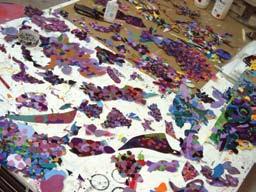
I began to compile my paintings first by making the parts then fitting them to each other, and allowing that process to determine a perimeter. Thus the perimeter is often irregularly born of the inner workings of parts rather than existing before the parts and determining their formal attributes. This matched what I learned when cutting autumn leaves in 1975 (Samia Halaby, exhibition catalog, Ayyam Gallery 2008).

En 2000, Halaby retourne une fois de plus à la fonction de l'espace du tableau. Cette fois-ci toutefois, elle atteint le stade où il devient obsolète, et elle s'en défait, au lieu de défier son cadre de l'intérieur. Cette nouvelle direction s'inspire en partie de sa série "Oliviers", dans laquelle l'abstraction texturée a mûri et les touches de pinceau occupent une place plus importante. Une œuvre en particulier, "Olive Grove in My Studio [Oliveraie dans mon Atelier]" (2000) incorpore de petites zones de touches de pinceau et de couleur suggérant un parasite parmi plusieurs arbres. Ces composantes isolées guident l'œil du public le long de cette œuvre monumentale, mais elles constituent aussi un contraste frappant avec de plus grandes et de plus pleines touches de pinceau. Ces "parasites" sont similaires à ceux que l'artiste créera sur des œuvres individuelles les dix années suivantes.
Halaby reconnaît aussi l'influence de plusieurs artistes du Mouvement de l’Art de la Libération en Palestine, dont Vera Tamari, Nabil al Anani et Mahmoud Taha, qui utilisent tous l'assemblage dans leurs œuvres. Elle développe rapidement un système de découpe et de couture de morceaux de toile qu'elle pose ensuite sur certaines parties de ses compositions sans bordures.
J'ai commencé à faire mes tableaux en fabriquant tout d'abord les parties et en les raccordant les unes aux autres, et en permettant à ce procédé de déterminer un périmètre. Donc le périmètre naît souvent irrégulièrement du fonctionnement interne des parties, plutôt qu'en préexistant et déterminant les attributs formels des parties. Ceci rejoint ce que j'avais appris en coupant des feuilles d'automne en 1975. (Samia Halaby, Catalogue de l'Exposition, Galerie Ayyam 2008)
262 263
يمش�رم في نوتيز ناتش�ب
مش�رلما تلواط ىلع س�امق عطق
يمش�رم في نوتيز ناتش�ب
Olive Grove in My Studio, 2000. Acrylic on Polyester, 72 x 175’’, 180 x 445 cm. Private collection.
Studio Tables with Cut Canvas, 2003.
Olive Grove in My Studio, detail.
In “Red Africa” (2001, page 265) the artist has layered several assemblages, placing certain pieces as a background, others as a central focal point, and smaller parts as a foreground. Using components that possess a similar palette of red, black, blue and pink, she creates depth without the aide of referencing the picture plane. The sides of each piece are cut with different angles and curves, giving the appearance of organisms that are amidst formation or brush strokes that are escaping the central axis. Yet for Halaby such works “by becoming objects, removed the illusion that is crucial to painting…that very special, very important attribute of painting, to create an illusion in thin air, was lost” (Correspondence with the artist, 2010).
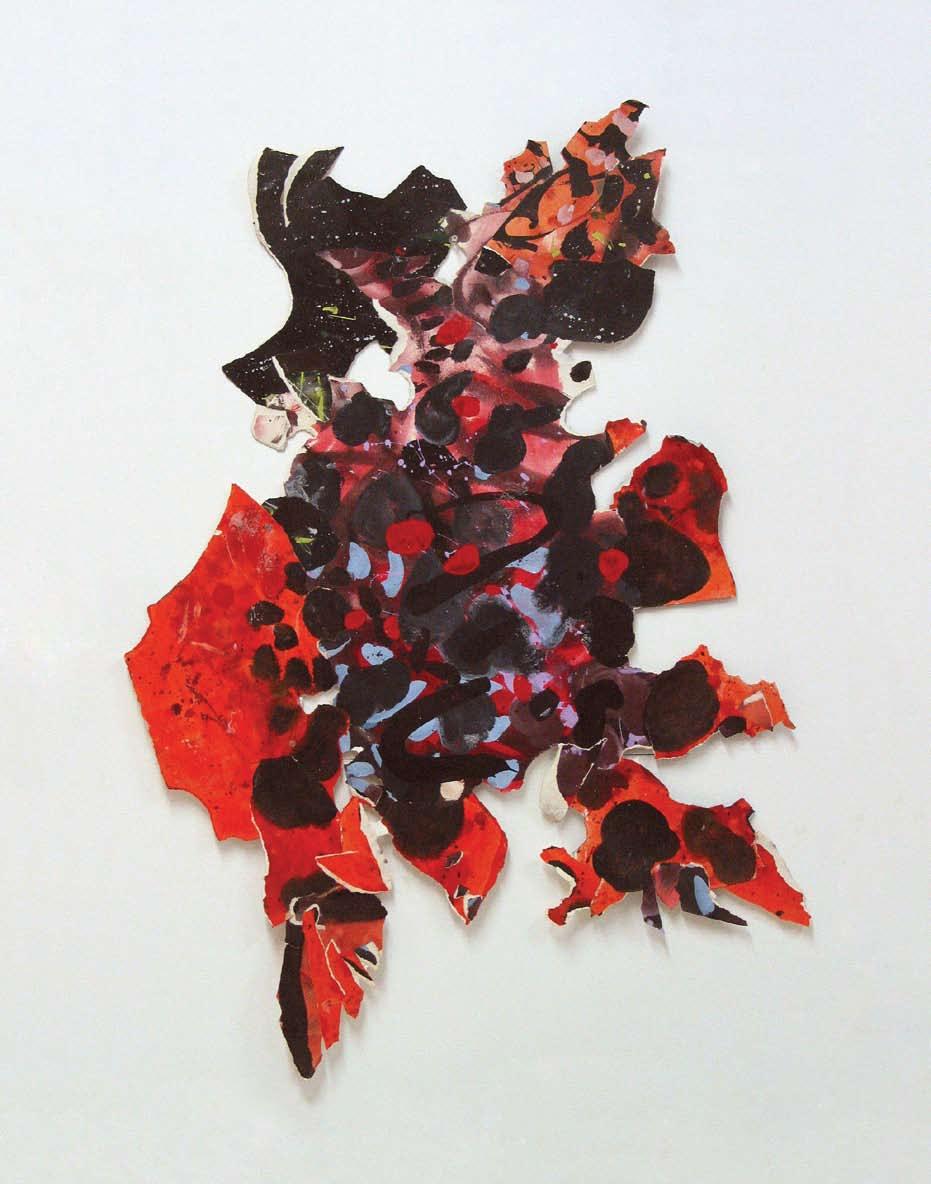
Although not entirely satisfied with the Free From the Stretcher works, the artist found a particular freedom in them that sparked a surprising course. She began to develop a series of hanging sculptures using paper mache. These were partially inspired by the workshops that she conducted at Bir Zeit University in 1995, during which she taught students how to use the medium. Fashioning these “three dimensional” paintings involved a similar idea as the Free From the Stretcher works but with parts that occupied several different spatial planes and were released from the confines of the two-dimensionality of a wall. The result was a form that seemed as if it was floating in midair, as brush marks “took flight… and related to each other in a three-dimensional world.” (Correspondence with the artist, 2010).

(Continued page 286)
Dans "Red Africa [Afrique Rouge]" (2001), l'artiste met plusieurs assemblages en couches, plaçant certains morceaux en guise de fond, d'autres en point focal central, et de plus petits morceaux au premier plan. Utilisant des éléments qui possèdent une gamme similaire de couleurs, des rouges, des noirs, des bleus et des roses, elle suggère la profondeur de champ sans avoir besoin de faire référence au plan pictural. Les côtés de chaque morceau sont coupés à différents angles suivant des lignes courbes, lui conférant l'apparence d'organismes en formation, ou de coups de pinceau qui échappent à l'axe central. Pourtant selon Halaby, de telles œuvres, "en devenant des objets, détruisent l'illusion qui est cruciale à la peinture… cet attribut très spécial, très important de la peinture, de créer une illusion à partir de rien, est perdu" (Correspondance avec l'artiste, 2010).
Bien qu'elle ne soit pas entièrement satisfaite de ses œuvres de la série "Libérée du Cadre", l'artiste leur trouve une liberté particulière qui la mène dans une direction surprenante. Elle commence à développer une série de sculptures en papier mâché qu'elle accroche. Celles-ci s'inspirent en partie des ateliers qu'elle avait menés à l'université de Bir Zeit en 1995, pendant lesquels elle avait appris aux étudiants à employer cette technique. La fabrication de ces peintures "en trois dimensions" incorpore une idée similaire à celle des œuvres de "Libérée du Cadre" mais avec des parties qui occupent différents plans spatiaux et qui sont libérées des confins des deux dimensions d'un mur. Il en ressort une forme qui semble flotter en plein air, tandis que des traits de pinceau "s'envolent… et sont reliés l'un à l'autre dans un monde en trois dimensions". (Correspondance avec l'artiste, 2010).
(Suite page 286)
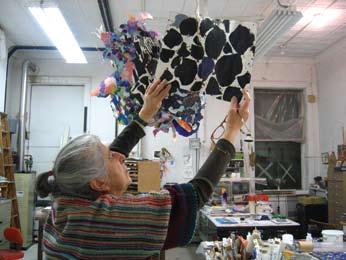
264 ينطش�لف س�ملام
Textures of Palestine, 2000.
Acrylic on folded paper, 16 ½ x 11 ½ x 30’’, 42 x 29 x 75 cm.
مش�رلما في ينط �لف س�ملام Studio view with Textures of
ءارملحا ايقيرفأا
Palestine, 2000.
Red Africa, 2001. Acrylic on paper, 25 x 16’’, 63.5 x 40.5 cm.

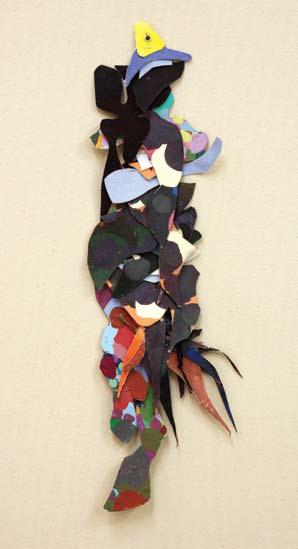
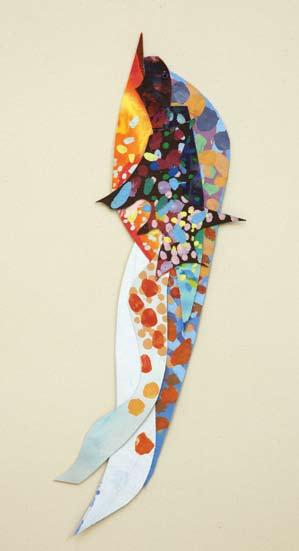

266 ةيلبلجا ينطش�لف تانوتيز
طولب ةرجش�ل س�ع
ةيرغ �لا ةلئالما
بلقني
Mountain Olives of Palestine, 2003. ➤ Acrylic on paper and canvas collage, 97 x 95’’, 247 x 242 cm. Private collection.
Nest
for an Oak Tree, 2007. Acrylic on canvas collage, 19 x 6’’, 48 x 15 cm.
Little Diagonal, 2007. Acrylic on canvas collage, 27 ½ x 8 ¼’’, 70 x 21 cm.
Overturn, 2007. Acrylic on canvas collage, 25 ½ x 11 ½’’, 65 x 29 cm.

ط �وتلما س�يبألا رحبلا لىإ ندرألا رهن نم ينطش�لف
Palestine from the Jordan River to the Mediterranean Sea, 2003. Acrylic and paper on canvas collage, 108 x 180’’, 275 x 457 cm. Private collection.
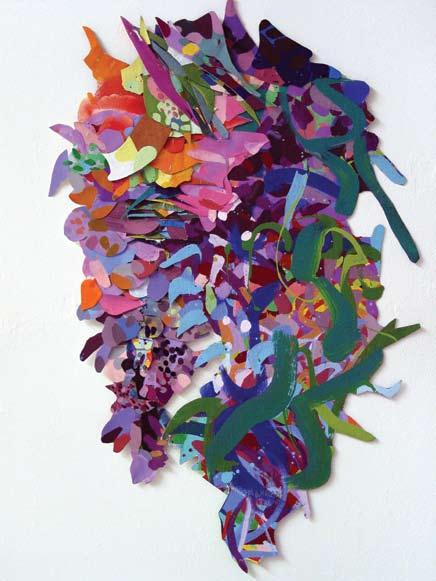
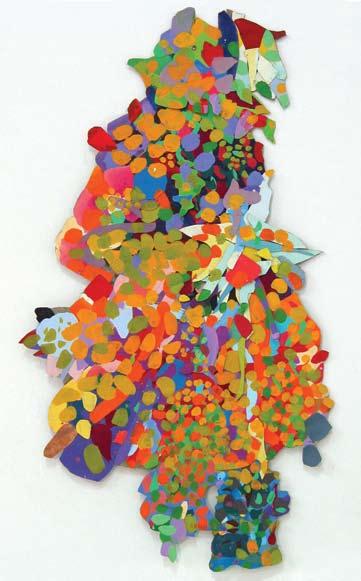
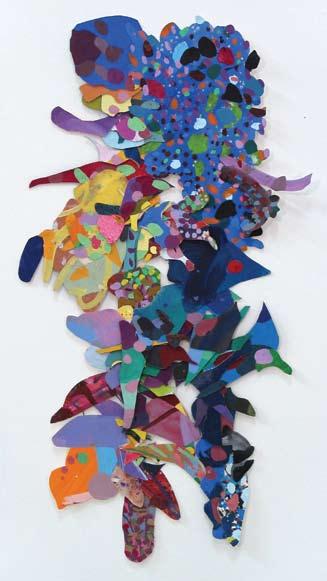

270 271 ةيرغش�لا ينطش�لف
Little Palestine, 2003. Acrylic on canvas collage, 46 x 27’’, 117 x 68.5 cm.
نافقي ناقرزأ Standing Blue Pair, 2003. Acrylic on paper and canvas collage, 26 x 13 ½’’, 86 x 34.5 cm.
ةش�يرع Arbor, 2003. Acrylic on paper and canvas collage, 25 ¾ x 29’’, 65.5 x 73.5 cm.
ةيورق ة �قار Village Dance Woman, 2003. Acrylic on paper and canvas collage, 33 x 19’’, 84.5 x 48 cm. Private collection.
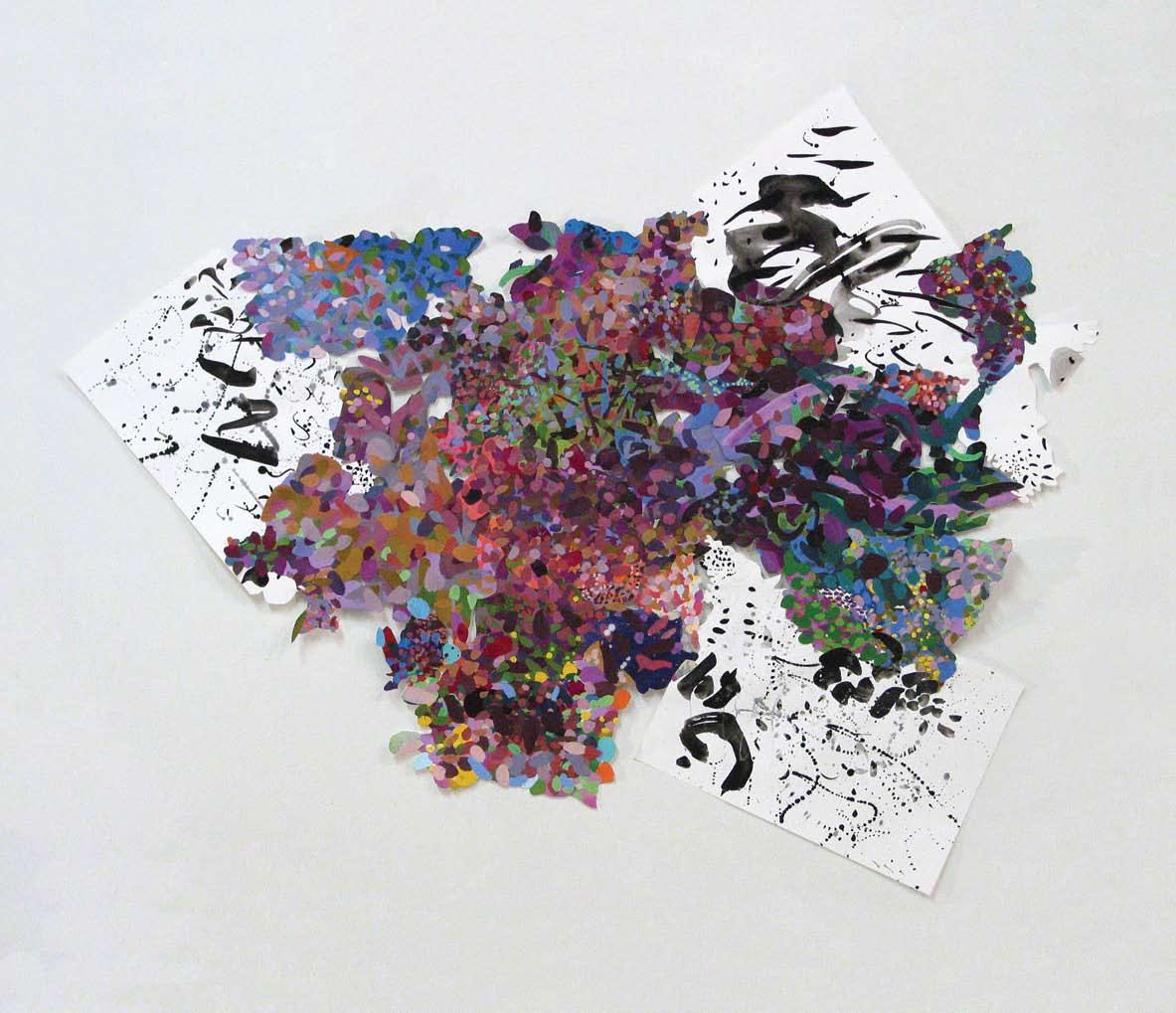

272 تويرب في ةقيدح Garden in Beirut, 2003.
كرويوين لىإا تويرب نم From Beirut to New York, 2003.
40 ¼
25 ¼’’, 105
64
Acrylic on paper and canvas collage, 41 x 53’’, 104 x 134.5 cm.
Acrylic on paper and canvas collage,
x
x
cm.
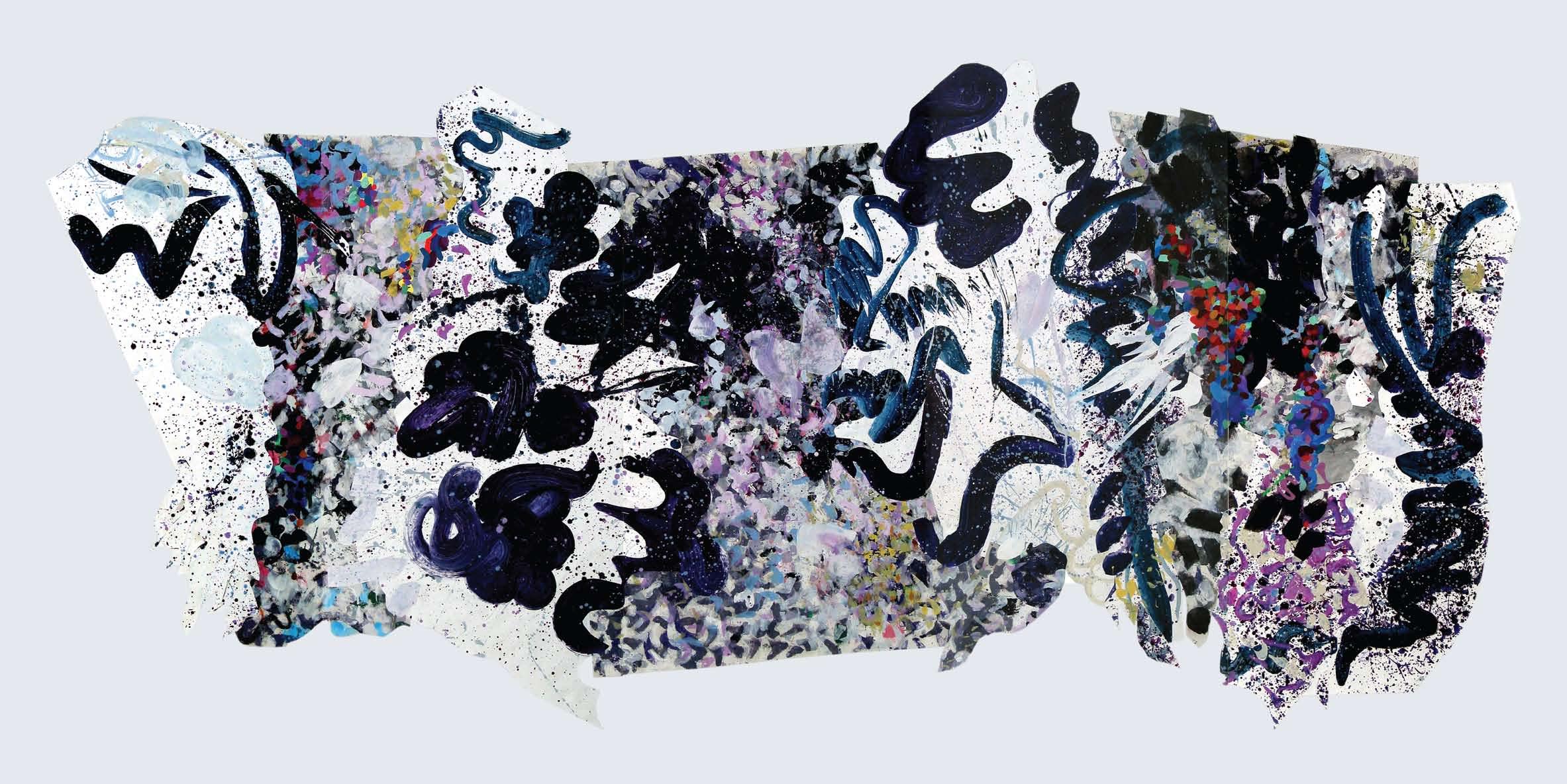
ملح تيبل ةحول
Big
One for Bethlehem, 2003. Acrylic on polyester, 69 x 147’’, 175.5 x 373.5 cm. Private collection.
Acrylic on canvas, 59 x 30’’, 150 x 76 cm. Coll. Jordan National Gallery of Fine Arts.
ةيكيتش�لاب ةش�ارف
The Plastic Butterfly, 2004.
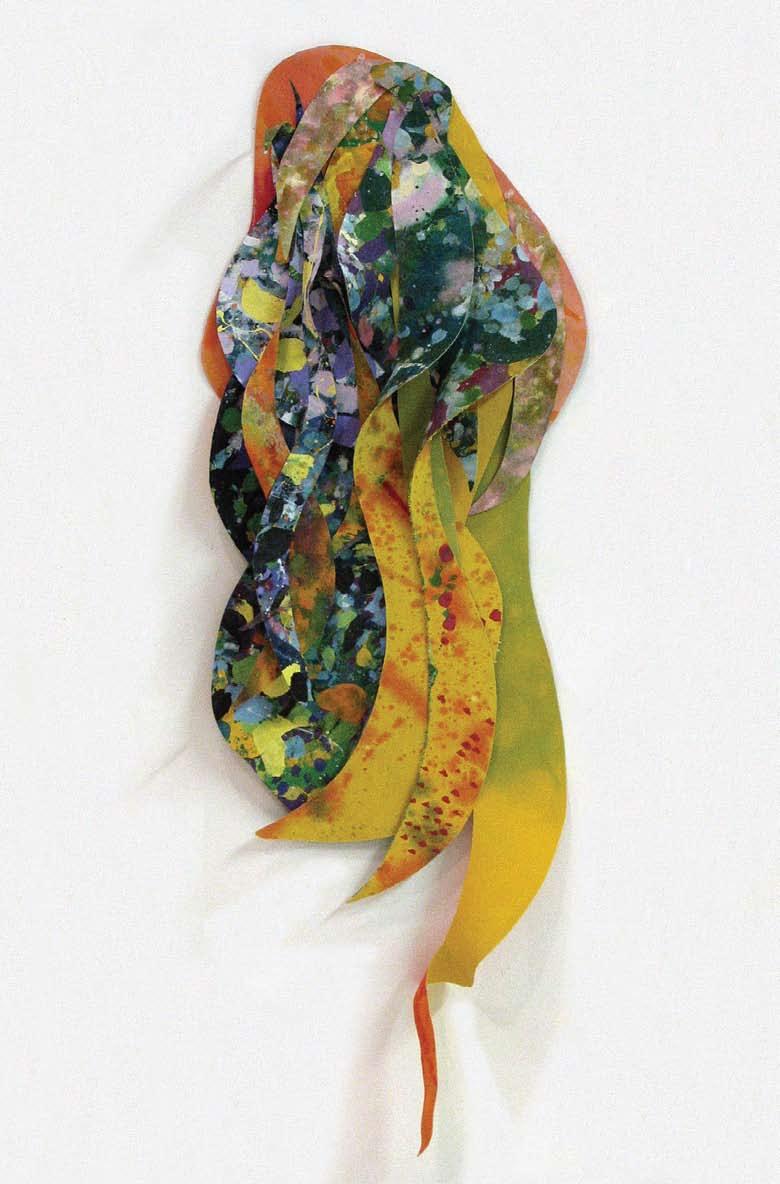

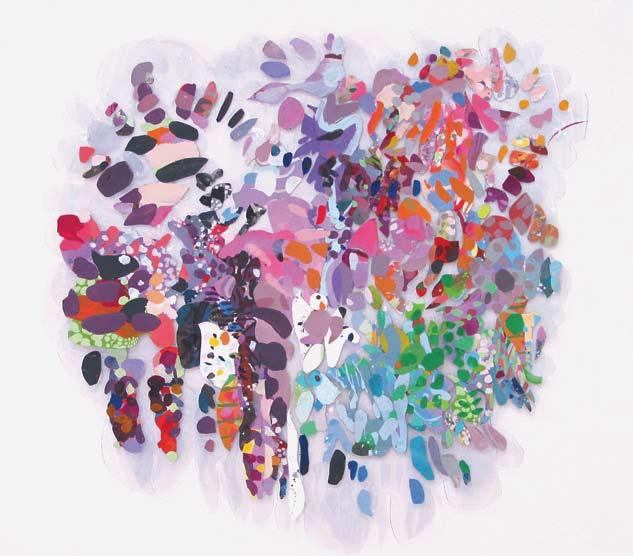
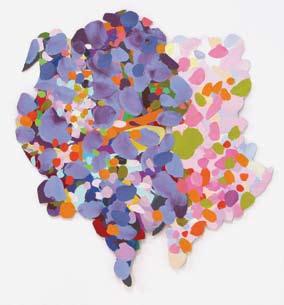

Acrylic on paper and vinyl, 29 x 30 ¾’’, 73.5 x 78 cm. Coll. The Williamsburg Art and Historical Center, Brooklyn, NY.
Little Corner of Precious Colors Hidden in a Garden, 2004. Acrylic on canvas, 14 ½ x 13’’, 37 x 33
في رون Light in Your Heart, 2004.
Acrylic on canvas collage, 18 x 25’’, 45 x 63.5 cm. Private collection.
Green Athlete, 2003. Acrylic on canvas collage, 10 ½ x 5 ½’’, 26.5 x 14 cm. Private collection.
277 ةقيدح في ةأابخلما ةنيمثلا ناولألا ةيرغ � ةيواز
Private collection. ينط �لف ءاش�ن ةلش�لش� ،ةيعيبرلا اهتقيدح في ةأ رما
cm.
Woman in Her Spring Garden, Women of Palestine series, 2005.
كبلق
رش�خأ يش�اير
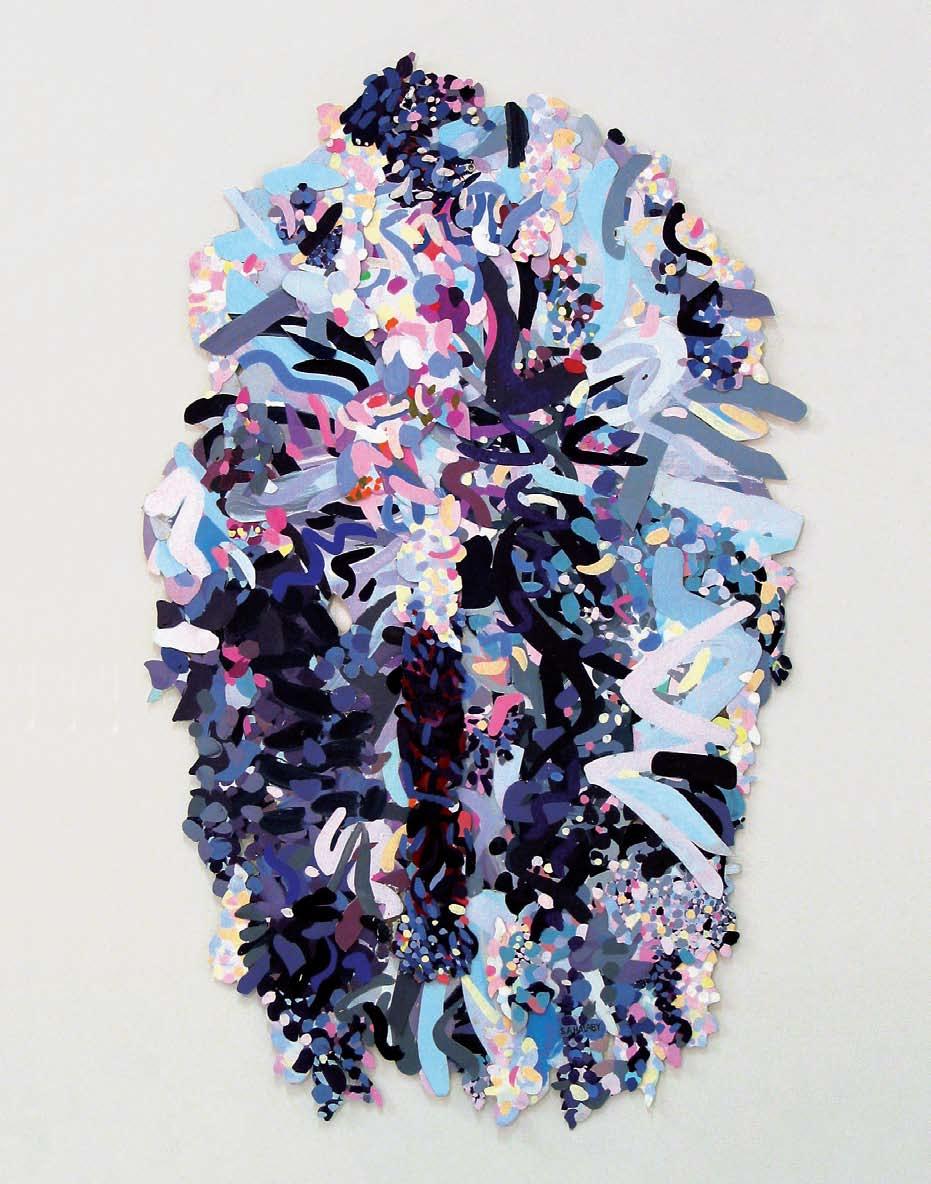

يتدج ةقيدح في ورش�لا
س�دقلا في اهتقيدح
Cypr ess in my Grandmother's Garden, 2004. Acrylic on canvas collage, 70 x 28 ½’’, 178 x 72.5 cm. Private collection.
Her Garden in Al-Quds, 2005. ➤ Acrylic on canvas collage, 51 ½ x 31 ½’’, 131 x 80 cm. Private collection.
فترم
Sumptious Greens, 2004.


ةيرغ �لا ةطولبلا
راجش�أ اهمدقت يتلا ينبلا نوللا تاعيونتب يباجعإا س�كعت ةحول مش�رل حومطلا كلذ .فيمخ حومطل ايرش�تح يتافاش�كتش�ا نم ءزج يه "ةيرغش�لا ةطولبلا "" " .ط �وألا برغلا في نايدن �لا
"Little Oak is part of my explorations preparing for a scary ambition. That ambition being to make a painting reflecting my admiration of the variations in browns offered by the oaks of the Midwest."
"Little Oak [Petit Chêne] fait partie de mes recherches en vue d'accomplir une ambition effrayante, cette ambition étant de faire un tableau reflétant mon admiration pour les variations de brun visibles parmi les chênes du Midwest."
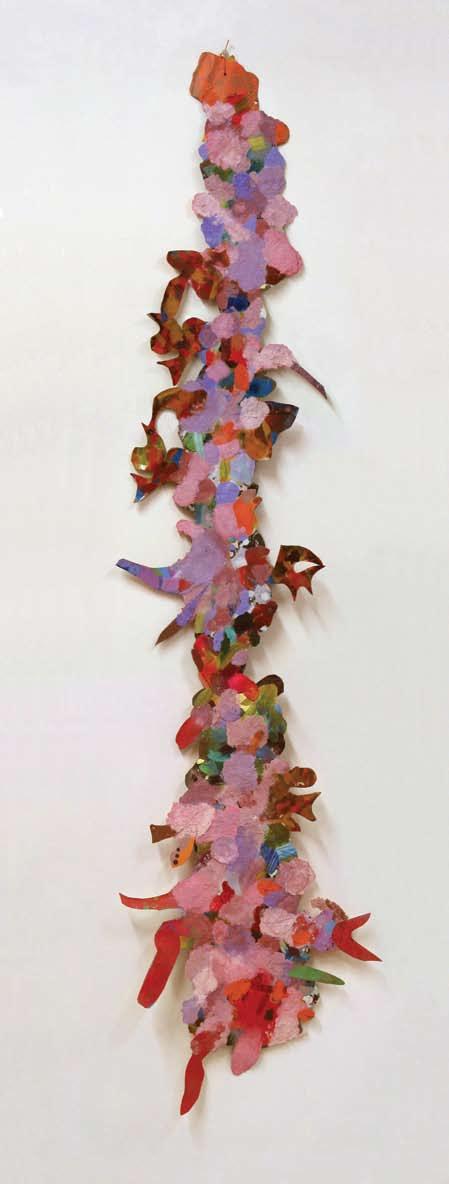
280 رش�خأ قانع
Green Embrace, 2004. Acrylic on canvas collage, 21 x 46'', 53.5 x 117 cm. Private collection. را �خ
Acrylic on canvas collage, 32 x 42’’, 81.5 x 107 cm.
Little Oak, 2003. Acrylic on paper and canvas collage, 84 x 21’’, 213.5 x 53.5 cm.

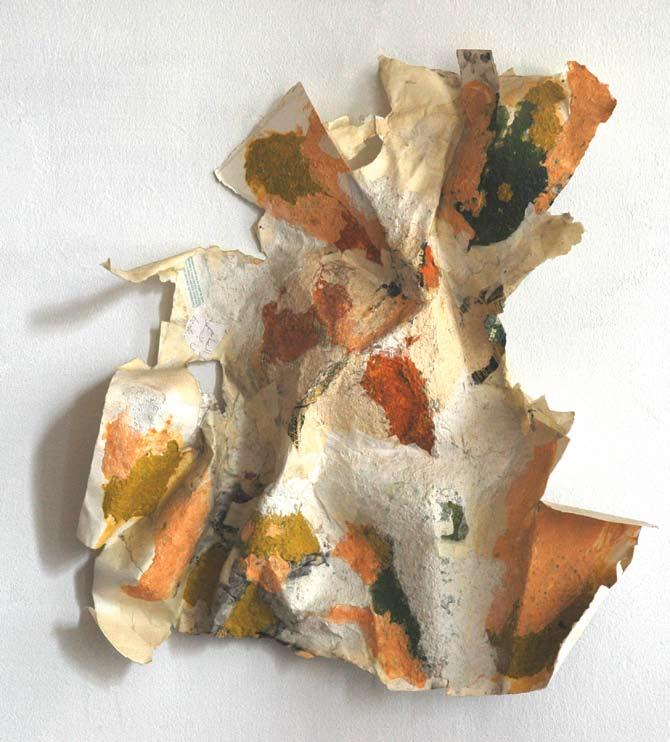
282 للها مار لابج
اندلاب راجح ليوده س�م ➤
Mountains of Ramallah 1997. Papier maché, 24.5 x 21 x 3.5’’, 62.5 x 53 x 9 cm.
Miss, These are the Stones of Our Country, 1997. Papier maché, 16 x 16 x 8’’, 40.5 x 40.5 x 20.5 cm.

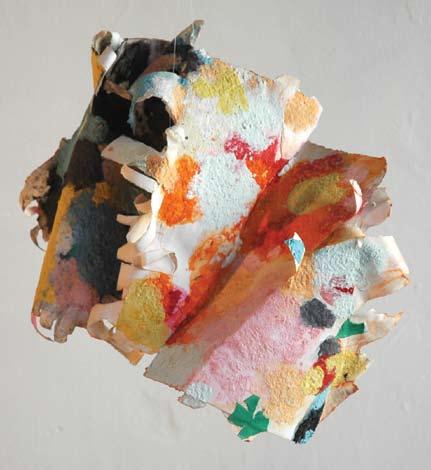
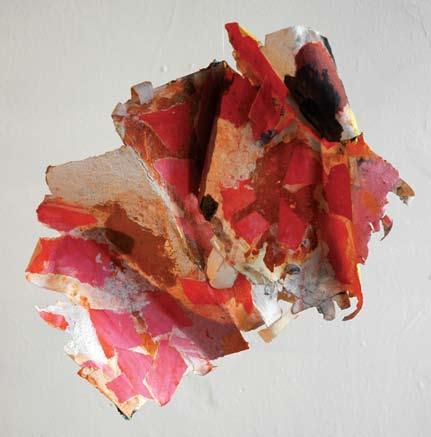
284 285 لايش� لىإا يمركت
40.5
Too Long, In Memory of Sheila, 2010.
Papier
maché 24 x 28 x 16’’, 61 x 71 x
cm. ةيمامأا ةيؤور ،ةطلاب Balata, front view, 2000. Papier maché, 11 x 17 x 6’’, 28 x 43 x 15 cm. ةيفلخ ةيؤور ،ةطلاب Balata, back view, 2000. Papier maché.
Return to the Rectangle: 2007-Onward Retour au Rectangle: après 2007
In 2007 while visiting Damascus with a Lebanese collector, Halaby approached Ayyam Gallery with a book devoted to her work that had been published a year before. Since the commercial art space was mostly focusing on Syrian art at the time, the artist did not expect anything to result from this initial introduction. Soon thereafter, however, she was asked to be a part of the gallery’s lineup of artists, who work mostly on large canvases. That same year, prior to meeting Khaled Samawai, Ayyam’s founder, Halaby had painted a series of gouaches on paper as she was spending time in Lebanon, Syria, Jordan and the West Bank. These works, along with her subsequent joining of Ayyam, prompted her return to the quadrilateral picture plane without reservation. She did so with new questions and insights in mind.

Halaby’s relationship with Ayyam has ignited a flurry of creativity from the artist. Although prolific throughout her career, having an outlet through which she has been able to sustain a consistent demand for new paintings has motivated her to creation without limitation. “Finally, I could paint and paint and did not have to stack the paintings. They were finding good homes. I could let creativity pour out without check” (Correspondence with the artist, 2010). The result has been a body of work that traverses the many experiments and findings that she has made over the past fifty years.
In preparation for a solo show with Ayyam in 2010, her latest series of paintings has emerged over a short period of time, yet it is her most mature work to date. Together these large, vivid canvases read like a visual essay on her career, hinting at previous breakthroughs and life-long influences. There are traces of Natalia Goncharova, a Russian avant-garde painter whom she has long-regarded, in “Light in Darkness” (2009, page 329), “Growing Wild” (2010, page 343) and “Night Cactus” (2010, page 346). In “Blue in Frames” (page 341) an octagram lies in the center of the canvas amidst a spiral of robust lines. Malevich’s dynamic shapes appear in areas of “Angels and Butterflies” (2010, page 355) and


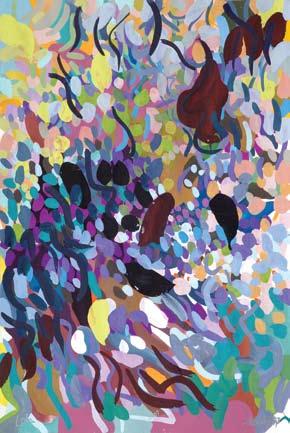
En 2007, en visitant Damas avec un collectionneur libanais, Halaby contacte la Galerie Ayyam avec un ouvrage sur son œuvre qui avait été publié l'année précédente. Comme la galerie d'art commerciale privilégiait principalement l'art syrien à l'époque, l'artiste ne s'attendait pas à ce que cette première rencontre aboutisse à quoi que ce soit. Peu de temps après, cependant, elle fut invitée à faire partie de la liste d'artistes de la galerie, qui travaillent principalement sur des toiles de grand format. La même année, avant de rencontrer Khaled Samawi, le fondateur d'Ayyam, Halaby avait peint une série de gouaches sur papier pendant qu'elle se trouvait au Liban, en Syrie, en Jordanie et sur la Rive Occidentale. Ces œuvres, ainsi que la décision de rejoindre Ayyam, l'amènent à revenir sans réserve au plan pictural quadrilatéral. Elle le fait avec de nouvelles questions et aperçus en tête.
Les relations de Halaby et d'Ayyam génèrent un bouillonnement de créativité de la part de l'artiste. Bien que prolifique tout au long de sa carrière, le fait d'avoir une débouchée par laquelle elle peut répondre à la demande constante pour de nouvelles œuvres la motive à créer sans limites. "Enfin je pouvais peindre et peindre et je n'avais pas besoin d'entreposer les tableaux. On leur trouvait de bonnes maisons. Je pouvais laisser la créativité se débrider sans limites."
(Correspondance avec l'artiste, 2010). Il en résulte un corpus d'œuvres qui reprend les nombreuses recherches et trouvailles qu'elle a faites au cours des cinquante dernières années.
Pour se préparer à son exposition en solo chez Ayyam en 2010, elle crée sa dernière série de tableaux en un court laps de temps, et pourtant il s'agit de son œuvre la plus mature à ce jour. Prises ensemble, ces grandes toiles éclatantes se lisent comme un essai visuel sur sa carrière, faisant allusion à des découvertes antérieures et aux influences amassées au cours d'une vie. Il y a des traces de Natalia Goncharova, une peintre de l'avant-garde russe qu'elle admire depuis longtemps, dans "Light to Darkness [De la Lumière vers le Noir]" (2009), "Growing Wild [Devenir Sauvage]" (2010) et "Night Cactus [Cactus de Nuit]" (2010). Dans "Blue in Frames [Bleu Encadré]" se trouve un octogramme placé au centre de la toile au milieu d'une
286 287
عورفو نا �غأ Twigs and Branches, 2007. Gouache on paper, 17 ½ x 12’’, 44 x 30.5 cm. ةرجش�لا ىلعأا في Up in a Tree, 2007. Gouache on paper, 19 ½ x 14’’, 49 x 35.5 cm. ةرجش�لا لخاد في Insid a Tree, 2007. Gouache on paper, 19 ½ x 14’’, 49 x 35.5 cm. بيرغ بنع Strange Grapes, 2007. Acrylic on canvas, 15 x 15”, 38 x 38 cm. Private collection.
in “Thunder Measuring Space” (2010, page 354), in resolutions that ground both compositions. And yet in paintings like “Thunder Measuring Space” we find remnants of Halaby’s helixes, the shading of her “diagonal flights,” and the freedom of her paper mache sculptures. In “Bamboo” (2010, page 353) we see the layered brushwork of graceful olive tree branches extended into slender lines as they take on new appearances. And in “Color Light Saturation” (page 339) we see the “city blocks” of New York or the “autumn leaves” of Connecticut given a brighter palette and sharper edges but still in motion with the same vigor.

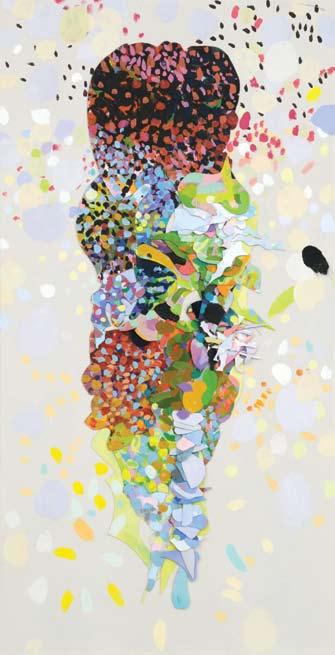


Years of experimentation, of conducting various trials and delving into intensive states of investigation have allowed Halaby to consistently challenge conventions while seizing new directions and always remaining international. Driven by a highly analytical mind, a unique sense of perception and a revolutionary understanding of art and society, she has fashioned an aesthetic that has never been stagnant, one that has continuously resided at the cutting-edge of painting and has engaged a wide spectrum of art.
spirale de lignes robustes. Les formes dynamiques de Malévich apparaissent dans des parties d' "Angeles and Butterflies [Angeles et Papillons]" (2010) et dans "Thunder [Orage]" (2010), dans des agencements qui ancrent les deux compositions. Toutefois, dans des tableaux comme "Thunder", on trouve aussi des restes des hélices de Halaby, les ombres de ses "Fuites Diagonales," et la liberté de ses sculptures en papier mâché. Dans "Bamboo [Bambou]" (2010) on reconnaît les couches successives de coups de pinceau des branches d'olivier gracieuses s'étendant en lignes minces tandis qu'elles prennent de nouvelles formes. Et dans "Color [Couleur]" on voit les "immeubles de la ville" de New York ainsi que les “feuilles d'automne” du Connecticut parés d'une gamme de couleurs plus vives et de contours plus nets mais toujours animés de la même vigueur.
Des années de questionnement, des expériences diverses et l'immersion dans les états intensifs de la recherche ont permis à Halaby de continuer de défier les conventions tout en s'engageant dans de nouvelles directions dans un esprit toujours international. Menée par un intellect très analytique, un sens unique de la perception et une interprétation révolutionnaire de l'art et de la société, elle s'est façonnée une esthétique qui ne reste jamais stagnante, une esthétique qui réside toujours à l'avant-garde de la peinture et qui fait appel à une grande variété de styles artistiques.
288 289 لي
ةدحاو One For Me, 2007. Acrylic on canvas collage, 28 x 32’’, 71 x 81.5 cm. Private collection.
ينطش�لف ءاش�ن ةلش�لش� ،ةلفط Child, Women of Palestine series, 2007. Acrylic on canvas collage, 36 ½ x 12 ½’’, 107 x 32 cm. Private collection.
❑
❑ ةقورش�لما نوتيزلا ةرجش� ةدوع Return of The Stolen Olive
رح ديرتج
Tree, 2007. Acrylic on canvas collage, 60 x 17 ½’’, 152.5 x 44.5 cm. Private collection.
Free Abstraction, 2007. Acrylic on canvas collage, 54 x 22’’, 137 x 56 cm. Private collection.
and Hannoun, 2007. Acrylic on canvas, 35 ½ x 90’’, 85 x 228.5 cm. Private collection.


"Overlaying artistic delight, tradition, and tragedy that are contained in Letters and Hannoun is the sense of a gentle walk in a garden that is richly planted with both humble and exotic flowers. Thus, beauty and a small touch of sadness mix in the painting. I accept this combination and think that it is typical of Arabs of our region; they too are like Hannoun, a bit wild, velvety soft, and tenacious beyond reason."
"Juxtaposé au plaisir artistique, à la tradition et à la tragédie qui sont présentes dans Letters and Hannoun [Lettres et Hannoun] se trouve le sentiment qu'on éprouve lors d'une promenade agréable dans un jardin luxuriant où poussent des fleurs humbles aussi bien qu'exotiques. Ainsi beauté et petites touches de tristesse se mélangent-elles dans la toile. J'accepte ce mélange et je pense qu'il est typique des Arabes de notre région; eux aussi sont comme Hannoun, un peu sauvages, doux comme du velours et tenaces jusqu'à en être déraisonnables."
"This painting might easily be called Sirocco. It is like a windstorm but without the discomfort. Its second title reflects my thoughts while painting it. Listeners to the wind seek words that may be carried by it. Its force becomes an entity of energy, a personality of material, a pattern of churning, organized and overwhelming, powerfully beautiful."
"Ce tableau pourrait aisément s'intituler Sirocco. Il est comme une tempête mais sans l'inconfort. Son deuxième titre reflète ce que je pensais pendant que je le peignais. Ceux qui écoutent le vent cherchent des mots qu'il puisse porter. Sa force devient une entité faite d'énergie, une personnalité faite de matériau, un motif fait de bouillonnement, structuré et irrésistible, puissamment beau."
290 291 نونحو فرحأ Letters
ةيداعلا راهزألاو تاتابنلاب ةينغ ةقيدح في فيطل يرش� ةباثبم يه "نونحو فرحأا" ةحول في ةدوجولما ايديجاترلاو ديلاقتلاو ،ةبلاغلا ةينفلا ةعتلما نإا " ،نونح ةرهز ايرثك نوهبش�ي مهنإ ؛انتقطنم في برعلل يجذونم هنأ دقتعأ و جيزلما اذه لبقأا .ةحوللا في نزلحا نم ةفيفخ ة �لم عم لاملجا جمدني اذكهو .ةبيرغلاو ".دح دعبأ لىإ نودينعو ،لمخلماك نومعانو لايلق نومحاج
رمحأا في � Red Summer, 2007. Acrylic on canvas, 48 x 58’’, 122 x 147.5 cm. Private collection. نوثحبي حيرلا لىإ نوغ �ي نيذلاف .اهمش�ر ءانثأ يراكفأا س�كعي نياثلا اهناونعو .اهجاعزإ لاب نكل ةف �اعلا لثم اهنإا .ين �املخا ةطا �ب لكب ىم �ت نأ ةحوللا هذهل نكيم " " .يقلتلما اهلامج رمغي ،ناروفلا نم اجذونمو ،ةدالما نم ةي �خش�و ،ةقاطلا نم انايك اهتوق حب �تو .اهلمتح دق يتلا تاملكلا نع
"Nature’s geometry contains an unevenness affected by weather and other forces. In Foliage, the all over distribution pattern is like the precise geometry of the city but its unevenness is like the geometry of nature. It is as though a man-made organization had gone to flower and is fluttering in the wind."
"La géométrie de la nature comprend des irrégularités apportées par le climat et d'autres forces. Dans Foliage [Feuillage], le motif de dissémination est comme la géométrie précise d'une ville mais son irrégularité est comme la géométrie de la nature. C'est comme si une structure faite de main d'homme avait fleuri et se balançait dans le vent."
فيترمح في ةيبرلا Wilderness in My Studio, 2007. Acrylic on canvas, 60 x 80’’, 152.5 x 203 cm. Private Collection.

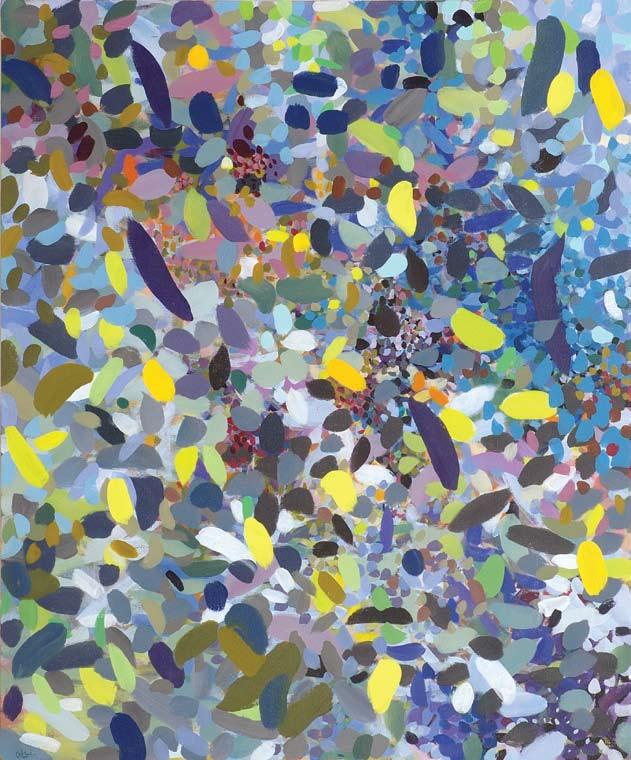
"I spent five intense days painting ancient olive trees. They seemed to impart sad wisdom and take me into their circle. It was this state of mind that was poured into Wilderness in My Studio Textures of Palestine’s mountains and vegetation emanate from its core. Things that live in hostile environments have a beauty different from that of lush vegetation."
"J'ai passé cinq jours intenses à peindre d'anciens oliviers. Ils semblaient vouloir partager une triste sagesse et m'inviter dans leur cercle. C'est cet état d'esprit qui s'est déversé dans Wilderness in My Studio [Nature Sauvage dans Mon Atelier]. Des textures des montagnes et de la végétation de Palestine émanent de son cœur. Les choses qui vivent dans un environnement hostile ont une beauté différente de celle de la végétation verdoyante."
292 293 رجش�لا قاروأ Foliage 2007. Acrylic on canvas, 58 x 48’’, 147.5 x 122 cm. Private collection. س�قطلا يرثأ ت نع تجانلا ماظتنل مدع نم ءيش� ىلع ةعيبطلا ةش�دنه يوتتح " ةقيقدلا ة �دنهلا لثم وه يلكلا عزوتلا طنم ، "رجش�لا قاروأ " في .ىرخأ ىوقو همظن ءيش� اهنأ ول امك .ةعيبطلا ةش�دنه يكاحي اهيف ماظتنلا مدع نكل ةنيدملل ".حايرلا في فرفري ذخأ و رهزأ ف ناش�نإلا
امك . " فيترمح في ةيبرلا " في تبك � يتلا ةينهذلا ةلالحا يه كلت تناك دقل .اهيعارذ لي حتفت يهو ةنيزح ةمكح عش�ت تناك .ينط �لف في ةرمعم نوتيز راجش�أ مش�رأ انأ و ةفثكم مايأ ةش�مخ تي �ق " ".ةبش�لخا تائيبلا في س�يعت يتلا كلت نع فلتمخ لامجب عتمتت ءادرج تائيب في س�يعت يتلا ءايش�ألاف .اهبلق نم ناثعبني يتابنلا اهئاطغو ينطش�لف لابج س�ملم نأ
"It was time to do a dark blue on blue painting and as I did it, it turned to night and trees. Trees illuminated by artificial light in cities have colors whose beauty has always spoken to me. I especially love trees at night in New York’s Chinatown. Our Nights is a painting for people who love each other and can say this is like the unseen tenderness of their nights."

"Le moment était venu de faire un tableau bleu foncé sur bleu, et quand je l'ai fait, il s'est mué en nuit et arbres. Les arbres illuminés par l'éclairage artificiel des villes ont des couleurs dont la beauté m'a toujours parlé. J'aime particulièrement les arbres la nuit dans Chinatown à New York. Our Nights [Nos Nuits] est un tableau pour les gens qui s'aiment et qui peuvent dire que cette toile est pareille à la tendresse cachée de leurs nuits."

294 295 يرفا �علا عم نوق تح مكنأا اوليخت ،ةباغلا ءاوه Forest Air, Imagine Flying with Birds, 2007. Acrylic on canvas, 42 x 48’’, 106.5 x 122 cm. Private collection. انيلايل Our
167.5
ينبطاخ الماط ةي �و �خ اهل ندلما ليايل في يعانطش�ا ءو �ب ةرانلما راجش�ألاف .راجش�أ و ليل لىإ تلوتح ،اهتم �ر امدنعو قرزألا نم تاجردب ةنكاد ةحول م �رل ناح دق تقولا ناك " ".مهيلايل في يفلخا نانلحا لثم كلذ نأ لوقلا نوعيطتش�يو ،ا �عب مه �عب نوبحي نيذلا س�انلل ةحول يه "انيلايل " نإ .كرويوين في نوات انياش�ت ليل في ش�وش�خ راجش�ألا بحأا انأاو .اهلامج
Nights, 2007. Acrylic on canvas, 48 x 66’’, 122 x
cm. Private Collection.
"Like handwriting, there is in painting a touch that is unique in small ways to each different hand. This painterly handwriting can become a deadening force that blocks the expressive potential of brush marks to describe more complex visual thought. In Pieces of the Sky it is the invisibility of my painterly handwriting that pleases me. The sky blues and blue-greens over the saturated reds simulate reflections of the sky on a sunny day, like pieces of blue highlights over redness. It is a play between sunlight turned cool blue by being reflected from the atmosphere that we call sky, and warm sunlight coming directly through it."
"Comme en écriture, il y a en peinture une touche individuelle, qui est unique et dont les détails diffèrent d'une main à l'autre. Cette écriture à coups de pinceau texturés peut devenir une force abrutissante qui bloque le potentiel expressif des traits de pinceau, les empêchant de décrire une pensée visuelle plus complexe. Dans Pieces of the Sky [Morceaux de Ciel], c'est l'invisibilité de mon écriture texturée qui me plaît. Les bleus ciel et les bleu-verts sur fond de rouges saturés reproduisent les reflets du ciel par une journée ensoleillée, comme des éclats de bleu sur du rouge. C'est un jeu entre la lumière du soleil qui se mue en bleu clair lorsqu'elle se reflète dans l'atmosphère, ce que nous appelons le ciel, et la lumière chaude du soleil qui passe directement à travers."
"In the early stages of abstraction, during the 20th century, paintings were of single formal ambiances. Exploration varied between hard-edged, geometric space and painterly space full of gestural brushing. In searching for a guide that would lead to a next step, I noted how the softer space of trees combined with the hard space of architecture in cities. This ambition was partly met by the collaged group of paintings free of the stretcher. But the idea is more fully realized in River Turning I pushed the space to contain different adjacent events."
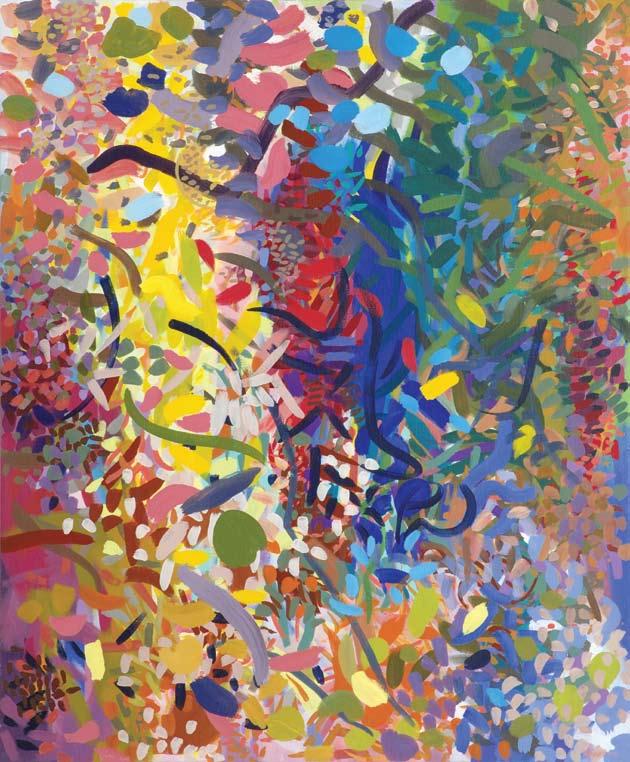
"Aux débuts de l'abstraction au 20ème siècle, les tableaux étaient d'ambiance formelle unique. Les recherches variaient entre des espaces géométriques "hard-edge" et de l'espace texturé plein de grands gestes et coups de pinceau. En cherchant un guide qui m'amènerait à l'étape suivante, j'ai remarqué la façon dont les espaces plus doux des arbres se mêlaient à l'espace plus brutal de l'architecture dans les villes. L'ambition de rendre ceci a partiellement été réalisée dans le groupe de tableaux en collage non étirés sur un châssis. Mais l'idée est plus aboutie dans River Turning [Coude de la Rivière]. J'ai repoussé les limites de l'espace pour lui permettre de contenir des événements adjacents différents."

296 297 ءامش�لا نم عطق Pieces of the Sky, 2007. Acrylic on canvas, 57 ¾ x 48’’, 146.5 x 122 cm. Private collection. اهحنتمو فيفط لكش�ب نإاو دي لك زيتم مش�رلا في ة �لم كانه ،ديلا طخ لاح وه امك " يربعتلل ةاش�رفلا تابر �ل ةييربعتلا ةقاطلا نم دتح نأا نكيم ة �مللا كلت نإ .اهدرفت يرغ يتاش�لم نوك وه نيدعش�ي ام ، " ءامش�لا نم عطق " في .ىنغ ثركأ ةير �ب ةركف نع في ءامش�لا تاش�اكعنا يكاتح ةحير �لا ءارملحا ناولألا قوف ءاقرزلا ناولألاف .ةيئرم " .س�مش�م موي
رهنلا فافتلا River Turning, 2007. Acrylic on canvas, 57 ¾ x 48’’, 146.5 x 122 cm. Private collection. ةدحوم ةحوللا تناك ،نيرش�علا نرقلا للاخ ديرجتلا نم ةركبلما لحارلما في " ءاش�فلاو ،ةمرا �لا هدودحب ي �دنهلا غارفلا ينب تافاش�كت �ل تعونت دقو .ءاوجألا ةوطلخا لىإا نيدش�ري امع يثحب ءانثأاو .ةيئايمإلا ةاش�رفلا تابر �ب ءيللما نرلما في ةرامعلل ي �اقلا غارفلا عم راجش�ألا ةنرلما تاغارفلا لخادتت فيك تظحل ،ةيلاتلا جلوكلا تاحول ةعوممج للاخ نم ةيئزج ةرو �ب حومطلا اذه ةيبلت ترج دقو .ندلما " رهنلا فافتلا " في لماك لكش�بو اققتح ثركأ ةركفلا نكل .دش�لا راطإ نم ةررحتلما " .ةرواجتم ةفلتمخ اثادحأ م �ي غارفلا تلعج دقل
"In October of 2007 I visited Vancouver Island off the western coast of Canada and drove past rivers where salmon spawn. There were many wonderful calm pools off the main river where the beauty of all that lay at the riverbed was visible in shinning clarity, unreachable like something precious and protected. Spawning Pool is in two vague sections each with two more, and all like imperfect reflections of each other. Some groups of marks limit themselves to specific areas while other groups travel over the whole as though floating midway through the water of a pool. The brightness of the colors and the clarity of the painting alluded to the spawning pools I had just seen, a metaphor for the birth of ideas and natural procreation."
"En octobre 2007 j'ai visité l'Ile de Vancouver au large de la côte ouest du Canada et je suis passée en voiture le long de rivières où fraient les saumons. Il y avait beaucoup de bassins calmes près du bras principal de la rivière où l'on pouvait voir la beauté de tout ce qui se trouvait dans le lit de la rivière dans une clarté brillante, inaccessible comme quelque chose de précieux et de protégé. Spawning Pool [Bassin de Ponte] est divisée en deux sections grossières qui contiennent chacune deux sections de plus, toutes comme des reflets imparfaits l'une de l'autre. Certains groupes de marques se limitent à des zones spécifiques tandis que d'autres groupes traversent l'ensemble comme s'ils flottaient à mi-hauteur dans l'eau d'un bassin. L'éclat des couleurs et la clarté du tableau font allusion aux bassins de ponte que j'avais juste vu, comme une métaphore de la naissance des idées et de la procréation naturelle."
"One of the pleasures of painting is receiving people in the studio and listening to their comments. Although many are made nervous finding themselves in such a situation, fortunately some speak freely. Essence of Arab was a difficult painting and at first all who came to see it disliked it. It gestated for two months in my studio exchanging location with Light Between (page 301) which was also a difficult painting to complete. Eventually something beautiful was being born in it, something visually Semitic. The desert, wide spaces, woven patterns, colors of night all seemed to join to make this an essence of something Arab. I did not reject the sensation and thus titled the painting."
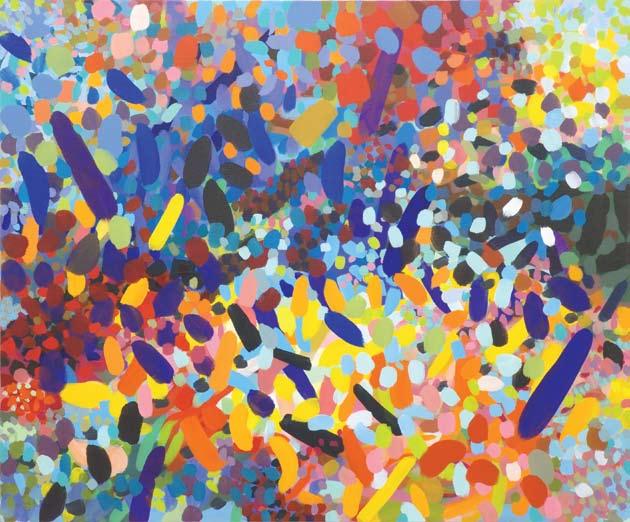
"Un des plaisirs de la peinture est de recevoir des gens dans l'atelier et d'écouter leurs réactions. Bien que beaucoup trouvent cette situation intimidante, heureusement certains parlent librement. Essence of Arab [L'Essence de l'Arabe] était une toile difficile et au début aucun de ceux qui sont venus la voir ne l'aimaient. Elle est restée en gestation pendant deux mois dans mon atelier, changeant de place avec Light Between [Lumière dans l'Intervalle] (page 301) qui était aussi une toile difficile à terminer. Finalement, quelque chose de beau en est sorti, quelque chose de visuellement sémite. Le désert, de grands espaces, des motifs tissés, les couleurs de la nuit, tout semblait se mêler pour en faire l'essence de quelque chose d'arabe. Je n'ai pas rejeté cette sensation et j'ai donc ainsi intitulé le tableau."

298 299 ➤ ةبورعلا حور Essence of Arab, 2007. Acrylic on canvas, 60 x 80’’, 152.5 x 203 cm. Private collection. .مهتاقيلعت لىإا ءاغش�إلاو فترحلما في س�انلا لابقت �ا يه م �رلا عتم ىدحإ " ع �و في مهش�فنأا نودجي امدنع رتوتلاب نورعش�ي س�انلا نم ايرثك نأ مغر ىلعو ةحول "ةبورعلا حور " تناك دقل .ةيرحب ثدحتي ظلحا نش�لح مهش�عب نكل ،اذهك تلدابتو فيترمح في ومنت تلظ ثيح .اهتيؤ رل ءاج نم لك ةيادبلا في بجعت لم ةبع � .اهلامكإا تبع �تش�ا ةحول ىرخألا يه تناك يتلا )301 س�( "ينيب ءوش� " عم عقاولما ايرش�ب )ةيماش�لا نم( يماش� ءيش� ،اهيف دلوي ليمج ءيش� ناك ،فاطلما ةياهن في اهنأ كو اعيمج تدب ليللا ناولأ و ،ةكاحلما طانمألاو ،ةع �اولا تاحا �لماو ،ءارحش�لاف تيم �أاو س�ا �حإلا س�فرأ لم كلذل .يبرع ءيش�ل ارهوج كلذ لعتج يك ايو � عمتتج " .كلذك ةحوللا
رهنلا س�اوحأ Spawning Pool, 2007. Acrylic on canvas, 47 ½ x 57’’, 120 x 145 cm. Private collection. .نومل �لا كم � هيف س�يبي يذلا رهنلا ةاذاحبم تررمو ادنكل يبرغلا لحا �لا ةلابق ةعقاولا رفوكناف ةريزج ةرايزب تمق 2007 )ربوتكأ ( لوألا نيرش�ت في" .يممحو ينمث ءيش� لثم لانلما ديعب هنأا ادبو ،عطا � حوش�وب رهنلا عاق ىلع ام لك لامج اهيف ىلتج رهنلا فيرط ىلع ةعئارلا س�اوحألا نم ديدعلا كانه ناك تابر � س�عبو س�عبلا اه �عبل ةلماك يرغ تاش�اكعنا اهعومجبم لكش�ت ثيحب ،ىرخأ ةيئانث نم ءزج امهنم لك م �ي ،ةش�ماغ ةيئانث في يه "رهنلا س�اوحأا" ةحوللا حو �وو ناولألا عوط � يحوي ينح في س�ولحا هايم ط �و وفطت اهنأ ول امك لكلا ىلع ىرخأا تابر � دتتم ينح في ةنيعم قطانم في اهش�فن دتح ةاش�رفلا ".يعيبطلا بانجإلاو راكفألا ةدلو نع ةيانك يهو ،يوتل اهتيأار يتلا كمش�لا س�يب س�اوحأ ب
"If you collect disparate fragments of brown material and bring them together, you will note some to be reddish, some bluish, some greenish etc. You will have a hard time selecting the perfect brown and the same is true of gray. I used grays and browns in Wind in Brown Trees with small surprising touches of strong color hidden here and there. The principle of a field with small surprises is available in nature everywhere. Fruits and flowers are delightful semi-rare occurrences of this type. Palestinian embroidery also embodies this quality. Red is the field color while bits of other bright colors are scattered in unpredictable ways over a predictable geometric pattern of the red."
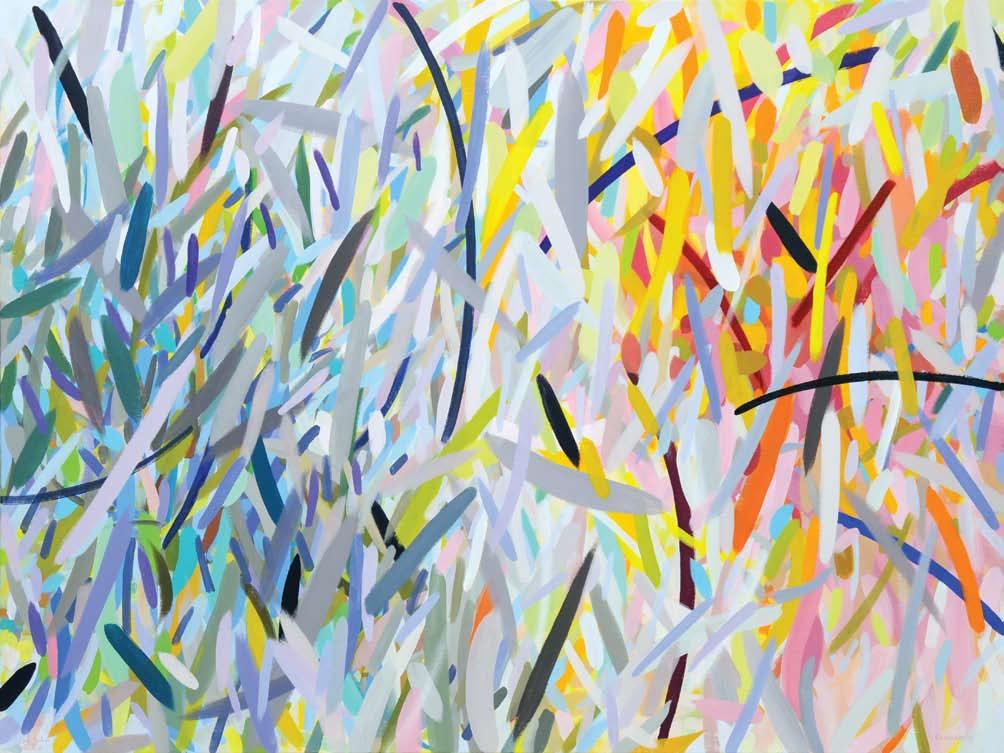
"Si vous amassez des fragments épars de matériau brun et que vous les mettez ensemble, vous remarquerez que certains sont rougeâtres, d'autres tirent sur le bleu, ou le vert etc. Il vous sera très difficile de choisir le brun parfait, et la même chose vaut pour le gris. J'utilise les gris et bruns dans Wind in Brown Trees [Vent dans les Arbres Bruns] avec de petites touches surprenantes de couleurs vives cachées ça et là. On retrouve ce même principe d'un champ avec des petites surprises partout dans la nature. Les fruits et les fleurs sont des exemples merveilleux plus ou moins rares de ce phénomène. La broderie palestinienne incarne aussi cette qualité. Le rouge est la couleur du champ tandis que des touches d'autres couleurs sont éparpillées de façon imprévisible sur un motif géométrique prévisible de rouge."
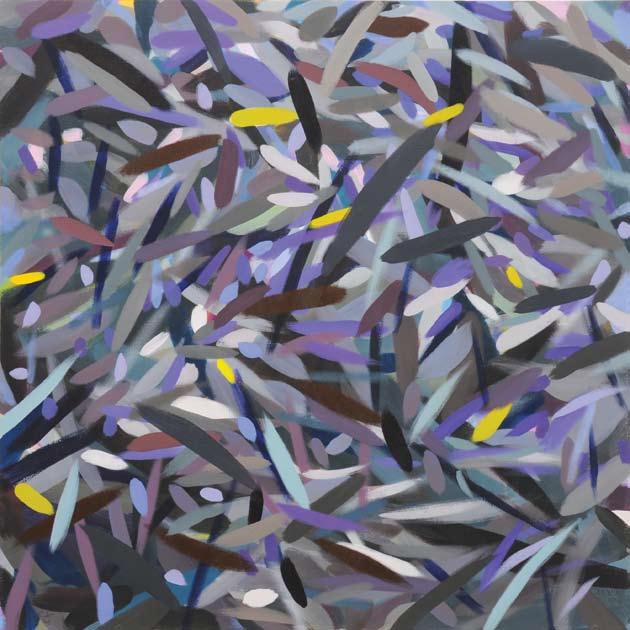
300 301 ينيب رون Light Between, 2007. Acrylic on canvas, 60 x 80’’, 152.5 x 203 cm. ةينب راجش�أا في حير Wind in Brown Trees, 2008. Acrylic on canvas, 48 x 48’’, 122 x 122 cm. Private collection. ،ةرملحا لىإ لئام اه �عب نأ ظحلاتش� ،نوللا ةينب ةعونتم ءايش�أا عمجب تمق اذإ " ،ينبلل يجذومنلا نوللا اهيأ ديدتح في ةبوع � دجت �و .خلإ ،ارش�مخ وأ ،ةقرزلا وأ حير " في ةينبو ةيدامر اناولأ تمدخت �ا انأا .يدامرلل ةبش�نلاب ا �يأ حش�ي رمألاو بخلما يوقلا نوللا نم ةعقوتلما يرغ ةيرغ �لا تا �مللا س�عب عم ، "ةينب راجش�أا في .ناكم لك في ةعيبطلا في هارن ادبم وه ةذاش� ءايش�أ هللختت لقح دوجوف .كانهو انه يوتحي ينيطش�لفلا زيرطتلا نفو .امود اهارن ل ةعتمم ثداوح يه روهزلاو ةهكافلاو ناولأ نم ءازجأ هيلع عزوتتو مظنلما لقلحا نول وه رمحألا .ةيش�وش�لخا هذه ىلع " .ليحكتلا ىمش�ت ةمظتنم يرغ ةقرش�م
"Relativity of Light and Dark is the third and most delicate black and white painting that I have made. The first time I tried a black and white painting, I could not resist adding color in scattered patches all over the black and white background. It was in 1983 and I called it City Nights (page 141). To limit painting to black and white and succeed is a rigorous test to someone who loves color; but it also has its own beauty. It is how someone who is totally color blind sees things. The rest of us can see this way under sodium illumination which emits light in only one wavelength."
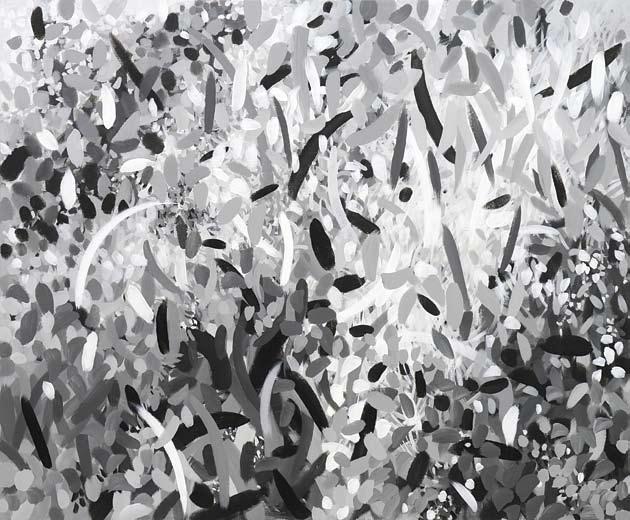
"Relativity of Light and Dark [La Relativité de la Lumière et de l'Ombre] est le troisième tableau en noir et blanc que j'ai fait, et le plus délicat. La première fois que j'ai essayé un tableau en noir et blanc, je n'ai pu m'empêcher d'ajouter de la couleur en touches disséminées sur tout le fond noir et blanc. C'était en 1983 et je l'ai nommé City Nights [Nuits de la Ville] (page 141). C'est un examen rigoureux pour quiconque aime la couleur que de limiter le tableau au noir et blanc et de réussir; mais cela a aussi sa propre beauté. C'est la façon de voir les choses de quelqu'un qui est totalement daltonien. Nous autres pouvons voir de cette façon sous l'éclairage au sodium qui n'émet de lumière que sur une seule onde."
"Little Tree in Sunlight started as yet another attempt to paint the color purple. Something brave was needed to challenge its dullness, maybe a strong yellow. Memory of a young tree I had once painted guided making the shocking yellow organically belong to the dark purple. One summer while vacationing in West Virginia, I saw a young maple tree in strong light. It was like a gangly teenager, bright with yellow-green freshness. It stood alone on a manicured lawn, against a tall background of dark evergreens."
"Little Tree in Sunlight [Petit Arbre sous le Soleil] a commencé comme une nouvelle tentative de peindre la couleur violette. Il me fallait du courage pour défier son manque d'éclat, peut-être un jaune vif. Le souvenir d'un jeune arbre que j'avais autrefois peint m'a amenée à faire en sorte que le jaune éclatant fasse un tout organique avec le violet foncé. Un été lorsque je passais des vacances en West Virginia, j'ai vu un jeune érable fortement éclairé. Il était comme un adolescent dégingandé, éclatant de fraîcheur jaune-verte. Il était seul sur une pelouse impeccable, sur un fond de hauts conifères sombres."

302 303 ملاظلاو رونلا ةيبش�ن Relativity of Light, 2008. Acrylic on canvas, 47 ¼ x 57’’, 120 x 145 cm. ،دو �ألاو س�يبألاب ةحول م �ر اهيف تلواح يتلا لىوألا ةرلما في .اهنيب ةي �اش�ح ثركألاو دوش�ألاو س�يبألاب اهتمش�ر ةحول ثلاث يه "ملاظلاو رونلا ةيب �ن " نإا " ةحوللا ر �ق نإا .)141 ةحفص�( "ةنيدلما ليايل " اهتيم �أ و 1983 ماع كاذ ناك .ءا �يبلاو ءادوش�لا ةيفللخا ىلع ةثرعبم عقرب ناولألا ةفا �إا ةمواقم عطتش�أ لم لماك ناولأ ىمع هيدل س�خش� ةيؤور ةيفيك هبش�ي كلذف ا �يأ هتيلامج رمألا نكل ناولألا بحي س�خش�ل مرا � رابتخا وه حاجنلا قيقتح عم س�يبألاو دو �ألا ىلع " .طقف دحاو يجوم لوطب ءو �لا ثبت يتلا مويدو �لا ةرانإ تتح ةقيرطلا هذهب ةيؤورلا نوعيطت �ي انتيقب .ءايش�ألال
س�مش�لا ءو � في ةيرجش� Little Tree in Sunlight, 2008. Acrylic on canvas, 71 x 71’’, 180 x 180 cm. Private collection. ةيكليل ةحول م �رل ىرخأ ةلوامح ش�يأ "س�مش�لا ءو � في ةيرجش� " تناك دقل " .يوقلا رفش�ألاب ابمر ،هتباتر يدحتل ةعاجش�لا نم ءيش�ل ةجاح ةمث ناك .نوللا يمتني يوقلا رف �ألا لعج لىإا تداقو اموي اهتم �ر ةيتف ةرجش�ل يركذت نيدعاش� دقو تيأ ر ،اينيجرف ت �يويف ةلطعلا ي �قأ تنك امنيبو في � تاذف .قماغلا يكليللا لىإ ىلع اهدحو ةفقاو تناك .ةعناي ءار �خ ،ينقهارم هبش�ت تناك .يوق ءو � في ةيرجش� " .ةقماغلا ةر �لخا ةمئاد ةقماغلا راجش�ألا نم ةيفلخ تدب اهءاروو ،ناتش�بلا را �خ
➤
"Thinking of the complex curves of tree branches and Arabic calligraphy helped me to avoid the automatic circular motion of my arm. They guided my ambition in Purple Nest to use lines dancing counter to each other’s movements. The result was a cocoon of brush marks with hints of blue sky or blue lakes at the corners, as though a panda had created a nest in a purple bamboo forest."
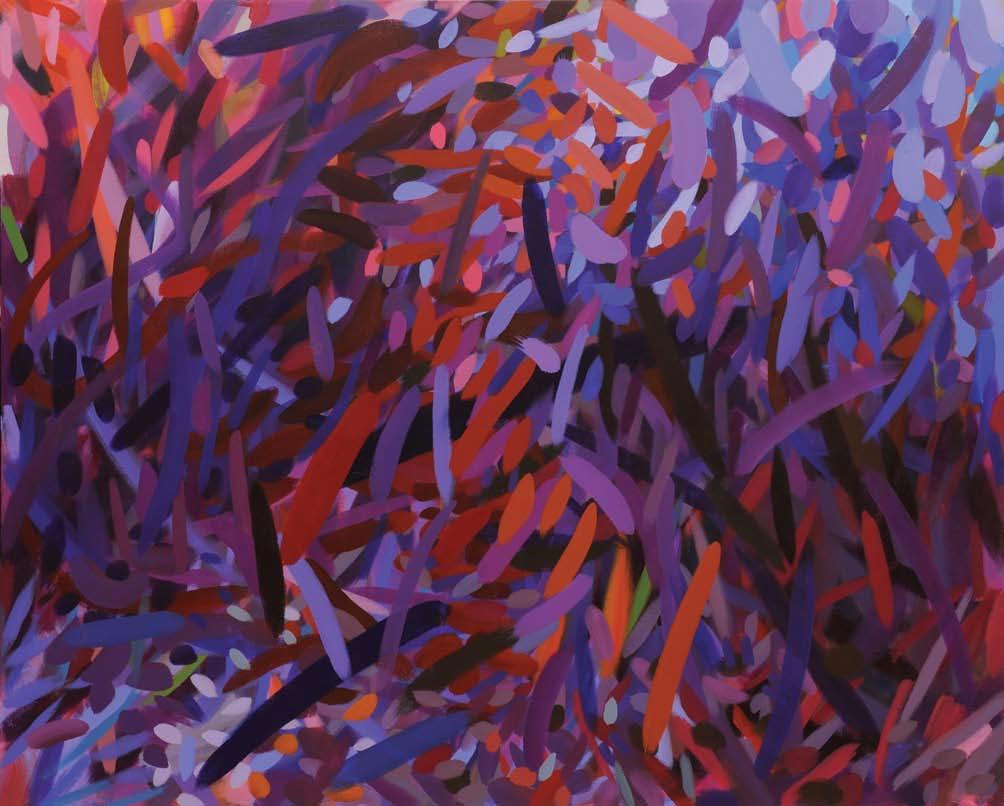
"Le fait de penser aux courbes complexes des branches d'arbre et à la calligraphie arabe m'a aidé à éviter les mouvements circulaires automatiques de mon bras. Elles sont à l'origine de mon désir d'utiliser dans Purple Nest [Nid Violet] des lignes qui dansent selon des mouvements en contrepoint. Il en résulte un cocon de traits de pinceau avec des traces de ciel bleu ou de lacs bleus dans les coins, comme un panda qui aurait fait son nid dans une forêt de bambou violet."
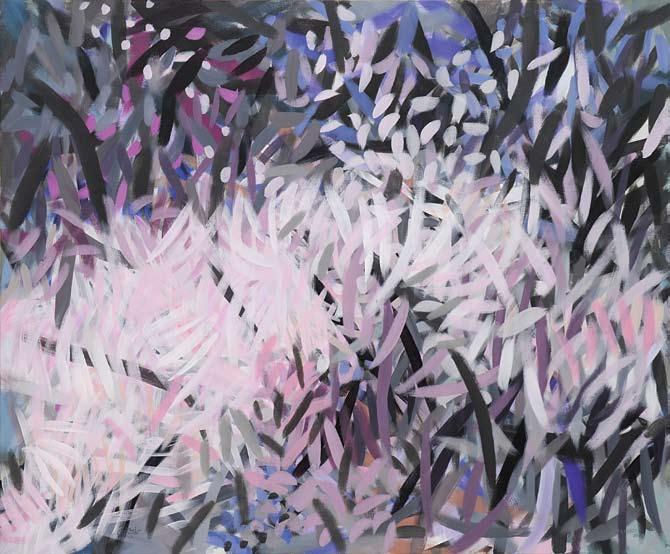
304 305 يرهزو يدامر Grey and Pink, 2008. Oil on canvas, 48 x 58'', 122 x 147.5 cm. Private collection. ➤ يك يل س�ع Purple Nest, 2007. Acrylic on canvas, 57 x 71’’, 145 x 180 cm. س�ع " في يحومط اهجو دقف .يديل ةيتاذلا ةيرئادلا ةكرلحا يش�اتح ىلع يبرعلا طلخاو راجش�ألا ناش�غأل ةكباش�تلما تاينحنلما في يركفتلا نيدعا � " تايرحب وأ ءاقرزلا ءام �لا نم تاحلم عم ةاش�رفلا تابرش� نم ةقنرش� تناك ةجيتنلاو .س�عبلا اهش�عب تاكرح س�كع س�قاترت ةليوط طوطخ مدختش ا يك "يكليل " .يكليل نارزيخ ةباغ في اش�ع تنب دق ادناب نأ ول امك ،اياوزلا في تاواقرز
"Adjacent Gardens is a pivotal work between the previous series of paintings free of stretchers and paintings back on the rectangular stretcher. It was first completed as canvas and paper collage with an irregular perimeter. On a whim, I placed it on a stretched piece of bleached linen and it looked good. I glued it on to the canvas and began work again. I allowed the boundary of the finished free-shape painting to compete in importance with the rectangular frame of the painting. What was inside the perimeter of the first stage gave birth to all the additions outside the perimeter. This alerted me to possibilities of allowing collaged parts to radiate influences to their surroundings, like seeds that germinate, grow, and spread."
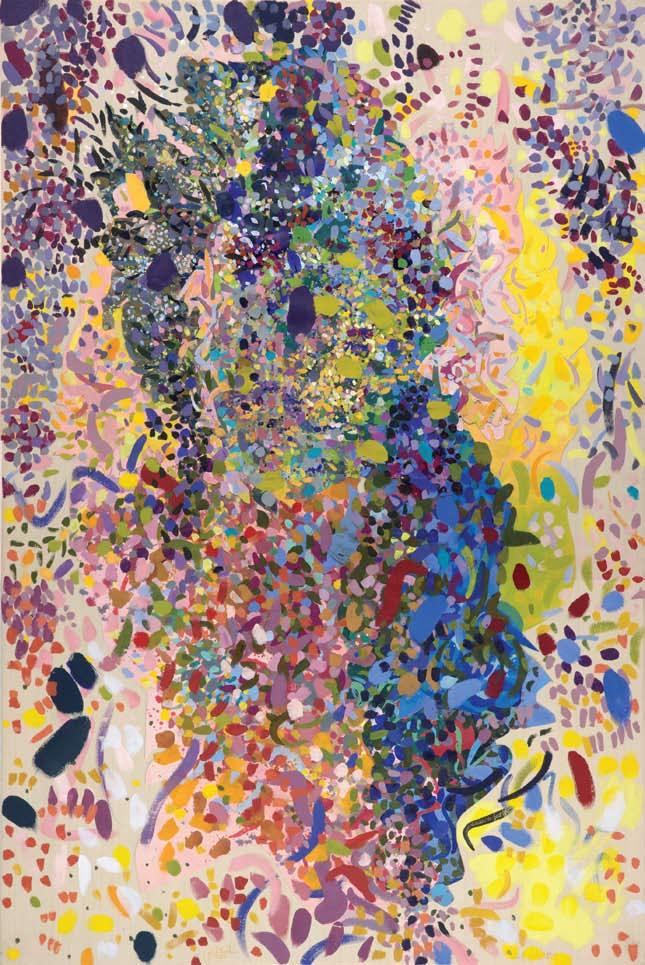
"Adjacent Gardens [Jardins Adjacents] est l'œuvre charnière qui fait la transition entre la série précédente de toiles non étirées sur un châssis et les nouvelles toiles qui réutilisent le châssis rectangulaire. Elle a tout d'abord été conçue comme un collage papier-toile aux bords irréguliers. Sur un coup de tête, je l'ai placée sur une toile de lin blanchie étirée, et ça rendait bien. Je l'ai collée sur la toile et j'ai recommencé à travailler dessus. J'ai laissé les contours du tableau terminés de forme libre rivaliser d'importance avec le cadre rectangulaire du tableau. Ce qui était à l'intérieur du périmètre du premier stade de l'œuvre est à l'origine de toutes les additions hors de ce périmètre. C'est ce qui m'a rendue consciente des possibilités engendrées par le fait de laisser les parties en collage influencer ce qui se trouve autour d'elles, comme des graines qui germent, croissent et se disséminent."

306 307 ➤ اهتبوش�لخ ةايلحا اوعد ،رادلجا اورمد Demolish the Wall, Let Life Be Fertile, 2007. Acrylic on canvas collage, 56 x 59’’, 142.5 x 150 cm. Private collection. ةرواجتم قئادح Adjacent Gardens, 2007. Acrylic on canvas collage, 72 x 49’’, 183 x 124.5 cm. Private collection. ةررحتلما ةقباش�لا تاحوللا ةل �لش� ينب ل �افلا يروحلما لمعلا وه "ةرواجتم قئادح "" ل ا اهتمتمأ دقو .ليطتش�لما دش�لا لكيه لىإ تداع يتلا تاحوللاو دش�لا لكيه نم ةدودش�م ةعطق ىلع اهتع �و ،يتاوزن ىدحإ فيو .ةرح دودحبو قرو جلوكو س�امقك نم لمعلا تأادبو س�امقلا ىلع اهتقش�لأ اذكهو .ةعئار تدب دقو س�يبلما ناتكلا نم عم ةيمهألا في س�فانتت نأ ب رلحا لكش�لا تاذ ةيهتنلما ةحوللا دودلح تحم �و .ديدج جراخ تافا �إلا ةفاك دلو لىوألا ةلحرلما دودح لخاد ناك امو .ةحوللا ليطتش�م دودح في اهذوفن رش�نت نأا ةفاش�م ءازجأل حامش�لا ةيناكمإا لىإ اذه ينهبن دقو .دودلحا " .رش�تنتو ومنتو تبنت يتلا روذبلا لثم ،اهطيمح
"This painting started with lines that moved from one edge of the rectangle to the opposite one, from top to bottom. I varied the motions of the brush in speed and curve to imitate branching and dancing. I forced a variety of marks to be born on most of the lines. It looks like a wild prairie, almost like a photographic type of illusion, because it successfully imitated a small attribute of growth. But Wild Prairie in Autumn however, is abstract, an extract from nature."
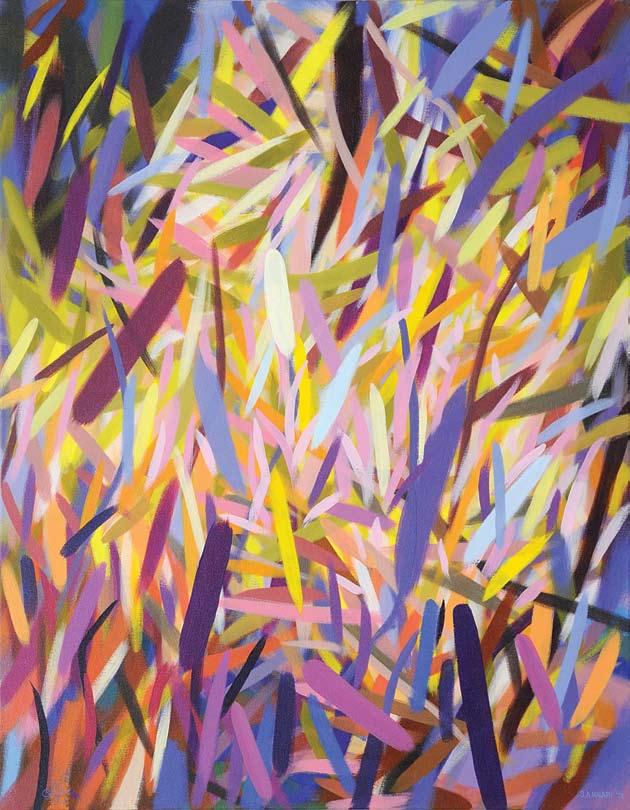
"Cette toile a commencé par des lignes qui se mouvaient d'un bord à l'autre du rectangle, de haut en bas. J'ai varié les mouvements du pinceau, leur vitesse et leurs courbes pour imiter des embranchements et la danse. J'ai forcé toutes sortes de traces à surgir de la plupart des lignes. La toile ressemblait à une prairie sauvage, presque comme une illusion de type photographique, parce qu'elle réussissait à imiter un petit attribut de la croissance. Mais Wild Prairie in Autumn [Prairie Sauvage en Automne]est une toile abstraite, un extrait de la nature."
2 مكبولق في رون Light in Your Heart II, 2008. Acrylic on canvas, 46 x 36’’, 117 x 91.5 cm. Private collection.
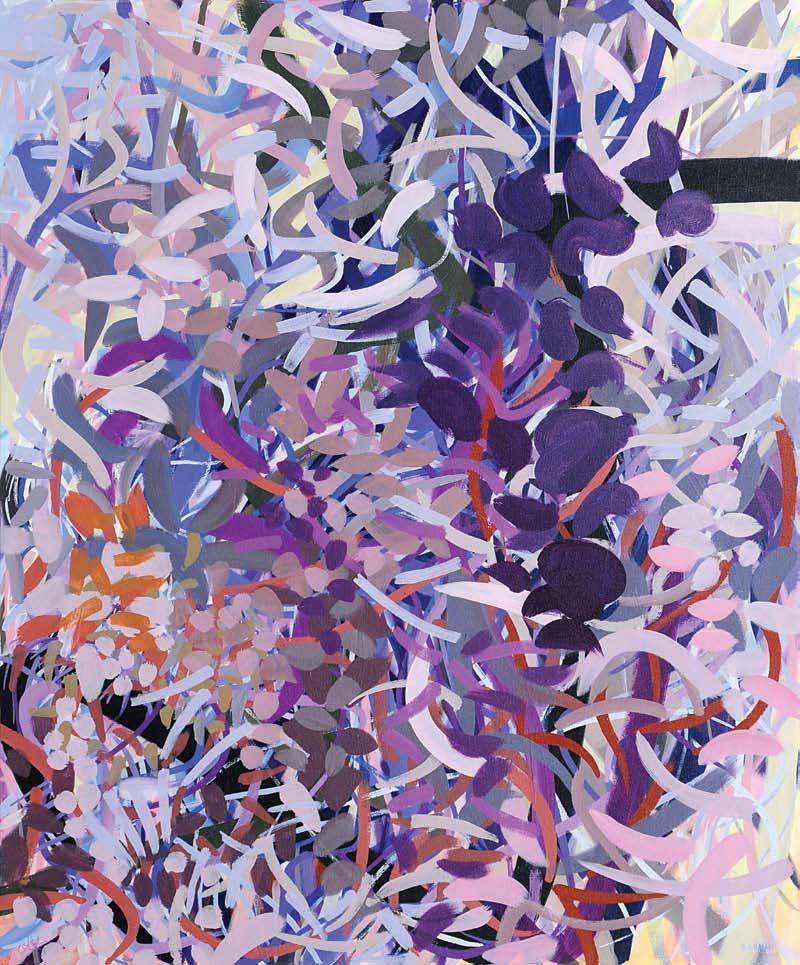
"I wanted Light in Your Heart II to be like a blossoming dogwood in a deep dark forest. The blossoming white tree kept eluding me while a warm light resembling the soft, warm colors of evening kept emerging. It evoked an interior space rather than an outdoors one, a space that I imagined was like a gift of affection."
"Je voulais que I wanted Light in Your Heart II [Lumière dans Ton Cœur II] soit comme du cornouiller en fleur dans une forêt sombre. L'arbre aux fleurs blanches ne cessait de se dérober tandis qu'une lumière tiède qui ressemblait aux couleurs douces, tièdes du soir émergeait doucement. Elle évoquait un espace intérieur plutôt qu'extérieur, un espace dont j'imaginais qu'il était offert en gage d'affection."
308 309 ➤ فيرلخا في ةيرب Wild Prairie in Autumn, 2008. Acrylic on canvas, 57 x 47 ¼’’, 145 x 120 cm. ،ةلباقلما ةفالحا لىإ ليطتش�لما فاوح ىدحإا نم تكرتح طوطخب ةحوللا تأ دب " ءانحنلاو ةعر �لا ثيح نم ةاش�رفلا ةكرح في تعون دقو .لف �ألا لىإا ىلعألا نم نأا ىلع تابرش�لا نم ةعونم ةعوممج تبرجأا دقو .س�قرلاو نا �غألا عرفت دلقأ يك ،يمهو يريوش�ت عون لثم ابيرقت ،ايرب لاه � هبش�ت يهو .طوطلخا مظعم ىلع دلوت ةاحوتش�م يهو ،ةيديرتج "فيرلخا في ةيرب " نأ يرغ .ومنلل ةيرغش� ةمش� تدلق اهنأل " .ةعيبطلا نم
ةملظم ةباغ في ةحتفتم ةرجش� لثم نوكت نأا "2 مكبولق في رون " ةحولل تدرأ " ناولأ ك ئفاد ءوش� لظ ينح في ،ينغوارت ةحتفتلما ءاش�يبلا ةرجش�لا تلظو .ةقيمع ءا �ف ،ايجراخ س�يلو ايلخاد ءا �ف ترش�حتش�ا دقو .قثبني ةئفادلا ةمعانلا ءا �لما " .ةفطاعلا نم ةيده لثم هتليخت
"The colors of artificial lighting in city neighborhoods and shop windows has always caught my eyes. And like Kasimir Malevich, I have always been fascinated by the shapes of man-made plots as seen from the air. The two visual fascinations lead me to ask for a window seat when ever I expect my flight to land at night. Night Landing attempts to capture the beauty I see at those moments before we touch the ground."

"Les couleurs de l'éclairage artificiel dans les quartiers de la ville et les vitrines de magasins m'ont toujours attirée. Et comme Casimir Malevitch, j'ai toujours été fascinée par les formes des terrains faits de main d'homme vus du haut. Ces deux fascinations visuelles combinées me poussent à demander un siège côté hublot à chaque fois que mon vol doit se poser de nuit. Night Landing [Atterrissage de Nuit]cherche à saisir la beauté que je vois en ces moments juste avant qu'on ne se pose."

310 311 رونلا لىإا رورم Through to Light, 2008. Acrylic on canvas, 60 x 80’’, 152.5 x 203 cm. لايل طوبهلا Night Landing, 2008. Acrylic on canvas, 66 x 66’’, 167.5 x 167.5 cm. Private collection. ةيعانطش�ل ةءاش�إلا ناولأ امئاد يرظن تفلت تناك " يريمزاك لثمو .رجاتلما تاهجاوو ةنيدلما ءايحأا في ةيعارزلا ي �ارألا لاكش�أ ب ةنوتفم امئاد تنك ،س�تيفيلام يرش�بلا رح �لاو .ولجا في ةرئاط ةذفان نم اهتيؤور دنع دعقم ىلع لوش�حلل لأاش�أ نأ لىإا يب ىدأ نلاماعلا ناذهل .ليللا في ةرئاطلا طوبه دعوم نوكي امدنع ةذفانلا برق لاملجا طاقتلإل ةلوامح وه ليللا في طوبهلا لي ةبش�نلاب في هتدرأ ام وهو ،س�رألا ةرئاطلا س�ملت نأ لبق هارأ يذلا " . " لايل طوبه " ةحول
"The title alludes to my admiration of Jackson Pollock and even more to the young student of Constructivism in the Soviet Union of 1923, Maria Ender, who made a few amazing paintings that have always been an inspiration. They were painterly yet purely abstract. This was something never done before. It is as though through her student understanding, our cultural future had manifested itself for a tiny bit of time."
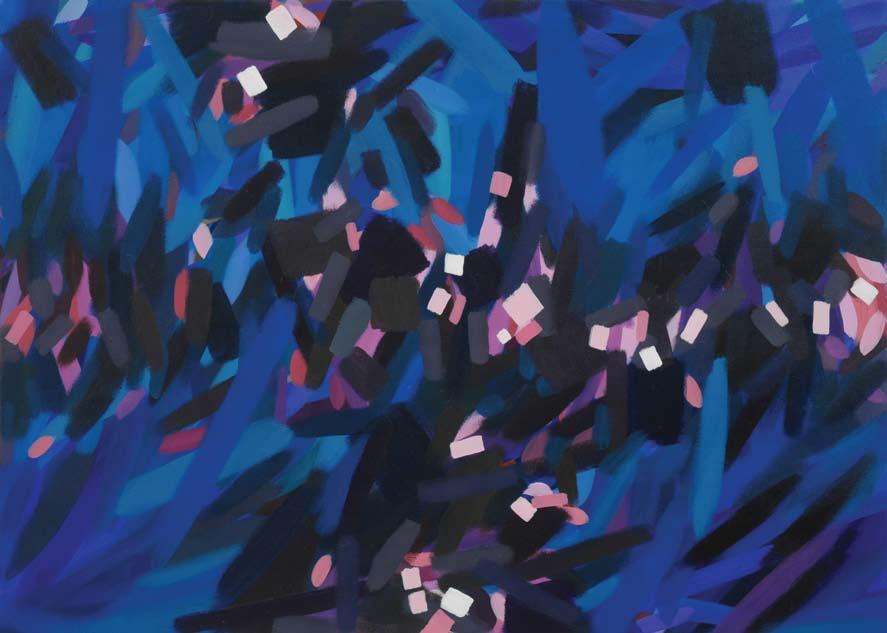
"Le titre fait allusion à mon admiration pour Jackson Pollock et encore plus pour la jeune étudiante du constructivisme de l'Union Soviétique de 1925, Maria Ender, qui fit quelques toiles spectaculaires qui ont toujours été pour moi une source d'inspiration. Elles étaient texturées et pourtant purement abstraites. Il y avait là quelque chose qui n'avait jamais encore été fait. C'est comme si par son interprétation estudiantine, notre avenir culturel s'était manifesté pendant un court instant."

312 313 يبظ وبأا في رجفلا Pre-Dawn Abu Dhabi, 2007. Arylic on canvas, 48 x 66’’, 122 x 167.5 cm. ➤ ةينيوكتلا ذيملت Constructivist Student, 2008. Acrylic on canvas, 60 x 80’’, 152.5 x 203 cm. ردش�م امئاد تناك يتلاو ليإ ةبش�نلاب ةش�هدم اهنكلو ادج ةليلق تاحول تم �ر يتلا ردنإا ايرام ةباش�لا ةذيملتلاب ثركأ و لب ،كولوب نو �كاج ماش�رلاب يباجعإا لىإ ناونعلا يرش�ي " عن �ي لم ائيش� ديرجتلا اذه ناك .تحب ديرتج تقولا س�فنبو اهنكلو ةش�يرلاب ةفثكم تابر � ىلع دمتعي اهتاحول بيكرت جذونم ناك .1925 ةن � يتيفوش�لا داتحل ةيادب في كلذو ،لي ماهلإ " .ةذيملتك اهموهفم للاخ نم ادج يرش�ق تقو نم زرب دق فياقثلا انلبقت �م نأ كو ،لبق نم
"This one started as a painting of many greens. It came very close to success several times. After many days and hours, I began to react in frustration covering some of the best parts. I cleaned my brushes and left in despair. On the next morning I saw that through blind frustration, something good and unknown had happened."


"Celui-ci commence comme un tableau de plusieurs verts. Il a été près d'être réussi plusieurs fois. Après de nombreux jours et heures de frustration, j'ai commencé à réagir, couvrant certaines des meilleures parties. J'ai nettoyé mes pinceaux et je suis partie désespérée. Le lendemain matin, j'ai vu que par frustration aveugle, quelque chose de bon et d'inconnu s'était produit."
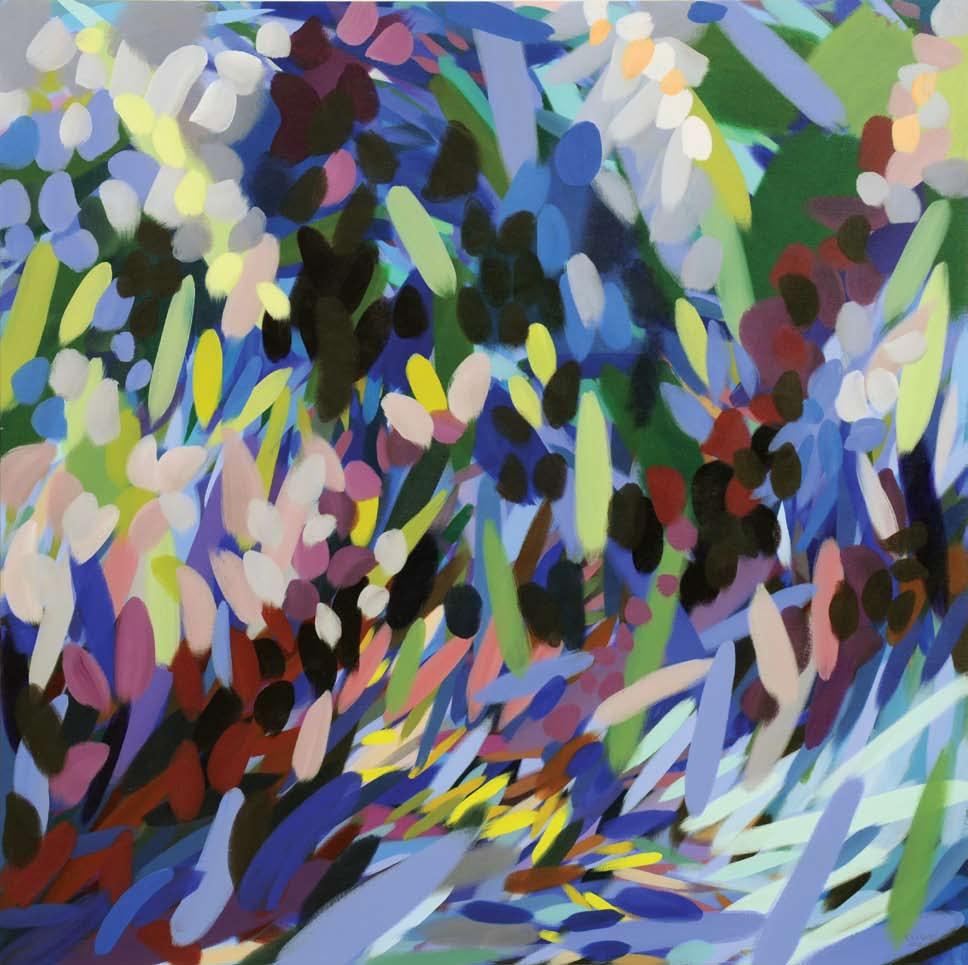
314 315 خولخا تلابق Plum Kisses, 2008. Acrylic on canvas, 18 x 18’’, 45.5 x 45.5 cm. Private collection. يرهز قوف يرطي يرهز Pink Flying Over Pink, 2008. Acrylic on canvas, 18 x 18’’, 45.5 x 45.5 cm. ➤ حتفتي ر �خألا From Green to Flower, 2008. Acrylic on canvas, 71 x 71’’, 180 x 180 cm. Private collection. مايأ دعب .ةديدع تارلم حاجنلل ايرثك تبترقاو .رش�خألا نوللا تاعونت نم ةبكرم ةحوللا هذه تناك ةيادبلا في " حاب � في .ة �ئاي ترداغو س�يرلا فيظنتب تمق ،ءازجألا لش�فأ بيرخت نم يرثكلا دعبو لش�فلا نم ةليوط تاعا �و " .هابتنل مدعو طابحإلا للاخ ل �ح دق فورعم يرغو اديج ائيش� نأا تيأ ر لياتلا مويلا
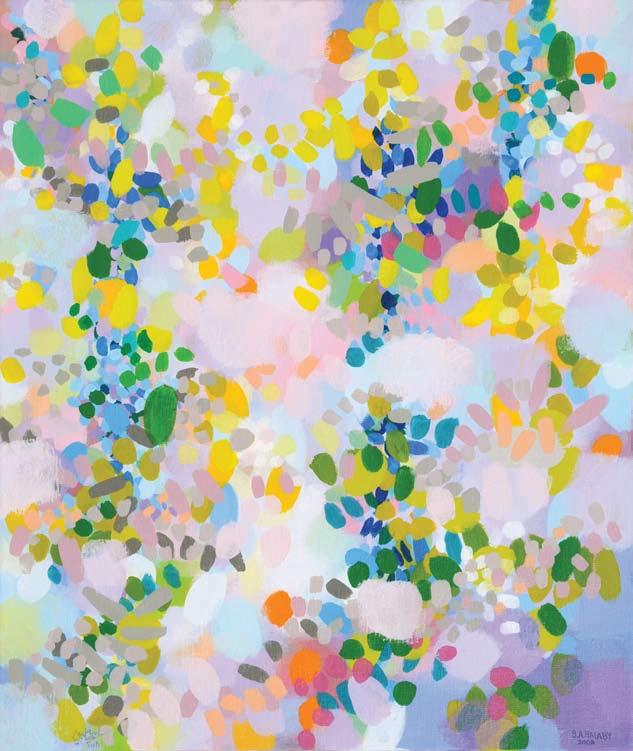
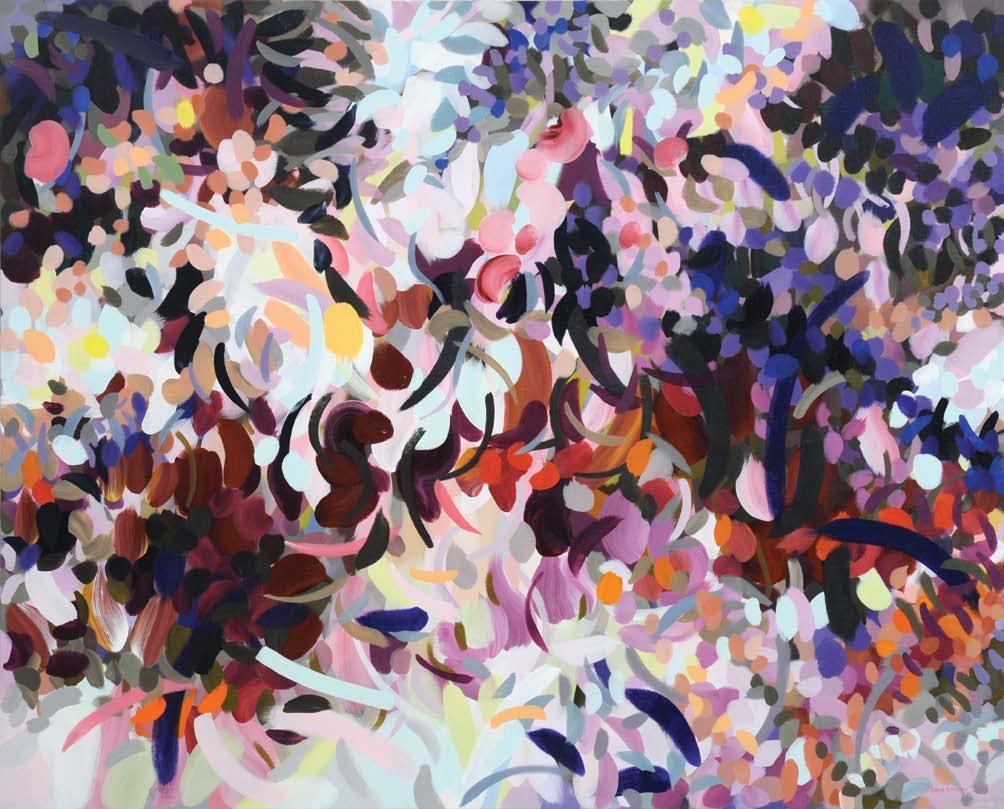
316 317 ىليل لىإا حابش�لا رون
Morning Light for Laila, 2008. Acrylic on canvas, 38 x 32’’, 96.5 x 81.5 cm. Private collection.
راهدزإا
Efflorescence, 2008. Acrylic on canvas, 57 x 71’’, 145 x 180 cm.


318 319
يرنم Munir, 2008. Acrylic on canvas, 48 x 58’’, 122 x 147.5 cm. ةئي
�م ةيرب تاتابن
Bright Wild Weeds, 2008. Acrylic on canvas, 47 ¼ x 57’’, 120 x 145 cm.
"The Damascus series of photomontage are like sketches in which I capture my delight in the world of sight. It is like focusing on an image in order to retrieve it later for a painting."


" La série de photomontages Damas est comme un ensemble de croquis dans lesquels j'exprime le plaisir que me donne l'univers de la vision. C'est comme se concentrer sur une image pour la récupérer plus tard dans une toile."
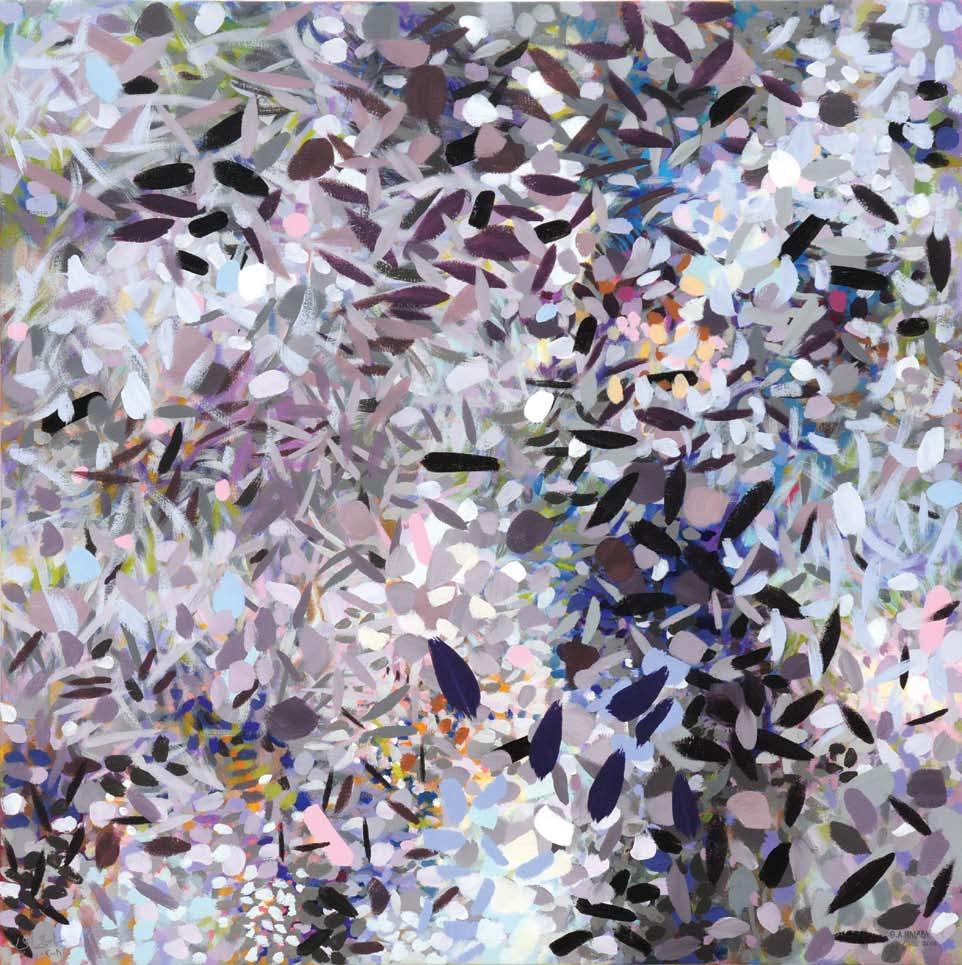
320 321 رفوكناف ةريزج Vancouver Island, 2008. ➤ Acrylic on canvas, 42 x 42’’, 106.5 x 106.5 cm. Private collection. ةناكدو س�اب Bus and Shop, Damascus series, 2008. Photomontage. ةطلش� Salad, Damascus series, 2008. Photomontage. .رش�بلا لماعب يطابتغا اهيف طقتلأ تا �ارد هبش�ت روش�لا جاتنوم نم قش�مد ةلش�ل � " " .اهمش�رل اقحل اهتداعتش�ا س�رغب ةروش� ىلع زيكترلا لثم اهنإ
"I sauntered with a woman in her garden adjacent to Balata refugee camp in Bethlehem. It was a small paradise lovingly made with overhanging trees, a sunken bower, and exotic birds in cages. She told me that she took special pleasure in manicuring it during the long days of curfew imposed often by the Israelis. I left feeling such pride in the resourcefulness and stubborn persistence of Palestinian women under occupation and make the Women of Palestine series in their honor."
"Je me suis promenée avec une femme dans son jardin près du camp de réfugiés de Balata à Bethléem. C'était un petit paradis entretenu avec amour, à l'ombre des arbres, avec une charmille en contrebas et des oiseaux exotiques dans des cages. Elle m'a dit qu'elle prenait un plaisir particulier à le soigner pendant les longues journées de couvre-feu souvent imposées par les Israéliens. Je suis partie en ressentant une vraie fierté envers les ressources et la ténacité persistante des palestiniennes sous l'occupation et j'ai fait la série Femmes de Palestine en leur honneur."
Daughter in Her Mother's Garden, Women of Palestine series, 2007.
on canvas collage, 38 x 47’’, 96.5 x 119.5 cm. Private collection.
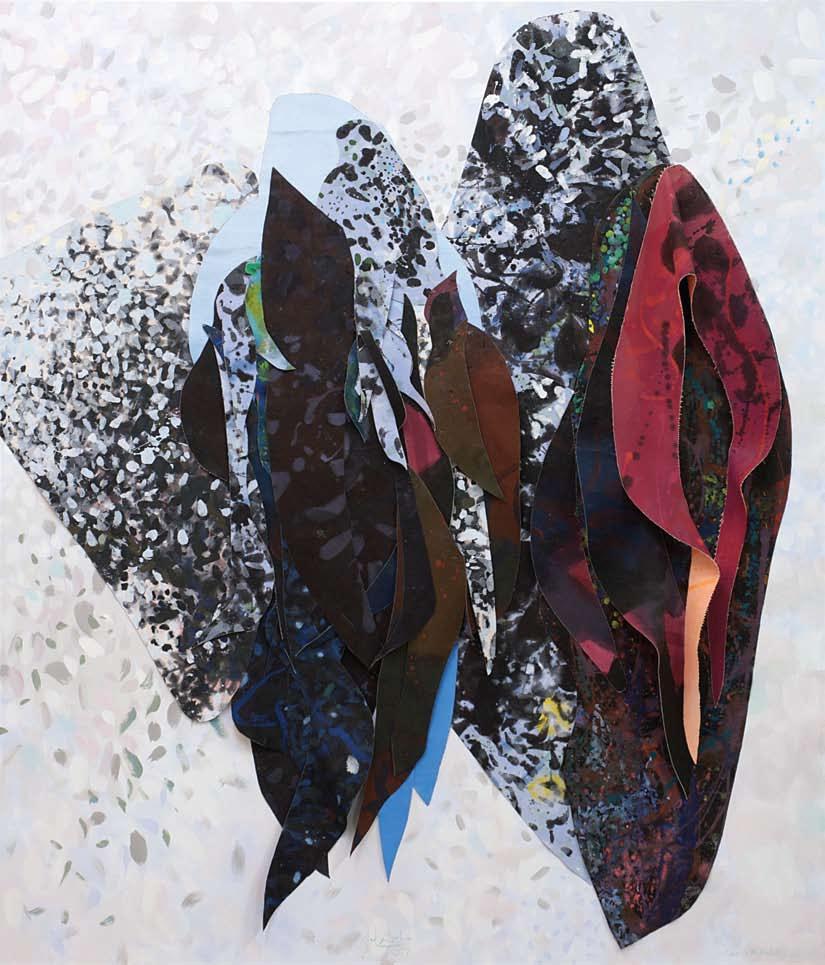

322 323 ينط �لف ءا �ن ةلش�لش� ،اهمأ ةقيدح في ةاتف
➤ ينطش�لف ءا �ن ةلش�ل � ،نوتيز ةرجش� تتح يرفا �ع ةثلاثو تاهمأا ةثلاث Three Mothers and Three Exotic Birds under an Olive Tree, Women of Palestine series, 2009. Acrylic on canvas collage, 85 x 72’’, 216 x 183 cm. لي تلاق س�افقأ في ةبيرغ رويطو ،رومغم خوك ،راجش�ألا اهللظتو ةبحبم ةعون �م ةيرغ � ةنج تناك .ملح تيب في ةطلاب ميخلم ةرواجلما اهتقيدح في ةأ رما عم تيش�م " ةراهلم رخفلاب رعش�أا انأاو ترداغو .ةيلاعلا ةفاقثلا تاذ اهتنبا تلباق .ابلاغ نويليئار �إلا ه �رفي يذلا لوجتلا رظح نم ةليوطلا مايألا للاخ اهب ةيانعلا في ة �اخ ةعتم ققتح اهنإ ".ينطش�لف ءا �ن ةل �لش تمش�ر نهل ايمركتو ،للاتحل لظ في ةدينعلا نهتمواقمو تاينيطش�لفلا ءا �نلا
Acrylic
"We were all angry about the brutal bombing of Gaza by the Israelis in 2008. We being most Arabs and the left community worldwide – that is most conscious people. When Khaled Samawi asked Ayyam artists to respond via a painting, it was only 4 days before my planned travel to Dubai to attend the opening of my show there. Fortunately a good piece of cotton canvas was in the studio. I sketched in all directions and called friends to find out what the brave people of Gaza were saying. At the end of three days, I had done the drawing. I folded it into my suitcase and to my great surprise on arrival, Samawi had it stretched immediately and it was part of the exhibition opening January 10, 2009."
"Nous étions tous en colère à cause du bombardement brutal de Gaza par les israéliens en 2008. Nous, c’est-à-dire la majorité des arabes et la communauté de gauche dans le monde, autrement dit la plupart des gens normaux. Quand Khaled Samawi demanda aux artistes d’Ayyam de répondre par des peintures, c’était seulement 4 jours avant mon départ à Dubaï pour assister au vernissage de mon exposition là-bas. Heureusement, j’avais une bonne pièce de toile en coton au studio. J’ai fait des croquis dans tous les sens et j’ai appelé des amis pour savoir ce que disaient les braves gens de Gaza. Au bout de trois jours, j’avais fini ma peinture. Je l’ai plié dans ma valise et à ma grande surprise, à mon arrivée, Samawi l’a immédiatement encadrée, et elle a fait partie du vernissage de l’exposition, le 10 janvier 2009."
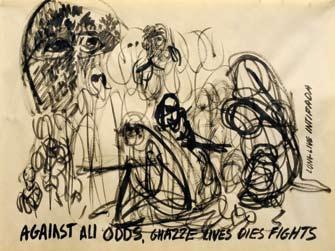
2009. Acrylic and ink on cotton, 73 x 105’’, 186 x 266 cm. Private collection.


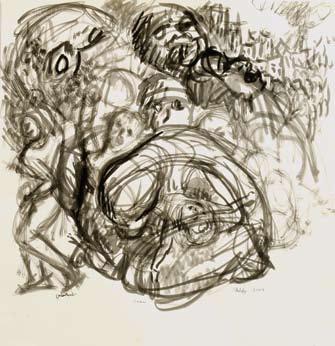

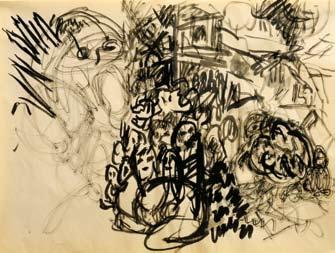
324 325 ةزغ
ةزغ ةحولل تاش�ارد Sketches in preparation for Gaza. Wash on paper. ةزغ ىلع يش�حولا فش�قلا ءارج بش�غلا انحاتجا انعيمج " ةيثركأ هانعم ،انعيمج 2008 ماع ينيليئار �ل لبق نم ابم ،لماعلا ءاحنأ ةفاك في ةيراش�يلا ةعومجلما كلذكو برعلا نم يوامش� دلاخ بلط امدنع .ينيعاولا س�اخش�ألا مظعم ،هانعم يرف �ل ططخأ تنك ،ةحول برع ثدلحا اذه ىلع درلاب مايأ نيانف .كانه يدرفلا ي �رعم حاتتفا رو �لح مايأ ةعبرأا دعب يبد لىإا ةزهاج ينطقلا س�امقلا نم ةيربك ةعطق يدل ناك ظلحا نش�لح تل �تاو تاهاتجل عيمج في مش�رلاب تأ دب .اهيلع مش�رأل ناعجش�لا ةزغ لهأا ىدل ام نع مهنم علطت �أل ءاقد �ألاب في اهتع �و .ةحوللا نم تيهتنا ،مايأ ةثلاث رورم دعب .هولوقيل يوام �لا نأل ،تئجوف ليو �و ىدلو ،يعم اهتذخأ و يرفش� ةبيقح حاتتفا في ةحوللا س�رع تمو ،بش�لخا ىلع اهدش�ل ةرش�ابم اهل �رأا " 2009 نياثلا نوناك رهش� في يدرفلا يش�رعم
Gaza,
"When I first worked on this painting it was a collage free of the stretcher and it was titled Bride. In time I decided to adhere it to a stretched canvas. I allowed the boundary of the finished free-shape painting to compete in importance with the rectangular frame of the newly stretched canvas. What was inside the perimeter of the first stage gave birth to all the additions outside the perimeter. Having an internal perimeter compete with the rectangular edge of the canvas was a significant new experience in my explorations of the picture’s plane."
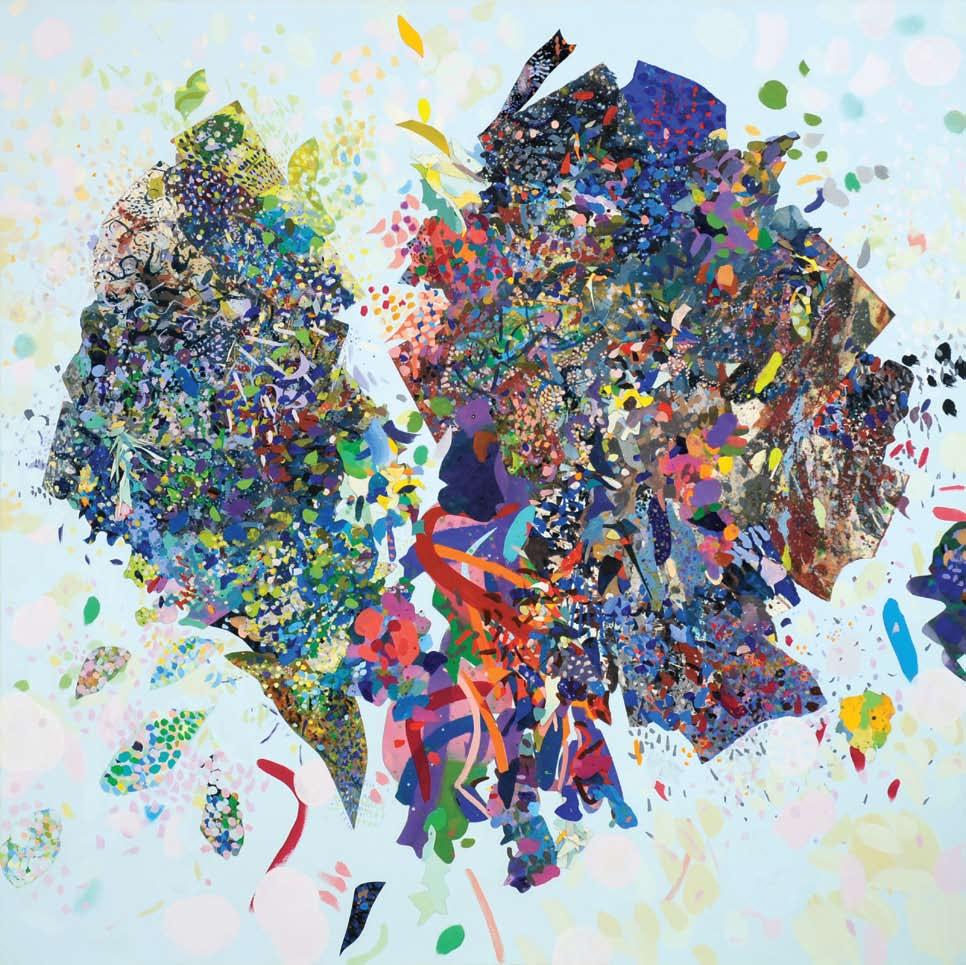
"Quand j'ai travaillé sur ce tableau la première fois, c'était un collage sans châssis et il s'intitulait Bride [Mariée]. Avec le temps, j'ai décidé de le coller sur une toile tendue. J'ai laissé les contours de l'œuvre de forme libre que j'avais terminée rivaliser d'importance avec le cadre rectangulaire de la toile que je venais de tendre. Ce qui était à l'intérieur du périmètre de l'œuvre sur toile libre a inspiré toutes les additions en dehors de ce périmètre. Ce périmètre intérieur rivalisant avec le bord rectangulaire de la toile était une expérience nouvelle et une étape significative dans mes recherches sur l'espace d'un tableau."
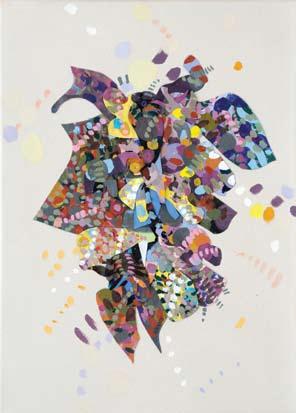
326 327 ➤ ةروش�ب Moth 2007. Acrylic on canvas collage, 25 x 18’’, 63.5 x 45.5 cm. اش�يأا ءام �لا عل بت س�ورعلا روذب Bride Seed Swallows the Sky, 2008. Acrylic on canvas collage, 80 x 80’’, 203 x 203 cm. Private collection. ةيهتنلما ةحوللا ةفاح تكرتو .راطإا ىلع دودش�م س�امق لىإا اهق �لأ نأا تررق تقولا عم " س�ورع " اهناونع ناكو راطإ لاب اق �لم تناك ةحوللا هذه ىلع يلمع ةيادب في " يلخاد طيمح دوجو نإ .هجراخ تتم يتلا تافاش�إلا لك دلو لىوألا ةلحرلما طيمح لخاد ناك ام .اثيدح دودش�لما س�امقلل ليطت �لما راطإلا عم ةيمهألا في س�فانتت لكش�لا ةرلحا ".ديرجتلا في ةحوللا حط � نياعلم يتافاش�كتش�ا في ةماه ةديدج ةبرتج ناك س�امقلل ةليطت �لما ةفالحا عم س�فانتي

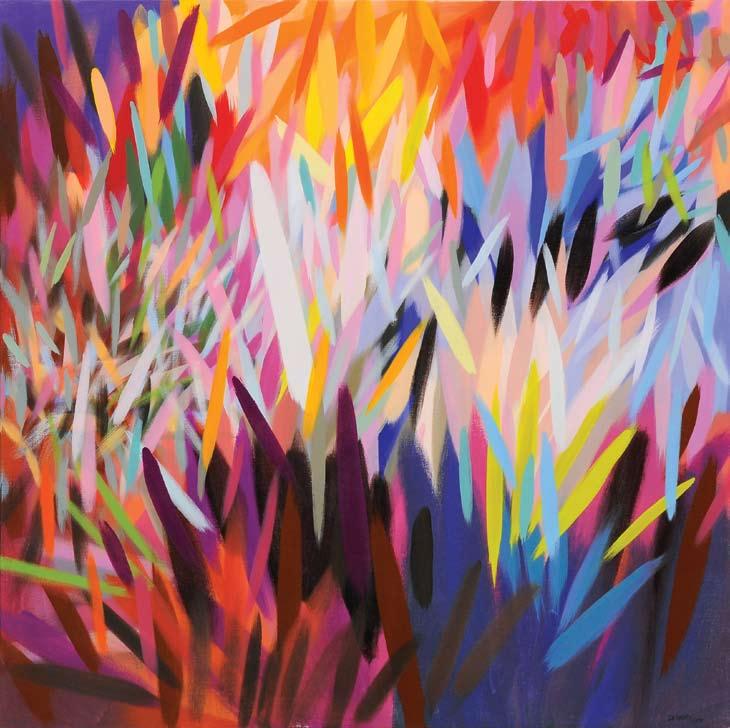
328 329 ةمتعلا في رون Light in Darkness, 2009. Acrylic on
48 x 47 ¼’’, 122 x 120 cm. ➤ فاش�كتش�ا
canvas,
Exploration,
2009. Acrylic on canvas, 58 x 57’’, 147 x 145 cm.

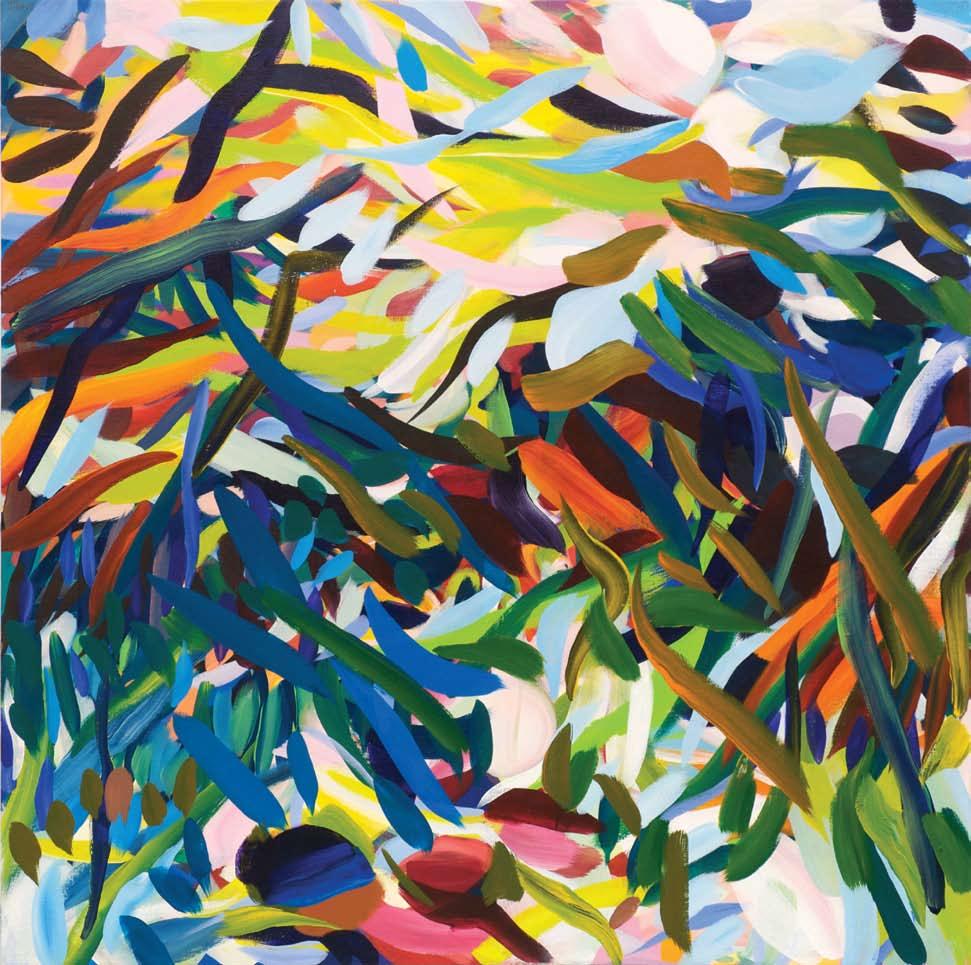
330 331 ➤ ةيرحب قوف ءام �
ءوش�لا في ومني Growing
Sky Over Lake, 2009. Acrylic on canvas, 57 x 57’’, 145 x 145 cm.
in Light, 2009. Acrylic on canvas, 48 x 58’’, 122 x 147 cm.


332 333 ينط �لفل رش�خألا
ةيئام تارمم
Green for Palestine, 2009. Acrylic on canvas, 47 ¼ x 57’’, 120 x 145 cm.
Waterways, 2009. Acrylic on canvas, 48 x 58’’, 122 x 147 cm.
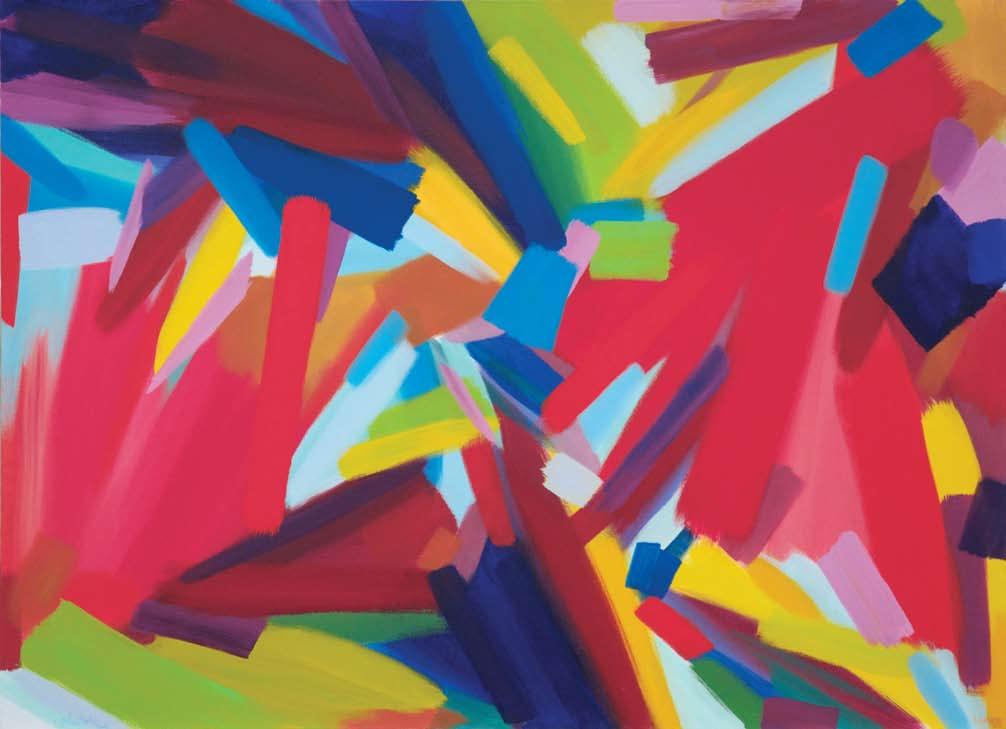
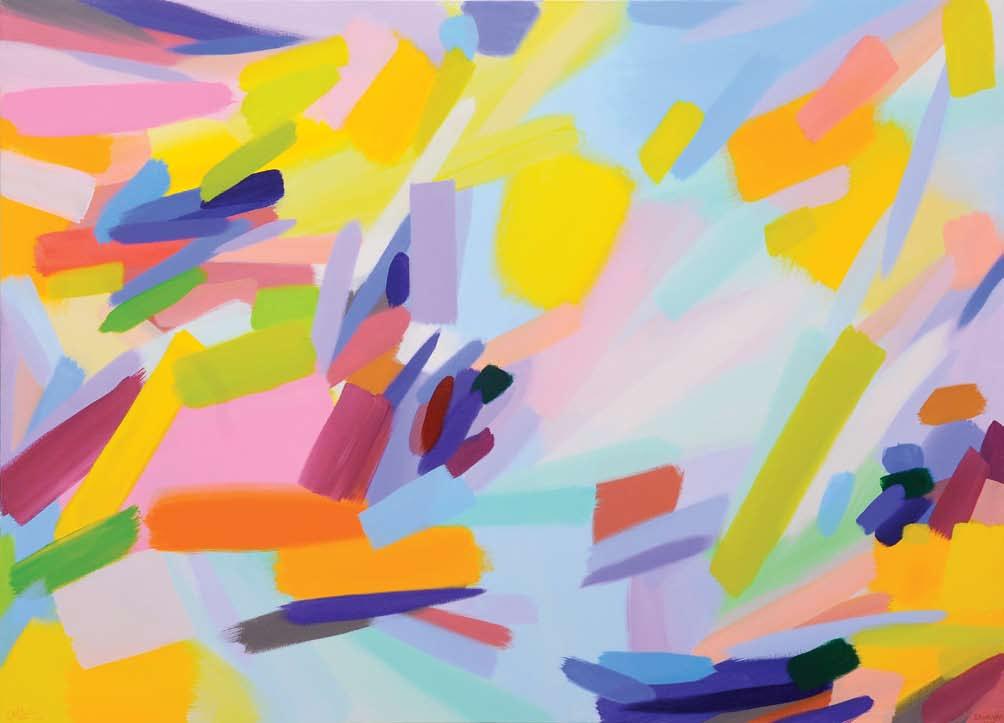
334 335 ءام �لا نم ءازجأاو رمحأا Red
كبلق في حابش� Morning in Your
and Pieces of the Sky, 2009. Acrylic
on canvas, 48 x 66’’, 122 x 167.5 cm.
Heart, 2009. Acrylic on canvas, 48 x 66’’, 122 x 167.5 cm.
"To allow intuition to dominate, I told myself that I was merely placing pleasing colors next to each other. Surfing was the first of these paintings and the pleasure of gliding mentally with the parts of the painting gave the painting its title."

"Afin de laisser l'intuition dominer, je me suis dit que je ne ferais que mettre des couleurs agréables les unes à côté des autres. Surfing était la première de ces toiles, et le plaisir de glisser mentalement avec les parties du tableau lui donnèrent son titre."

336 337 ةللبم ةيفيرخ حاير Wet Windy Autumn, 2009. ➤ Acrylic on canvas, 71 x 71’’, 180 x 180 cm. ءالما ىلع جلزتلا Surfing, 2009. Acrylic on canvas, 57 x 71’’, 145 x 180 cm. Private collection. دقو تاحوللا هذه لىوأ "ءالما ىلع جلزتلا " ةحول تناك س�عبلا اه �عب بناج لىإ ةعتمم اناولأا عش�أا يننأ وه هب موقأ ام لك نإ ي �فنل تلق ،رطيش�ي س�دلحا كرتأ يكل " ".ةحوللا ءازجأ عم ينهذلا جلزتلا ةعتم نم اهناونع ةحوللا تذخأا
"I used all the colors here that I could manage. I varied their saturation and the level of their lightness wanting to coordinate a painting of as many colors as I could. It is a celebration of our ability to distinguish between millions of colors."
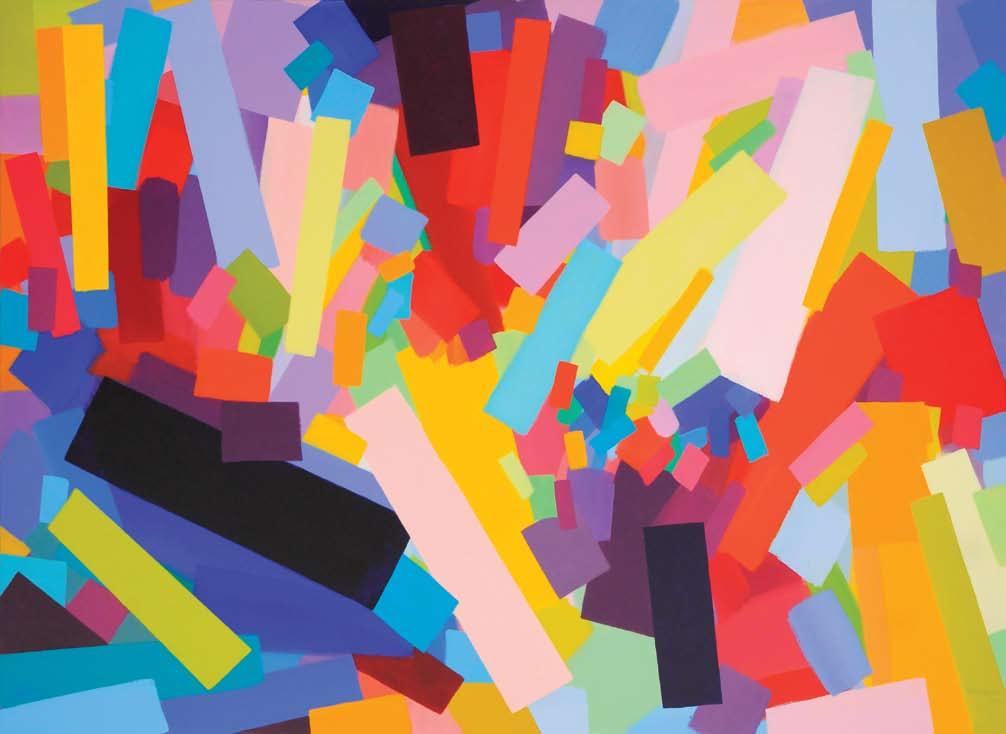
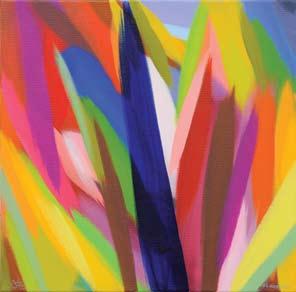

"Ici, j'ai utilisé autant de couleurs que possible. J'ai varié leur saturation et leur niveau de luminosité dans le but d'assembler un tableau avec autant de couleurs que je pouvais. C'est une célébration de notre capacité à distinguer des millions de couleurs."
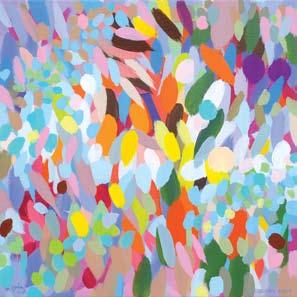
338 339
➤
ءادوش� ةعيفر
رون عبش�ت ءوش� Color Light Saturation, 2009. Acrylic on canvas, 66 x 90’’, 167.5 x 228.5 cm. فيو اهعابش�إ ىدم في تيرغ.اهلامعت �ا يننكيم يتلا ناولألا لك انه تمدختش�ا" لافتحا هنإا .ناولألا نم نكمم ددع بركأا ةحول قش�نأ نأا في ةبغار اهتءاش�إ ىوت �م ".ناولألا ينيلام ينب زييمتلا ىلع انتردقب
جورم
Field Foliage, 2009. Acrylic on canvas, 18 x 18’’, 45.5 x 45.5 cm.
يعيبط
رظنم Landscape, 2009. Acrylic on canvas, 18 x 18’’, 45.5 x 45.5 cm.
ةقبنز
Black Needle Lily, 2009. Acrylic on canvas, 18 x 18’’, 45.5 x 45.5 cm.
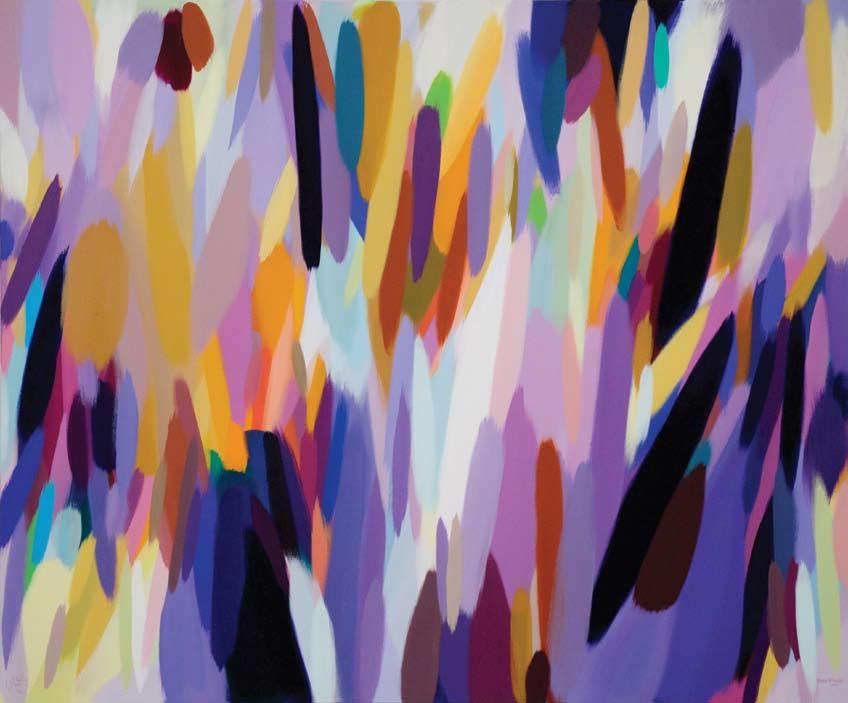

340 341 لامش�لا لىإا ةرجه
تاراطإلا في قرزأا
Northern Migration, 2010. Acrylic on canvas, 71 ¾ x 60 ¼’’, 153 x 182 cm.
Blue in Frames, 2010. Acrylic on canvas, 60 x 80’’, 152.5 x 203 cm.


342 343 س�يبأا قيلع
ومني
White Moss, 2010. Acrylic on canvas, 71 ¾ x 60 ¼’’, 153 x 182 cm.
حومجب
Growing Wild, 2010. Acrylic on canvas, 71 ¾ x 60 ¼’’, 153 x 182 cm.


344 345 قرزأ
بيلوت
Blue Tulips, 2010.
Acrylic on canvas, 57 x 47 ½’’, 145 x 120 cm.
رمحأا
بيلوت Red Tulips, 2010. Acrylic on canvas, 48 x 58’’, 122 x 147.5 cm.
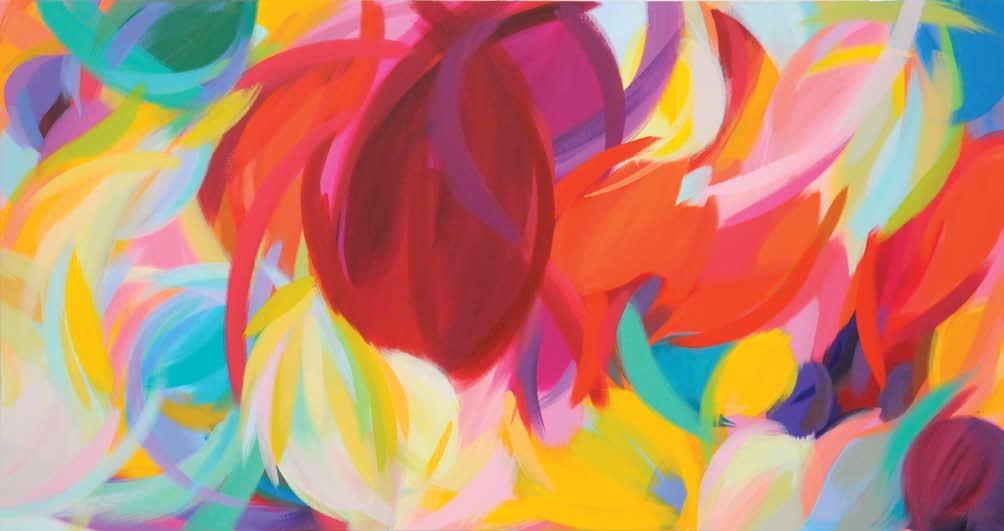
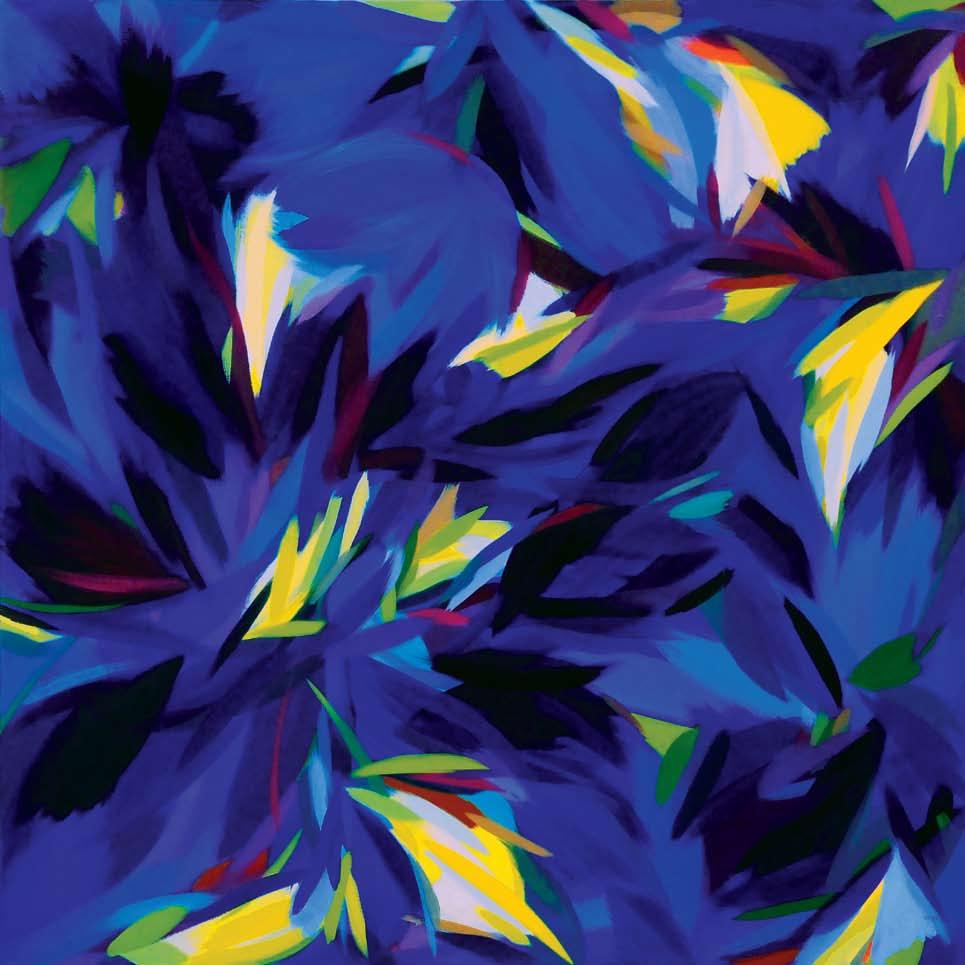
346 347
قش�مد Damascus, 2010. Acrylic on canvas, 36 x 67 ½’’, 91 x 171 cm.
➤ ليللا
رابش� Night Cactus, 2010. Acrylic on canvas, 71 x 71’’, 180 x 180 cm.
"Spring Fertility and Green Expanse began life as stitched canvas collage without the use of a stretcher. I applied them to canvas grounds and all attempts at coordinating them with their new canvas background failed and only led to more and more work until they completely changed. Spring Fertility became Three Dancers Flying Through Trees Like Storms in Spring and Green Expanse became Island (opposite page)."
"Spring Fertility [Fertilité de Printemps] et Green Expanse [Etendue Verte] ont vu le jour comme des collages de toile cousue sans châssis pour la tendre. Je les ai appliqués sur des bases de toile mais toutes mes tentatives pour les assortir à leur nouveau fond ont échoué et n'ont abouti qu'à du travail supplémentaire jusqu'à ce qu'ils soient devenus complètement différents. Spring Fertility est devenu Three Dancers Flying Through Trees Like Storms in Spring [Trois Danseurs Volant Parmi les Arbres Comme des Tempêtes de Printemps] et Green Expanse est devenu Island [Ile]."

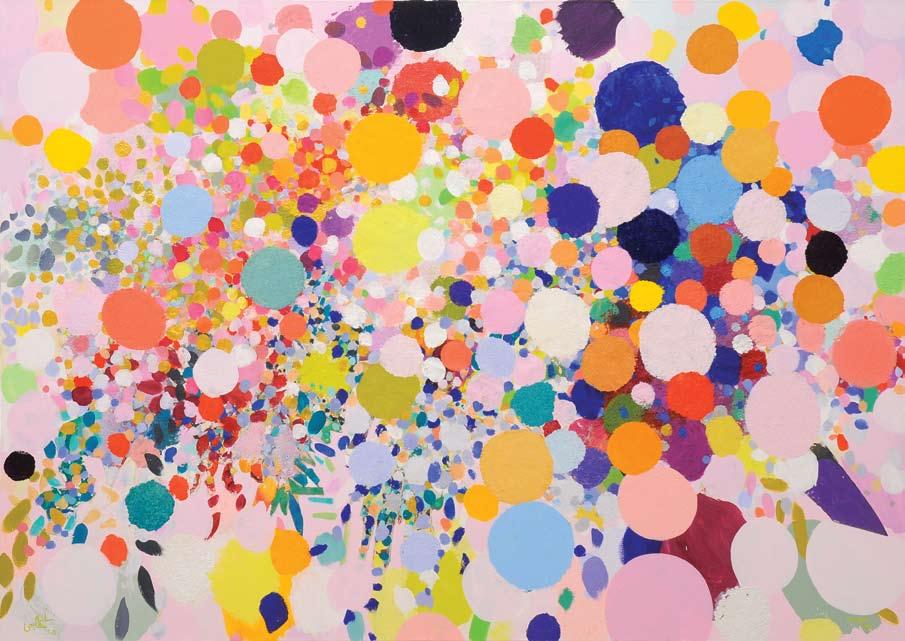
348 349 ةريزج
عيبرلا في فش�اوعلا لثم راجش�ألا ينب يرطت تا �قار ةثلاث Three Dancers Flying Through Trees Like Storms in Spring, 2009. Acrylic on canvas collage, 57 x 80’’, 145 x 203 cm. نيداق ام ةديدلجا ةيفللخا عم ناقش�تت امهلعج في يتلوامح لك تلش�فو ةيش�امق ةيفلخ ىلع امهتعش�و .راطإ نود طيمخ س�امق نم ةق �لمك اتدلو "ر �خأ ع �و " و "عيبرلا ةبوش�خ "" ". " ةريزج " تراص�ف "رش�خأا عش�وت " ةحول امأ " عيبرلا في فش�اوعلا لثم راجش�ألا ينب يرطت تاش�قار ةثلاث" "عيبرلا ةبو �خ " ةحول تراش�ف .لماكلاب ايرغت ىتح لمعلا نم ديزلما لىإا
Island, 2010. Acrylic and papier maché on canvas, 49 x 98’’, 124.5 x 249 cm.
"Maybe twenty years before I made Big Oak, Homage to the Shawnee, that I saw a stand of tall oak trees in Northern Indiana with a variety of smaller other trees among them. It was autumn and the combination of browns with the crisp blues of the sky was spectacular. I parked my car and sat staring, memorizing, thinking if only I could paint such colors. Five years ago, I began dealing with the subject in smaller works. Like the smaller versions, the idea of a Big Oak originally entailed stitched collaged canvas that would hang on the wall in several parts. I began in just that way but the process of work led me back to a stretched canvas on which the collaged pieces would hang.
I had been visiting my parents when I saw the oaks. Later when the family sold my parents home, the real-estate agent gave me a document showing the history of the plot of land in the countryside on which it was built. I was deeply affected by this history as it went back to when the land was stolen from Native American tribes and divided into one-mile square sections. A few years ago, a friend, sensitized by his Palestinian experience, suddenly realized that he himself was a settler on Indian lands. He went to the nearest Indian reservation and apologized to them. They adopted him as a brother. These two experiences, my friend and the land register, led me to examine a map of Indian territories predating the establishment of the United States. I realized that the stand of tall oaks was on Shawnee lands and I was a settler admiring them. Thus, I pay homage to the Shawnee as a form of apology – a way to process my years in the U.S. Mid-West.
In the reveries of silently making this abstraction of the oaks, I remembered stories of birds that gather shiny object to line their nest; and so the areas of smaller higher activity in the painting came to represent such nests in trees. But abstraction is composed of the general principles we extract from nature and reality. These principles often govern more than one set of specifics. Thus, it is not important that viewers know the details of what brought this painting about, nor that it is about trees and nests. What is important is that I make it possible for them to recognize the structure of things they themselves have seen and loved."

"Il a fallu une vingtaine d'années après avoir vu un bosquet de hauts chênes en Indiana du Nord mêlé avec des arbres plus petits d'espèces différentes, pour que je fasse Big Oak, Homage to the Shawnee [Grand Chêne, Hommage aux Shawnees]. C'était l'automne et le mélange des bruns avec les bleus clairs du ciel était spectaculaire. J'ai garé ma voiture et je suis restée assise à regarder, mémoriser, penser -si seulement je pouvais peindre de telles couleurs-. Il y a cinq ans, j'ai commencé à m'intéresser à ce thème dans des œuvres de plus petite envergure. Comme dans ces plus petites versions, l'idée d'un grand chêne demandait à l'origine de la toile cousue et collée qui pendrait du mur en plusieurs parties. J'ai commencé exactement comme cela, mais le processus du travail m'a ramenée à une toile étirée sur un châssis duquel les collages pendraient.
J'avais rendu visite à mes parents quand j'ai vu les chênes. Plus tard, quand la famille vendit la maison de mes parents, l'agent immobilier me donna un document rappelant l'histoire du terrain de campagne sur lequel elle était construite. Je fus très touchée par cette histoire parce qu'elle remontait au temps où la terre avait été volée aux tribus indiennes et divisée en sections d'un kilomètre carré et demi. Il y a quelques années, un ami, sensibilisé par son expérience palestinienne, réalisa soudainement que lui aussi était un colon sur des terres indiennes. Il alla à la réserve indienne la plus proche et s'excusa auprès d'eux. Ils l'adoptèrent comme un frère. Ces deux expériences, celle de mon ami et celle du document du cadastre, m'ont poussée à examiner une carte des territoires indiens préexistants à l'établissement des Etats-Unis. J'ai réalisé que le bosquet de hauts chênes était sur des terres Shawnee et que j'étais un colon en train de les admirer. Ainsi, je rends hommage aux Shawnees en guise d'excuse – une façon de comprendre mes années dans le Mid-West.
Dans mes rêveries silencieuses de réaliser cette abstraction des Chênes, je me suis rappelée des histoires d'oiseaux qui récupèrent des objets brillants pour tapisser leurs nids. Ainsi, les plus petites zones d'intense activité de l'œuvre en sont venues à représenter de semblables nids perchés dans les arbres. Mais en fait, l'abstraction est composée des principes généraux que l'on extrait de la nature et de la réalité. Ces principes gouvernent souvent plus qu'un seul groupe de traits spécifiques. Donc, le fait que le public connaisse ou non les détails de ce qui a engendré ce tableau – le fait qu'il soit à propos d'arbres et de nids - n'a aucune importance. Ce qui est important, c'est que je leur permets de reconnaître la structure des choses qu'ils ont eux-mêmes vues et aimées."
350 ➤ Big Oak, Homage to the Shawnee, 2006-2009. Acrylic on canvas collage, 108 x 60’’, 274.5 x 152.5 cm. " نيواش�لا " ةليبقل يمركت ،ةيربكلا تاطولبلا ىرخأ راجش�أ نم ةعوممج عم ةيلامش�لا انايدنإ في ةليوطلا نايدن �لا راجش�أا نم ةعوممج تدهاش� نأا ""نيواش�لا " ةليبقل يمركت ،ةيربكلا تاطولبلا " ةحولل يم �ر نم ةنش� 20 لبق ناك ابمر " مش�رأ نأ عيطت �أ طقف نيأا ول ىنتمأاو ،يتركاذ في نزخأ و ،قدحأ ت �لجو يتراي � تنكر لاهذم ةيهازلا ءاقرزلا ءام �لا ناولأا عم ينبلا ناولأ جيزم ناكو فيرلخا في كلذ ناك .اهنيب ةيرغ � ل �ألا في تمزلت �ا ""نيواش�لا " ةليبقل يمركت ،ةيربكلا تاطولبلا " ةركف نإ ف ،ةيرغ �لا لامعألا رارغ ىلعو .ةيرغ � لامعأ في عوش�ولما عم لماعتأا تأادب تاونش� س�مخ لبق .ناولألا هذه لثم .ةطيخلما عطقلا هيلع قلعت يذلا دودش�لما س�امقلا لىإ نيداعأ لمعلا قاي � نكلو ةقيرطلا هذهب تأادب .ةددعتم ءازجأ ب طئالحا ىلع قلعي طيمخ س�امق نم اجلوك اقيمع ترثأا .تيبلا ينب ثيح فيرلا في س�رألا ةعطق خيرات رهظت ةقيثو يراقعلا ليكولا نياطعأا ،يدلاو لزنم ةلئاعلا تعاب امدنع دعب اميف .نايدن �لا راجش�أ تيأ ر امدنع يدلاو روزأا تنك ،ةينيطش�لفلا هتبرجتب ارثأاتم ،لي قيدش� ةأاجف كردأ ،تاون � عش�ب ذنمو .عبرم ليم اهنم لك ةحاش�م ،ءازجأ لىإا اهمي �قتو رملحا دونهلا لئابق نم س�رألا ةقر � نمز لىإ دوعي يذلا خيراتلا اذهب ةش�ارد لىإ ،س�رألا لج �و يقيدش� ةش�ق ،ناتبرجتلا ناتاه ينتعفد .مهل خأ ك هونبتف ،مهنم رذتعاو رملحا دونهلل عمتج برقأا لىإ بهذف .رملحا دونهلا يش�ارأ ىلع انطوت �م ناك ه �فن وه هنأ برعأا نيإاف اذكهو .مهب ةبجعم ةنطوت �م تنك انأ و نيواش� ةليبق يش�ارأ ىلع تناك ةليوطلا نايدنش�لا راجش�أ ةعوممج نأ تفرعف .ةدحتلما تايلولا س�يش�أ تل ةقباش�لا ةيدنهلا يش�ارألا ةطراخ .ط �وألا برغلا في يتاونش� ليدعتل ةقيرط – راذتعل نم لكش�ك نيواش� ةليبقل يريدقت نع ةحوللا في طاش�نلا ةيلاعلا ةيرغ �لا قطانلما نإاف اذكهو ،اهش�ع نطبتل ةعمل ءايش�أا عمتج يتلا يرفا �علا س� �ق ،نايدن �لا راجش�أا نع ديرجتلا اذهل تماش�لا زانجإلا لمأا للاخ تركذت اذكهو .س�ئا �لخا نم ةدحاو ةعوممج نم ثركأا ئدابلما هذه مكتح ام ابلاغو .عقاولاو ةعيبطلا نم اهش�لخت �ن يتلا ةماعلا ئدابلما نم فلأ تي ديرجتلا نكلو .راجش�ألا في س�اش�عألا هذه لثتم نأا قبش� يتلا ءايش�ألا بيكرت كردي نأا رظانلا تنكم يننأ مهلما س�اش�عألاو راجش�ألا لوح رودت ةحوللا هذه نأ لو ،ةحوللا هذه مش�ر لىإا ىدأ يذلا ام لي �افت رظانلا فرعي نأ مهلما يرغ نم ".اهبحأ و ه �فنب اهآ ر



352 353 نارزيخ
لي يعيبط رظنم
ةنميلم معارب
Bamboo 2010. ➤ Acrylic and canvas, 78 ¾ x 78 ¾’’, 200 x 200 cm.
Landscape
for Me, 2010. Acrylic on canvas, 19 ¾ x 20 ¼’’, 50 x 56.5 cm.
Blossoms fo Maymanah, 2010. Acrylic on canvas, 18 x 18’’, 45.5 x 445.5 cm. Private collection.
Thunder Measuring Space, 2010. Acrylic on canvas, 60 x 80’’, 152.5 x 203 cm.
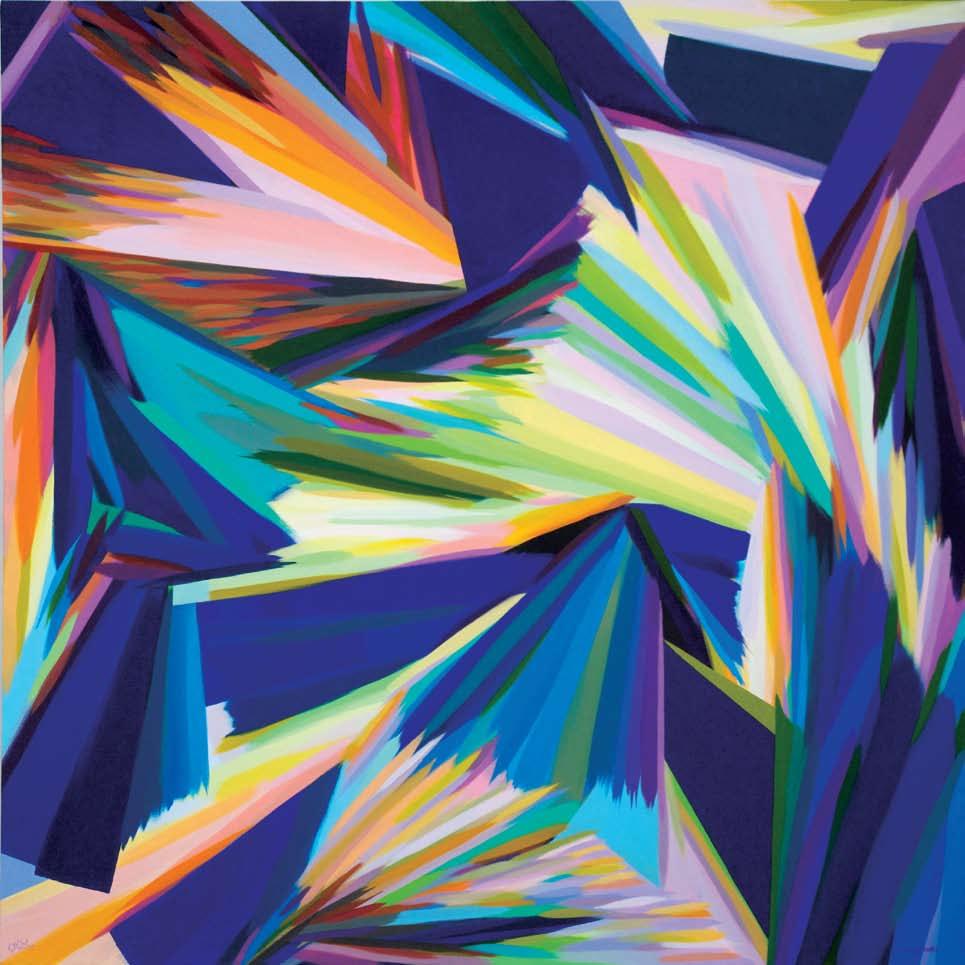

and Butterflies, 2010. ➤ Acrylic on canvas, 78 3/4 x 78 ¾’’, 200 x 200 cm.
"After finishing Angels and Butterflies (opposite page) I created the painting that I titled Thunder Measuring Space I like that things go from fluttery to powerful. It all seems part of the variations of nature."
"Après avoir fini Angels and Butterflies [Anges et Papillons], j'ai créé le tableau que j'ai intitulé Thunder Measuring Space [Orage Mesure l'Espace]. J'aime que les choses aillent du plus léger au plus puissant. Tout cela semble faire partie des variations de la nature."
354 355 تاش�ارفو ةكئلام
ءاش�فلا س�يقي دعرلا
Angels
اذه لك ودبيو .ةوقلا لىإ س�اعترل نم ءايش�ألا لوحتت نأ بحأ " ءاش�فلا س�يقي دعرلا " اهتيم �أا يتلا ةحوللا تم �ر ، " تاش�ارفو ةكئلام " ةحول نم يئاهتنا دعب " ".ةعيبطلا تاعيونت نم اءزج
Samia A. Halaby
A Chronology of Major Events
1936 Born in Al Quds (Jerusalem), Palestine to Foutounie Abdelnour Atalla and Assad Saba Halaby.
1939 Family moves to the coast of Palestine to the port city of Yafa (Jaffa).
1948 Family is forced into exile and takes refuge in the mountains of Lebanon.
1949 Family moves to Beirut where Halaby enters the British Syrian Training college.
1951 Family moves to the United States and settles in Cincinnati, Ohio where Halaby continues her education earning a Bachelor of Science in Design degree from the University of Cincinnati in 1959.
1963 Graduates from Indiana University with a Master of Fine Arts degree in Painting and spends the summer visiting European art museums.
1963 First academic teaching position at the University of Hawaii in Honolulu.
1964 First professional exhibition at Gima Gallery in Honolulu.
1964 Begins teaching at the Kansas City Art Intitute in Missouri as an Assistant Professor.
1966 Receives a Faculty Development grant and uses it to travel to Egypt, Syria, and Turkey to study Arabic architecture and geometric abstraction.
1967 Begins teaching at the University of Michigan, Ann Arbor as an Assistant Professor.
1969 Begins teaching at Indiana University, Bloomington, Indiana as an Associate Professor.
1970 First solo exhibition at the Phyllis Kind Gallery, Chicago.
1972 Receives the Tamarind Lithography Workshop residency in Albuquerque executing nine lithographic editions.
1972 Begins teaching at Yale University’s School of Art in New Haven, Connecticut as a Visiting Lecturer, then as an Associate Professor. Has solo exhibition of lithographs at the Yale School of Art Gallery, New Haven, Connecticut.
1973 Joins the Spectrum gallery, which is run by artists, and holds her first non-commercial New York solo exhibition.
1975 Is part of the exhibition of Recent Acquisitions at the Guggenheim Museum in New York City.
1976 Moves to New York and is forced to reduce her teaching status at Yale to Associate Professor Adjunct.
1978 Second solo exhibition in New York at Marilyn Pearl Gallery.
1981 Joins the artist-run gallery 22 Wooster Street.
1981 Travels to Oslo to participate in an exhibition of Palestinian art at the Kunstnernes Hus and meets many lifetime friends, first among whom is the organizer of the exhibition, sculptor Mona Saudi.
1982 Although promised a permanent position, Halaby is dismissed from her teaching position at Yale. After going through the one-sided grievance procedure, she decides to place the Yale School of Art on trial via an exhibition in New York that receives substantial press attention.
1983 Begins programming kinetic paintings on the computer and participating in several festivals both as creator of the Kinetic Painting program and as writer on the subject.
1985 Is invited to the Asilah Festival in Morocco.
1985 Returns to Honolulu for a semester of teaching as a visiting artist.
1986 Exhibits her work at the Galleria Palace de Arte in Granada, Spain.
1988 Is the first artist from North America to be invited to the Havana Biennial.
1991 to 1995 Helps to lead the Arab Women Artists Committee in New York, specializing in Arab arts.
1993 Forms the Kinetic Painting Group with musicians Hasan Bakr and Kevin Nathaniel Hylton.
1994 First performance of Kinetic Painting Group at the Brooklyn Museum, New York.
1994 Designs the set and costumes for a dance performance titled Jabberwalkie that is choreographed by Leslie Bryan and presented at the Pace University theatre in New York by the dance company Perspectives in Motion.
1994 Begins annual visits to the Arab world including Palestine, Jordan, Syria, and Lebanon.
1995 First solo exhibition in Jordan at Darat Al-Funun in Amman.
1997 First solo exhibition in Syria at Gallery Atassi in Damascus.
1997 Tours Syria, Jordan, and Palestine with Kinetic Painting Group performing at seven different venues.
1998 Kinetic Painting Group performs as part of a program at the Lincoln Center in New York.
1999 First solo exhibition in Lebanon at Agial Gallery in Beirut.
2000 First solo exhibition in Palestine at the Sakakini Art Center in Ramallah.
2001 Solo exhibition at Artim Gallery, Strasbourg, France
2002 Publishes her book on the “Liberation Art of Palestine.”
2002 Co-curates the exhibition “Williamsburg Bridges Palestine” presented by Al Jisser at the Williamsburg Art and Historical Center, featuring 50 Palestinian artists.
2002-2006 Halaby works as consultant on the exhibition “Made in Palestine” and reorganizes Al Jisser into Al Jisser Group. She is also an exhibiting artist in the traveling exhibition, which is organized by the Station Museum in Houston. With Al Jisser Group, Halaby curates several exhibition of Palestinian art including “Palestine: The Art of Resistance” at Tribes Gallery in New York, and “The Subject of Palestine” at DePaul University.
2006 With Halaby as its director, Al Jisser Group brings the exhibition “Made in Palestine” to New York City by developing the Bridge gallery, a non-profit art space opened in Chelsea specifically for the occasion.
2004 Solo exhibition at Agial Gallery in Beirut
2006 Participates in the exhibition “Three Arab Painters in New York” at the Bridge gallery.
2008 Is invited to participate in the Abu Dhabi Collectors conference at the Guest of Collectors Forum that is held at Art Paris Abu Dhabi.
2007-2010 Participates in international fairs, and group and solo exhibitions that are organized by Ayyam Gallery. The gallery publishes two catalogs on her work, one that is an extensive monograph.
2009 Participates in the major museum exhibition “Palestine, la création contemporaine dans tous ses états,” Institute Du Monde Arabe, Paris.
2010 Is invited by the Guggenheim Museum to participate in a panel discussion on abstraction as part of the series ‘The Making of A Museum’ in Abu Dhabi.
1936 Naissance à Al Qouds (Jérusalem), en Palestine, de Foutounie Abdelnour Atalla et Assad Saba Halaby.
1939 La famille s'installe dans la ville portuaire de Yafa (Jaffa) sur la côte de Palestine.
1948 Forcée de partir en exil, la famille se réfugie dans les montagnes du Liban.
1949 La famille s'installe à Beyrouth; Halaby suit des cours à l'Institut de Formation Syrien-Britannique.
1951 Départ pour les Etats-Unis; la famille s'installe à Cincinnati, Ohio, où Halaby poursuit ses études; elle obtient une licence en Design de l'Université de Cincinnati en 1959.
1963 Elle obtient une maîtrise de beaux-arts en peinture de l'Université d'Indiana et passe l'été à faire le tour des musées d'art européens.
1963 Premier poste d'enseignante universitaire à l'Université de Hawaii à Honolulu.
1964 Première exposition professionnelle à la Galerie Gima d'Honolulu.
1964 Elle commence à enseigner à l'Institut des Beaux-Arts de Kansas City au Missouri où elle occupe un poste de professeur assistant.
1966 Elle obtient une bourse pour le Développement Universitaire qu'elle utilise pour partir en Egypte, en Syrie et en Turquie afin d'étudier l'architecture arabe et l'abstraction géométrique.
1967 Elle obtient un poste de professeur assistant à l'Université du Michigan à Ann Arbor.
1969 Elle occupe un poste de professeur associé à l'Université d'Indiana à Bloomington.
1970 Première exposition en solo à la Galerie Phyllis Kind, Chicago.
1972 Elle est invitée à la résidence de l'atelier Tamarind de Lithographie et passe neuf semaines à faire des lithographies à Albuquerque.
1972 Elle obtient un poste de professeur invité, puis de professeur associé à l'institut des beaux-arts de l'Université Yale à New Haven dans le Connecticut, la Yale School of Art.
1972 Exposition en solo de lithographies à la galerie de la Yale School of Art, à New Haven dans le Connecticut.
1973 Elle rejoint la Galerie Spectrum, qui est gérée par des artistes et présente sa première exposition en solo à but non lucratif à New York.
1975 Elle figure dans l'exposition des Acquisitions Récentes du Musée Guggenheim à New York City.
1976 Elle s'installe à New York; elle est contrainte d'abaisser son statut d'enseignante à Yale et devient alors professeur associée adjointe.
1978 Première exposition en solo à New York à la Galerie Marilyn Pearl.
1981 Elle rejoint la galerie 22 Wooster Street, qui est gérée par des artistes.
1981 Elle part pour Oslo afin de participer à une exposition d'art arabe à la Kunstnernes Hus où elle rencontre plusieurs personnes qui deviendront des amis véritables, dont plus particulièrement l'organisatrice de l'exposition, la sculptrice Mona Saudi.
1982 Bien qu'on lui ait promis un poste permanent, Halaby est renvoyée de son poste d'enseignante à Yale. Après avoir déposé une plainte de son côté, elle décide de mettre la Yale School of Art en jugement à travers une exposition à New York qui reçoit une couverture médiatique importante.
1983 Elle organise l'exposition "En Jugement: La Yale School of Art" à la Galerie 22 Wooster Street à Soho.
1983 Elle commence à programmer des tableaux cinétiques sur ordinateur.
1985 Invitation au Festival Asilah au Maroc où elle produit de nombreuses œuvres sur papier, dont elle laisse la moitié aux organisateurs du festival.
1985 Retour à Honolulu où elle enseigne pendant un semestre en tant qu'artiste invitée.
1986 Première exposition en solo en Europe à la galerie Palace de Arte à Grenade, en Espagne.
1988 Elle devient la première artiste nord américaine à être invitée à la Biennale de la Havane.
1989 Elle participe pour la première fois à des conférences sur l'informatique et les arts.
1991-1995 Elle participe à la gestion du Comité des Femmes Artistes Arabes à New York qui se spécialise dans les arts arabes.
1993 Elle forme le Kinetic Painting Group (Groupe de Peinture Cinétique) avec les musiciens Hasan Bakr et Kevin Nathaniel Hylton.
1994 Première performance du Kinetic Painting Group (Groupe de Peinture Cinétique) au Musée de Brooklyn, à New York.
1994 Elle crée les décors et les costumes d'un spectacle de danse intitulé Jabberwalkie chorégraphié par Leslie Bryan et présenté au théâtre de l'Université Pace à New York par la compagnie de danse Perspectives in Motion.
1994 Début d'une série de visites annuelles au monde arabe, en particulier en Palestine, en Jordanie, en Syrie et au Liban.
1995 Première exposition en solo en Jordanie à Darat Al-Funun à Amman.
1997 Première exposition en solo en Syrie à la Galerie Atassi à Damas.
1997 Elle entame une tournée en Syrie, en Jordanie et en Palestine avec le Kinetic Painting Group (Groupe de Peinture Cinétique) où le spectacle sera présenté à sept reprises dans des lieux différents.
1998 La performance du Kinetic Painting Group (Groupe de Peinture Cinétique) est au programme du Centre Lincoln de New York.
1999 Première exposition en solo au Liban à la Galerie Agial de Beyrouth.
2000 Première exposition en solo en Palestine au Centre Culturel Sakakini à Ramallah.
2001 Exposition en solo à la Galerie Artim, Strasbourg, France.
2002 Publication de son ouvrage intitulé "L'Art de la Libération en Palestine [Liberation Art of Palestine]".
2002 Co-organise l'exposition "Williamsburg Bridges Palestine" présentée par Al Jisser au Centre d'Art et d'Histoire de Williamsburg, qui inclut 50 artistes palestiniens.
2002-2006 Halaby travaille comme conseillère pour l'exposition "Made in Palestine" et restructure Al Jisser qui devient Al Jisser Group. Elle figure aussi dans l'exposition itinérante, qui est organisée par le Station Museum de Houston. Avec Al Jisser Group, Halaby organise plusieurs expositions d'art palestinien dont "Palestine: l'Art de la Résistance [Palestine: The Art of Resistance]" à la Galerie Tribes de New York, et "Le Sujet de la Palestine [The Subject of Palestine]" à l'Université DePaul.
2006 Halaby dirige Al Jisser Group qui fait venir l'exposition "Made in Palestine" à New York en établissant la Bridge Gallery, un espace d'art à but non-lucratif ouvert à Chelsea spécialement à cette occasion.
2004 Exposition en solo à la Galerie Agial de Beyrouth.
2006 Participation à l'exposition "Trois Peintres Arabes à New York [Three Arab Painters in New York]" à la Bridge Gallery.
2008 Participation en tant qu'artiste invitée à la Conférence des Collectionneurs d'Abu Dhabi qui se tient à Art Paris à Abu Dhabi.
2007-2010 Participation à des foires internationales, et à des expositions collectives et en solo organisées par la Galerie Ayyam. La galerie publie un catalogue de son œuvre, et une monographie complète.
2009 Participation au Festival International du Film Documentaire de Yamagata avec le film "Samia" du cinéaste Ammar Al Beik qui contient des séquences filmées par Halaby ainsi que certaines de ses toiles récentes.
2009 Participation à l'exposition majeure "Palestine, la Création Contemporaine dans tous ses Etats", à l'Institut du Monde Arabe à Paris.
2010 Invitation par le Musée Guggenheim à participer à un débat sur l'abstraction dans la série "La Naissance d'un Musée" à Abu Dhabi.
356 357
Chronologie des étapes principales de la vie de Samia A. Halaby

يـــبلح ةيماـــس� راكتبلااو مس�رلا نم دوقع ةس�مخ تاحرف ةنميم ملقب عطقت .ادماه فقت نأا ليحتش�ي ،)2010( "تايرحبو رزج " ةيربكلا يبلح ةيماش� ةحول لىإا رظنت امدنع ةطقن دتج ل .عش�ولا ةيهانتم تاحتف للاخ نم اعش�م ءوش�لا ودبي ينح في ةيربك ةاش�رف تابرش� ةروش�لا مش�رلا طوطخو ةنش�لخا اياوزلا لوط ىلع ءرلما رظن دش�رتو ينعلا بذتج ةديدع تاحاش�م لب ةدحاو ةيزكرم ،تاعطاقتلا فلتمخ في ىقلاتت ةمعان ةيرهز ناولأاو يئاوه قرزأاو قيمع يجش�فنب .ةعبش�لما ناولألا عباتتو نإا .داعبألا يئانثلا ةحوللا حطش� نم ةبراه تاقبطلا هذه ودبت اميف ،يوق راش�عإاب هبش�أا ارهظم ةحوللا ةحنام - اهرحش�ل نانعلا قلاطإل ةلوامح في ىرخأا لىإا ةيواز نم لقنتلاو ،اهمامأا كرحتلا ينعي ةحوللا هذه س�حفت ةش�ملخ جيوتت اهنإا لب ،ايداع لامع "تايرحبو رزج " تش�يل ،اذكهو .دلحا اذه لىإا ةرثؤوم اهلعجي يذلا رش�لا .اذه انموي في اعادبإا ينيديرجتلا ينماش�رلاثركأا نم ةدحاول مش�رلا نم دوقع تايرحبو رزج Islands and
2010.
71
71", 180
180 cm.
Lakes,
Acrylic on canvas,
x
x
Red in Autumn 1996. Crayon on paper, 9 x 6", 22 x 15 cm.

Pink and Pink with Green 1996. Crayon
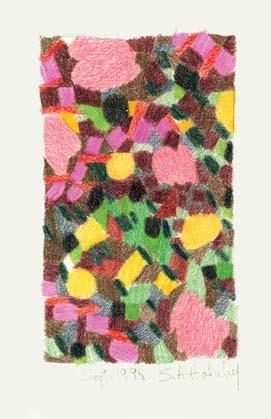
تاــيوتحلما كرويوين لىإا س�دقلا نم : ةنانف ةايح ■ 1965-1963 يديرجتلا نوللا : تاحوللا لىوأا ■ 1970-1966 : ةيش�دنهلا ةتماش�لا ةعيبطلا ■ (1975-1971( : ةينحنلما طوطلخاو تانوزللحا ■ (1979-1974 ( : يرطقلا نايرطلا ■ 1982-1980 : ةرخش�لا ةبق ■ 1983-1982 : ةنيدلما تاعبرمو فيرلخا قاروأا ■ 1992-1984 : ةقاطلا زكارمو ةيمانتلما لاكش�ألا ■ 1995-1983 : يكرلحا مش�رلا ■ 2000-1991 : يديرجتلا مش�رلا ■ ينيطش�لفلا ريرحتلا نف ،مش�اق رفكو ةيرخش�لا لابلجاو نوتيزلا راجش�أا ■ ةرتفلا هذه ىلإا لوش�و - 2000 ماع : ةحوللا راطإا نم ةيرحلا ■ ادعاش�ف 2007 نم : ليطتش�لما لىإا ةدوعلا ■ ةمهلما ثادحألال ينمزلا لش�لش�تلا ■ تاحوللا لودج ■ فيرلخا رمحأ Early
ر �خأاو يرهزو يرهز
22 x 15 cm.
on paper, 9 x 6",


راكتبلااو مس�رلا نم دوقع ةس�مخ © Carole Al Farah يـــبلح ةيماـــس�
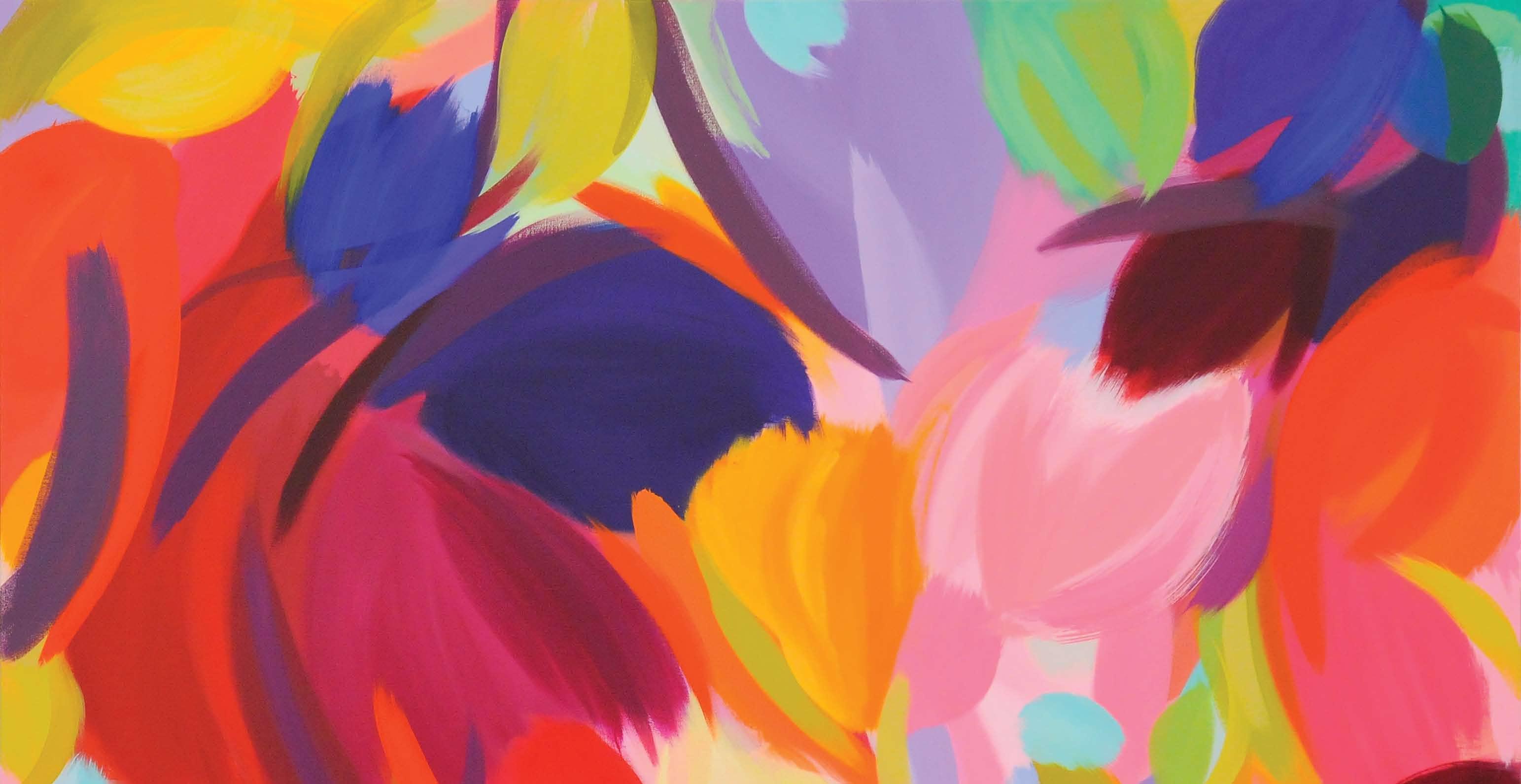
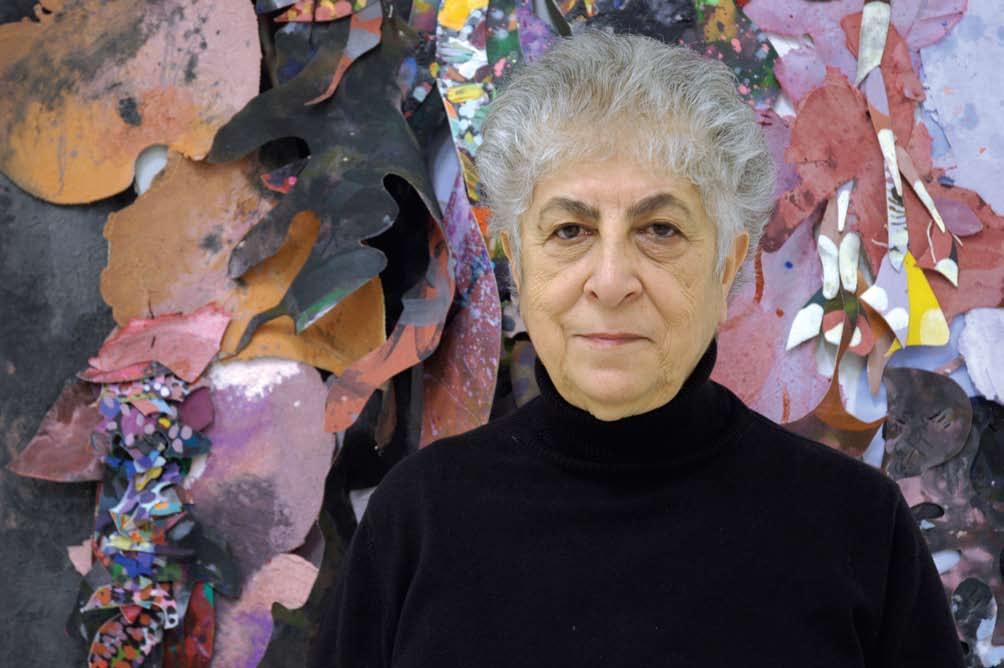 Samia Halaby
Samia Halaby
 Samia Halaby
Samia Halaby

